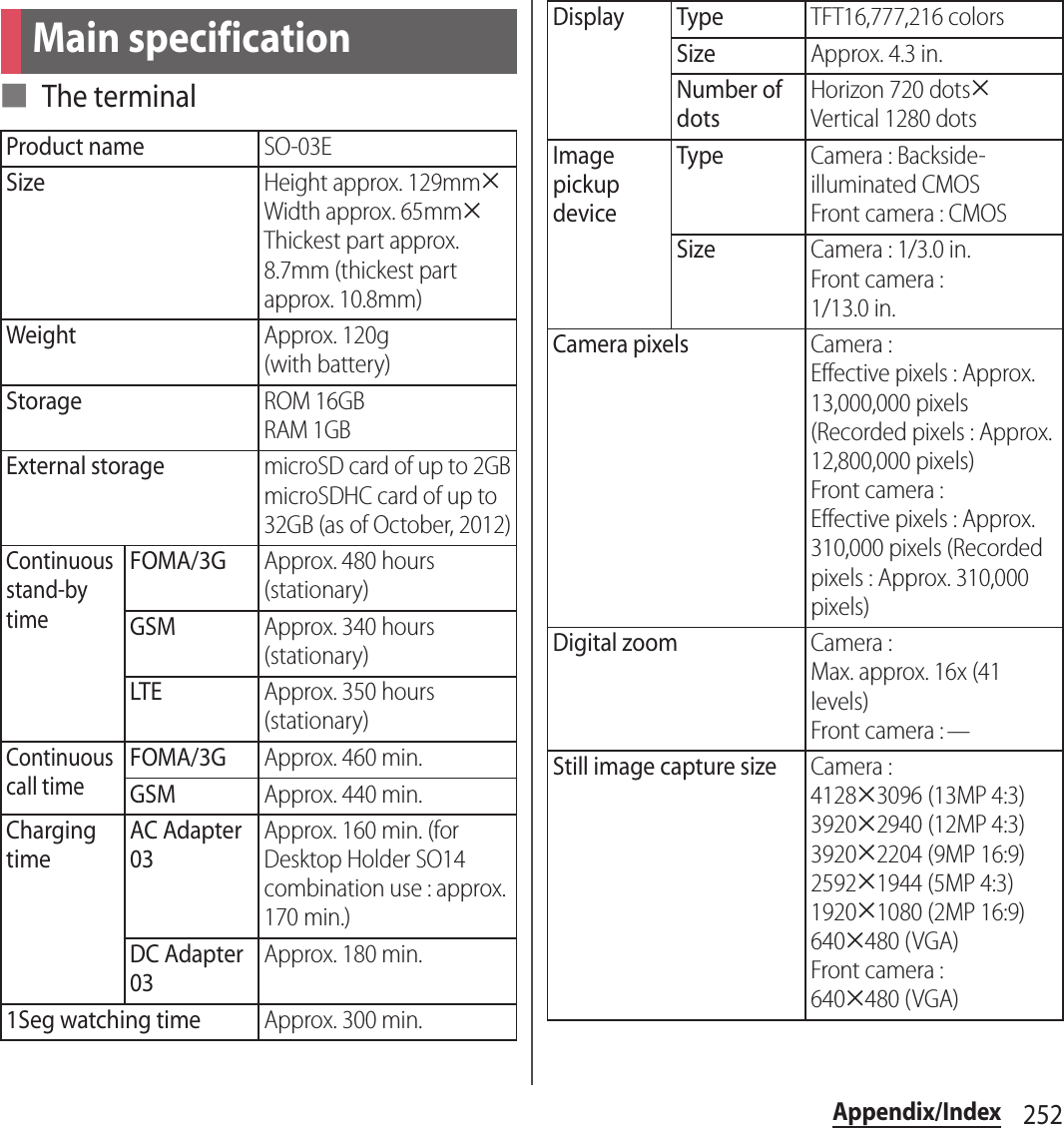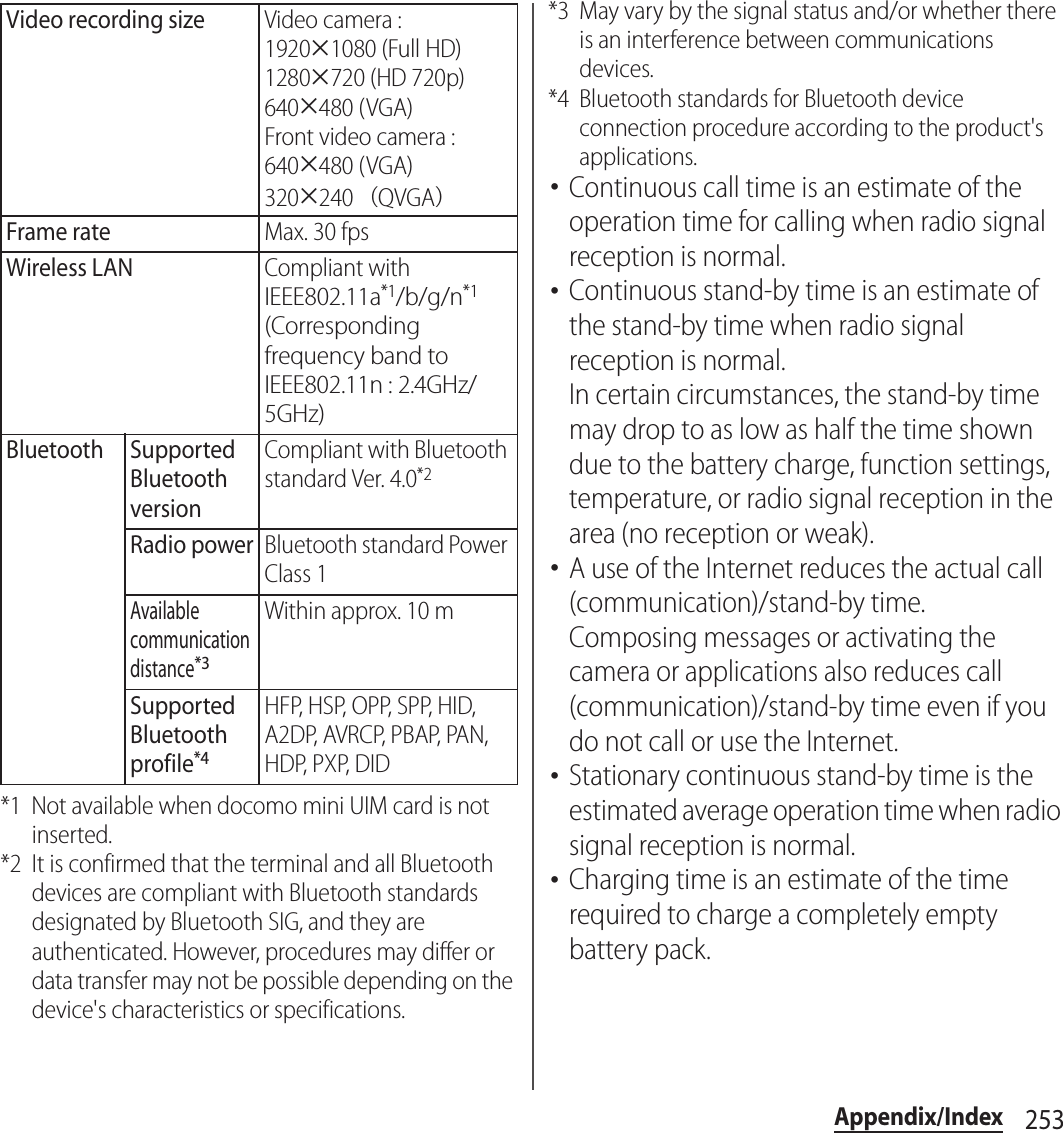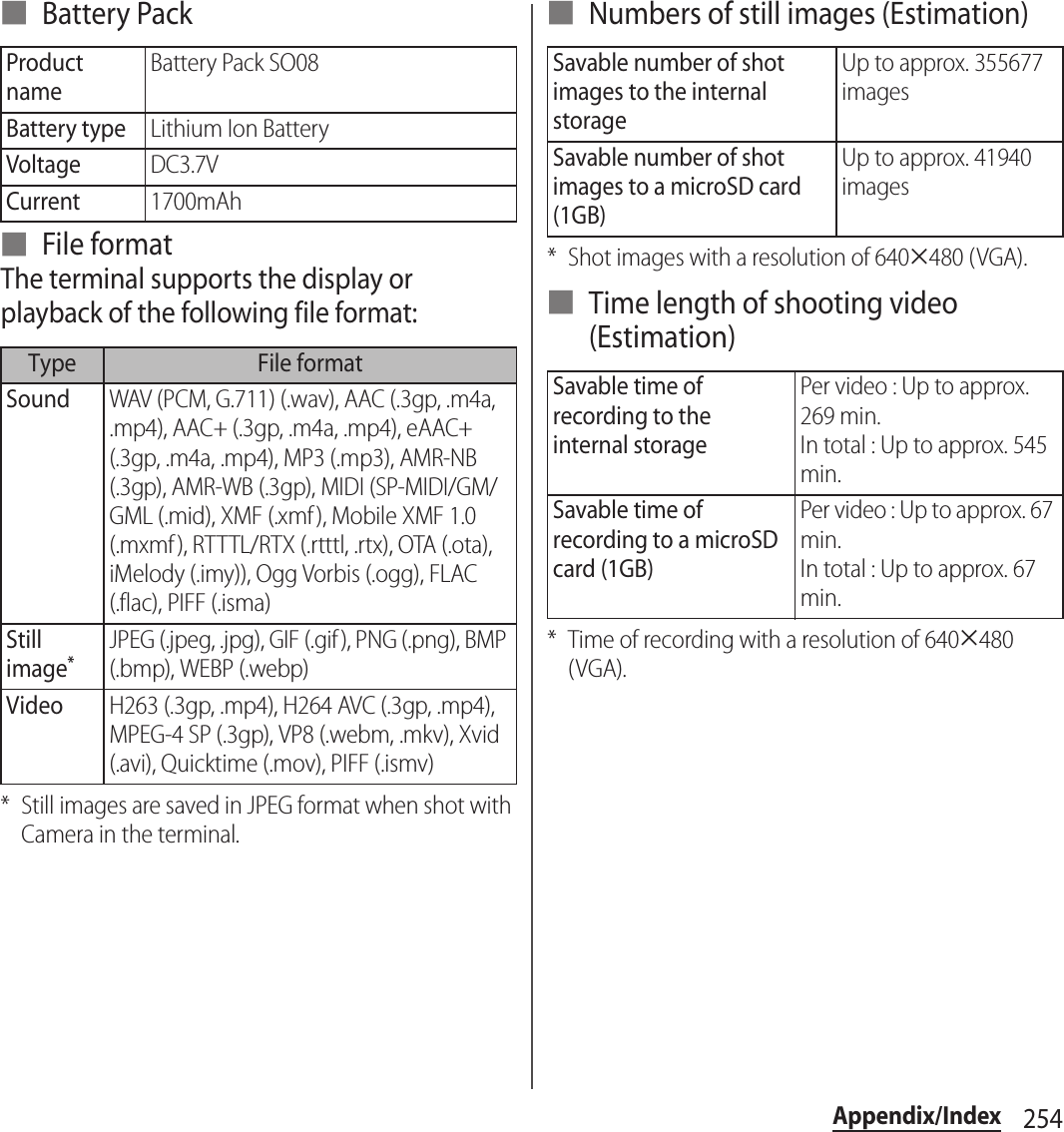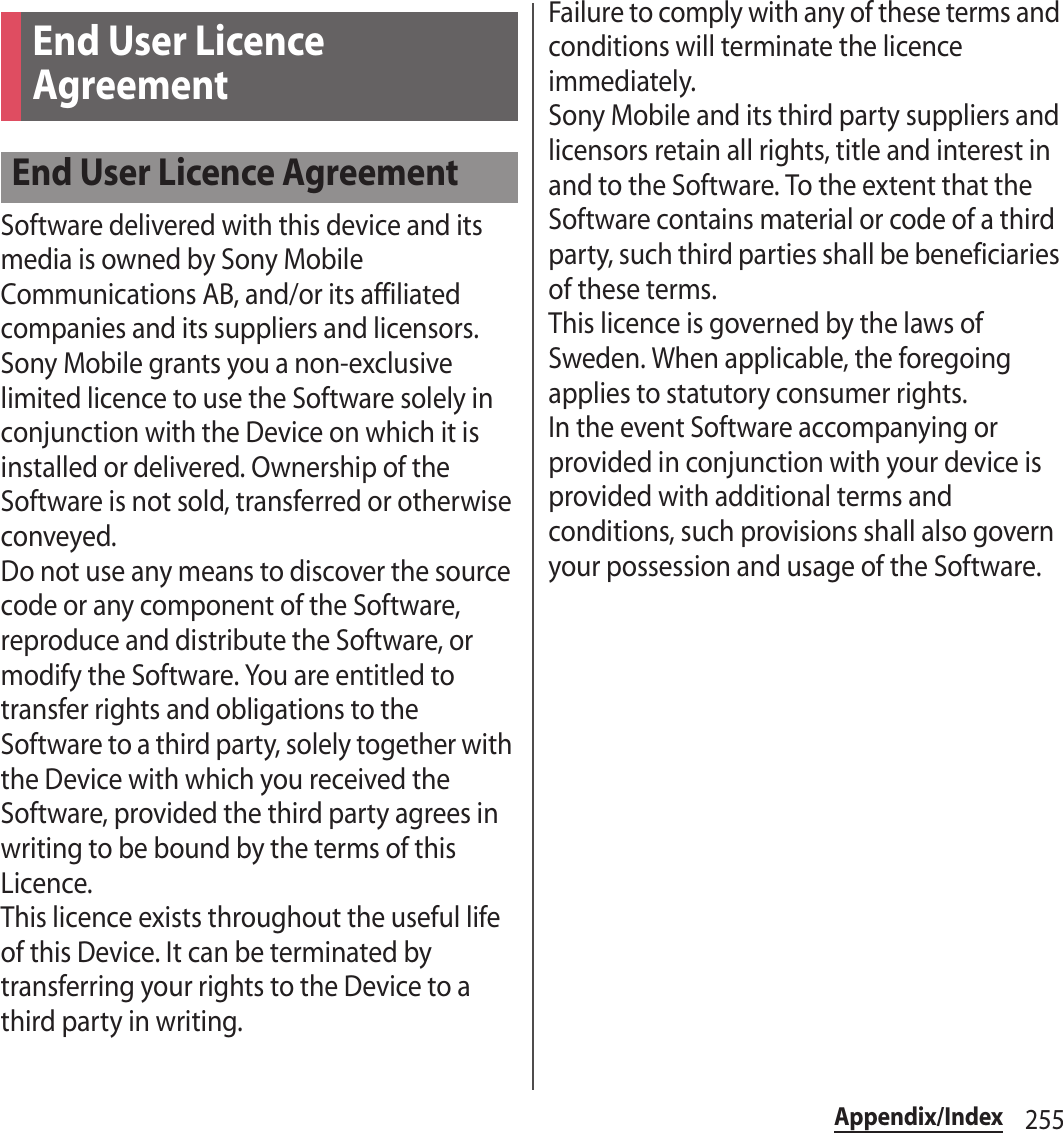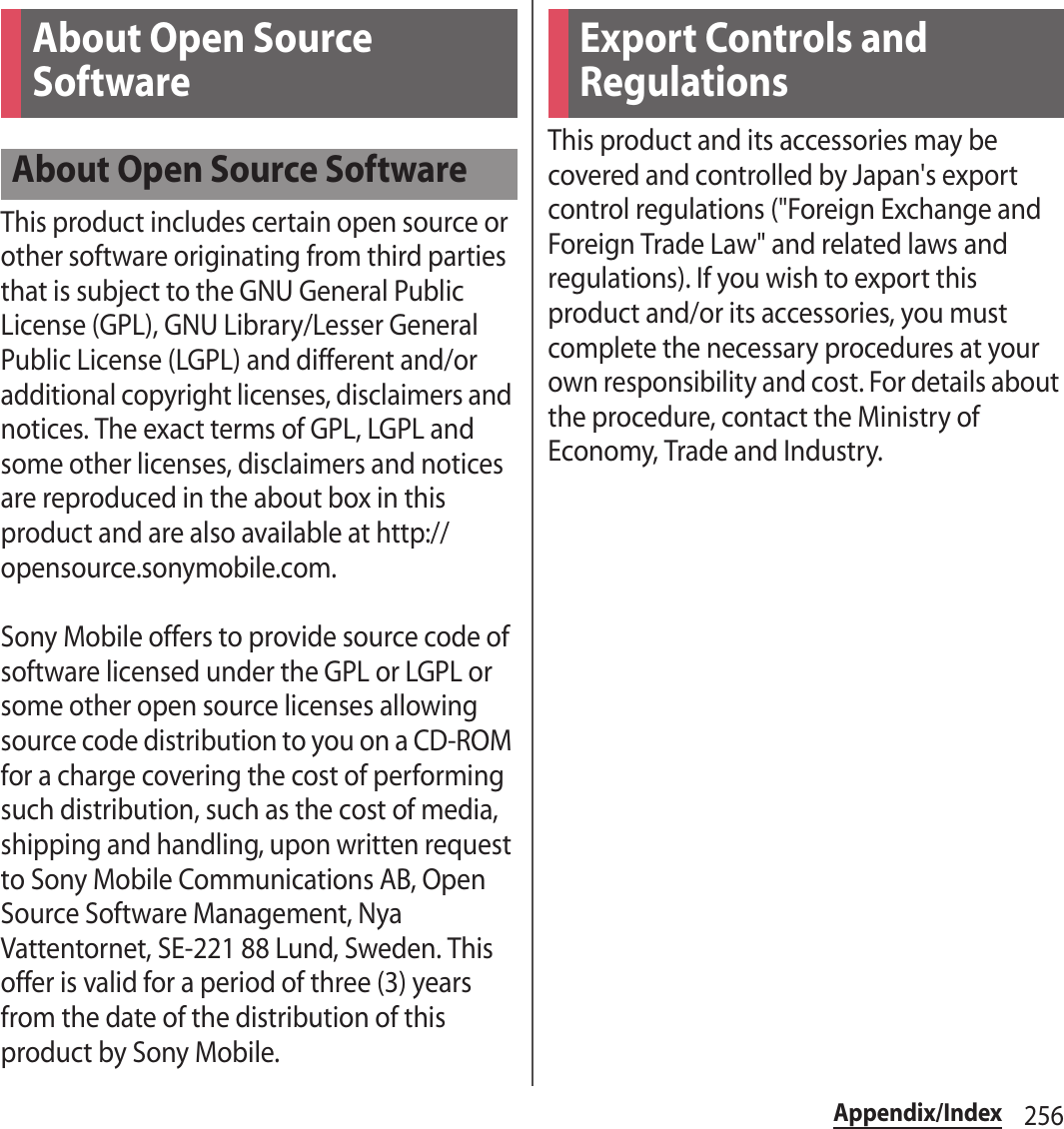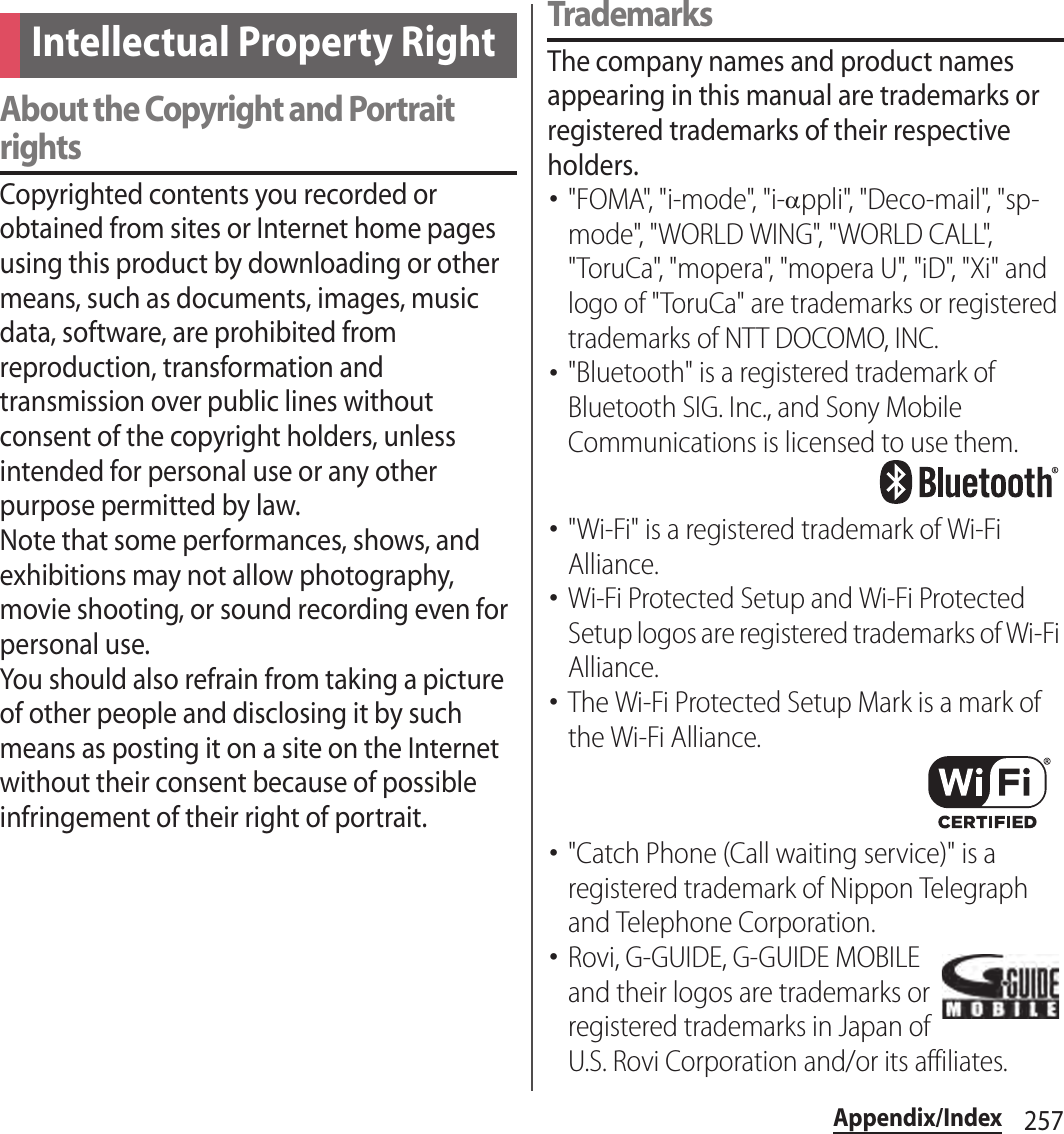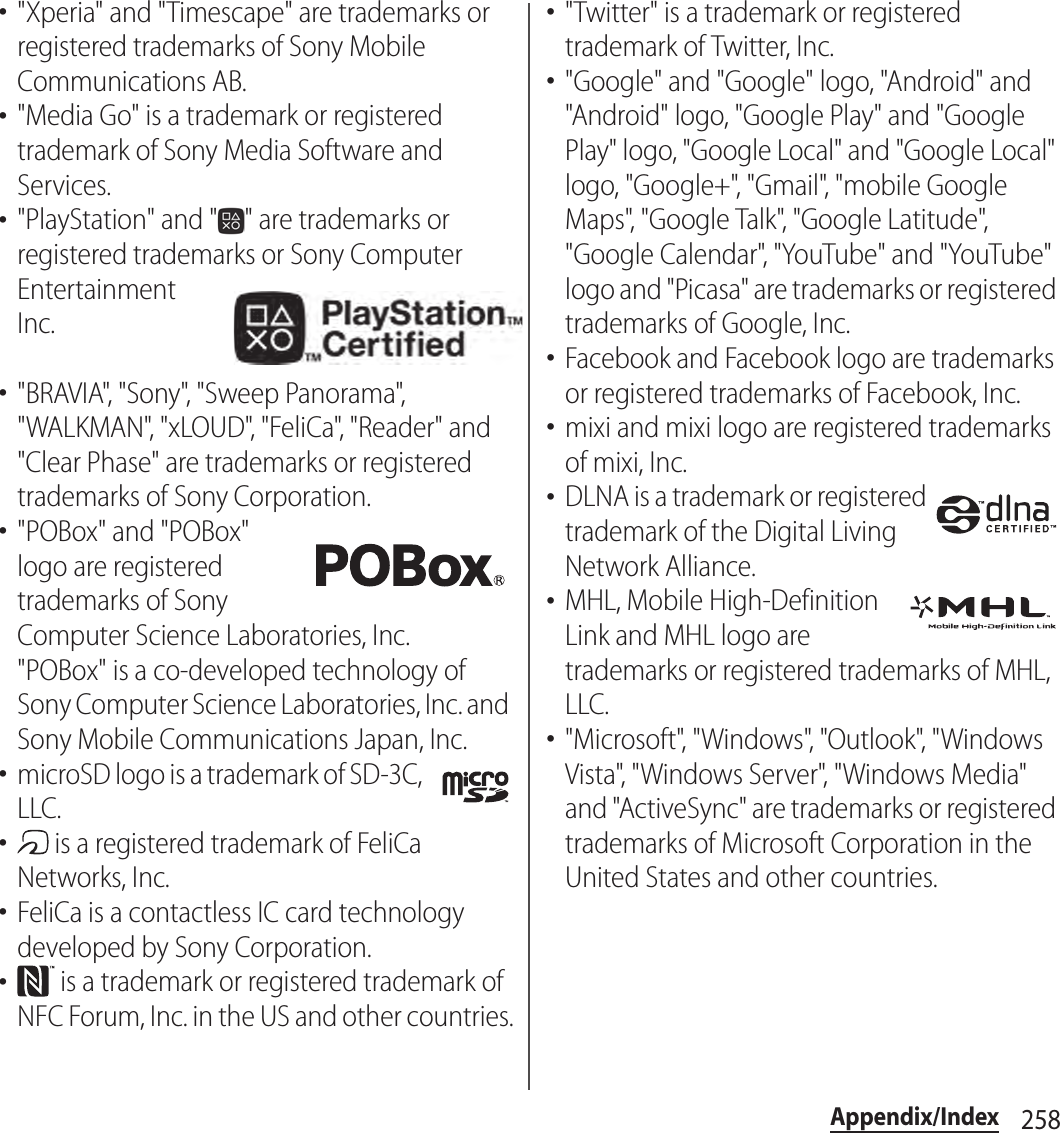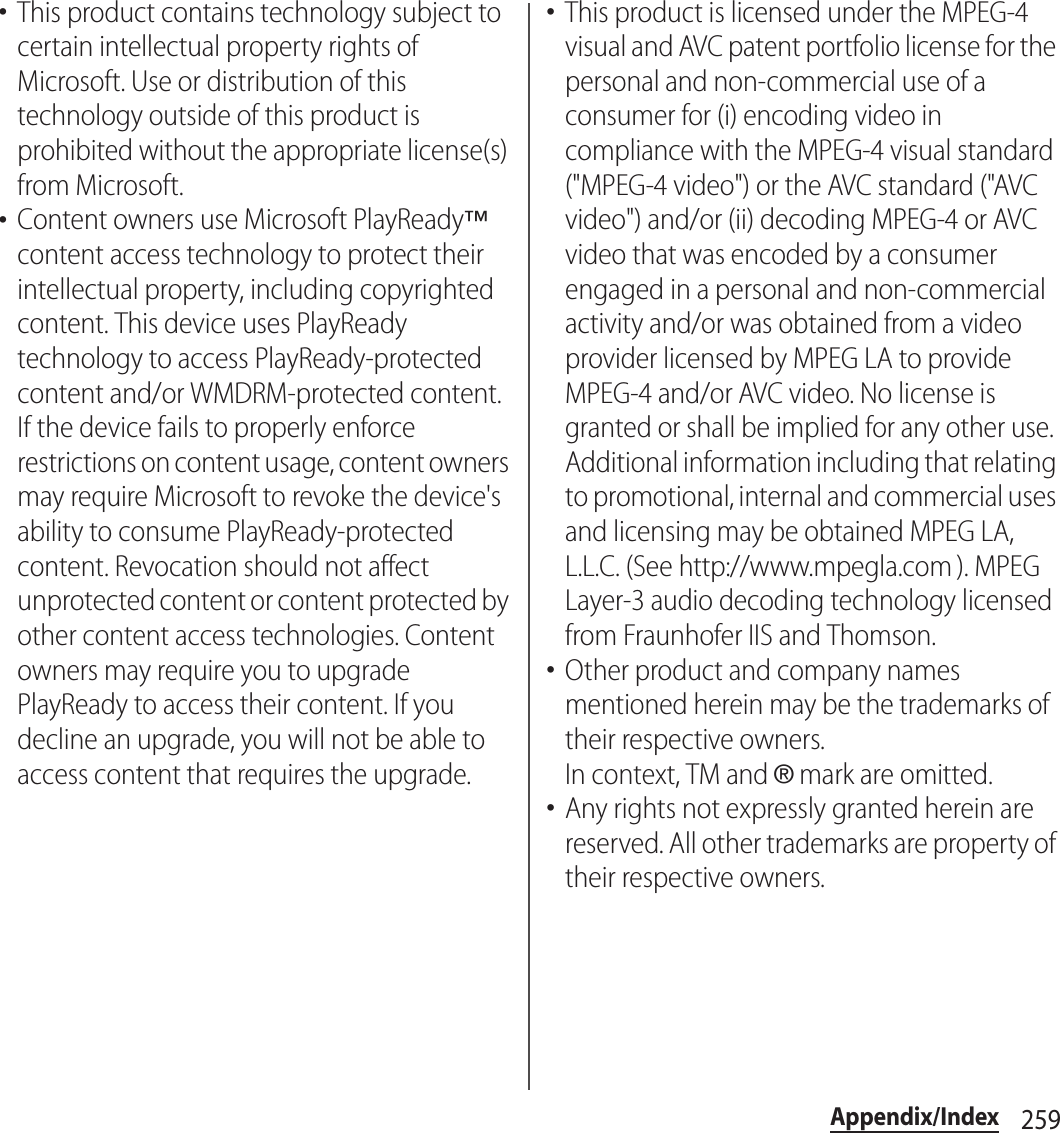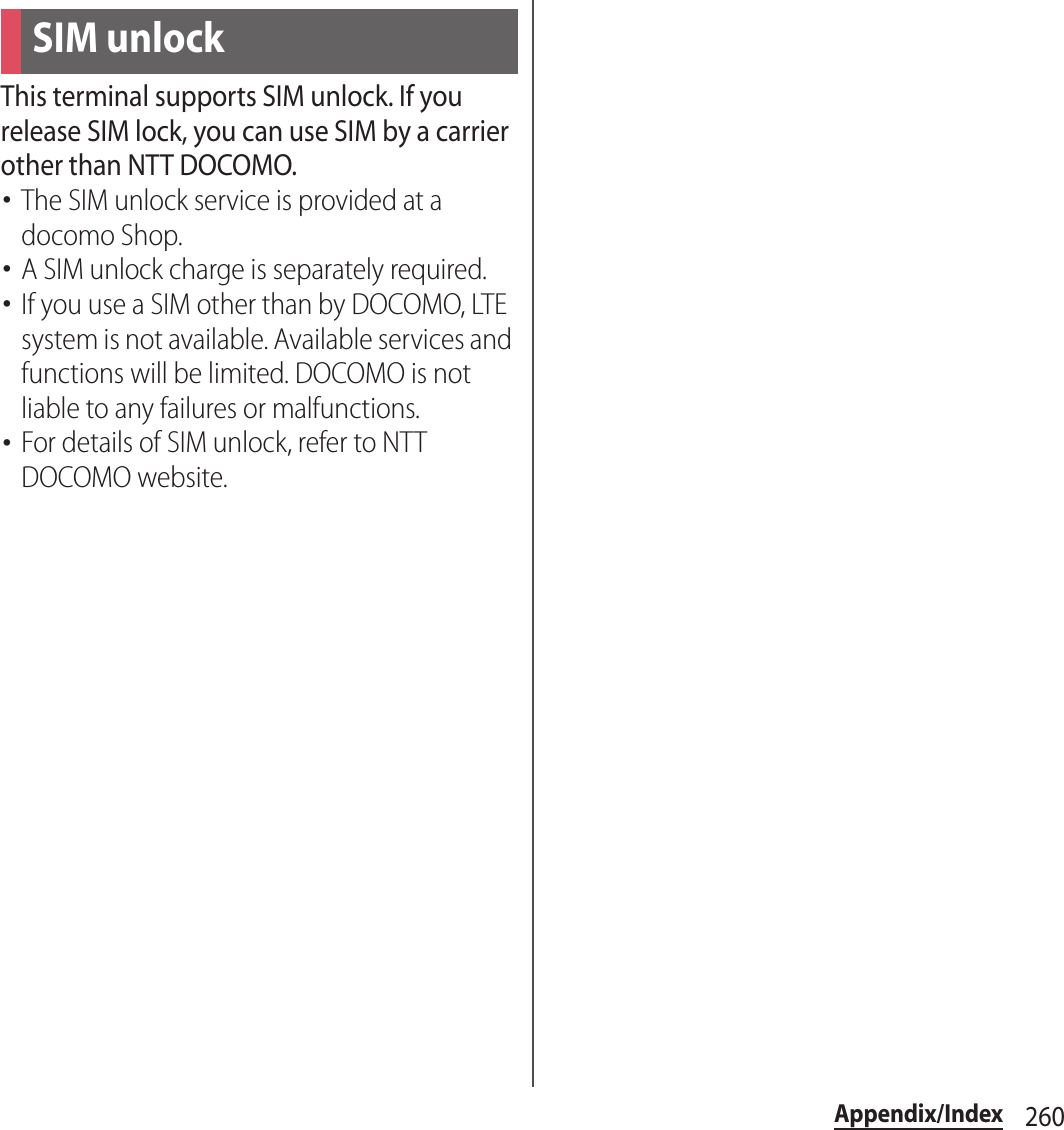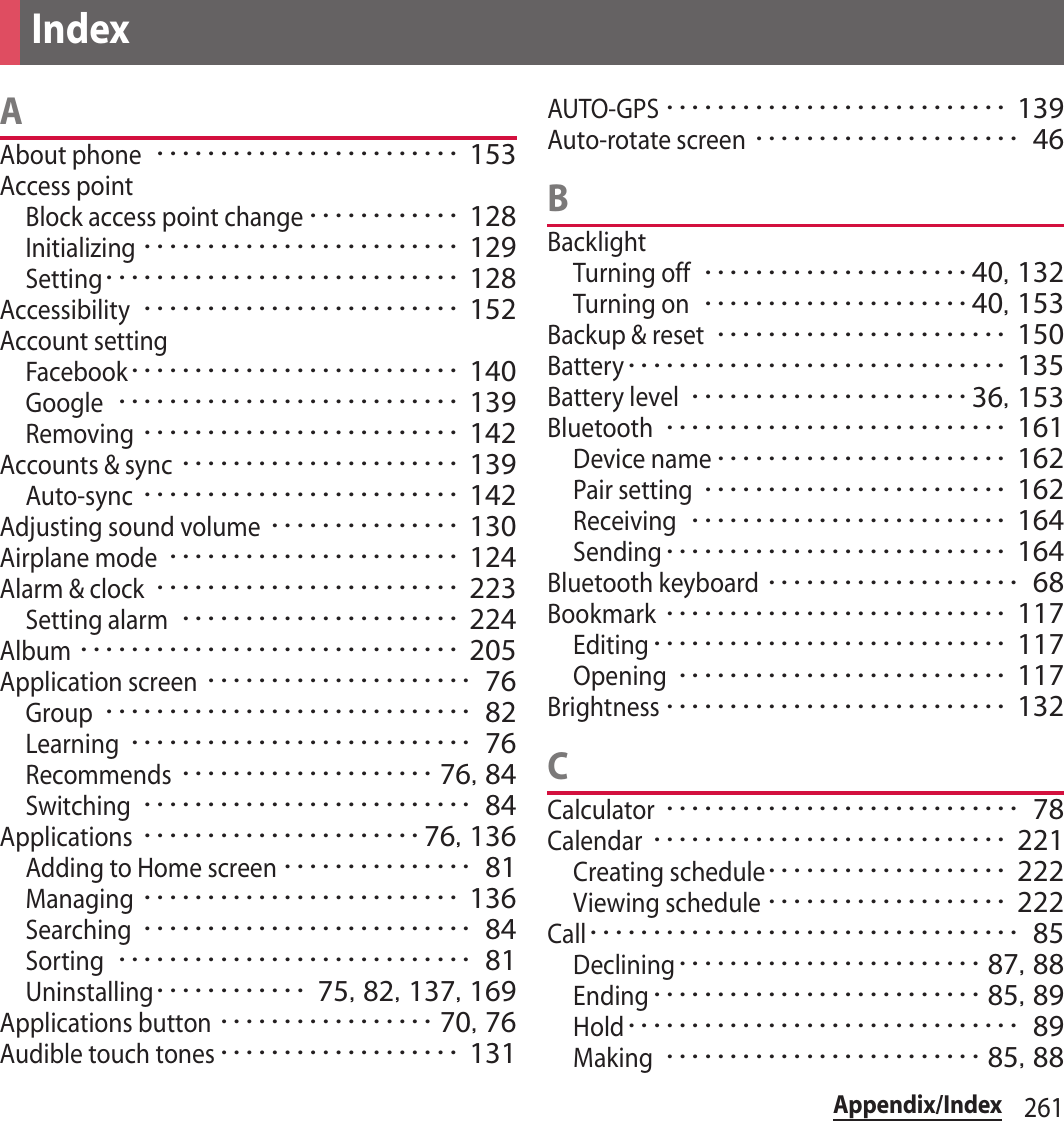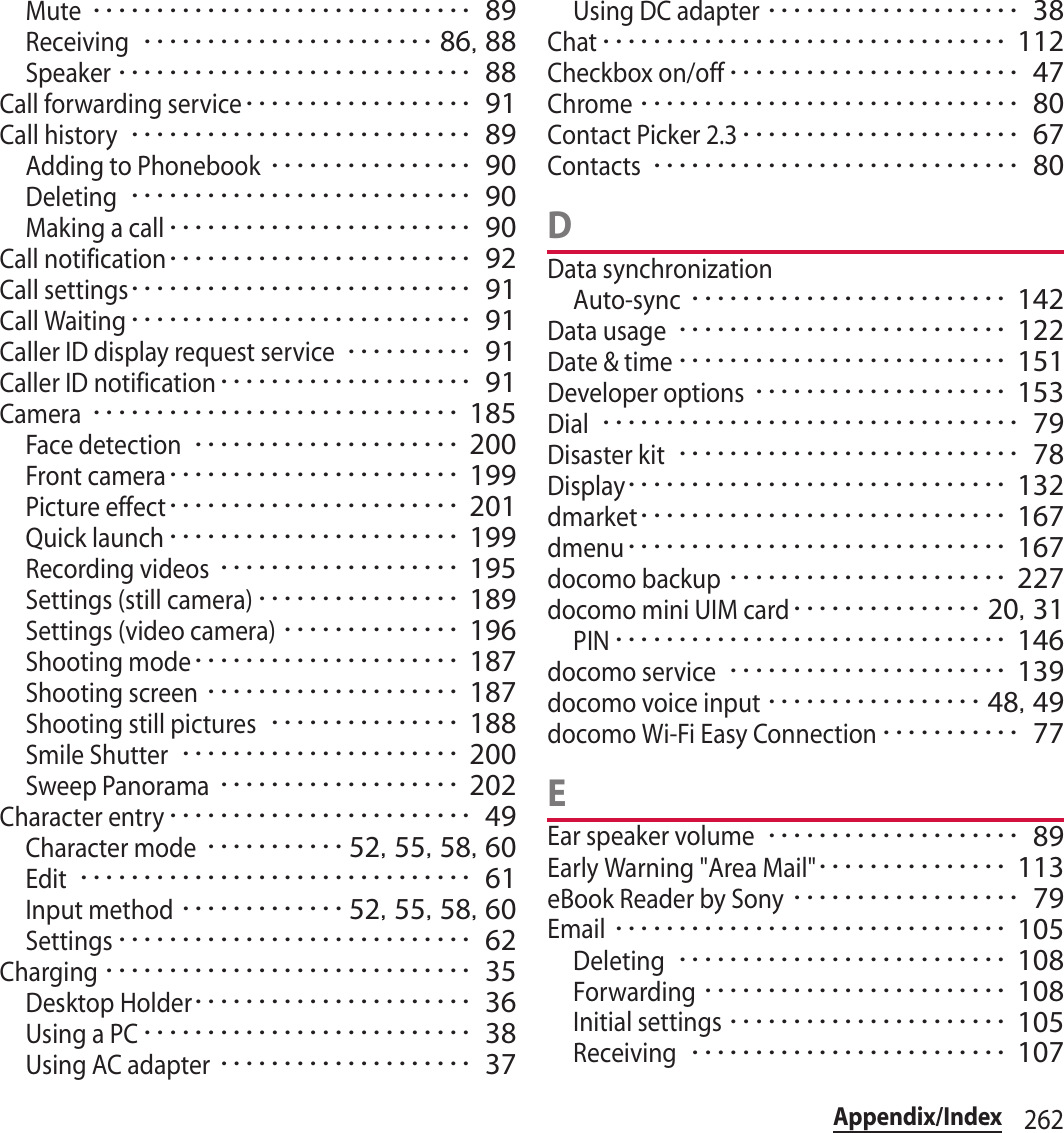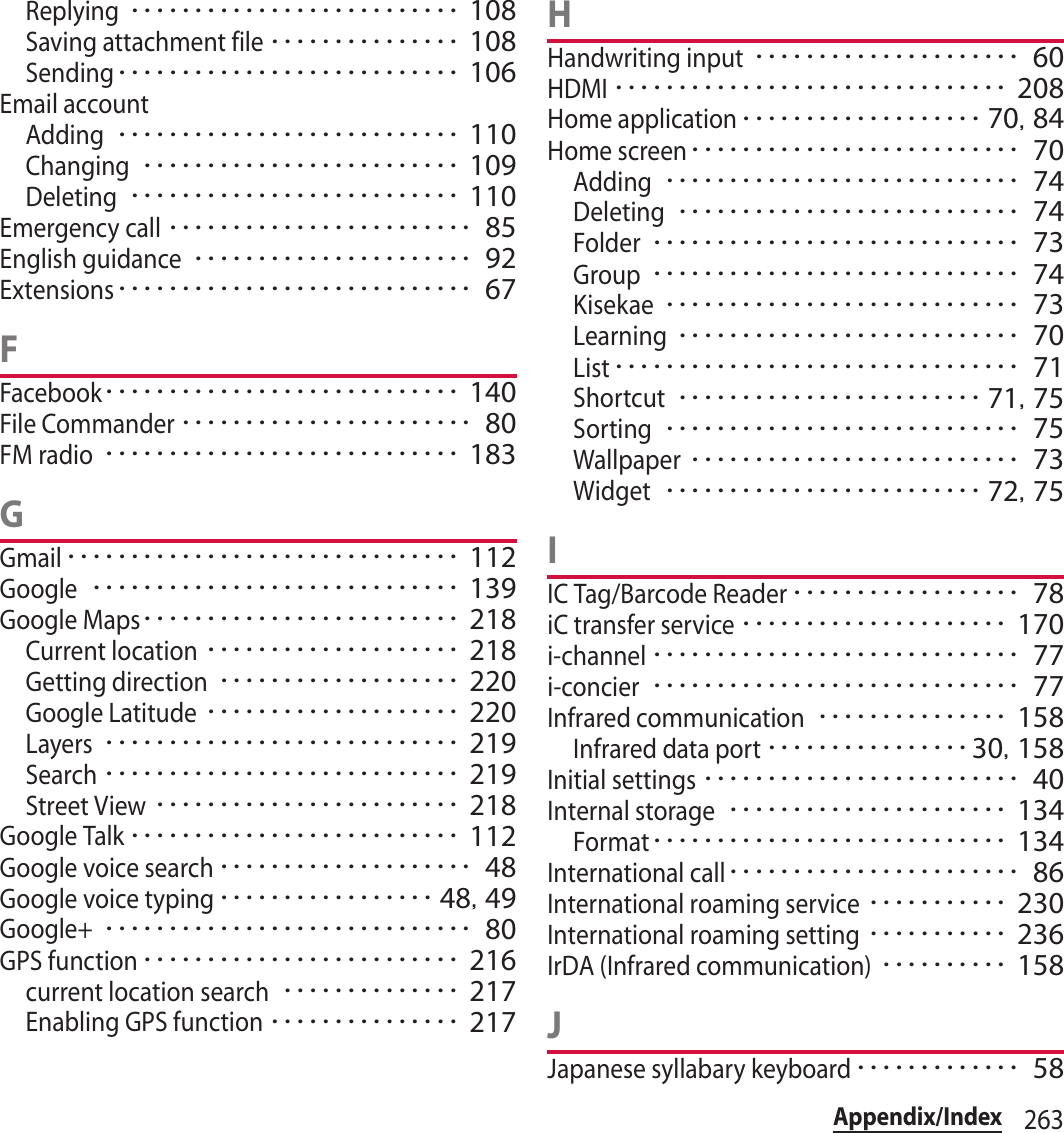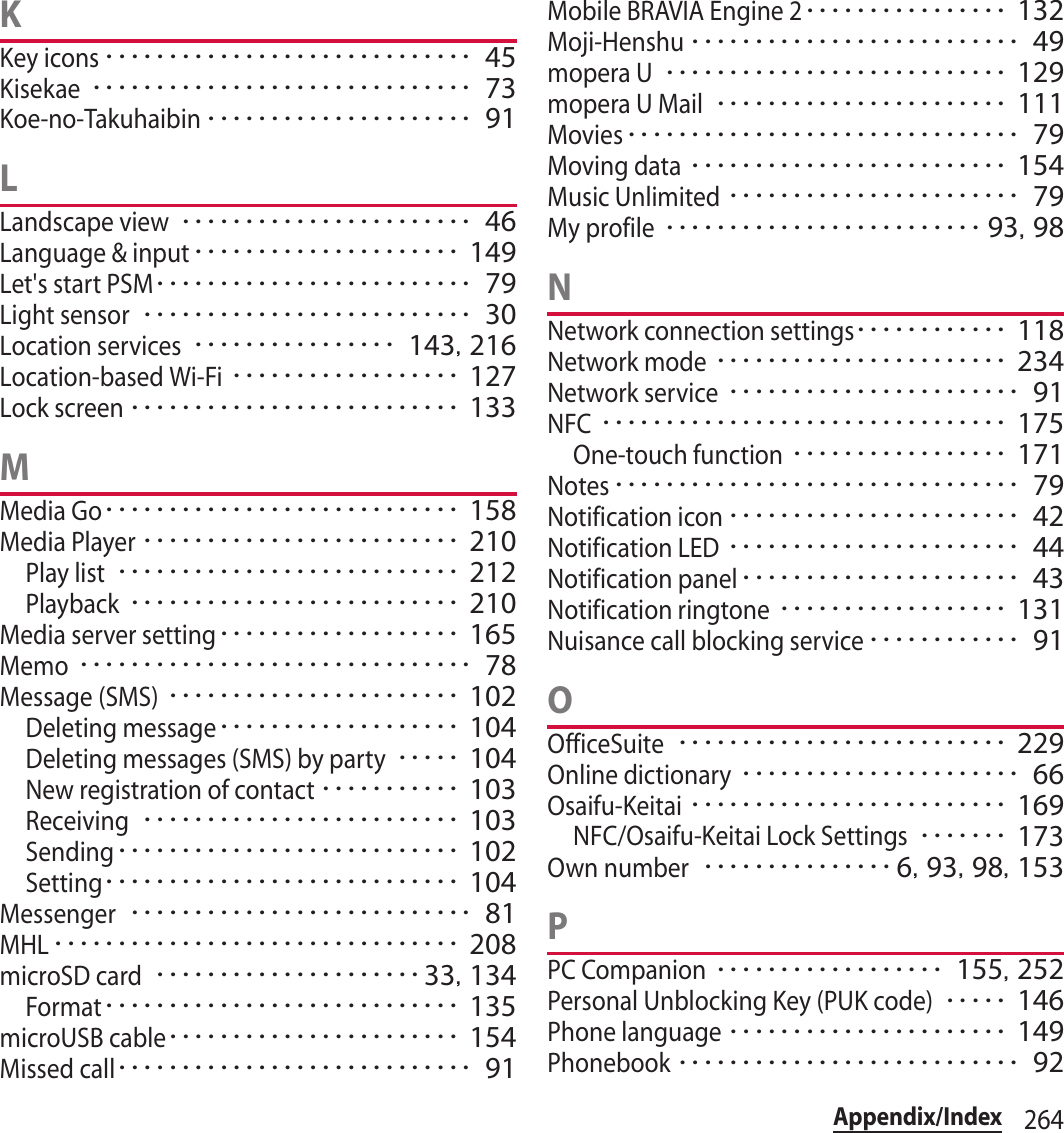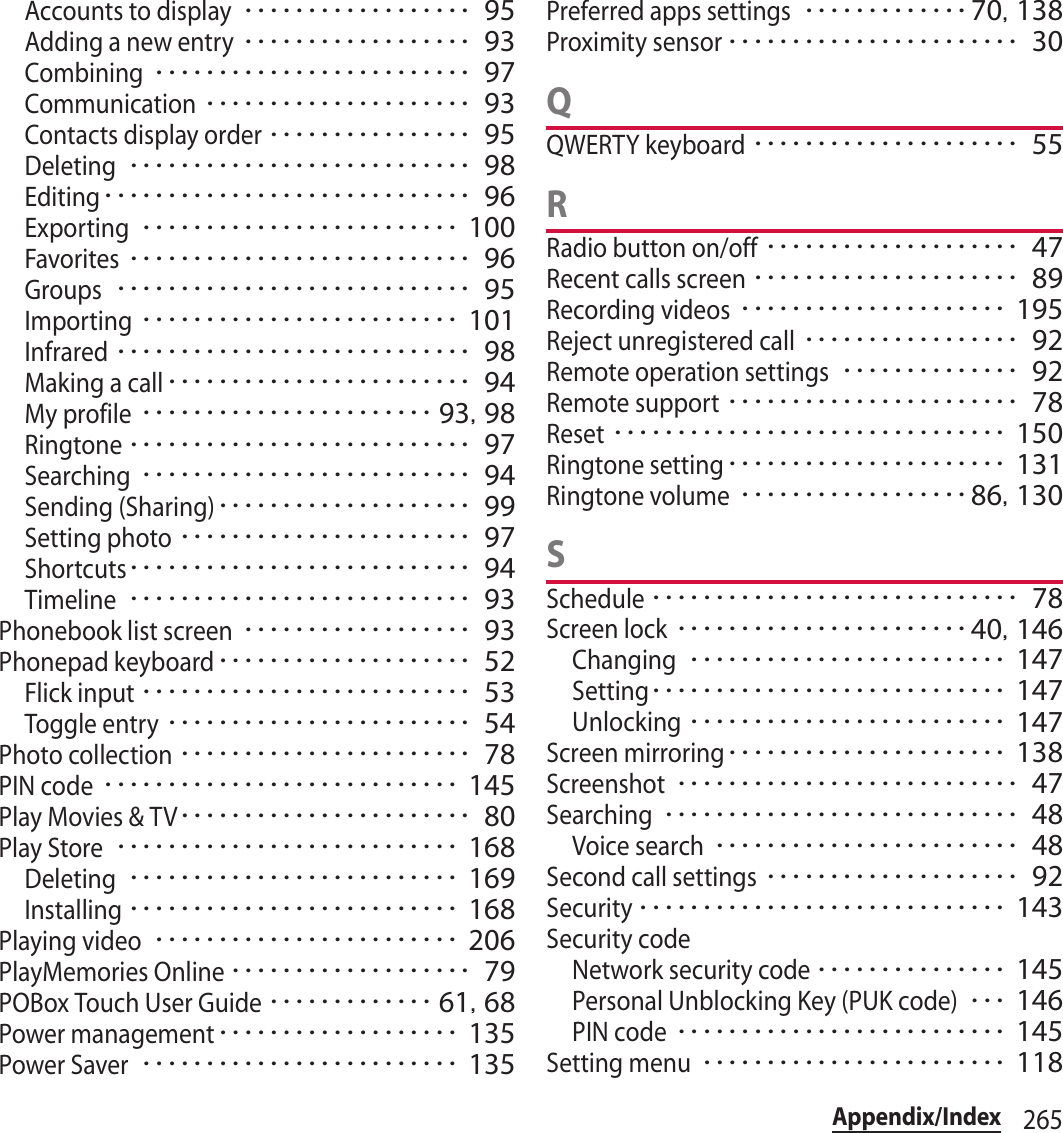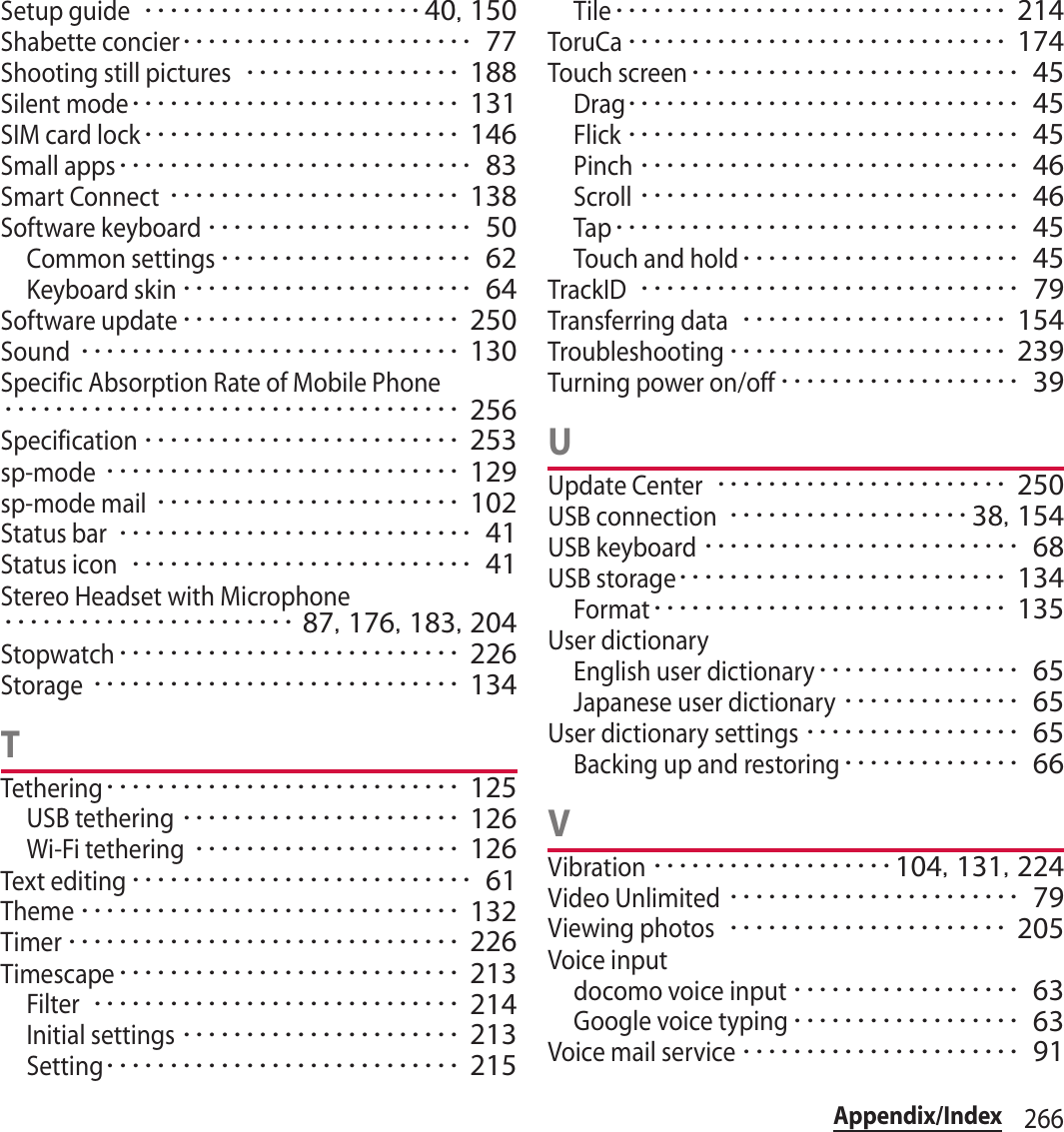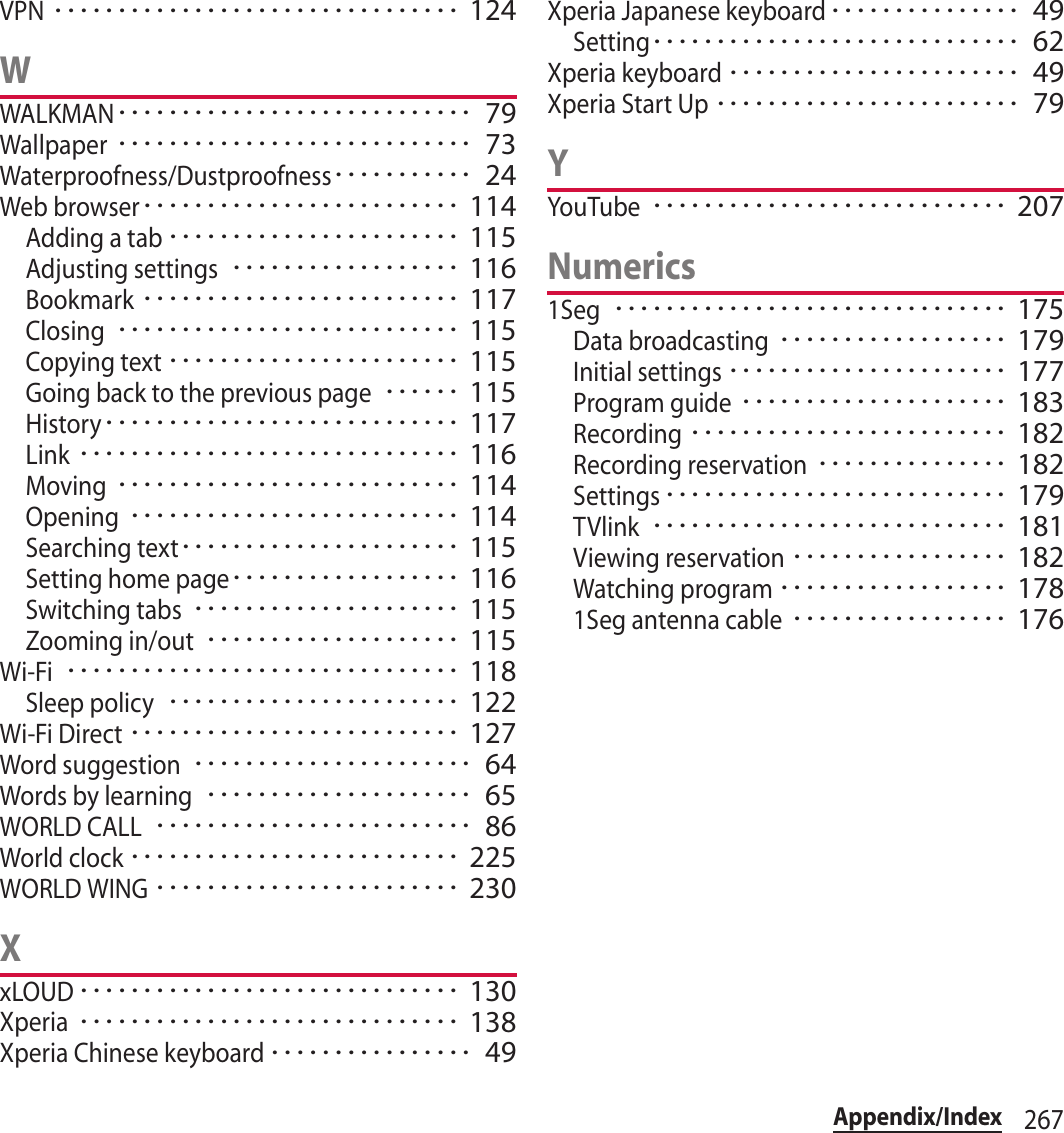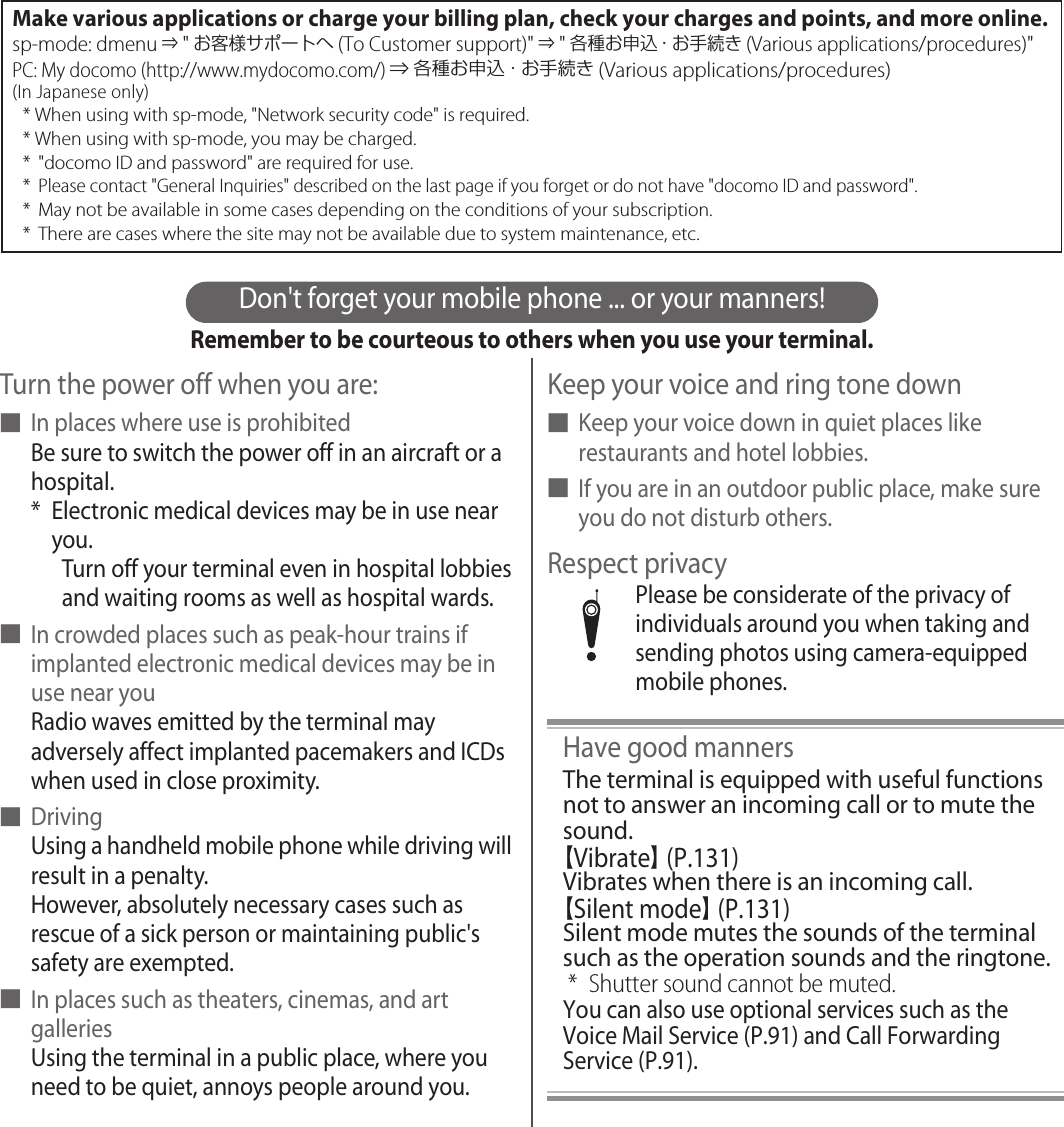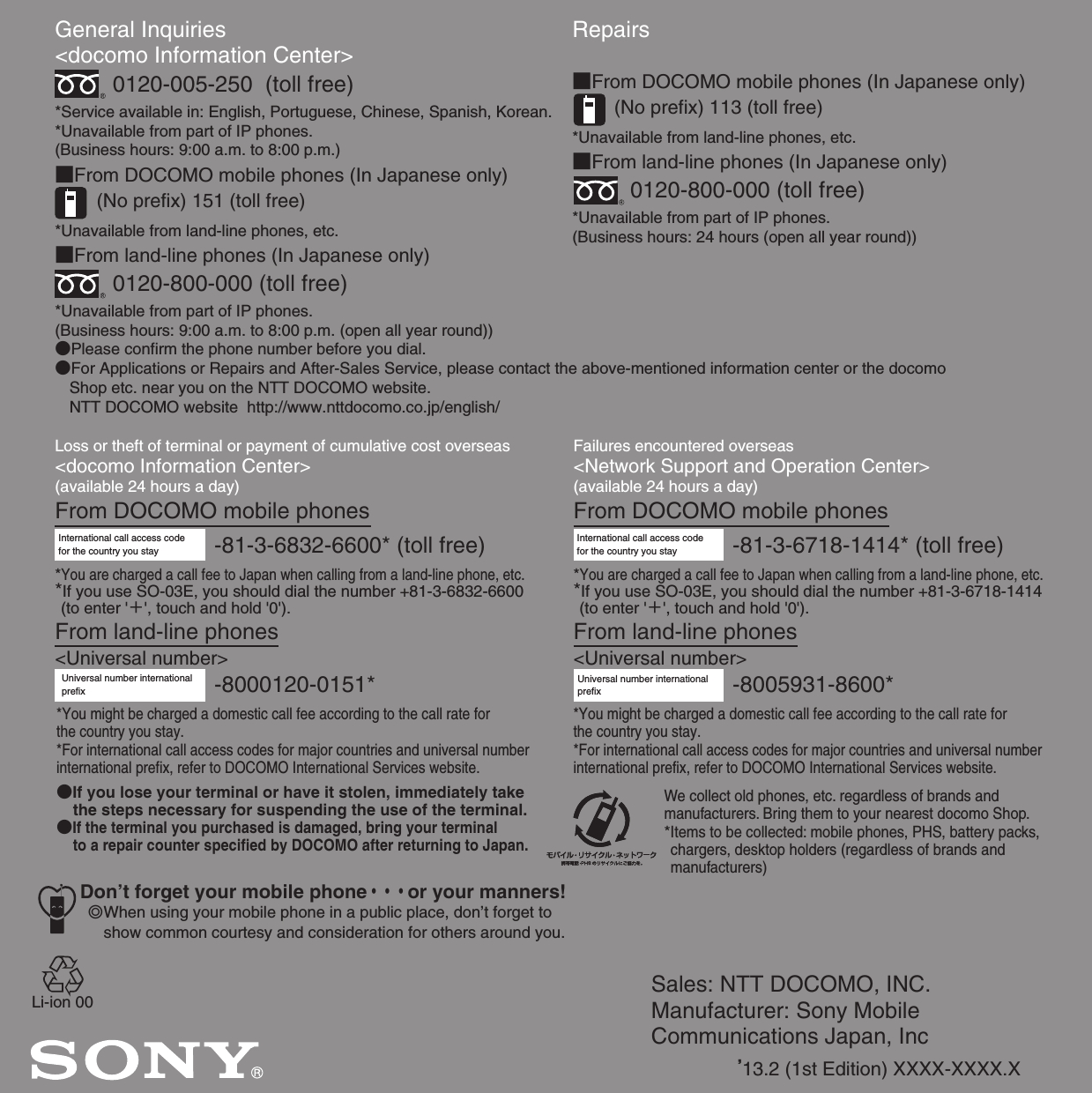Sony TM-0000 GSM/UMTS/LTE Tablet PC with WLAN, BT, RFID User Manual user guide
Sony Mobile Communications Inc GSM/UMTS/LTE Tablet PC with WLAN, BT, RFID user guide
Sony >
Contents
- 1. user guide
- 2. user guide regulatory leaflet
user guide
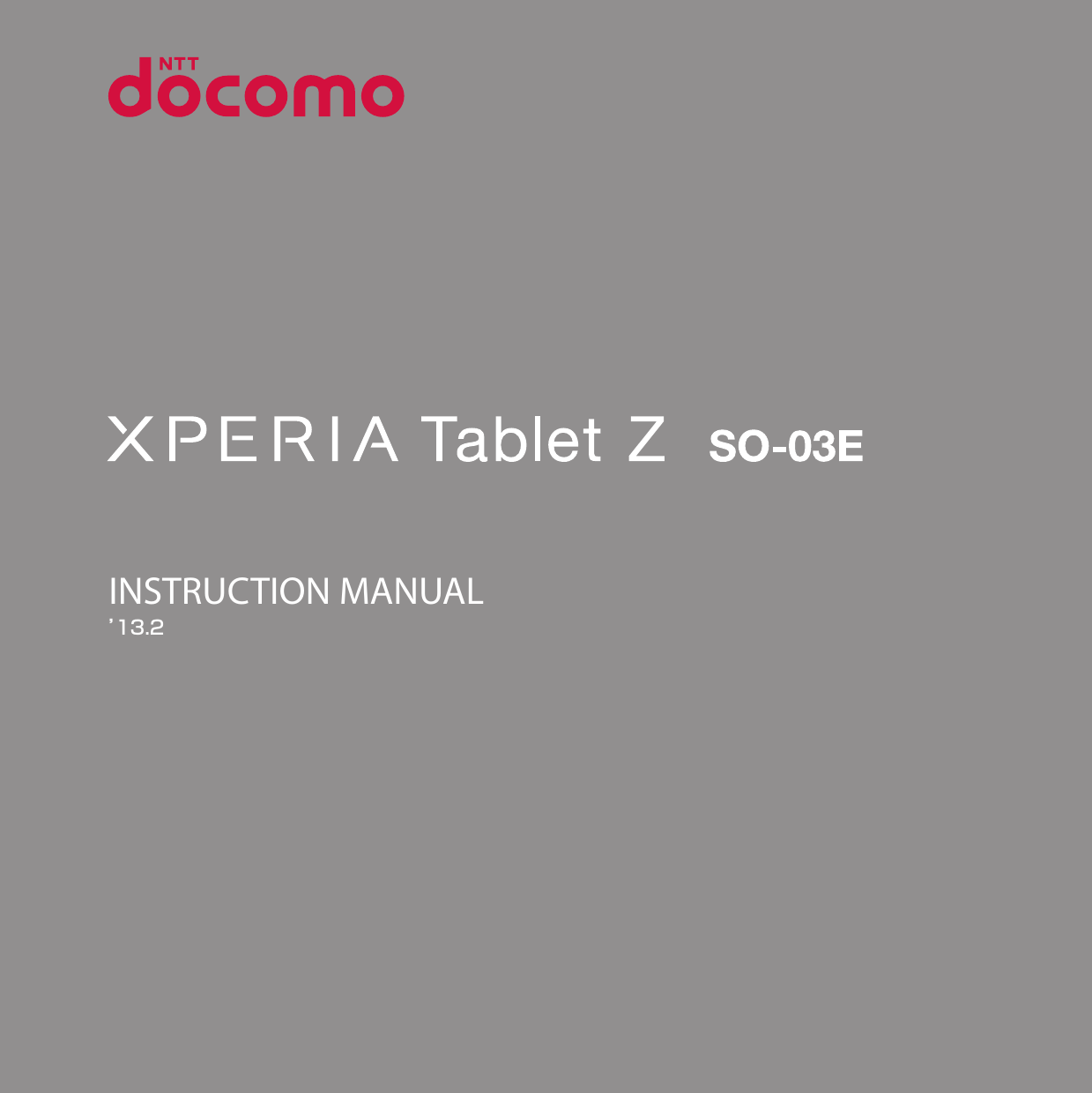
![IntroductionThank you for your purchase of "SO-03E".For proper use of the SO-03E, read this manual carefully before and while you use the SO-03E.About manuals of SO-03EIn addition to this manual, the operations of SO-03E are described in "クイックスタートガイド (Quick Start Guide)" (in Japanese only) and "Instruction Manual" application of the terminal (in Japanese only).●"クイックスタートガイド (Quick Start Guide)" (Supplied accessories)The initial operations and settings after purchasing the terminal, screen view contents and operations of main function are explained. (In Japanese only)●"Instruction Manual" (Application of the terminal)Similarly to this manual, operations and settings of each function are explained. To use "Instruction Manual" application, from the Home screen, tap and [Instruction Manual]. When using for the first time, download and install the application according to the onscreen instructions. If you delete "Instruction Manual" application, you can access Google Play from Play Store to install again. From the Home screen, tap [Play Store] and search "Instruction Manual" application to select, then follow the onscreen instructions to install. You can use the application as an electronic book. You can also shift to actual operations by tapping the description in the contents or view reference contents.❖Note・For downloading or updating the application, a high packet communication charge will be applied because of a large amount data communication. For this reason, subscription of packet flat-rate service is highly recommended.●"Instruction Manual" (PDF file)Operations and settings of each function are explained. It can be downloaded from NTT DOCOMO website.http://www.nttdocomo.co.jp/english/support/trouble/manual/download/index.html* You can download the latest information of "クイックスタートガイド (Quick Start Guide)" (in Japanese only). The URL and contents are subject to change without prior notice.❖Note・Reproduction or reprint of all or part of this manual without prior permission is prohibited.・Important information for SO-03E is posted in the following website. Be sure to check before using.http://www.sonymobile.co.jp/support/use_support/product/so-03e/ (In Japanese only)●スマホなるほどツアーズ for docomo with series "Tips of smartphone for docomo with series" (Widget in the terminal)An widget with which you can easily learn useful functions and basic operations you should know with Docomodake.To use Tips of smartphone for docomo with series, from the Home screen, tap .](https://usermanual.wiki/Sony/TM-0000.user-guide/User-Guide-1900871-Page-2.png)
![1Operation descriptionsIn this manual, each key operation is described with p, x, y, r, m. And selection operations of the icons or function items on the touch screen are described as follows.❖Information・In this manual, the instructions are described with the default Home screen. If you set the other application to the home screen, the operations may differ from the descriptions.・Display examples and illustrations used in this manual are just images for explanations and may be different from actual ones.・In this manual, the easier procedure is described for the functions and settings which have multiple operating procedures.・Please note that "SO-03E" is called "the terminal" in this manual.・In this manual, explanations for "docomo" as Home application are provided. To switch the Home applications, see "Learning Home screen" (P.70).Description OperationFrom the Home screen, tap and tap [Settings]u[About phone].From the Home screen, tap (Applications button), and then tap "Settings" on the next screen and "About phone" on the following screen in order.Touch and hold an icon.Keep touching an icon longer (1-2 seconds).](https://usermanual.wiki/Sony/TM-0000.user-guide/User-Guide-1900871-Page-3.png)
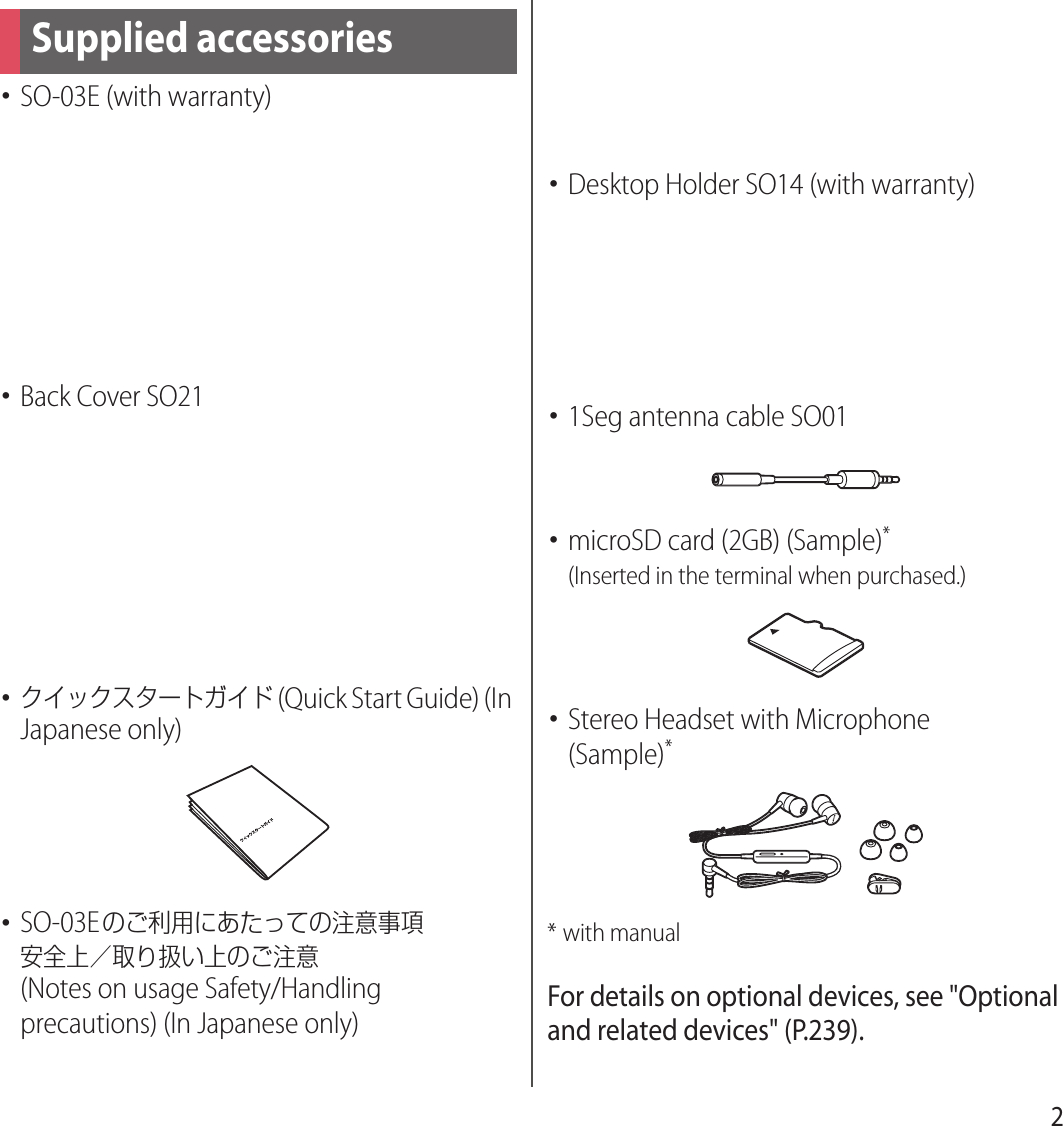
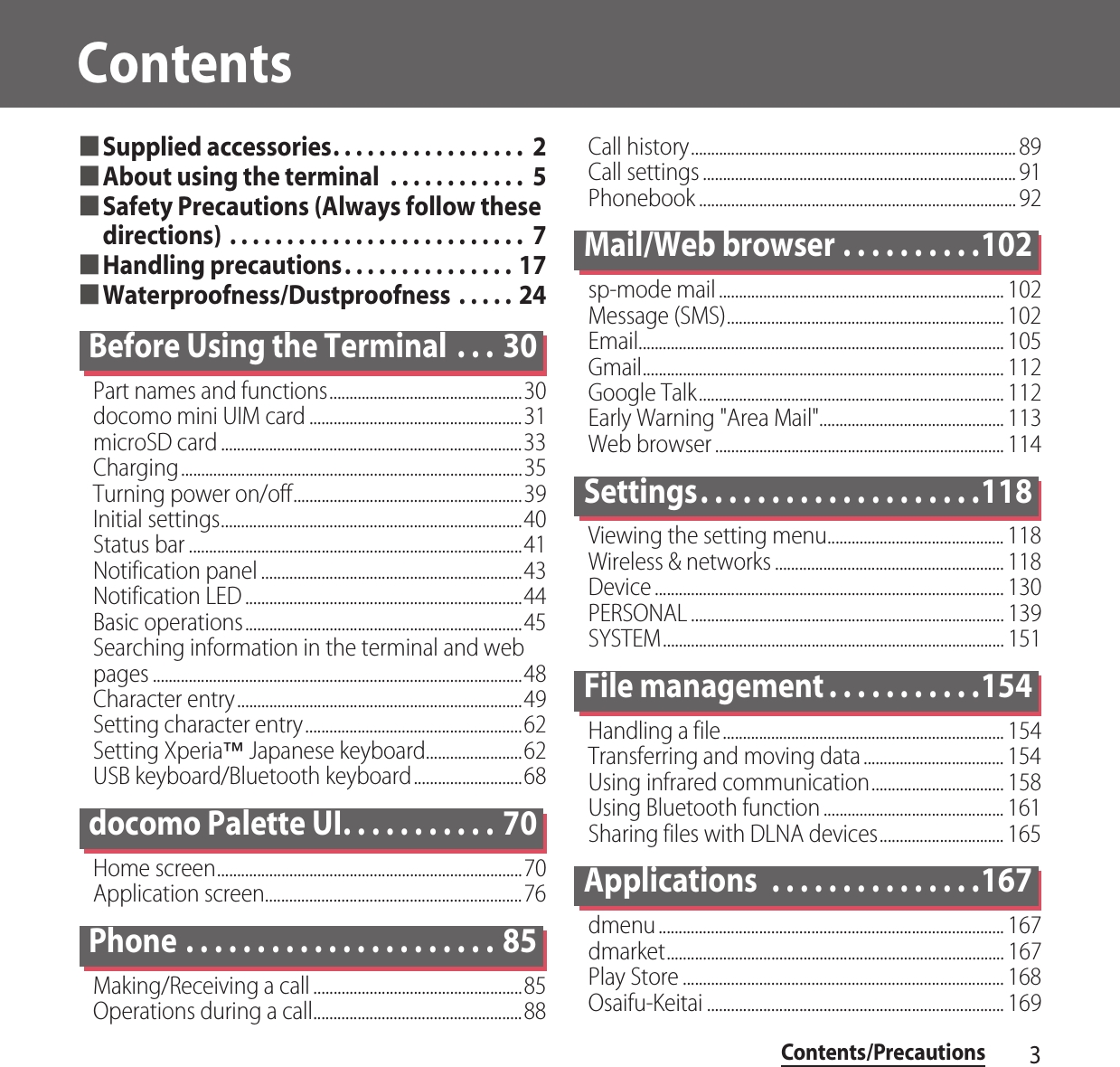
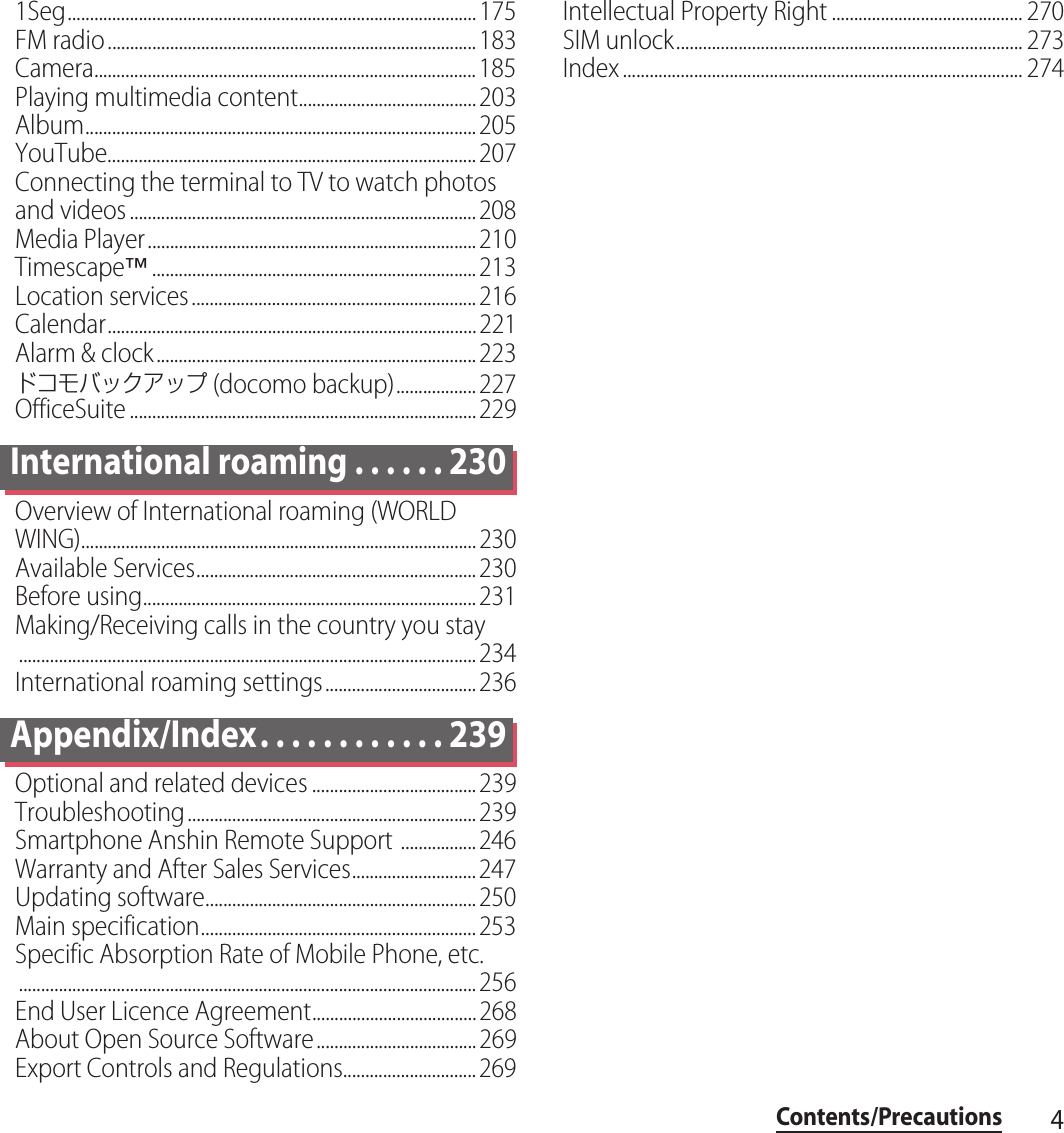
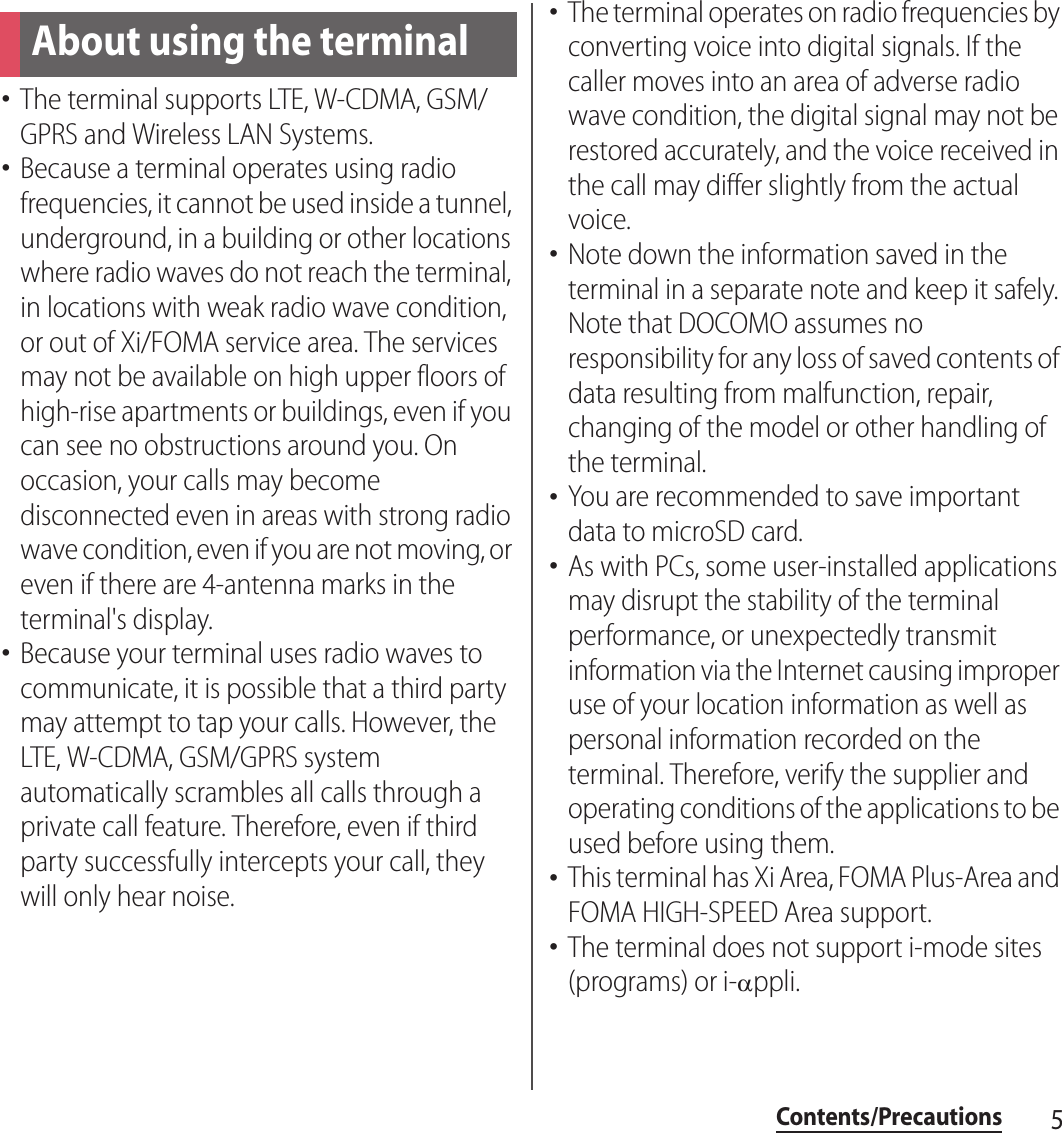
![6Contents/Precautions・The terminal automatically performs communication for synchronizing data, checking the latest software version, maintain connection with the server, etc. If you transmit a large amount of data such as downloading applications or watching movie, a packet communication charge becomes high. Subscription of packet flat-rate service is highly recommended.・Depending on the applications or service you use, packet communication fees may be charged even in Wi-Fi communication.・Public mode (Driving mode) is not supported.・Setting the terminal to Silent mode does not mute sounds for shutter, playback of video or music, alarm, dial pad touch tones during a call, sound emitted when tapping [End call], etc.・The names of the operators are displayed on unlocking screen (P.40).・Your phone number (own number) can be checked as follows:From the Home screen, tap and tap [Settings]u[About phone]u[Status].・The software version of your terminal can be checked as follows:From the Home screen, tap and tap [Settings]u[About phone].・You can perform software update by downloading an update file with a PC via Internet and connecting the PC to the terminal. For details, see "Connecting to a PC and updating" (P.252).・By some software updates, the operating system (OS) may be version-upgraded for improving the terminal quality. For this reason, you always need to use the latest OS version. And some applications that used in the previous OS version may not be available or some unintended bugs may occur.・You can use the terminal only with docomo mini UIM card. If you have a UIM or FOMA card, bring it to a docomo Shop to replace.If you use a docomo mini UIM card (red), you cannot use some Osaifu-Keitai compatible services such as international use. Bring it to a docomo Shop to replace in February, 2013 (scheduled) or later.・Set the screen lock to ensure the security of your terminal for its loss. For details, see "Screen lock" (P.146).・If your terminal is lost, change your each account password to invalidate authentication using a PC to prevent other persons from using Google services such as Google Talk, Gmail, Google Play, etc., Facebook, Twitter and mixi.・Google application and service contents are subject to change without prior notice.](https://usermanual.wiki/Sony/TM-0000.user-guide/User-Guide-1900871-Page-8.png)
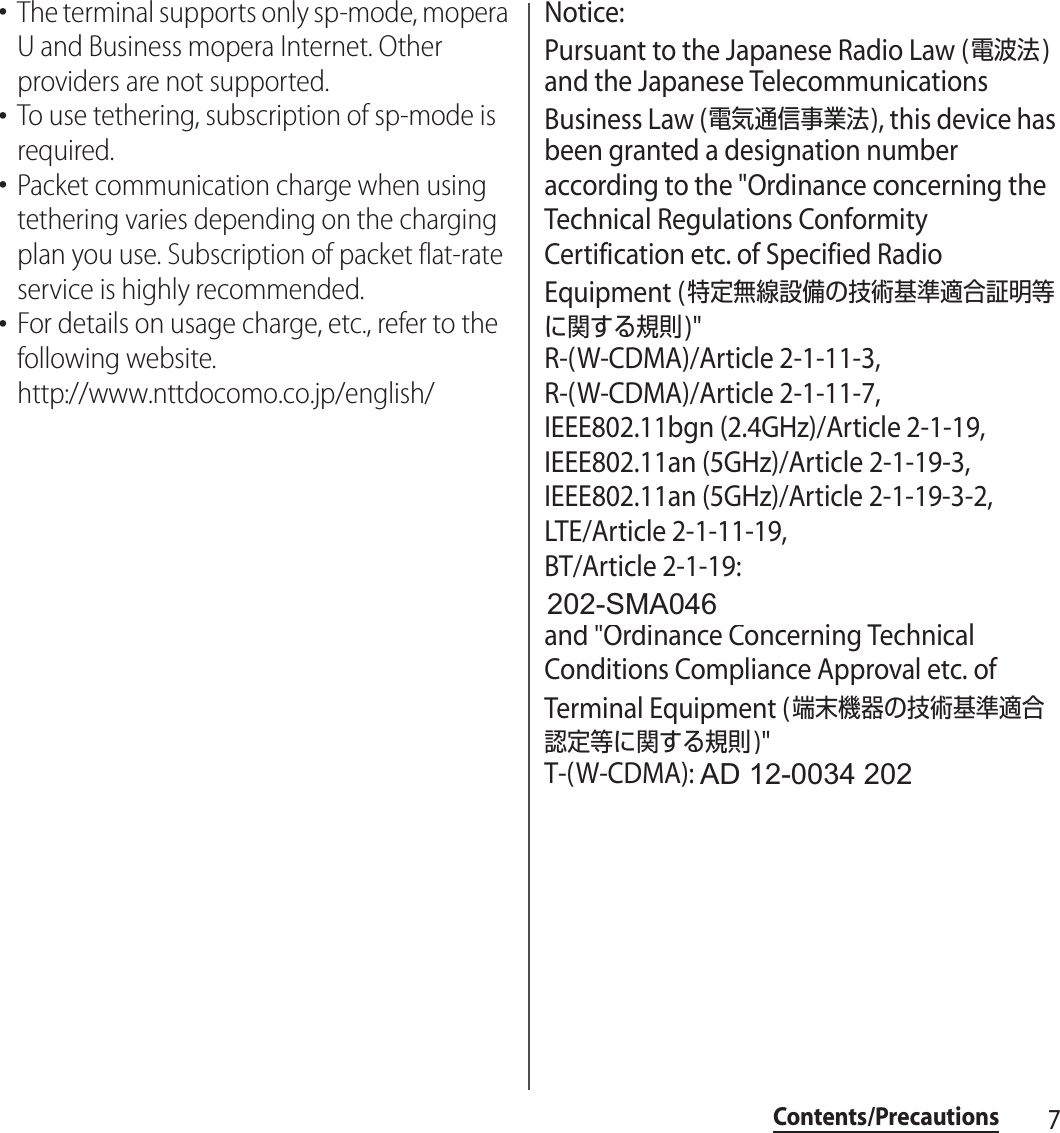
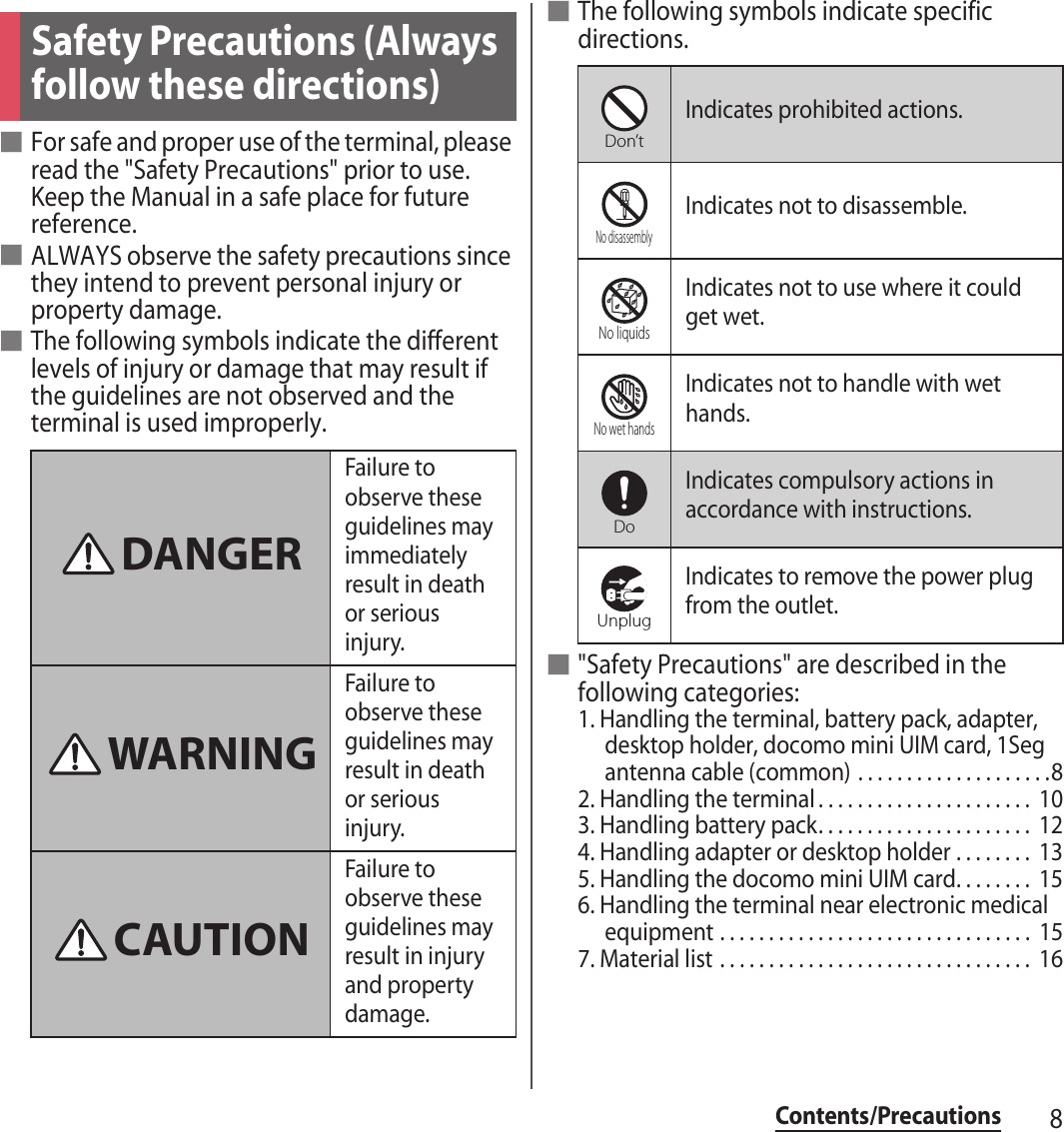
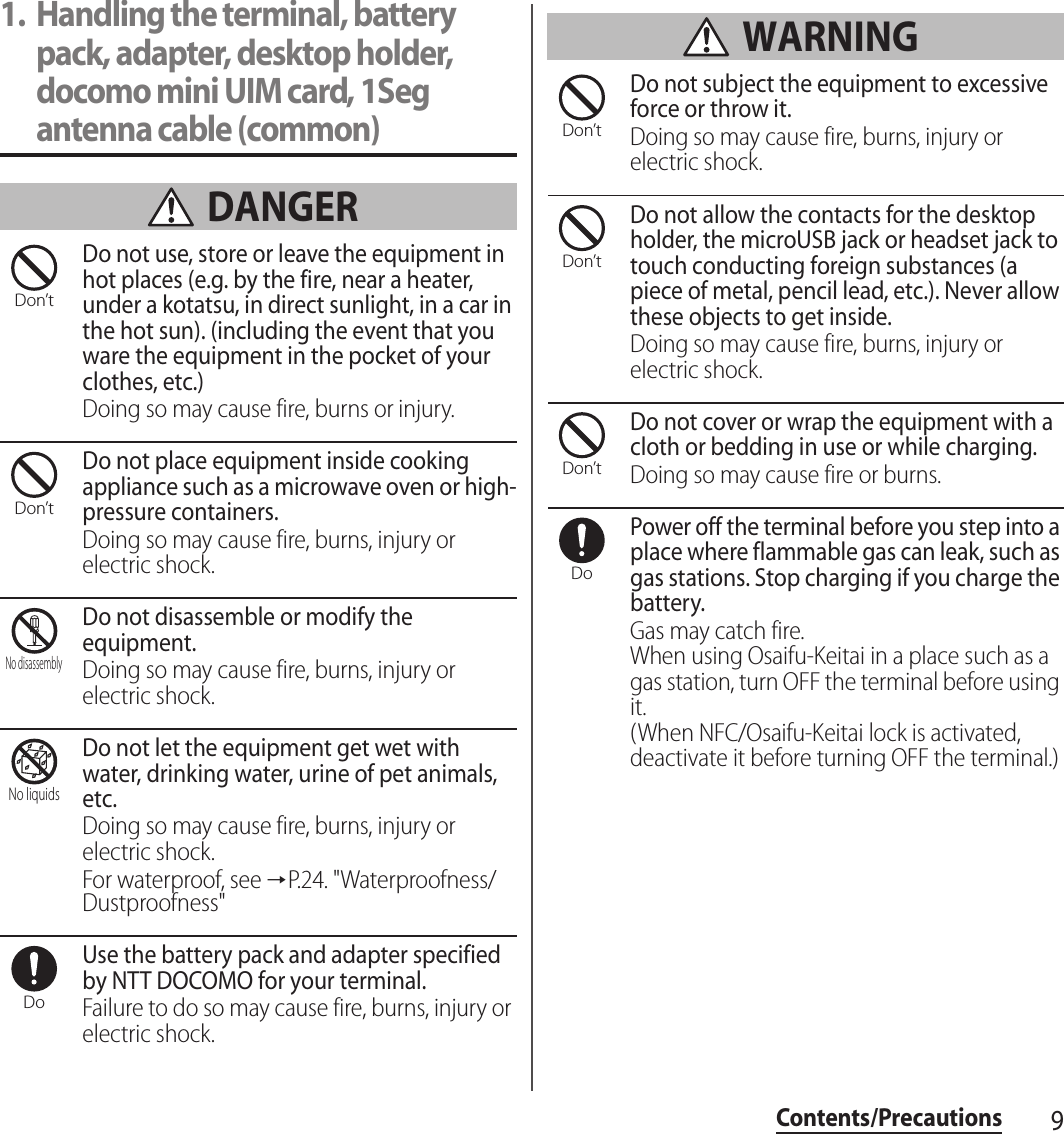
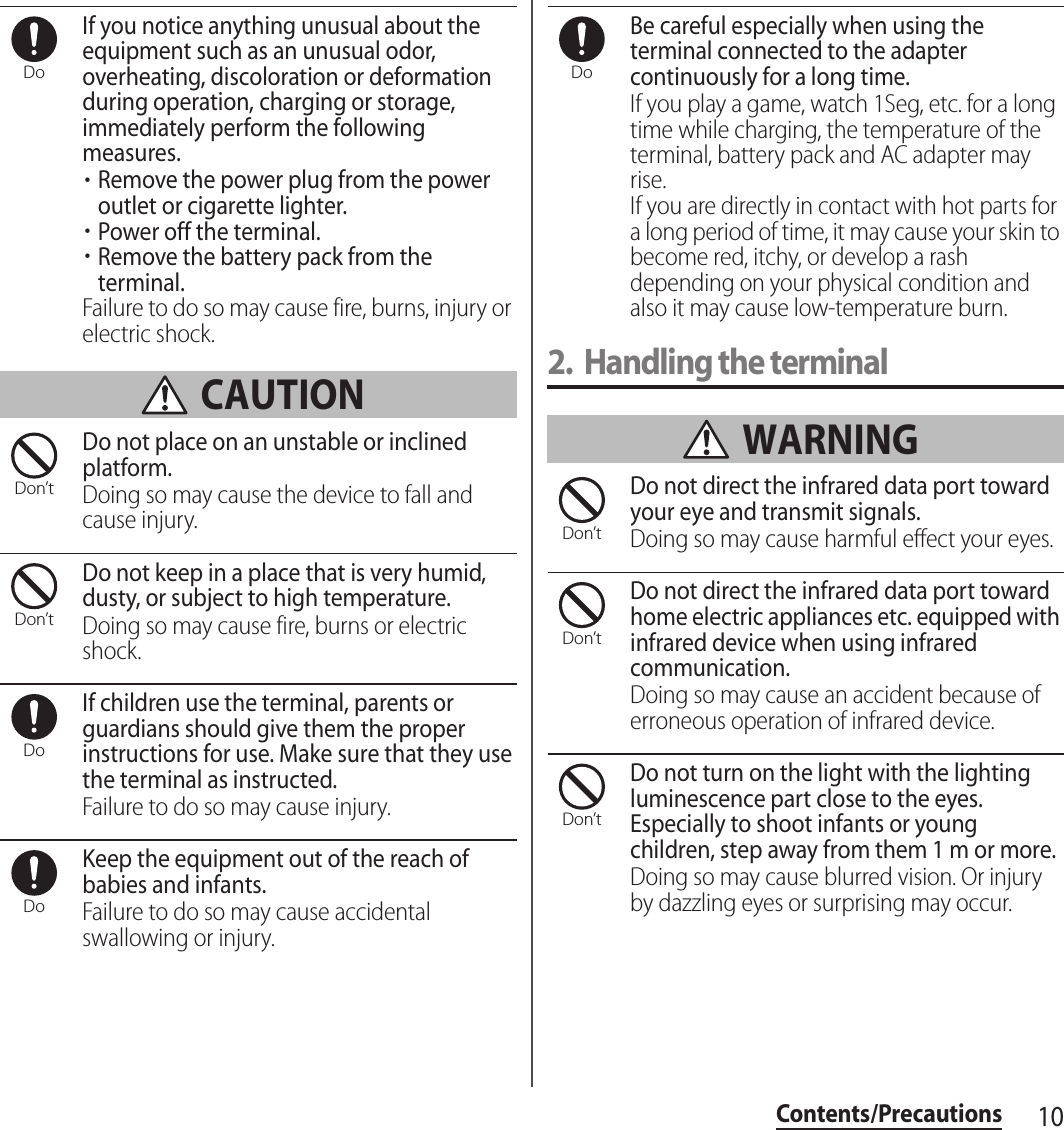
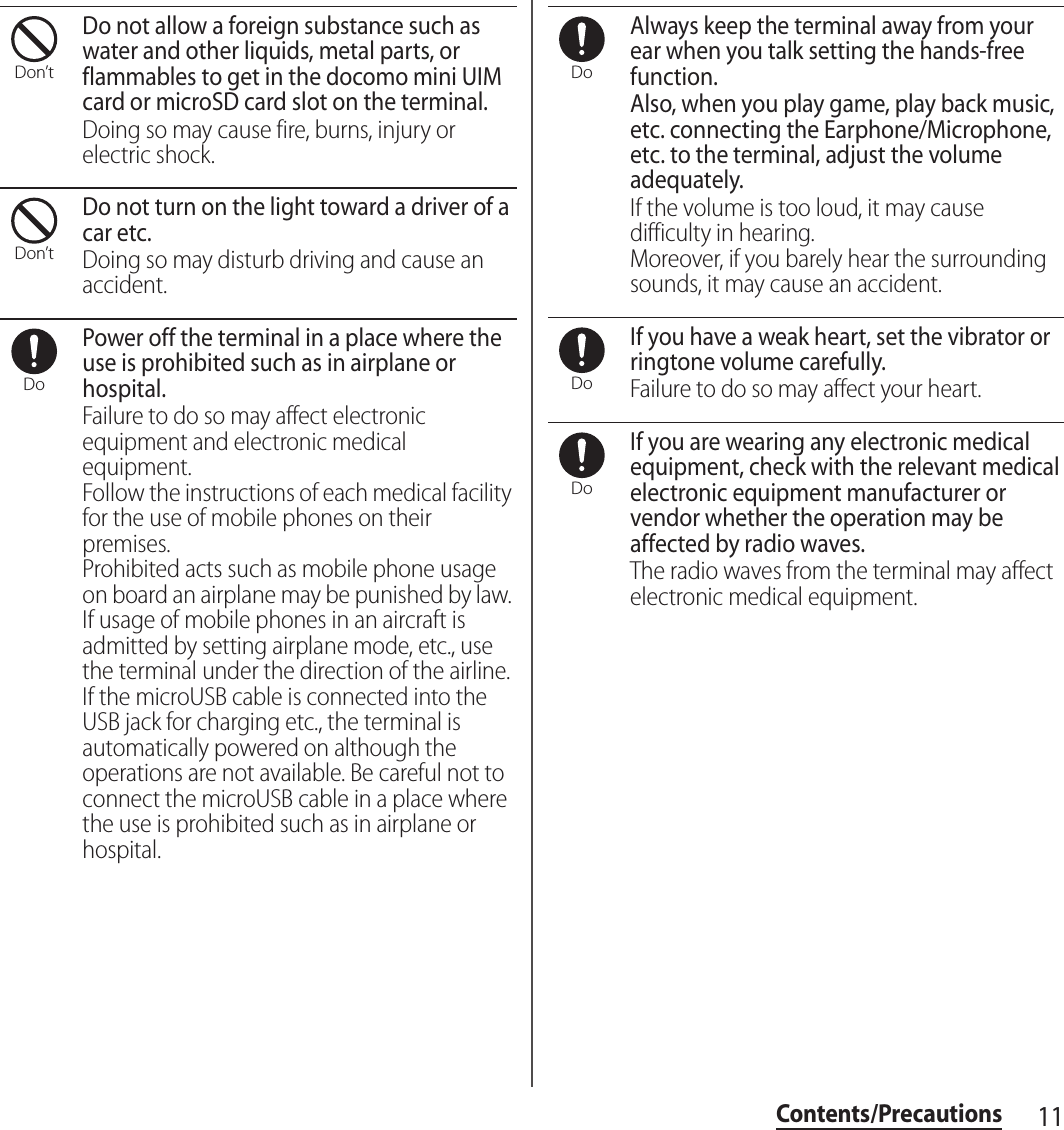
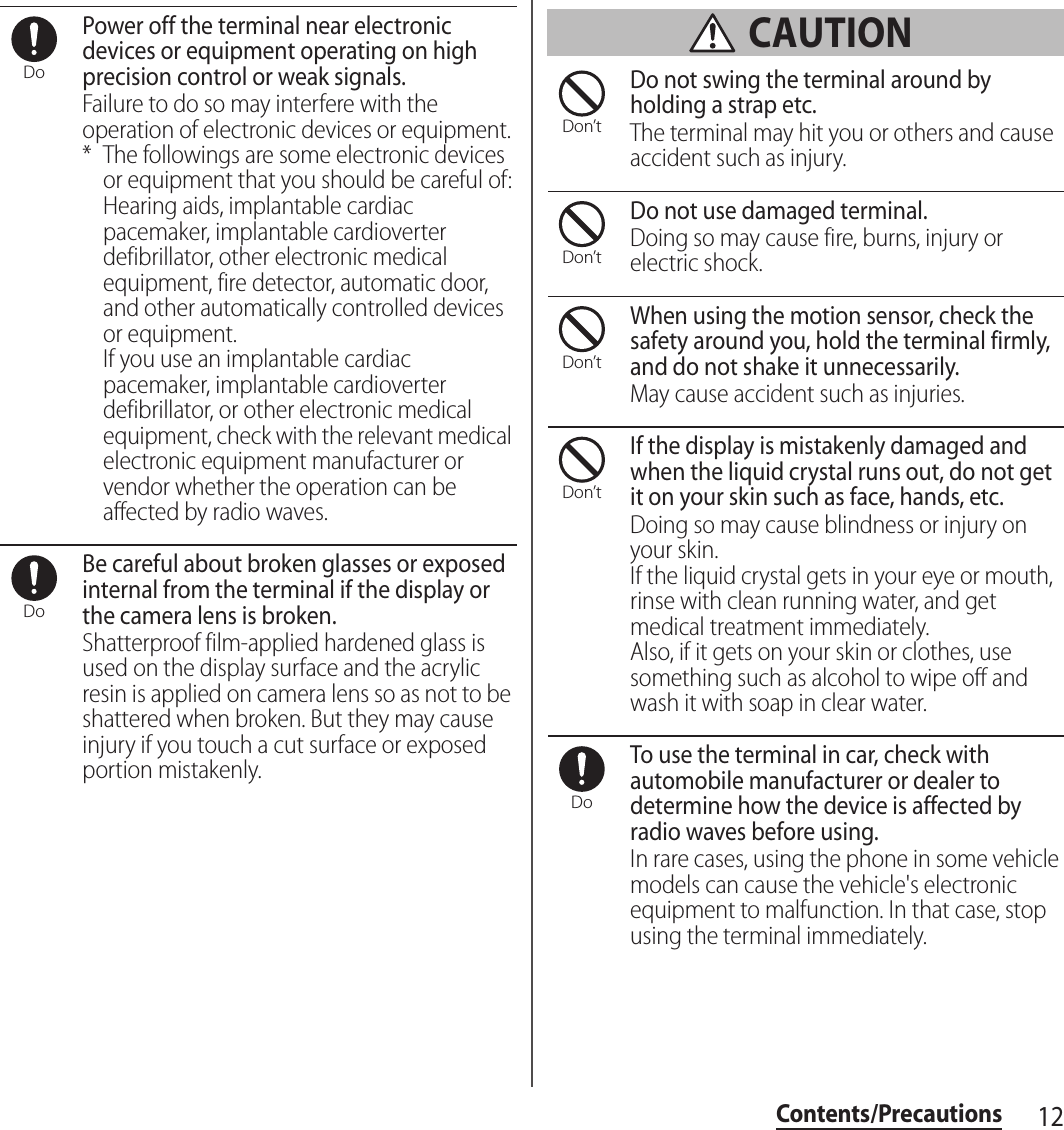
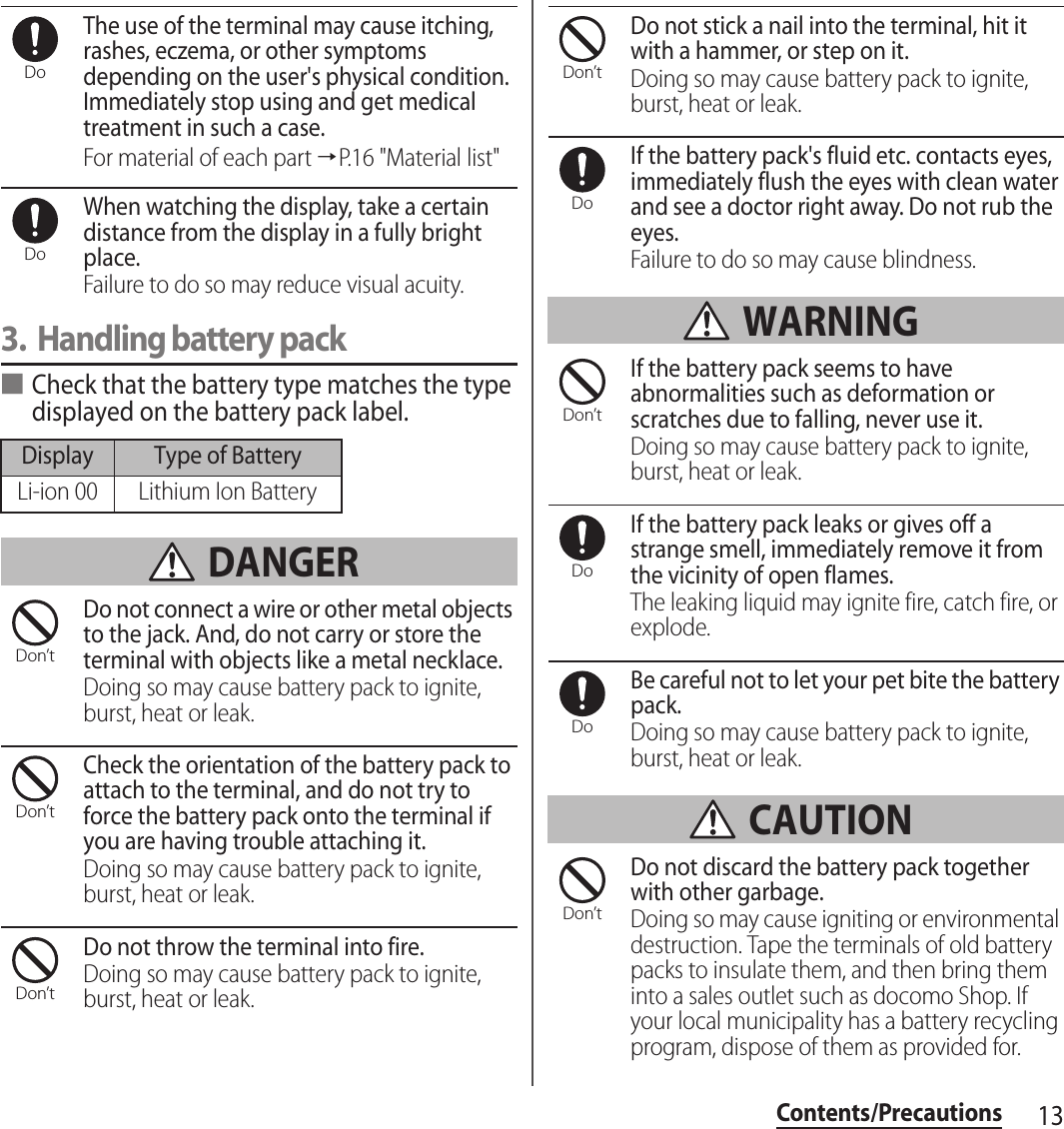
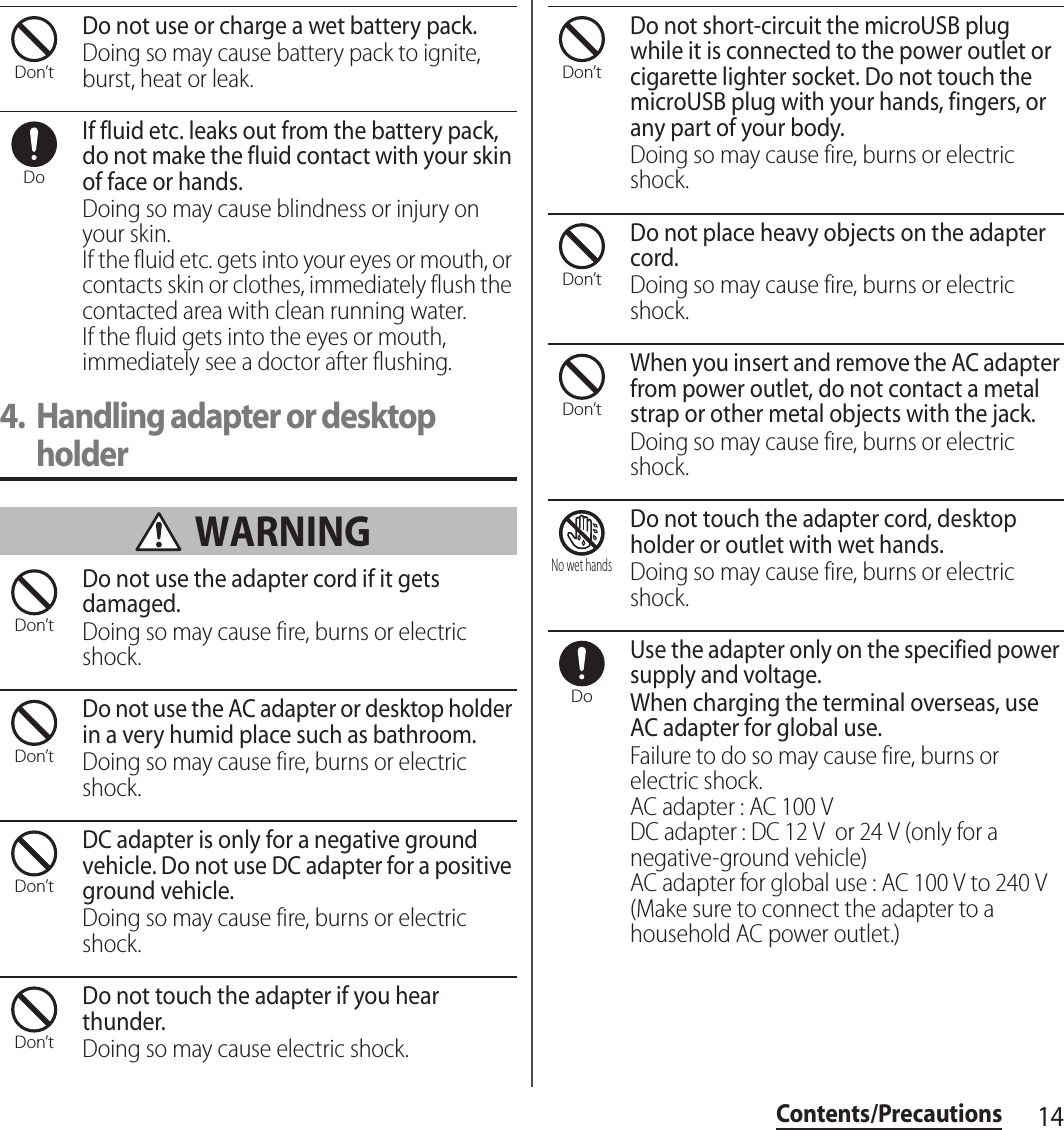
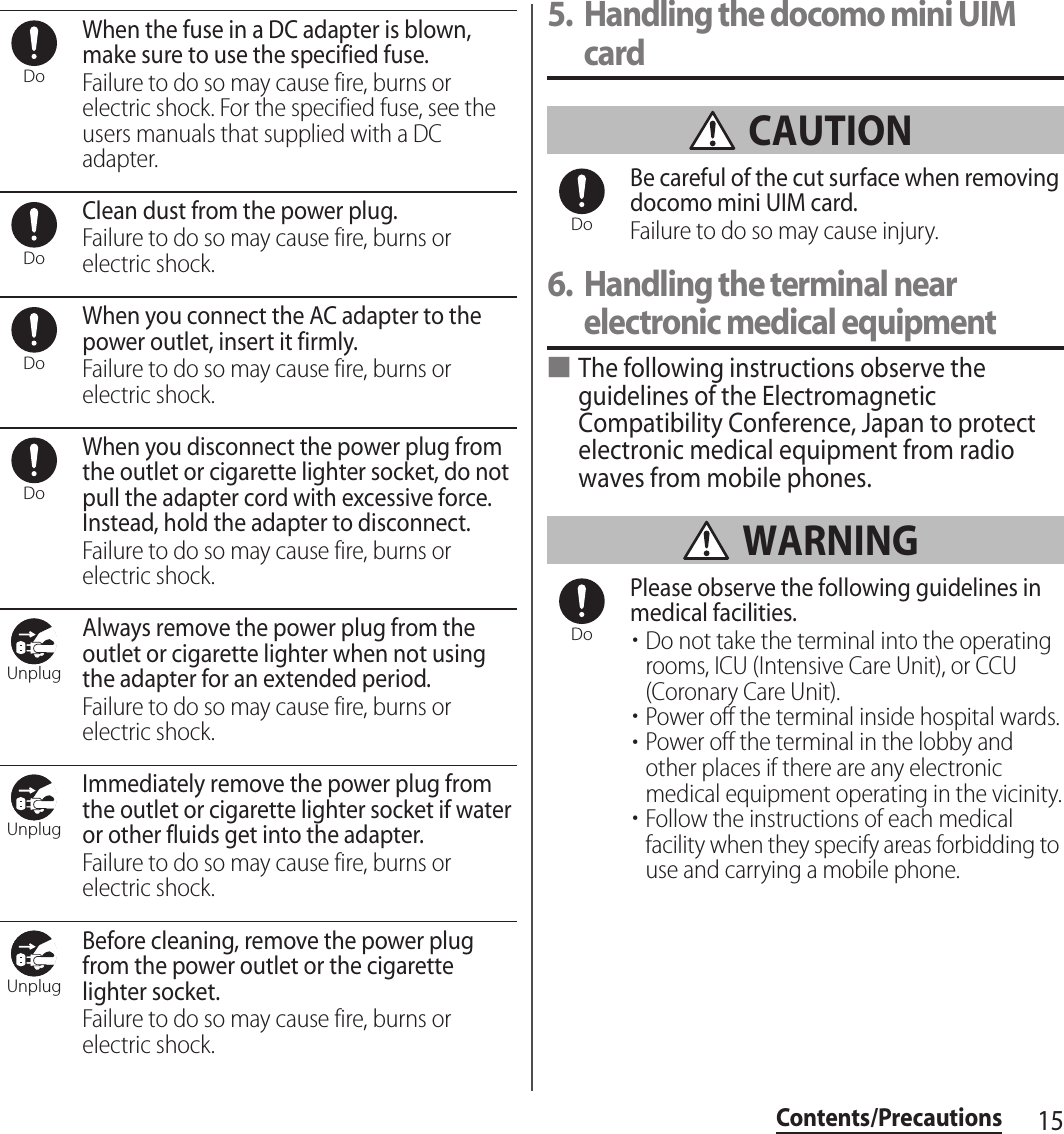
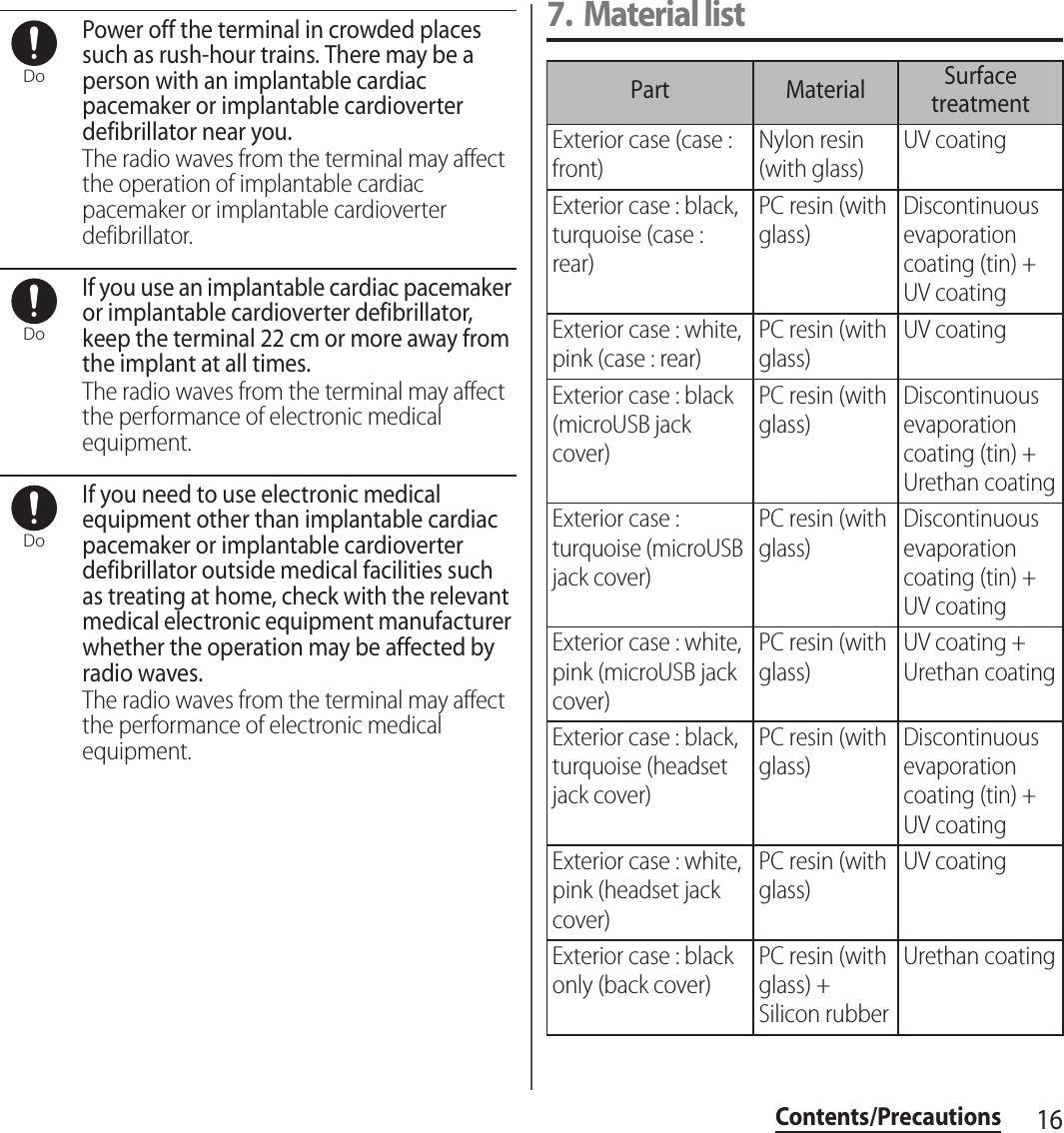
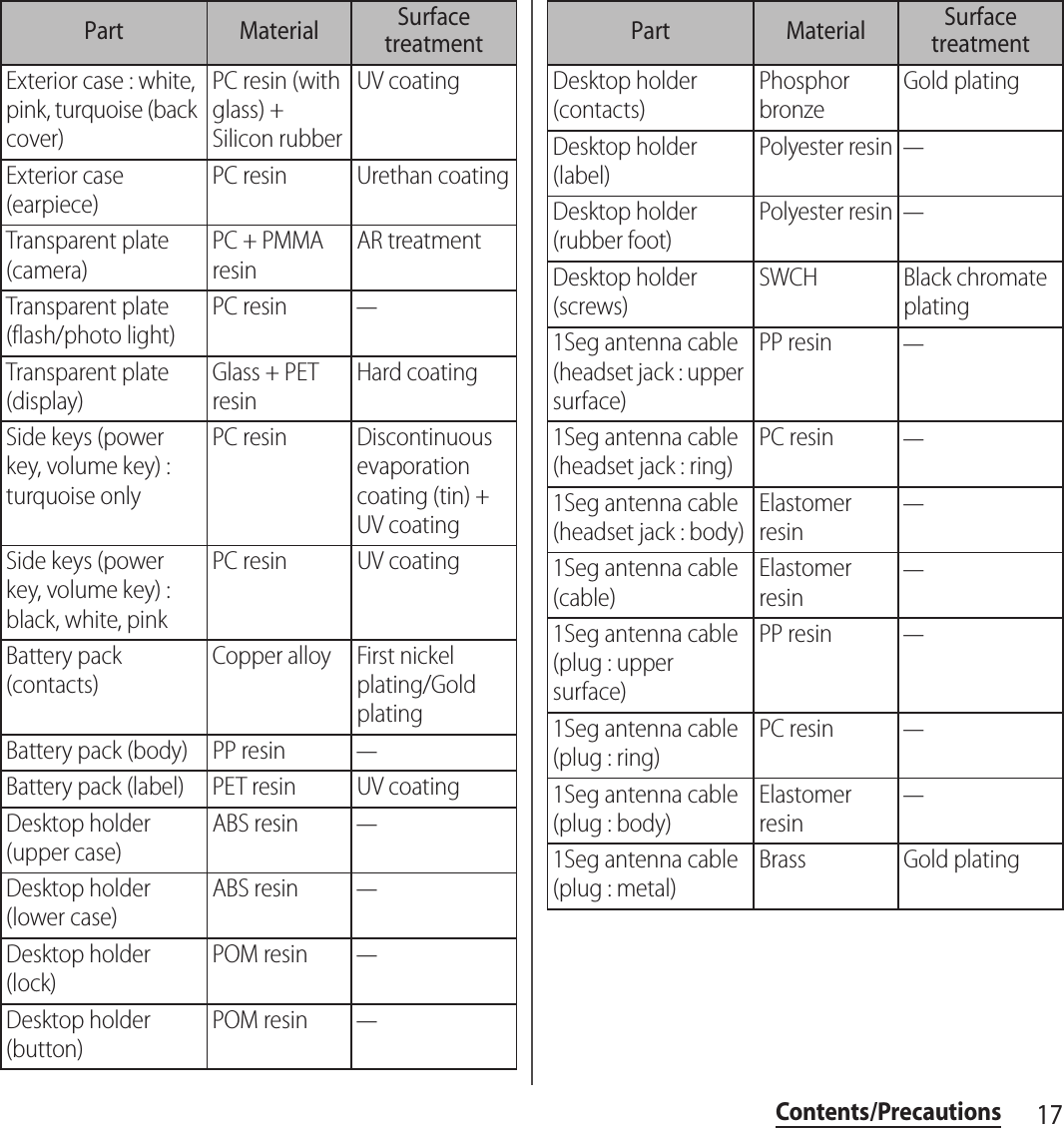
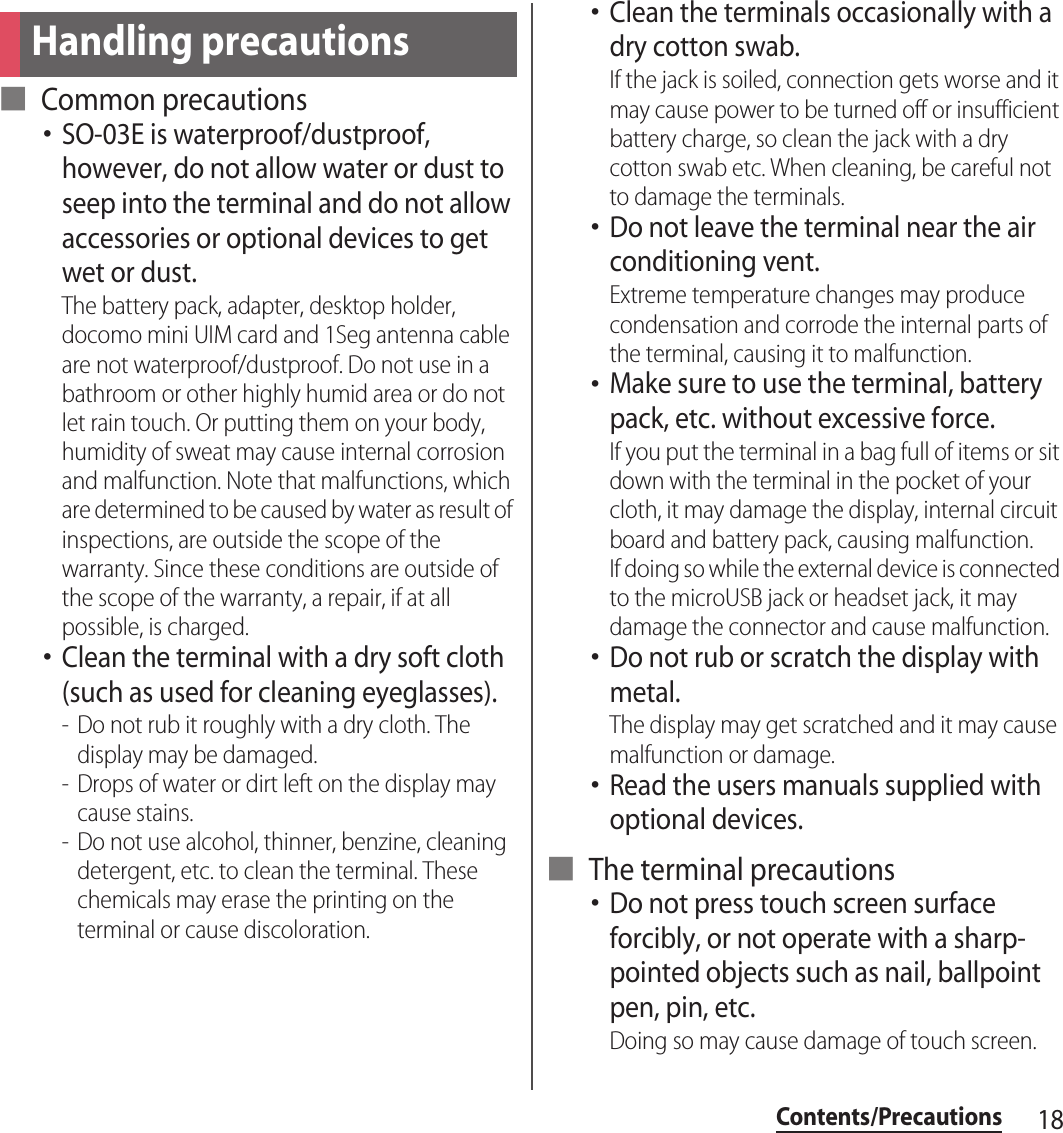
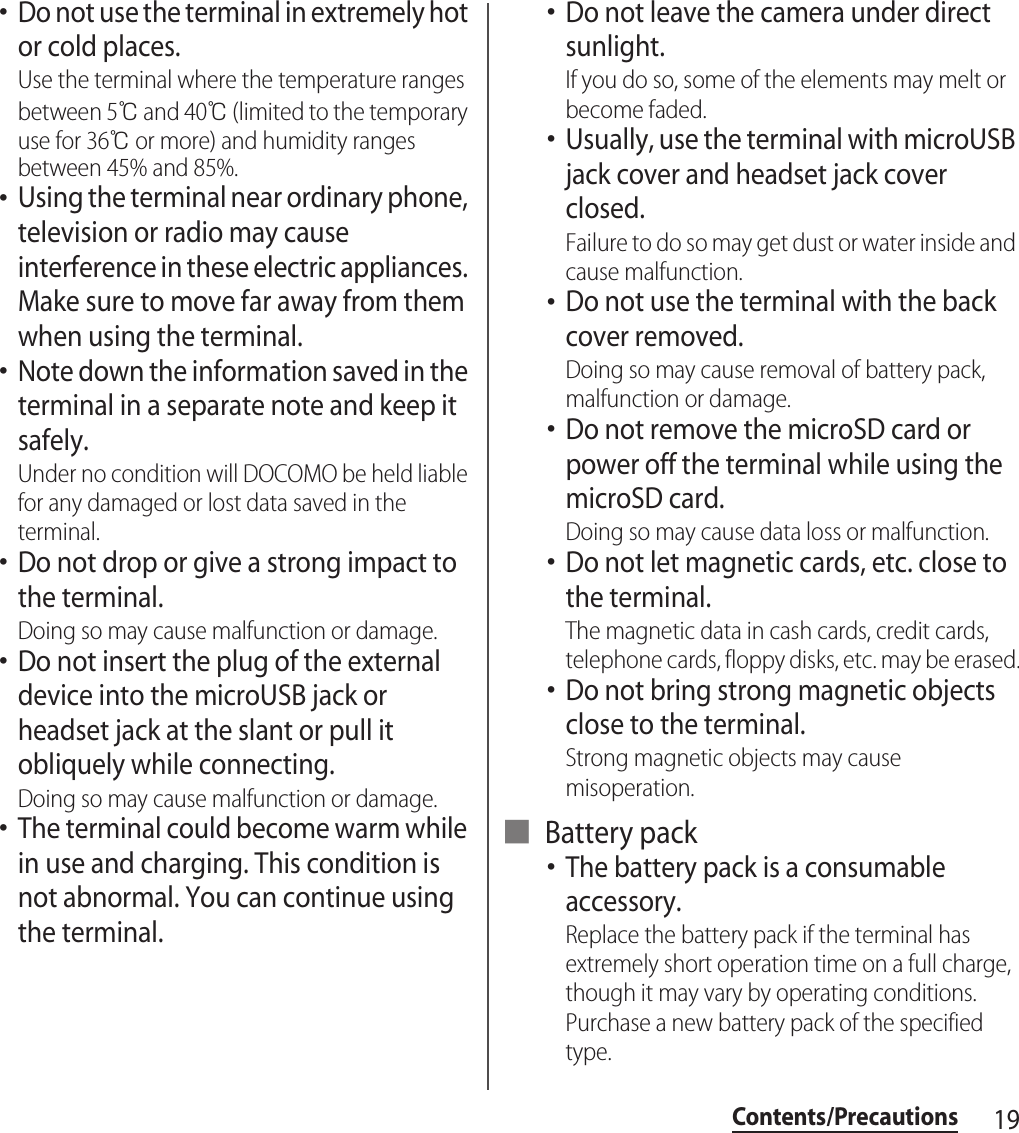

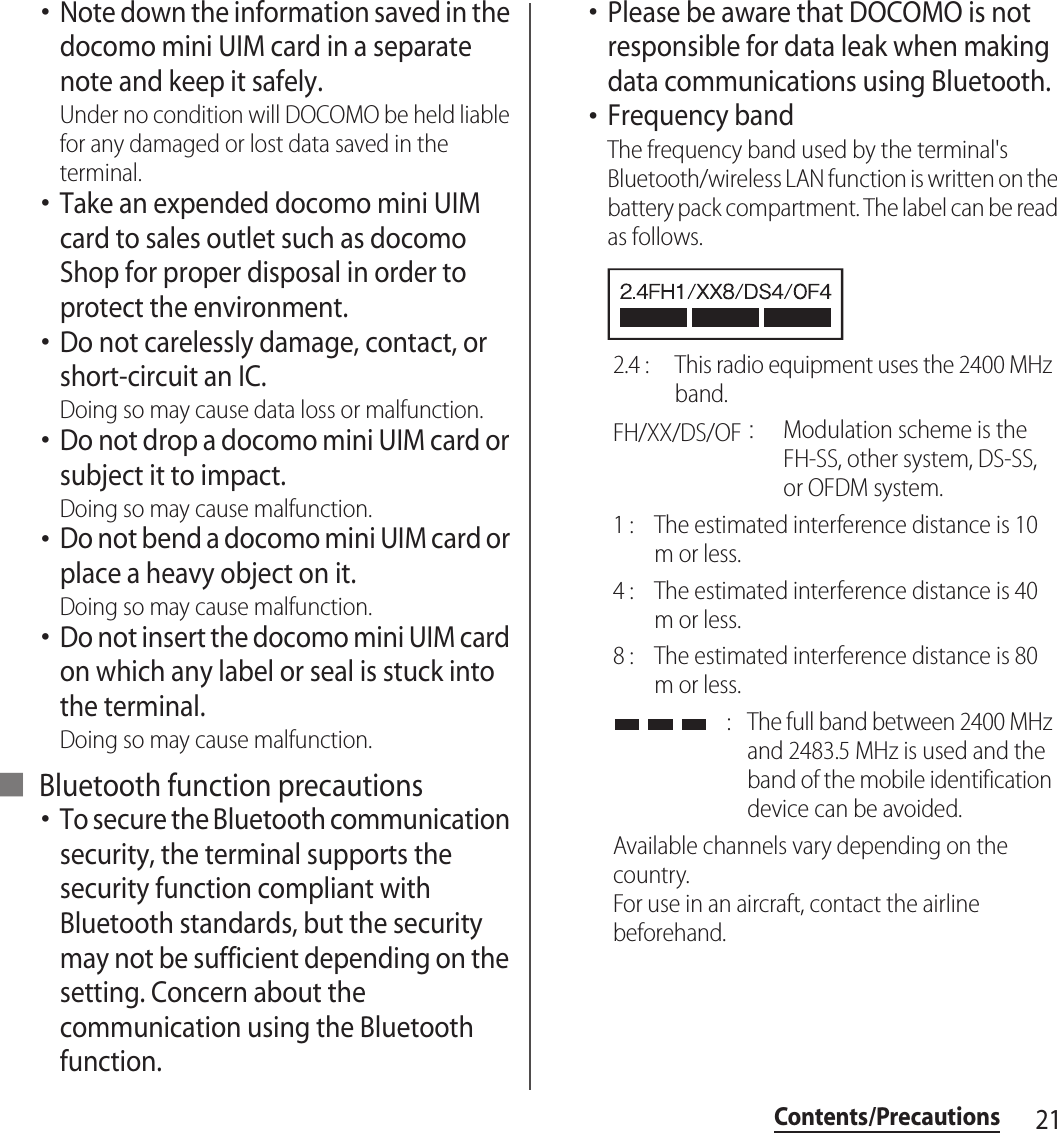
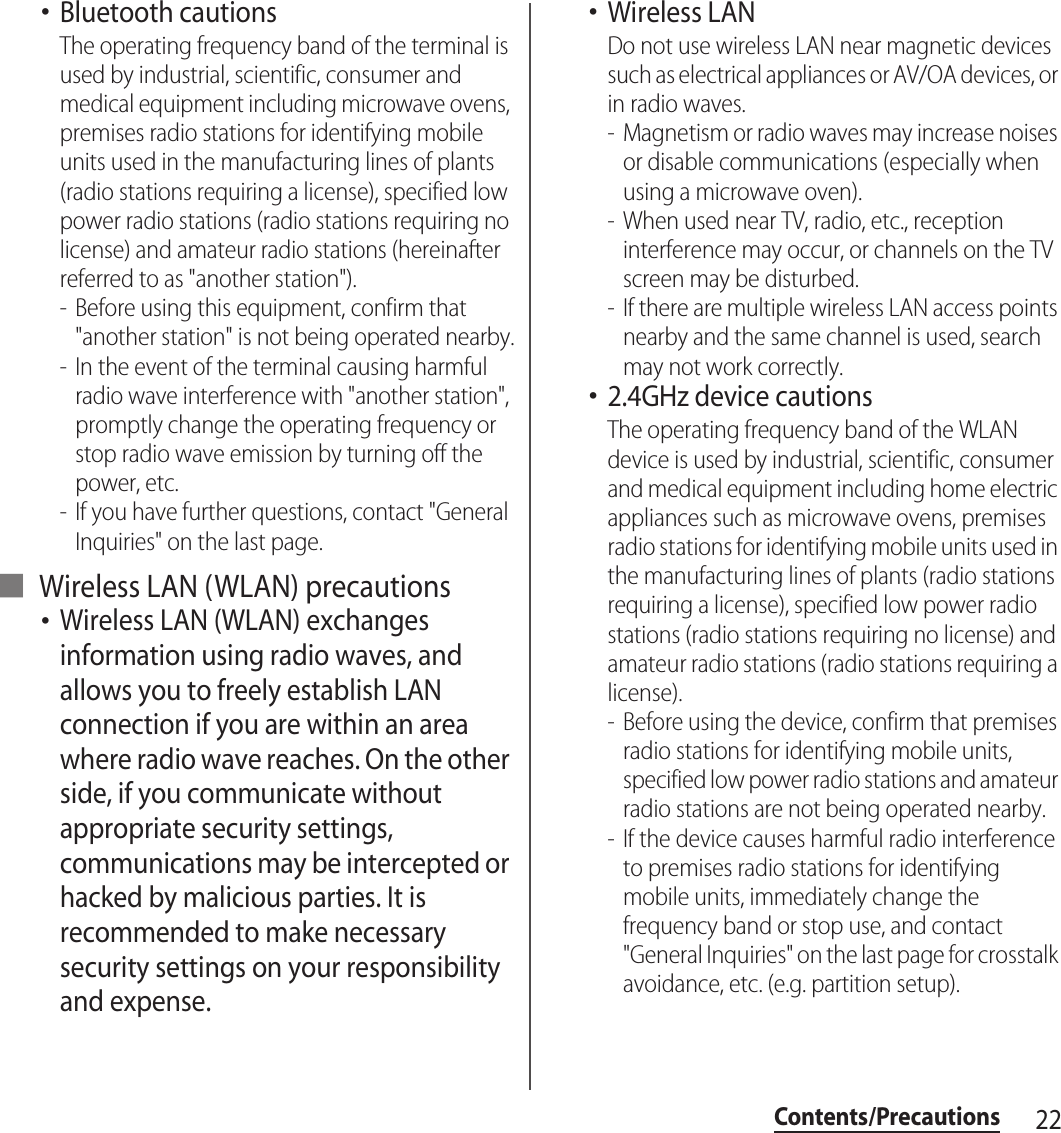
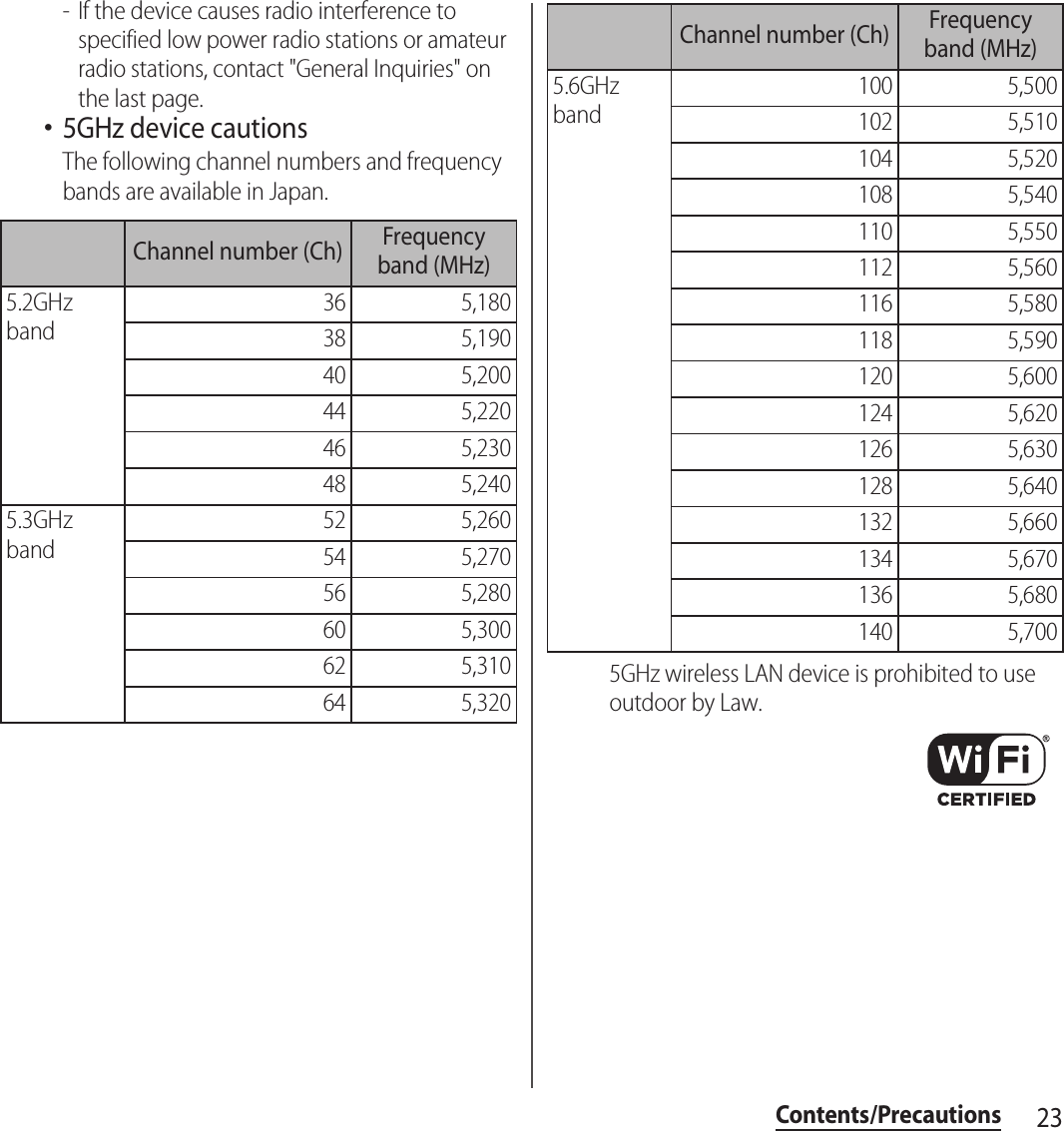
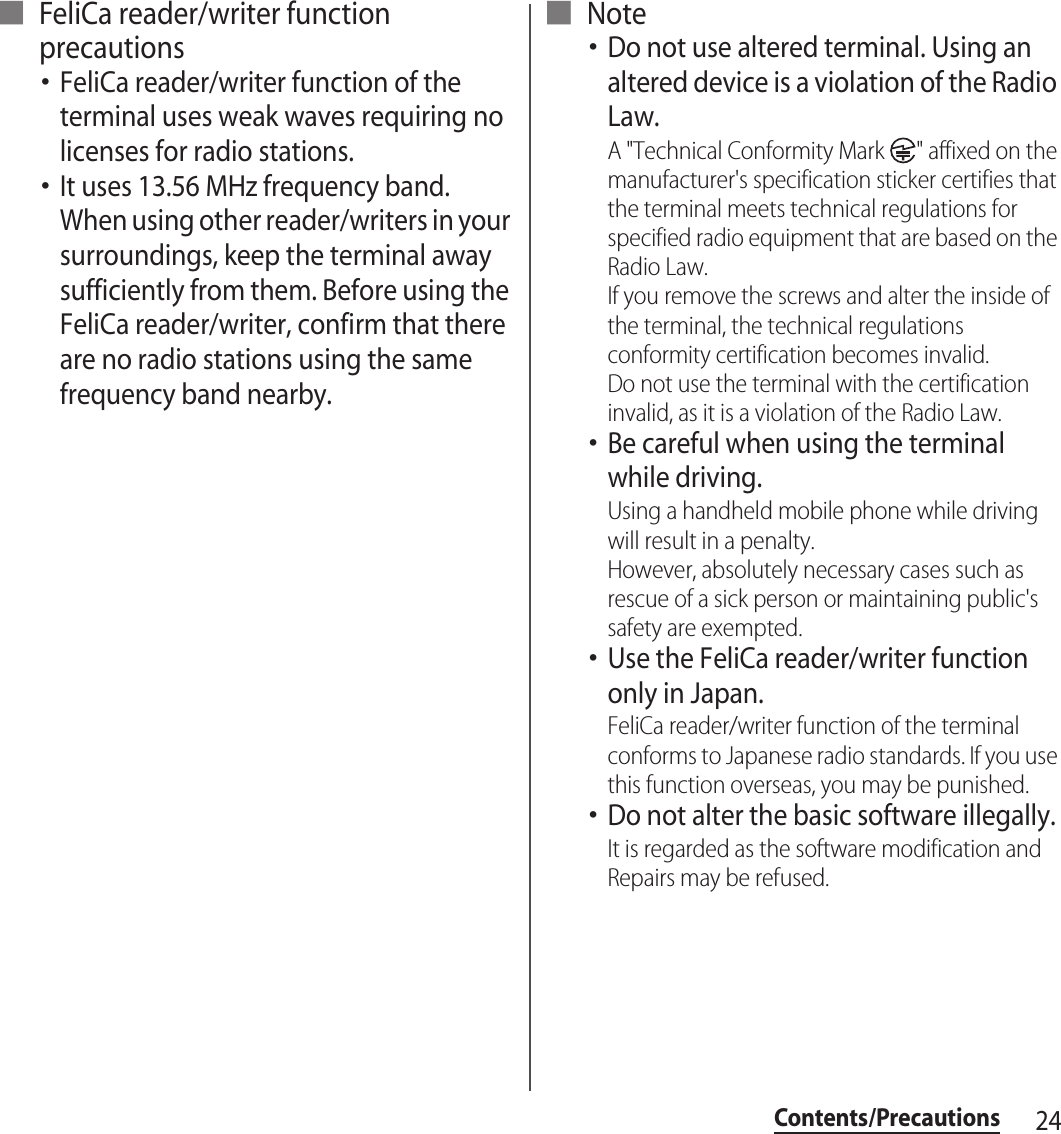
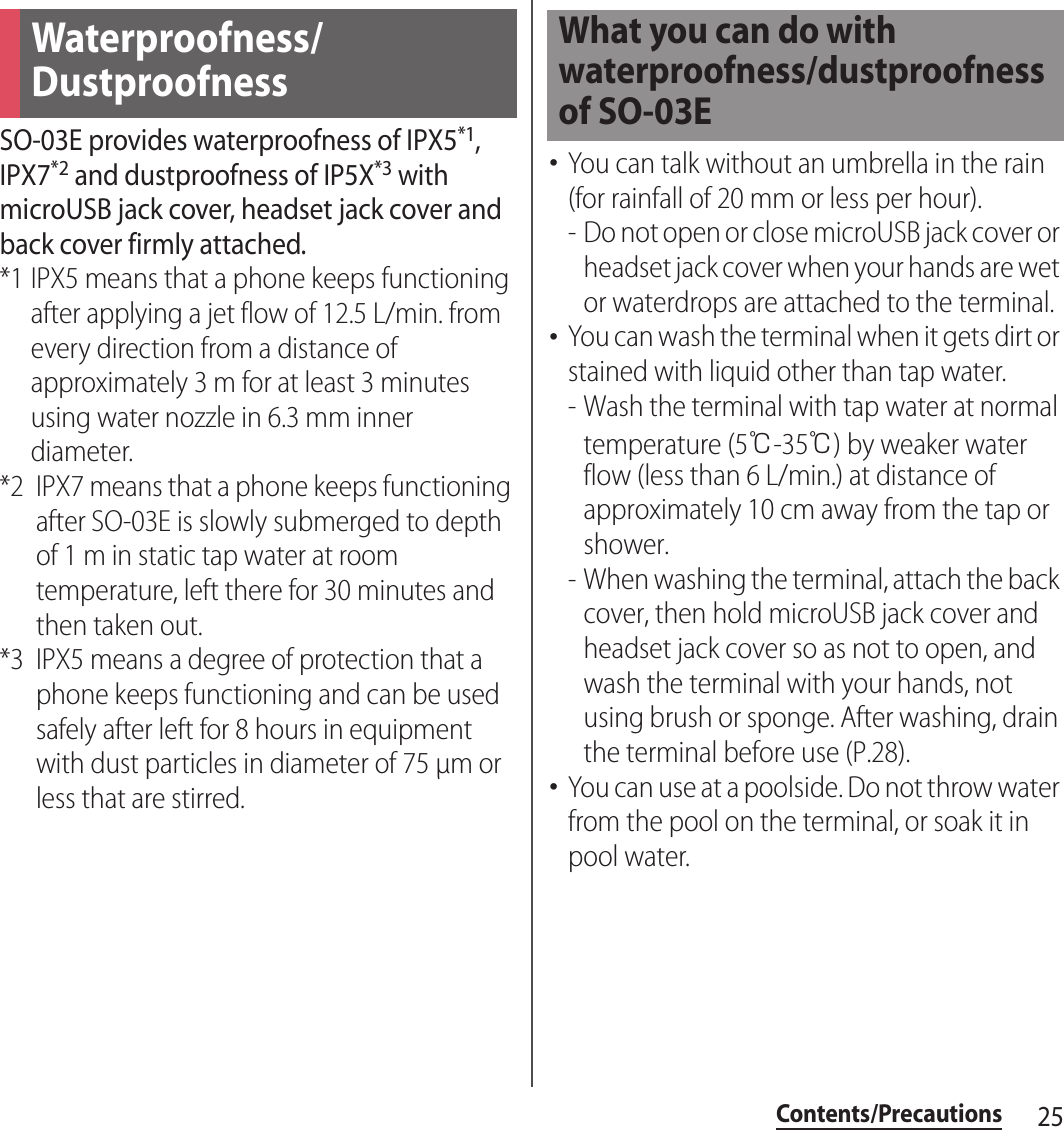
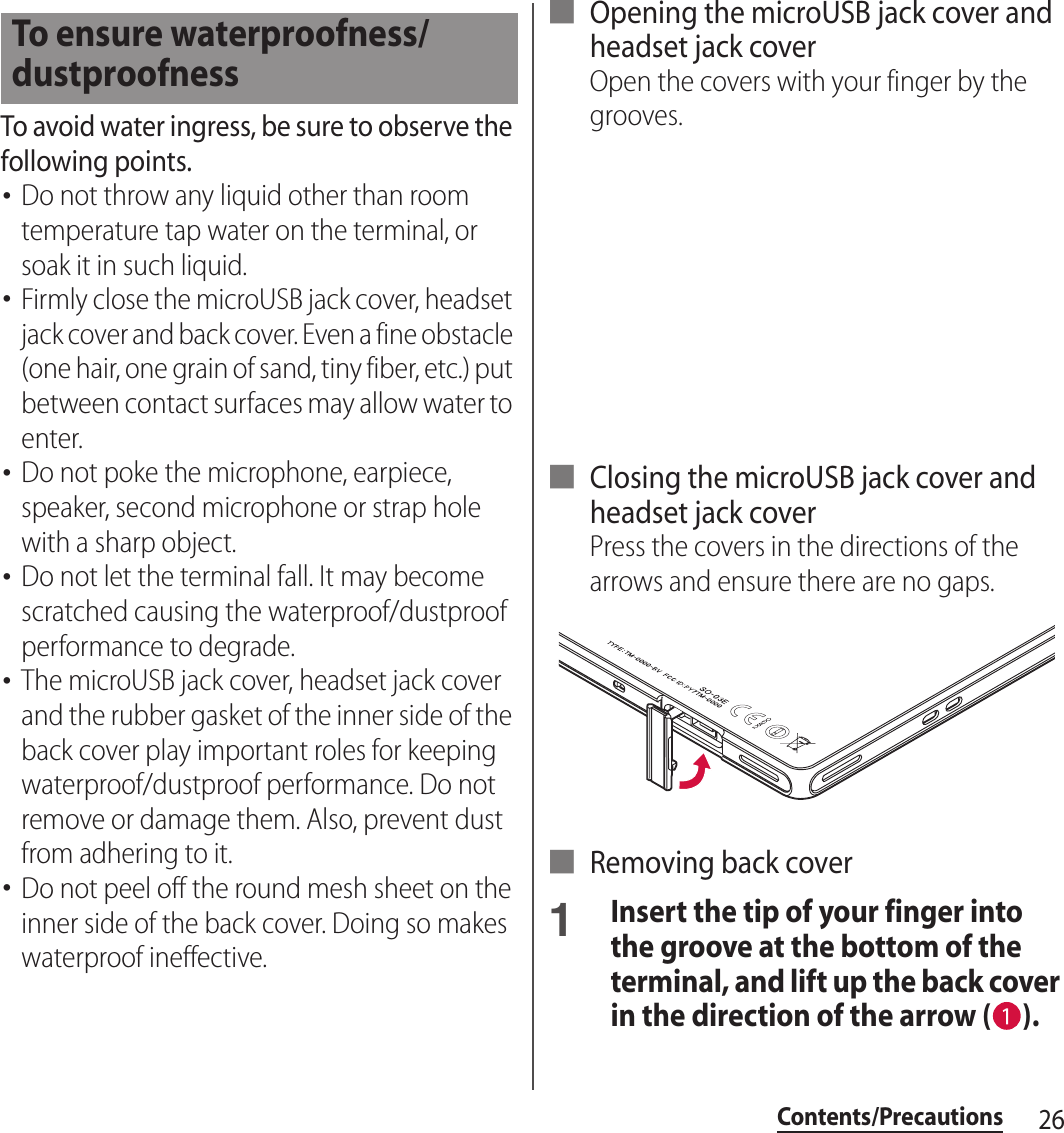
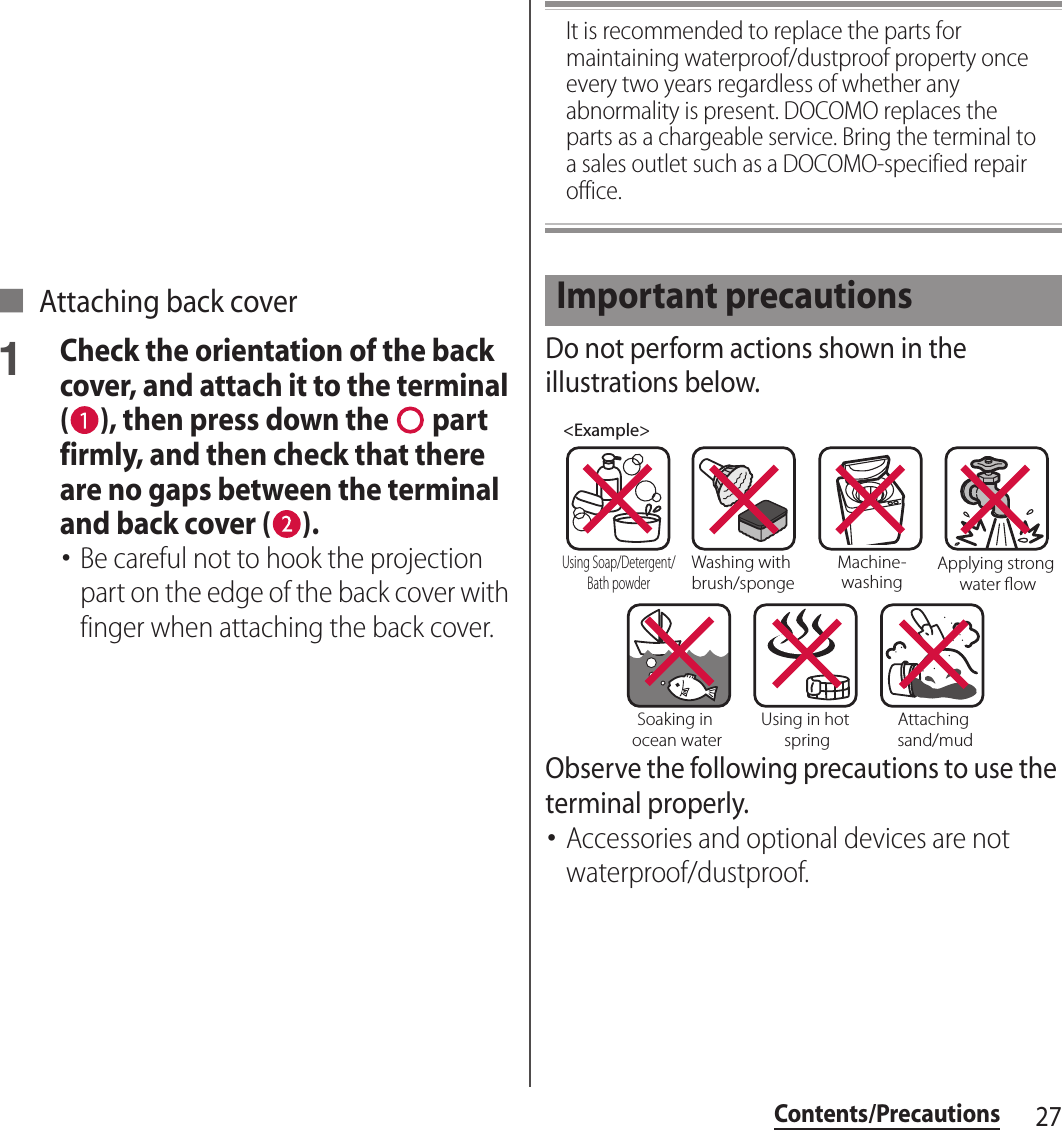
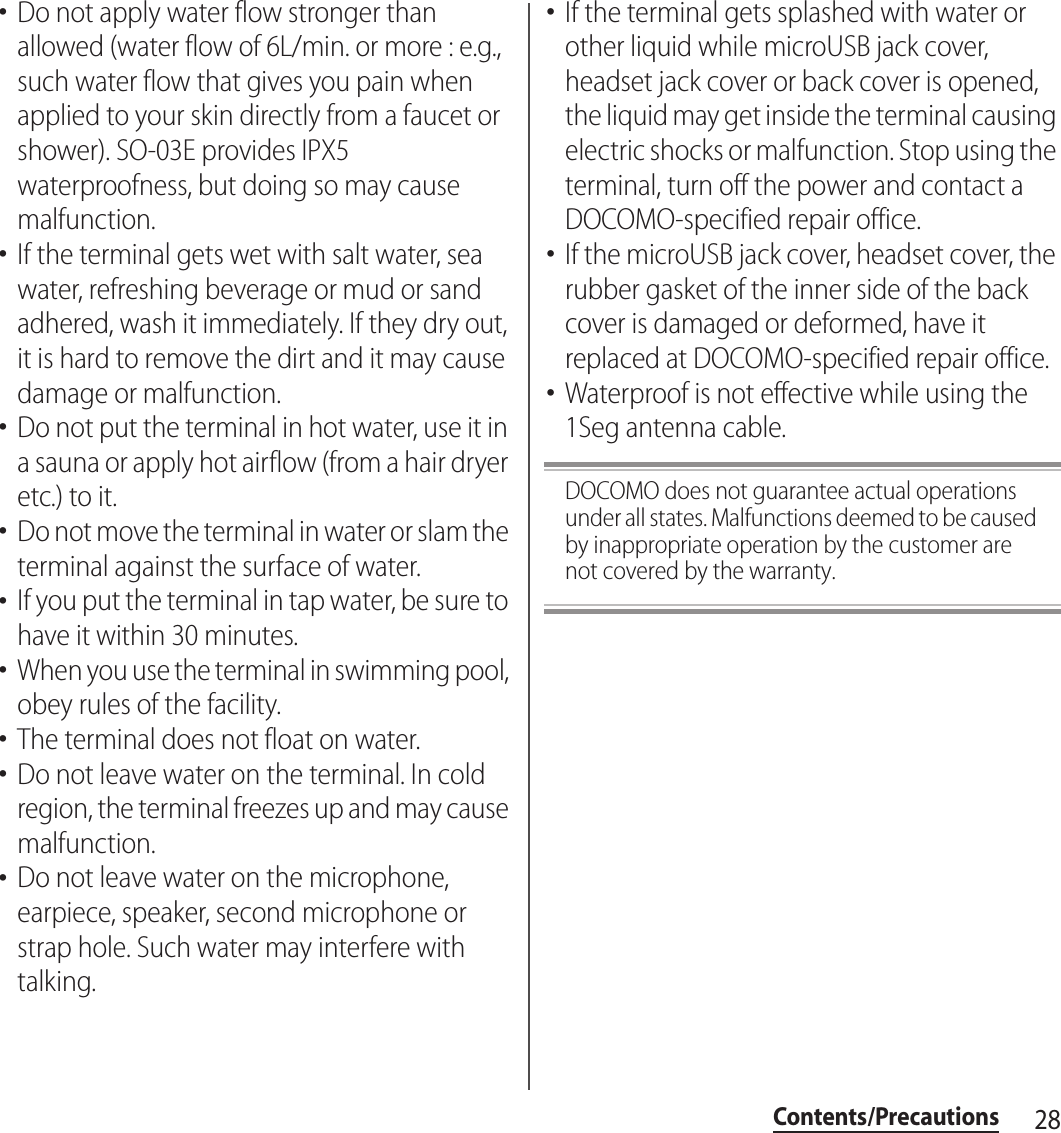
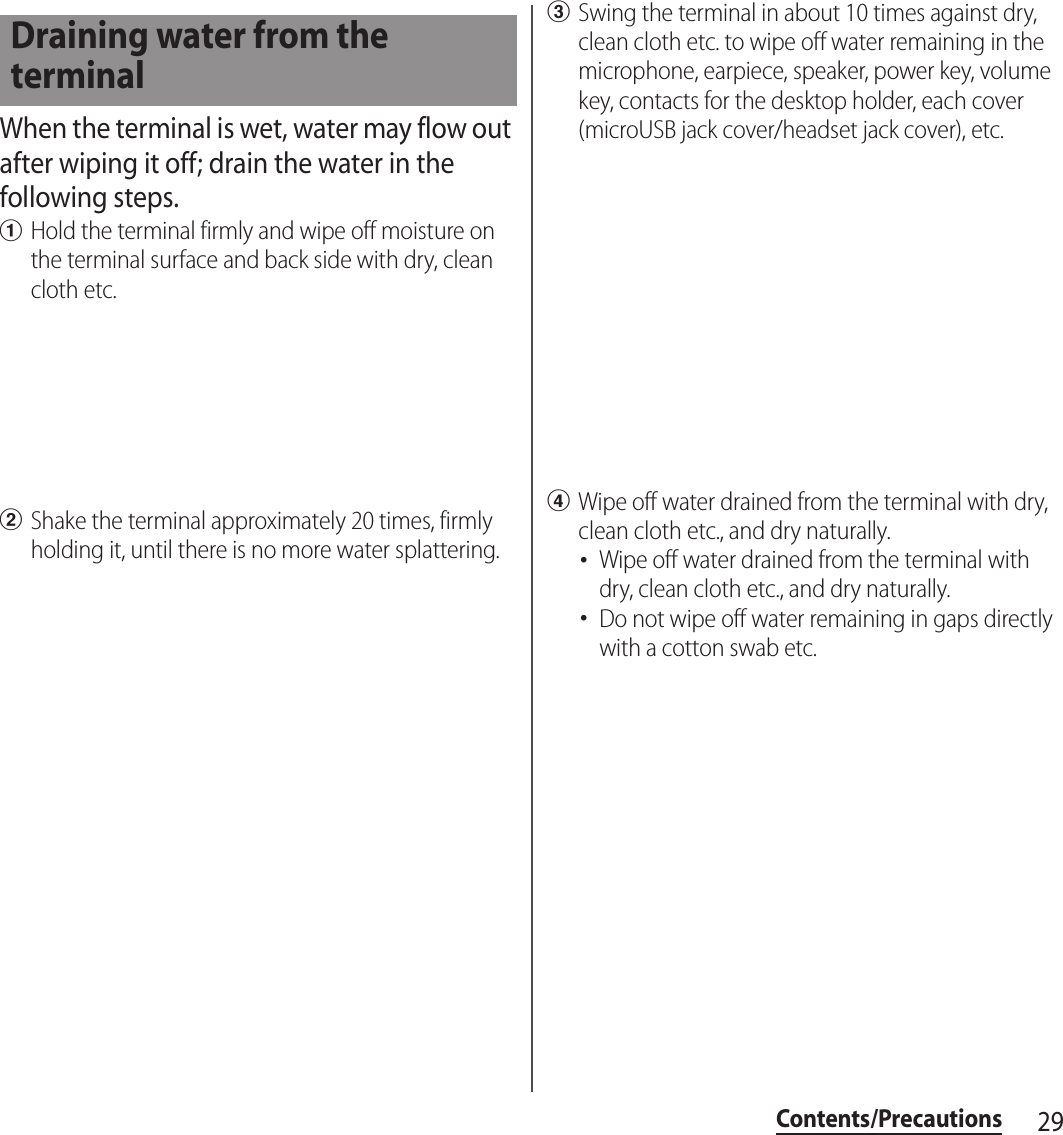
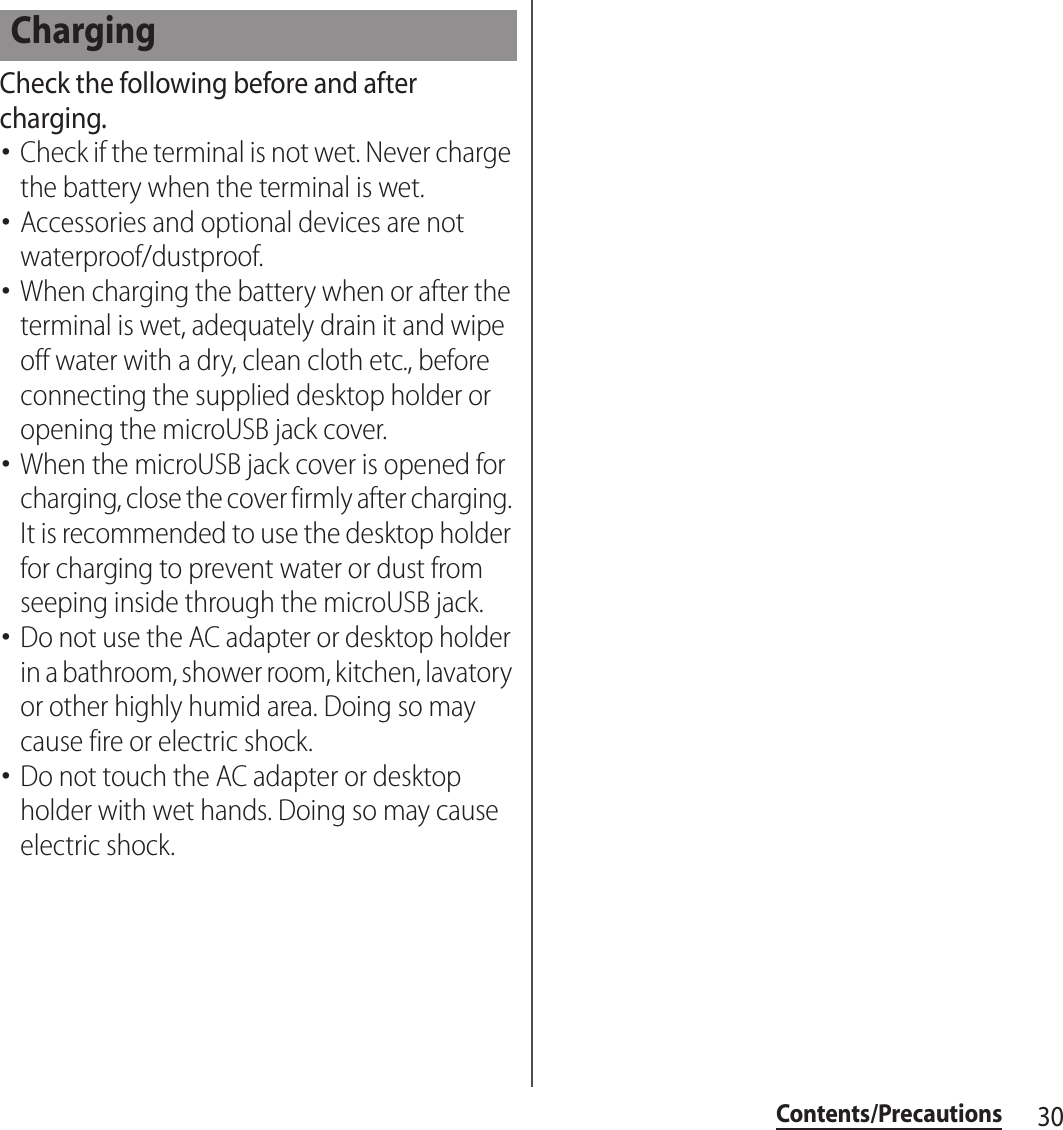
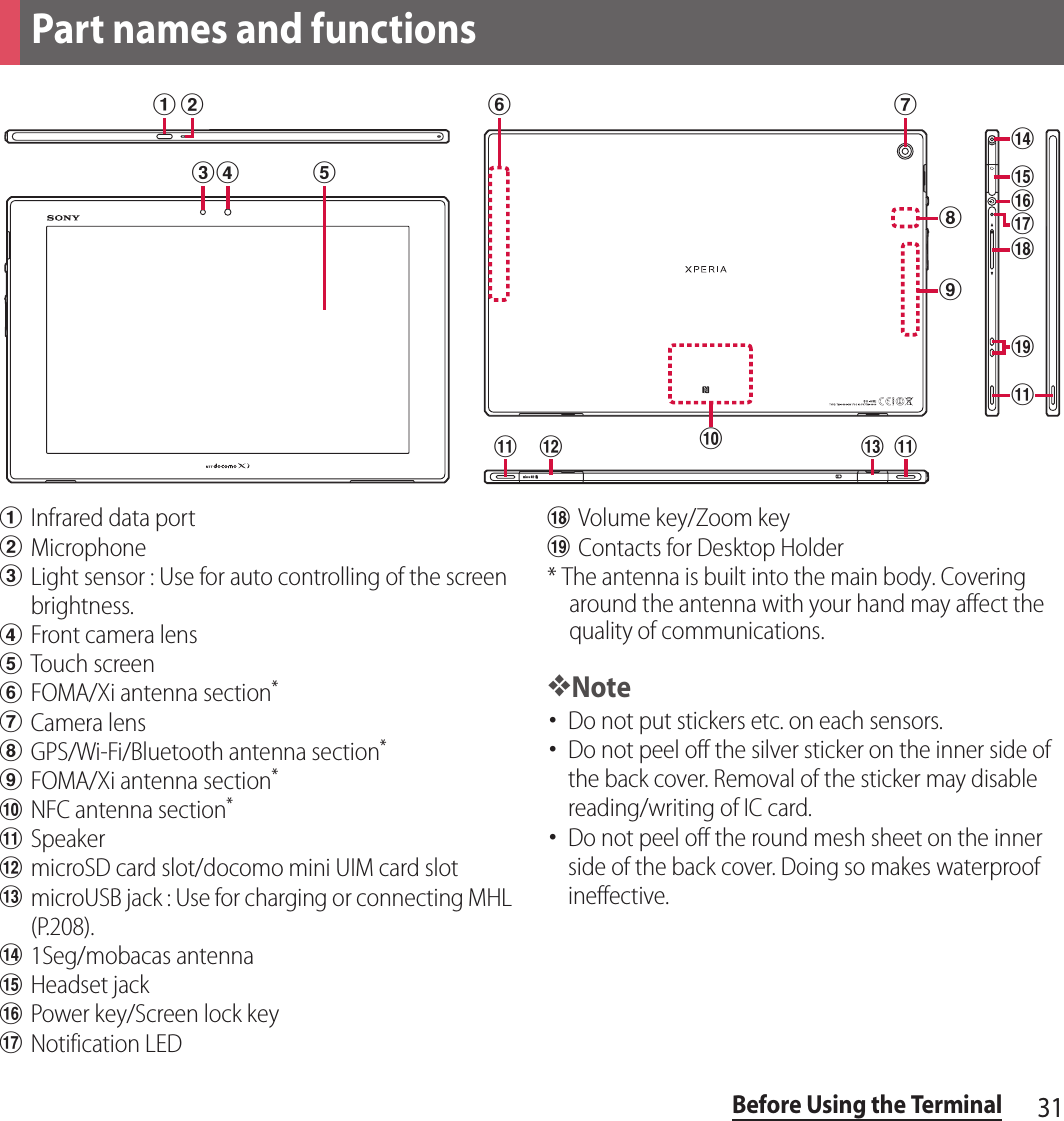
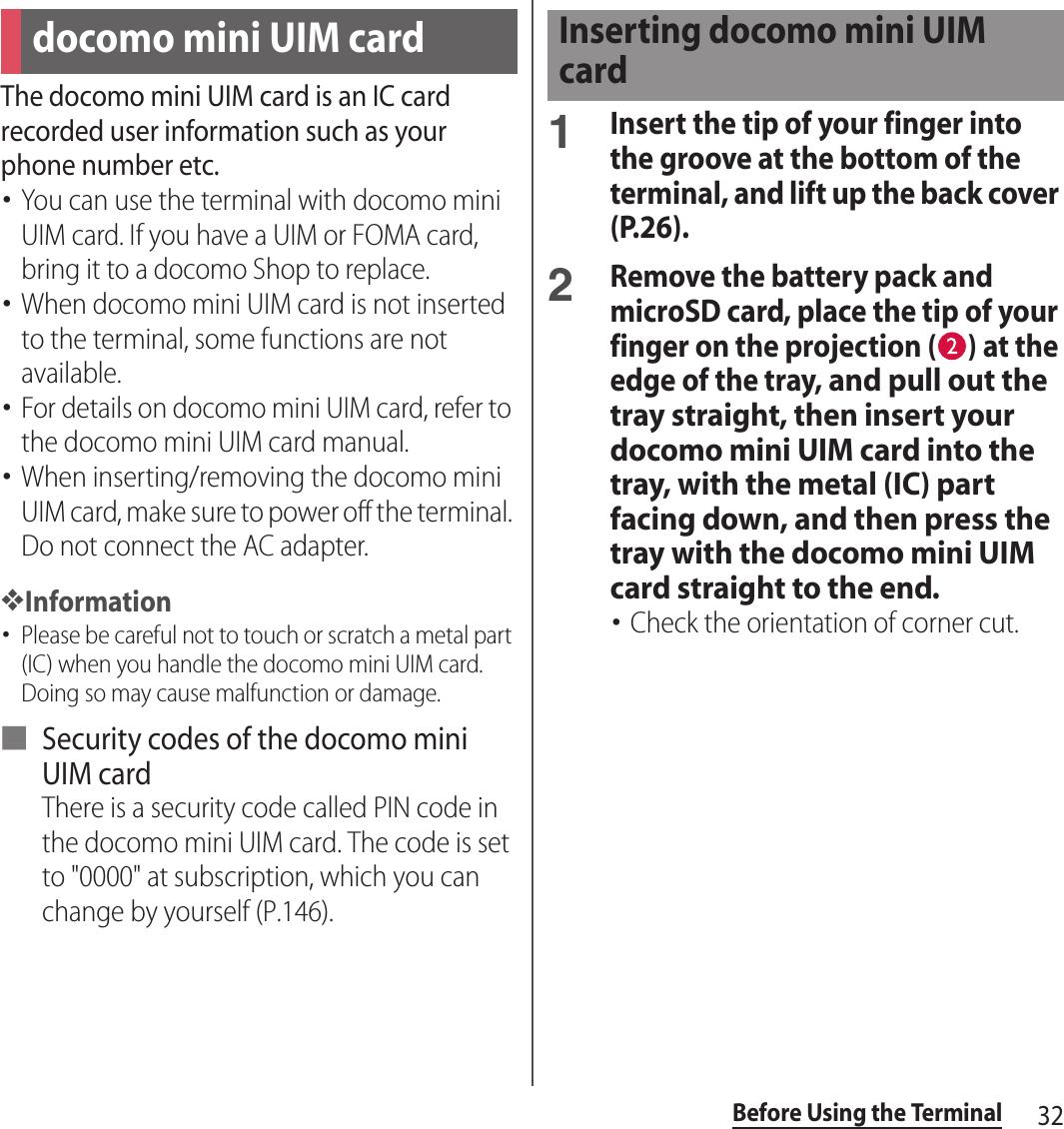
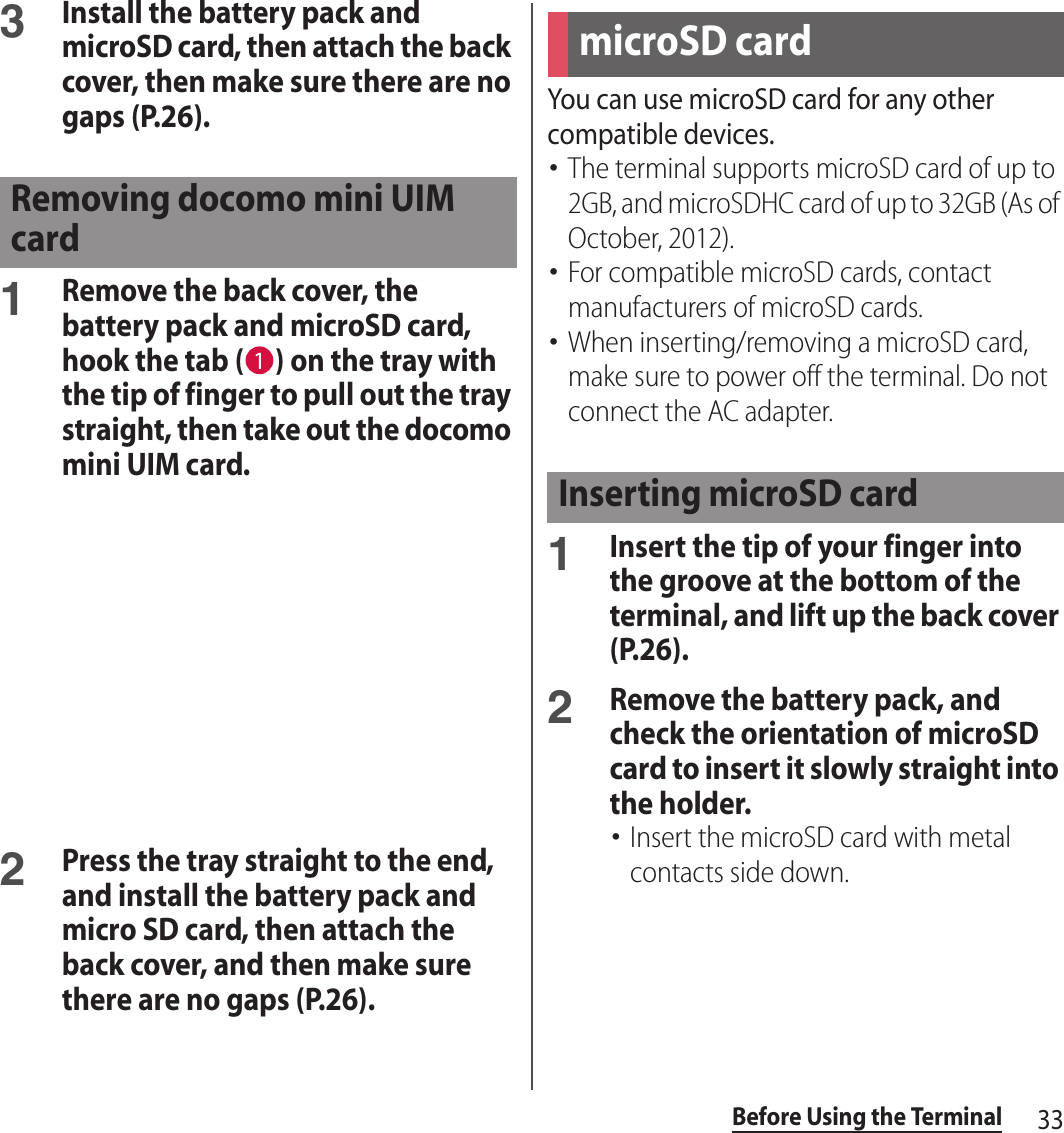
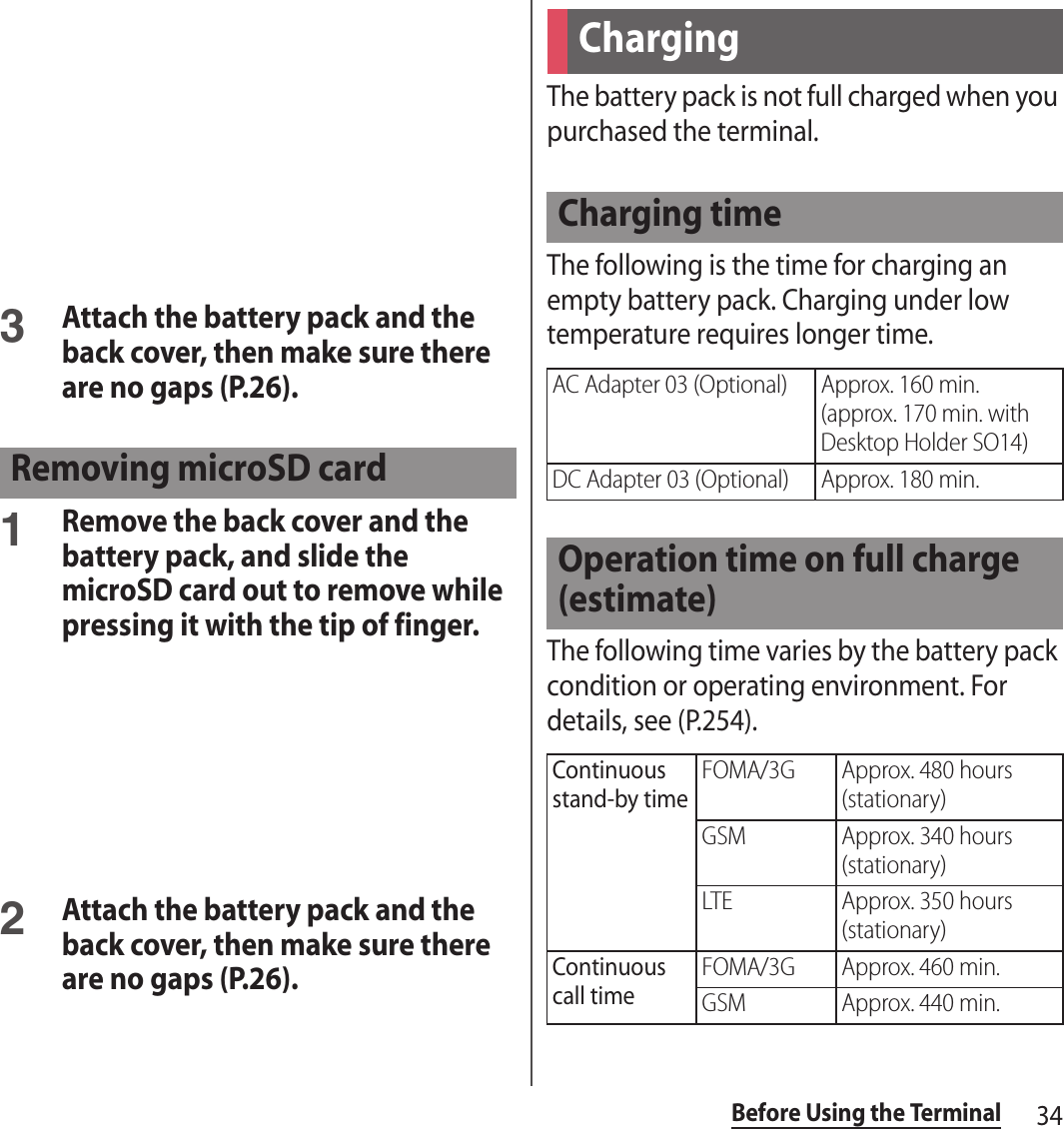
![35Before Using the Terminal・The battery pack is a consumable part. The usage duration of the battery per one charge decreases gradually each time the battery is recharged.・When the usage duration per one charge becomes about half of a new battery pack, the life of the battery pack is assumed to be almost over. It is recommended that you replace the battery pack ahead of time.・Always attach the SO-03E dedicated battery pack SO08 to charge.・The AC Adapter 03 (optional) is compatible with AC 100 V to 240 V. For using the terminal overseas, a plug adapter that fits the electrical outlets in the country you stay is needed. Do not use an electrical transformer for overseas use to charge the terminal.・It is recommended to use the AC Adapter 03 (optional) for charging.・Insert and remove the microUSB cable slowly and evenly so that excessive force is not applied.・When you start charging, notification LED on the terminal turns red/orange/green, and green light indicates that the battery level has reached 90 % or more. To check the status of charging, from the Home screen, tap and tap [Settings]u[About phone]u[Status] to see "Battery level". When charging is complete, battery level is displayed as "100%" at the status bar or "Battery level", and "Charged." appears on the unlock screen.・When you start charging the battery with the terminal powered off, the power turns on. However, you cannot operate the terminal. Do not charge the battery in a place where the use is prohibited such as in airplane or hospital.Do not charge the battery pack for a long time (several days)・If you remain charging the terminal for a long time, the power supply starts from the battery pack after completion of charging. The usage time duration may be short. In that case, please charge it again correctly. For recharging, remove the terminal from the AC adapter and reconnect it again.Battery pack lifeChargingLi-ion 00](https://usermanual.wiki/Sony/TM-0000.user-guide/User-Guide-1900871-Page-37.png)
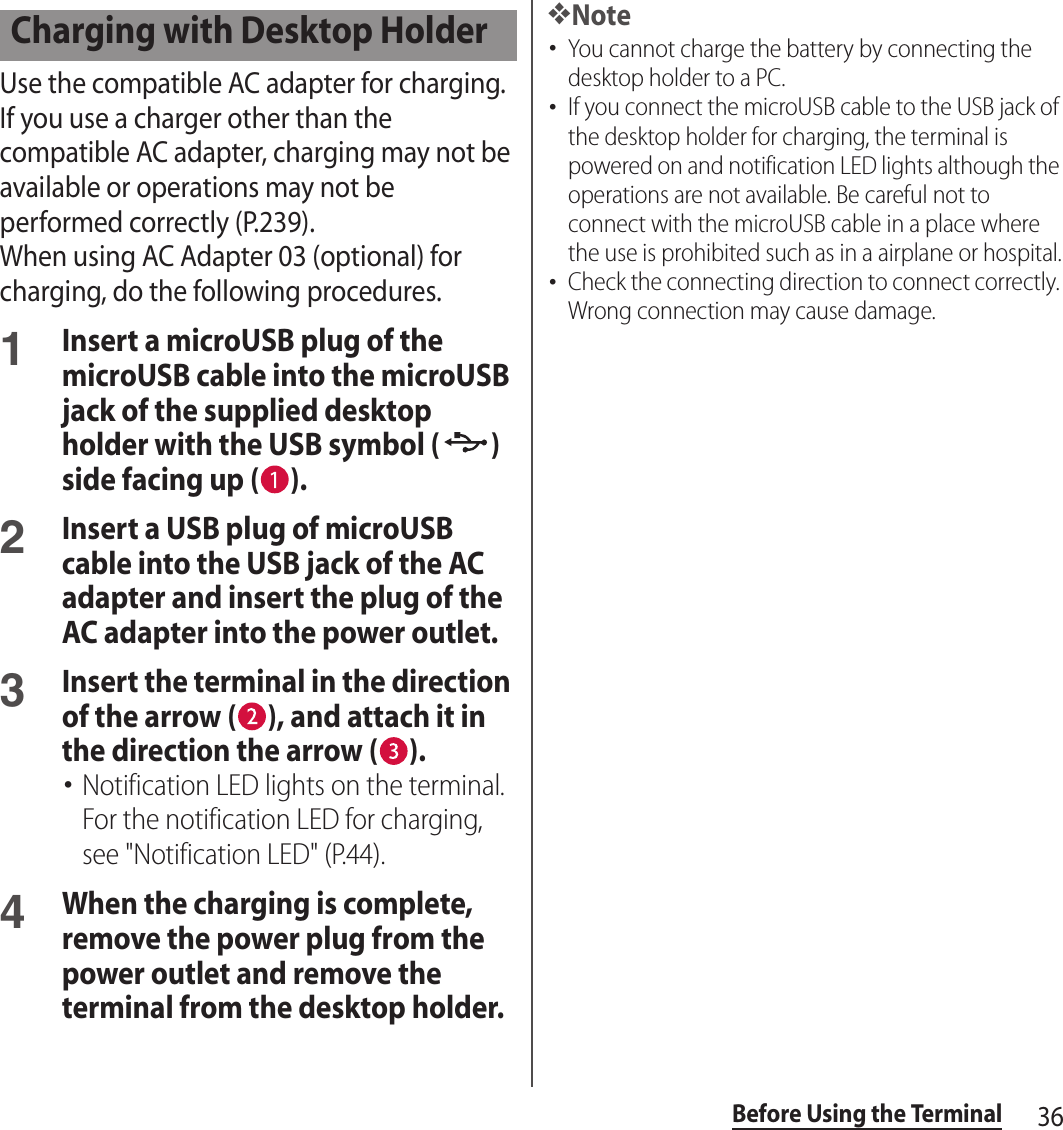
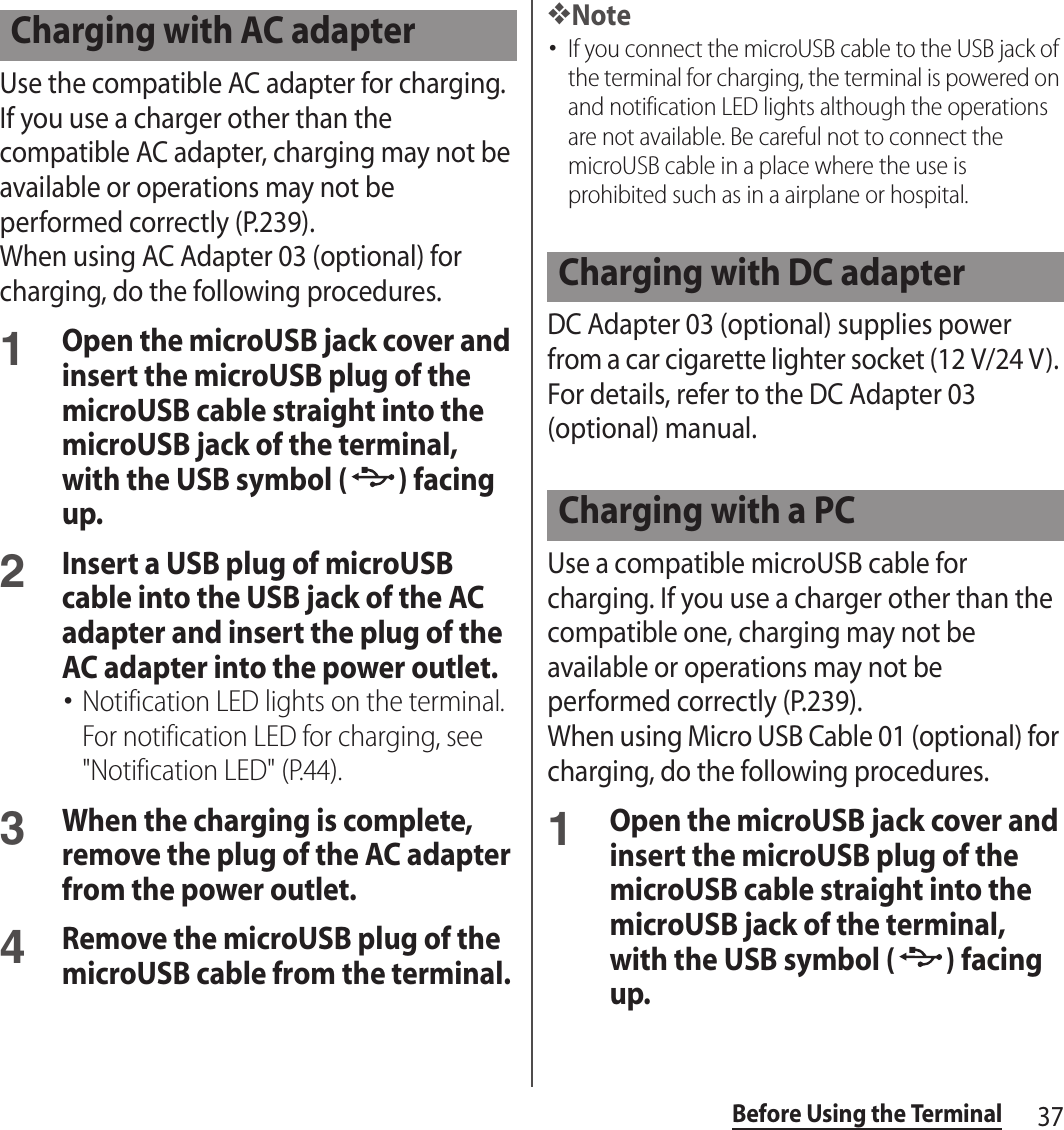
![38Before Using the Terminal2Insert the USB plug of the microUSB cable into a USB port of a PC.・Notification LED lights on the terminal. For the notification LED for charging, see "Notification LED" (P.44).・When "PC Companion software" screen appears on the terminal, tap [Skip].・When a screen for new hardware detection etc. appears on the PC, select "キャンセル (Cancel)".3When the charging is complete, remove the microUSB plug of the microUSB cable from the terminal.4Remove the USB plug of the microUSB cable from the USB port of the PC.❖Note・Installation of MTP driver to a PC is required to charge the battery with a Microsoft Windows XP PC, since "USB connection mode" is set to "Media transfer mode (MTP)" by default. Install Windows Media Player 10 or later to install MTP driver.・If you connect the microUSB cable to the USB jack of the terminal for charging, the terminal is powered on and notification LED lights although the operations are not available. Be careful not to connect with the microUSB cable in a place where the use is prohibited such as in a airplane or hospital.・Check the connecting direction to connect correctly. Wrong connection may cause damage.1Press and hold p for over a second.・The unlock screen appears.2Unlock the screen.・For unlocking the screen by default, see "Unlocking the screen" (P.40).❖Information・The first time you turn on, the initial setting screen appears (P.40).・If you have activated the screen lock (P.146) or SIM card lock (P.146), unlock screen/PIN code entry screen appears when turning power on. For unlocking the screen lock, see "Unlocking the screen lock" (P.147), and for PIN code entry, see "Entering the PIN code when powered on" (P.146).Turning power on/offTurning power on](https://usermanual.wiki/Sony/TM-0000.user-guide/User-Guide-1900871-Page-40.png)
![39Before Using the Terminal1Press and hold p for over a second.2Tap [Power off].3Tap [OK].When the screen lock is set, the screen backlight turns off. You can avoid the touch screen or key from false operations.・The screen is locked with turning the screen backlight off after the specified time duration.1Press p.❖Information・Screen lock is set by default. For changing the screen lock, see "Changing screen unlock method" (P.147).・For details on settings for turning the backlight off and the duration of time before the screen lock activation, see "Adjusting the idle time before the screen turns off" (P.132).Unlock screen appears when turning the power on or the backlight on by pressing p.1On the unlock screen, tap .❖Information・On the unlock screen, tap to activate the camera and tap to activate しゃべってコンシェル (Shabette concier).・The screen lock can be disabled. For details, see "Canceling screen lock" (P.148).The first time you turn on the terminal, follow the onscreen instructions for initial settings.1Tap [English (United States)]u[Done], and tap .・After this step, follow the onscreen instructions to set up below, and tap or [Finish].- Select internet connection- Connect to a Wi-Fi network- Set accounts and auto-sync- Select preferred applicationsTurning power offSetting screen lockUnlocking the screenInitial settings](https://usermanual.wiki/Sony/TM-0000.user-guide/User-Guide-1900871-Page-41.png)
![40Before Using the Terminal2Tap when initial setting screen for docomo service appears.・After this step, follow the onscreen instructions to set up below, and tap .- Select whether to install all apps now or later- Select whether to set Osaifu-Keitai settings- Set docomo apps password settings- Set whether to respond when receive a request of location search3Tap [OK].・Instruction guide for the Home screen appears. Tap [OK]/[Do not show this again] to display the Home screen.❖Information・To change the language later, from the Home screen, tap , then tap [Settings]u[Language & input]u[Language]. To set functions, from the Home screen, tap , then tap [Settings]u[Setup guide]/[docomo service].・Make sure that the data connection is available (LTE/3G/GPRS) or Wi-Fi network is connected before setting up online services. For checking the connection status, see "Status icon" (P.41).・You can use the terminal without creating your Google account, however the services such as Google Talk, Gmail, Google Play, etc. are not available.A status bar appears at the top of the screen. In the status bar, the terminal status and notification are displayed. Notification icons appear on the left side, and the terminal status icons appear on the right side of the status bar.The main status icons displayed on the screen are as follows.Status barStatus iconSignal strengthInternational roaming availableInternational roaming connectedNo signalHSDPA availableCommunicating in HSDPA3G (packet) availableCommunicating in 3G (packet)LTE availableCommunicating in LTEConnecting to Wi-FiCommunicating in Wi-FiConnecting to Wi-Fi using Auto IP functionStatus bar](https://usermanual.wiki/Sony/TM-0000.user-guide/User-Guide-1900871-Page-42.png)
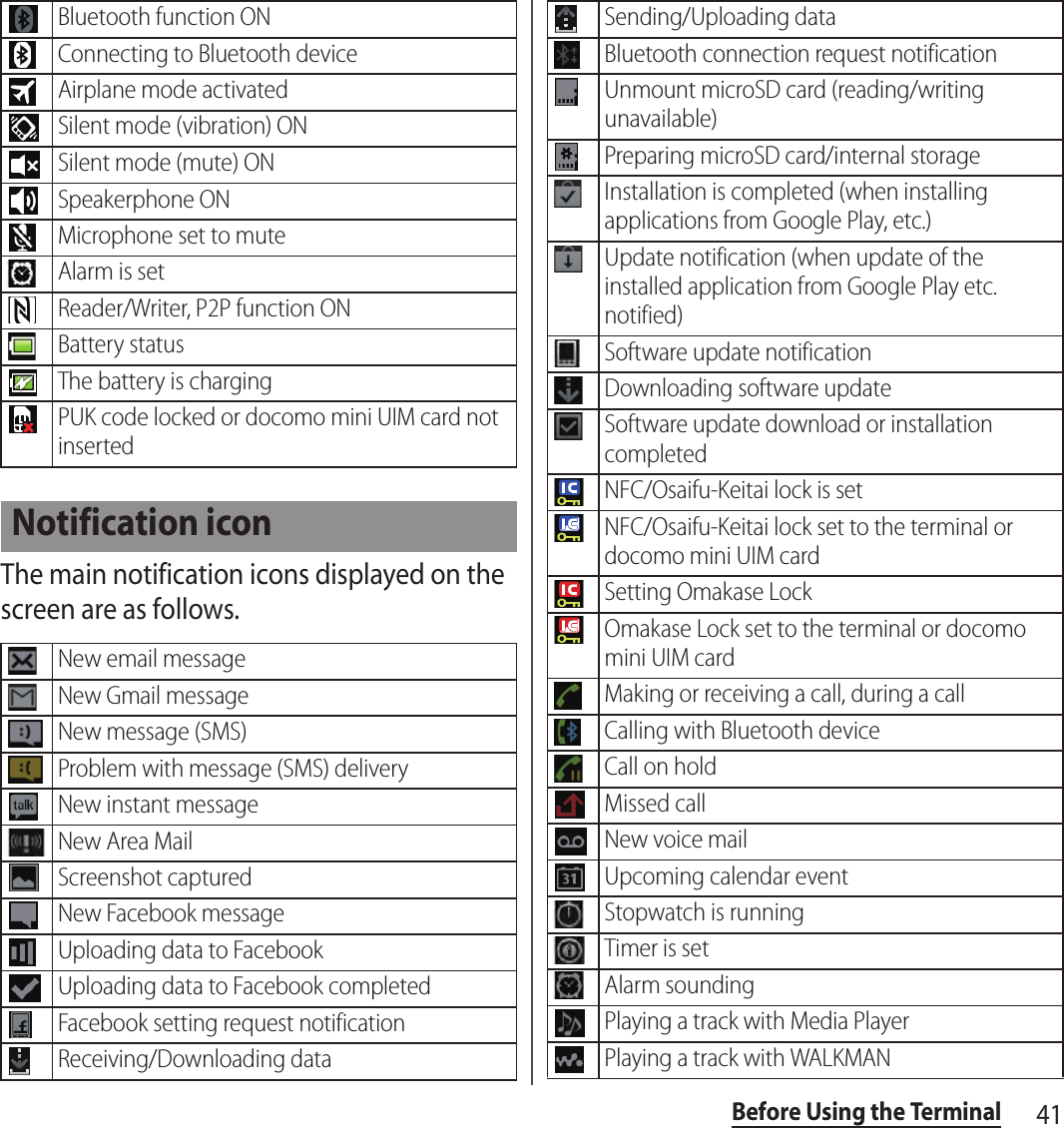
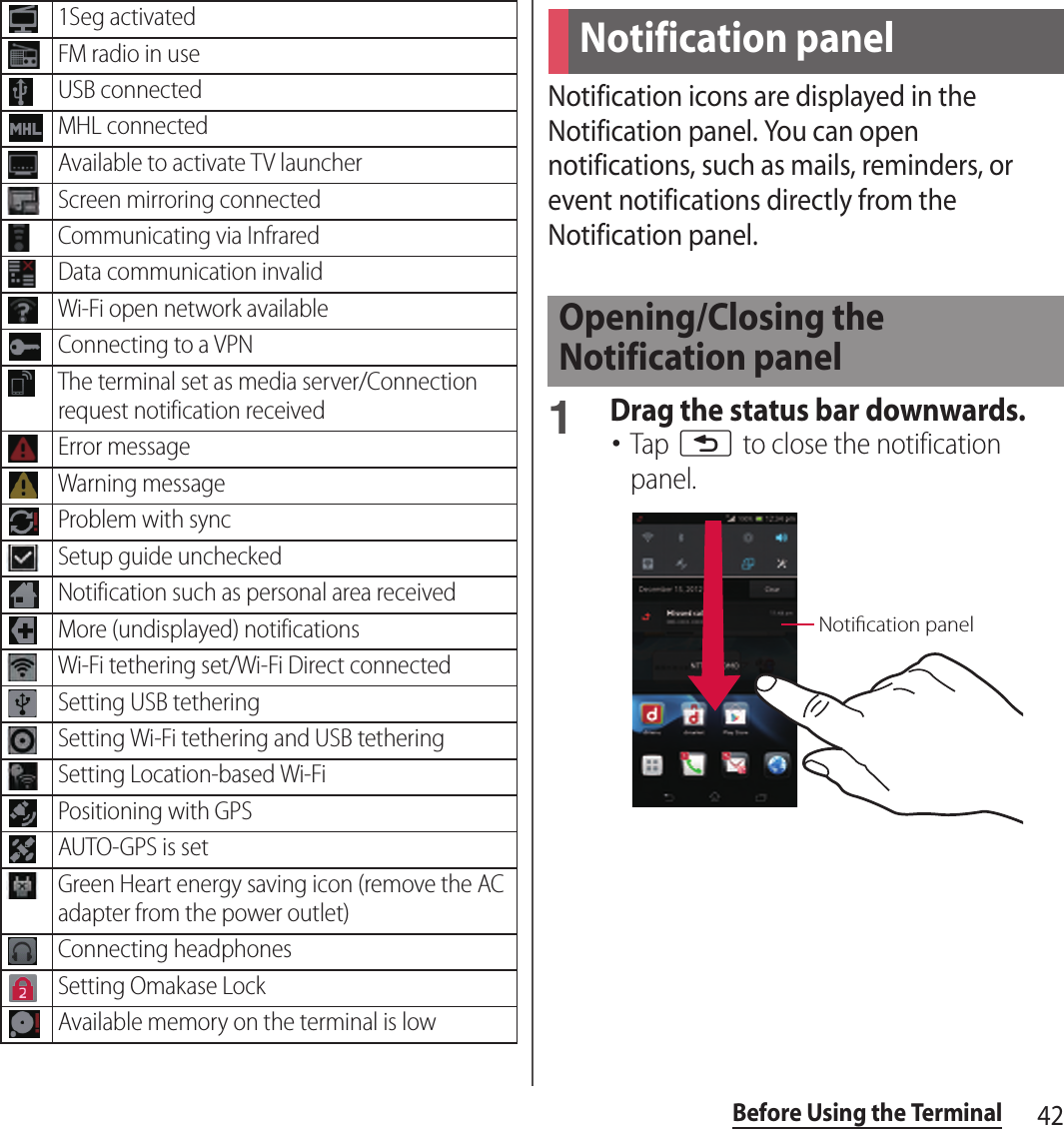
![43Before Using the Terminal❖Information・Drag the status bar downwards to enable/disable silent mode or data communications.1On the Notification panel, tap [Clear].❖Information・Flick left or right a notification on the notification panel to delete from the list.・Some notifications cannot be cleared.Notification LED provides information on the terminal status, incoming/receiving, etc.❖Information・If the battery level is not sufficient to activate when turning the power ON, press p to flash red./Enable/disable Wi-Fi function. / Enable/disable Bluetooth function. / Enable/disable data communication./Switch screen brightness. / / Enable/disable silent mode (Vibrate/Mute)./Enable/disable Wi-Fi tethering function./Enable/disable GPS function./Enable/disable Airplane mode./You can set whether to switch portrait/landscape view automatically according to the terminal orientation.Display Settings menu (P.118).Clearing contents on the Notification panelNotification LEDLED statusStatus IndicationRedThe battery is charging when the remaining battery level is 14% or less.Flashing redThe remaining battery level is 14% or less.GreenThe battery is charging when the remaining battery level is 90% or more.Flashing greenReceived Gmail mails while backlight is off exist.Flashing blueWhile backlight is off, missed calls/incoming messages (SMS) are notified.OrangeThe battery is charging when the remaining battery level is 15% - 89%.](https://usermanual.wiki/Sony/TM-0000.user-guide/User-Guide-1900871-Page-45.png)

![45Before Using the Terminal■ ScrollWhen whole content cannot be displayed, flick up/down/left/right displayed content to scroll (move) the display position.■ PinchTouch the screen with two fingers and widen (pinch-out) or narrow (pinch-in) the fingers' distance. On some screens, pinch-out to zoom in and pinch-in to zoom out.You can set the screen orientation to switch between landscape and portrait view automatically according to the terminal orientation.1Drag the status bar downwards.2Tap (gray).・The setting is enabled. Tap (blue) to disable.❖Information・Even when you change the orientation of the terminal, the screen may not change to landscape view depending on the screen such as Home screen, etc.・To switch the screen automatically between landscape and portrait view, from the Home screen, tap , then tap [Settings]u[Display] and mark [Auto-rotate screen], or from the Home screen, tap , then tap [Settings]u[Accessibility] and mark "Auto-rotate screen".Switching portrait/landscape view automatically](https://usermanual.wiki/Sony/TM-0000.user-guide/User-Guide-1900871-Page-47.png)
![46Before Using the TerminalYou can save the current displayed screen as an image (screen shot).You can check captured screen shots on the album (P.205).1On the screen you want to capture, press and hold p and lower of m for over a second at the same time.・Screenshot is captured and appears in the status bar.❖Information・You can also capture a screenshot by pressing and holding p for over a second and then tapping [Take screenshot].When a checkbox/radio button is displayed besides a setting item, mark or unmark a checkbox/radio button to switch on/off for the setting.Capturing screenshot Marking/Unmarking to switch setting/Switch on/off the setting for a checkbox./Switch on/off the setting for a radio button./Tap or drag left or right to switch on/off the setting.](https://usermanual.wiki/Sony/TM-0000.user-guide/User-Guide-1900871-Page-48.png)
![47Before Using the TerminalEnter a word in the search box to browse the information in the terminal or on the Internet.1From the Home screen, tap , then tap [Search].・The software keyboard appears.2Enter a search word.・Search suggestions appear as you enter a character. For character entry, see "Character entry" (P.49).・To enter a new search word, tap .・Tap at the right end of search item to enter a selected item and search again.3Tap a search item or .・When you select an application from the search result, the application is activated.❖Information・When you use for the first time, a confirmation screen appears asking whether to use My location info for the Google search result or service. Read the terms of use and tap [OK].・Tap on the software keyboard to input a search word by voice typing with "docomo voice input" or "Google voice typing".Using Google voice searchEnter a search word by voice.1From the Home screen, tap on the Google search widget.2Speak a search word to the microphone.3Tap a search item.❖Information・When you use for the first time, a confirmation screen appears asking if you allow Google to use My location info. Select "OK" or "Cancel".・When you change the language, the language setting screen for voice search appears. Tap [Settings] or [OK].Search settingsYou can set to use for search box or set search objectives in the terminal.1From the Home screen, tap , then tap [Search].2Tap , then tap [Settings].・Google search setting screen appears. You can set the following items.Searching information in the terminal and web pages](https://usermanual.wiki/Sony/TM-0000.user-guide/User-Guide-1900871-Page-49.png)
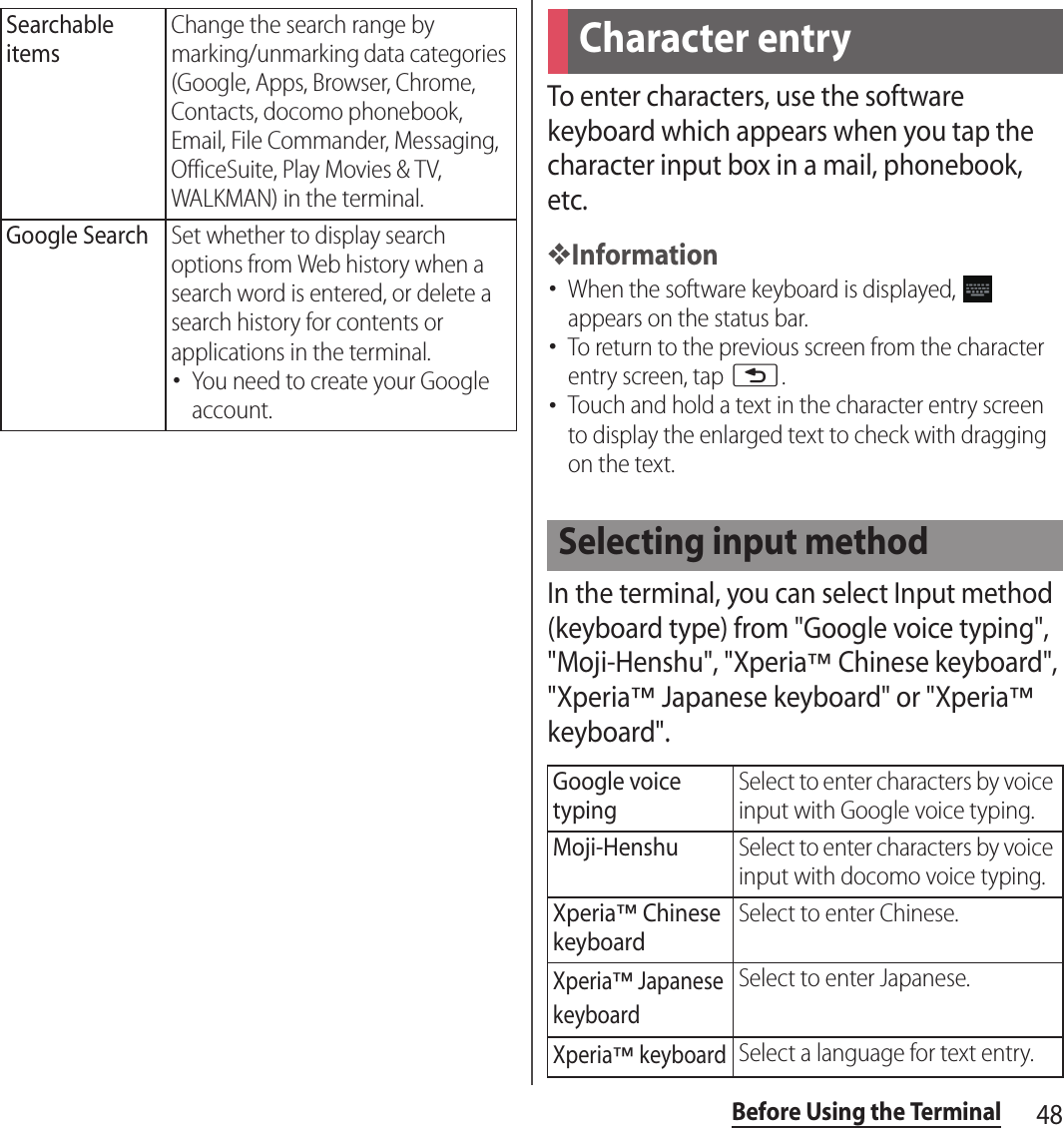
![49Before Using the Terminal1From the Home screen, tap , then tap [Settings].2Tap [Language & input]u[Default]u[Xperia™ Chinese keyboard]/[Xperia™ Japanese keyboard]/[Xperia™ keyboard].❖Information・While entering characters, drag the status bar downwards and tap [Select input method] to select from "Google voice typing"/"Moji-Henshu"/"Xperia™ Chinese keyboard"/"Xperia™ Japanese keyboard"/"Xperia™ keyboard".For Japanese keyboard, there are 4 types of software keyboards: phonepad, QWERTY, Japanese syllabary and Kana handwriting input.■ Phonepad keyboard■ QWERTY keyboardSoftware keyboardPortraitLandscapeLandscapePortrait](https://usermanual.wiki/Sony/TM-0000.user-guide/User-Guide-1900871-Page-51.png)
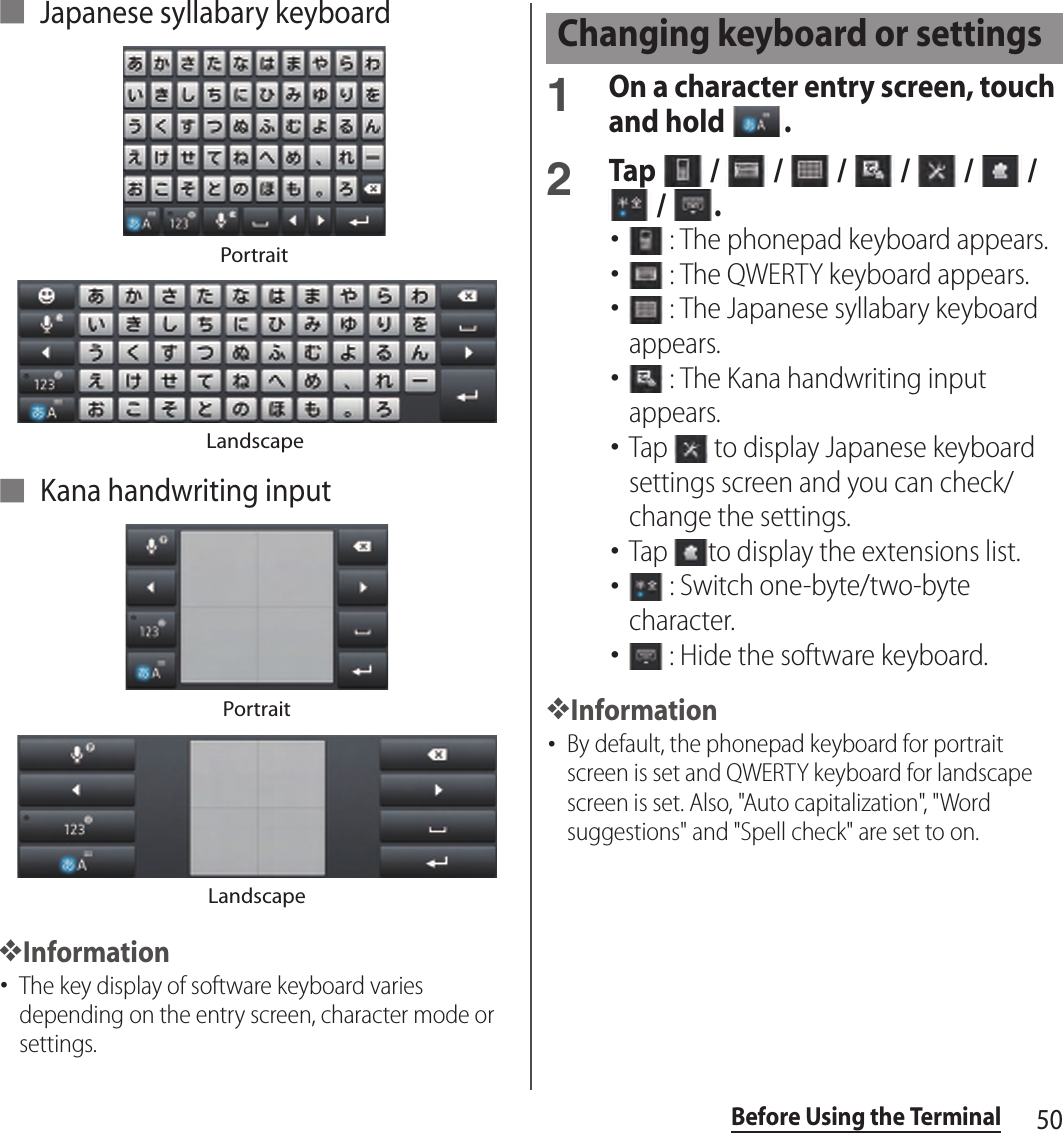
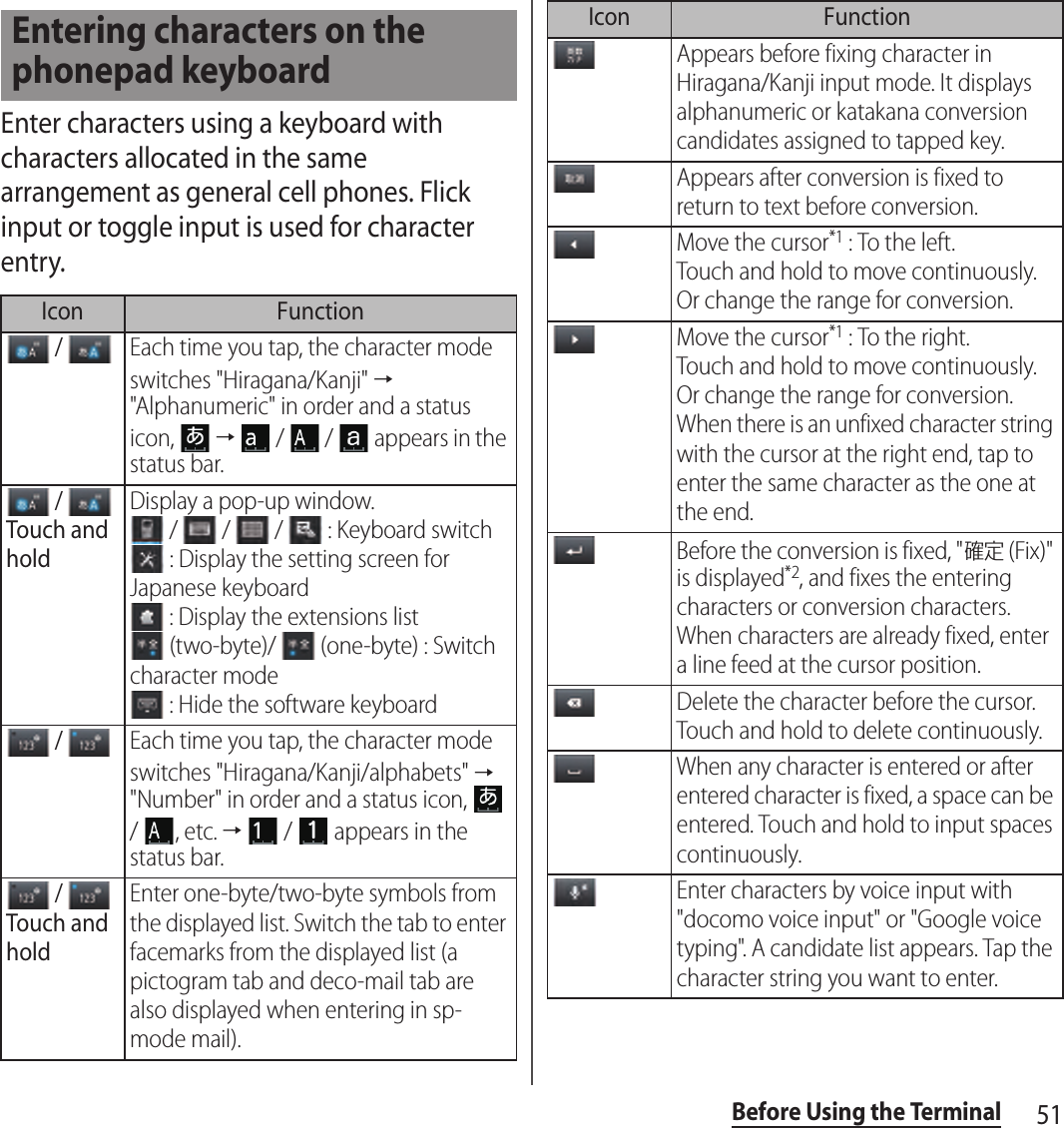
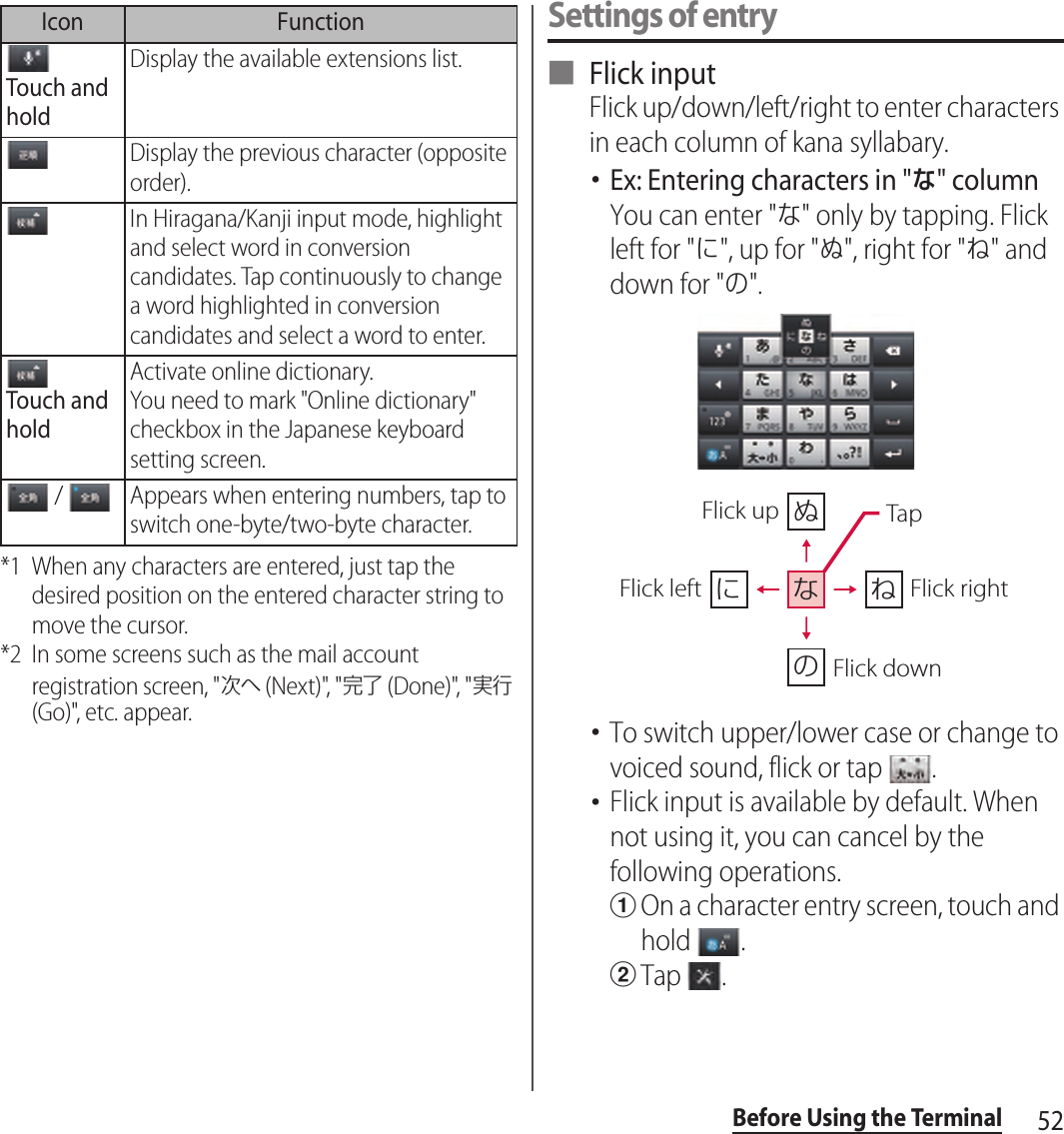
![53Before Using the Terminalc[On-screen keyboard settings]uUnmark "Flick input" checkbox.・To change sensitivity of the flick input, on a character entry screen, touch and hold , tap and [On-screen keyboard settings]u[Sensitivity of flick input], then select "High"/"Medium (default)"/"Low".■ Toggle entryTap the same key continuously to enter the assigned character.To enter characters assigned to the same key continuously, operate the followings.・Ex: To enter "あお"aTap "あ" once.bTap , and tap "あ" 5 times.・Ex: To enter "ca"aTap "abc" 3 times.bTap *.cTap "abc" once.* In some applications, tap in Step b.・To switch upper/lower case or change to voiced/semi-voiced sound, tap .・Multitap text input is available by default. When not using it, you can cancel by the following operations.aOn a character entry screen, touch and hold .bTap .c[On-screen keyboard settings]uUnmark "Multitap text input" checkbox.❖Information・In case of Multitap text input, when the tapped key's highlighter goes off and you can enter a character assigned to the same key consecutively without tapping .](https://usermanual.wiki/Sony/TM-0000.user-guide/User-Guide-1900871-Page-55.png)
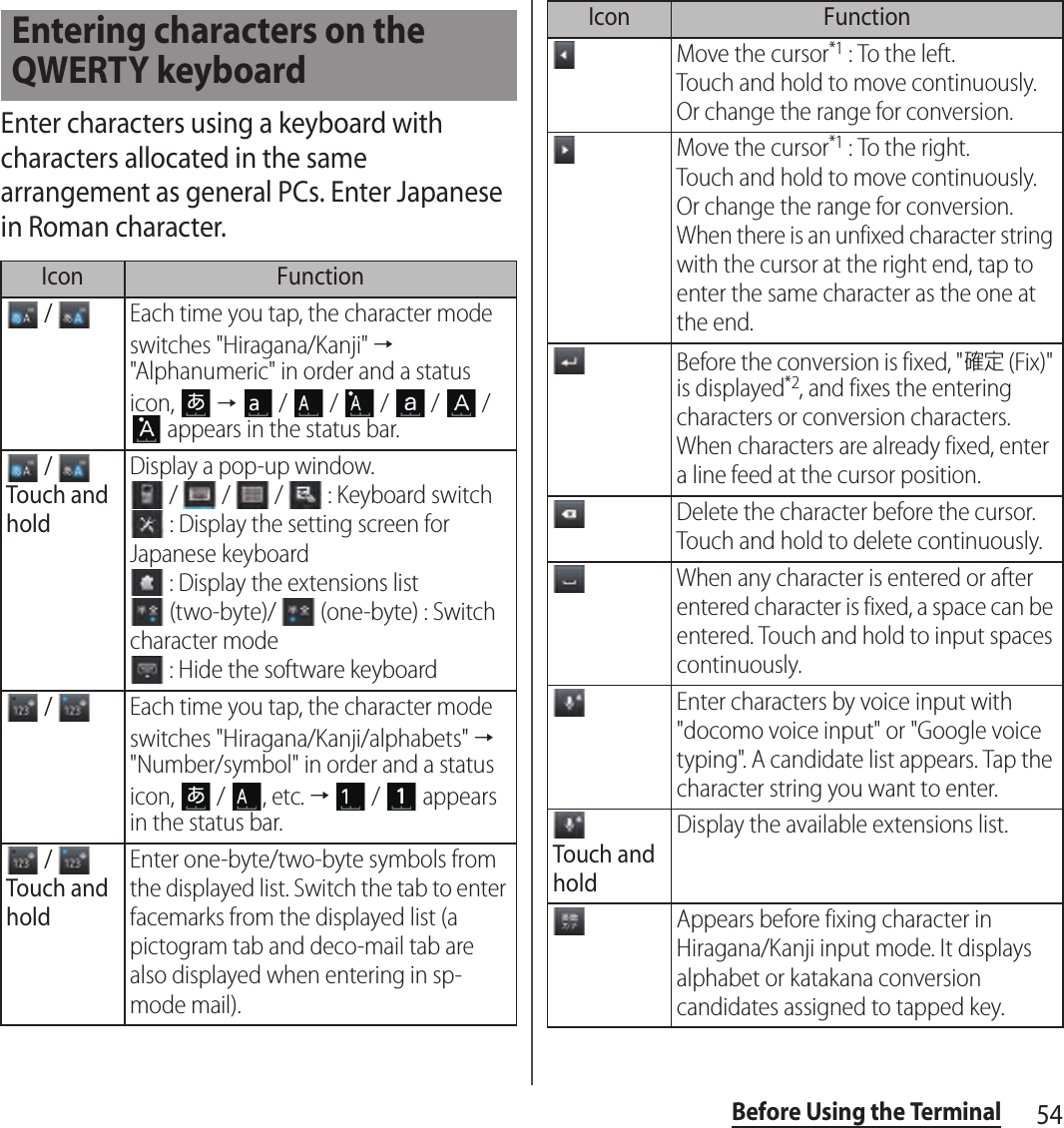
![55Before Using the Terminal*1 When any characters are entered, just tap the desired position on the entered character string to move the cursor.*2 In some screens such as the mail account registration screen, "次へ (Next)", "完了 (Done)", "実行 (Go)", etc. appear.Selecting an assistant keyboardWhen you enter in Hiragana/Kanji input mode using the QWERTY keyboard, you can change the assistant keyboard to make the frequent using keys to be displayed widely for easy tapping.1On a character entry screen, touch and hold .2Tap .3Tap [On-screen keyboard settings]u[Choose key type].4Tap any of [Static key resizing]/[Key highlight while typing]/[Dynamic key resizing with highlight]/[Off].■ Static key resizingWiden frequent using key for easy tapping. / / In alphanumerics input mode, tap to switch capitalization/upper case/lower case.In Hiragana/Kanji input mode, highlight and select word in conversion candidates. Tap continuously to change a word highlighted in conversion candidates and select a word to enter.Touch and holdActivate online dictionary.You need to mark "Online dictionary" checkbox in the Japanese keyboard setting screen. / Appears in number input mode. Tap to switch numbers or symbols to one-byte/two-byte characters.Icon Function](https://usermanual.wiki/Sony/TM-0000.user-guide/User-Guide-1900871-Page-57.png)
![56Before Using the Terminal■ Key highlight while typingWiden frequent using key and highlight the key that is predicted for the next entry.■ Dynamic key resizing with highlightWiden the key that is predicted for the next entry much further and highlight it.■ OffDisplay equally the width of each key.Changing display keysYou can set not to display less-frequent-used keys (Q, X, C, etc.) on the QWERTY keyboard.1On a character entry screen, touch and hold .2Tap .3Tap [On-screen keyboard settings]u[Hide keys].・When the Choose key type (P.56) is set to "Off", "Hide keys" cannot be selected.4Unmark the checkbox of the key you want to hide.5Tap [OK].](https://usermanual.wiki/Sony/TM-0000.user-guide/User-Guide-1900871-Page-58.png)
![57Before Using the TerminalCustomizing keyboardYou can change symbols which are displayed in QWERTY keyboard when entering number to desired characters/symbols.1On a character entry screen, touch and hold .2Tap .3Tap [On-screen keyboard settings]u[Keyboard customization].4Tap a symbol you want to change and delete character previously set, then enter a character to display and tap [OK].・Only one character (two-byte or one-byte character) can be entered.5Tap [OK].❖Information・To return to the default status, in Step 3, tap , then tap [Reset]u[OK].You can use the software keys arranged according to the Japanese syllabary.Entering characters on the Japanese syllabary keyboardIcon Function / Each time you tap, the character mode switches "Hiragana/Kanji" → "Alphanumeric" in order and a status icon, → / / / / / appears in the status bar. / Touch and holdDisplay a pop-up window. / / / : Keyboard switch : Display the setting screen for Japanese keyboard : Display the extensions list (two-byte)/ (one-byte) : Switch character mode : Hide the software keyboardAppears in Hiragana/Kanji input mode. Switch upper/lower case or add voiced sound/semi-voiced sound. / Each time you tap, the character mode switches "Hiragana/Kanji/alphabets" → "Number" in order and a status icon, / , etc. → / appears in the status bar.](https://usermanual.wiki/Sony/TM-0000.user-guide/User-Guide-1900871-Page-59.png)
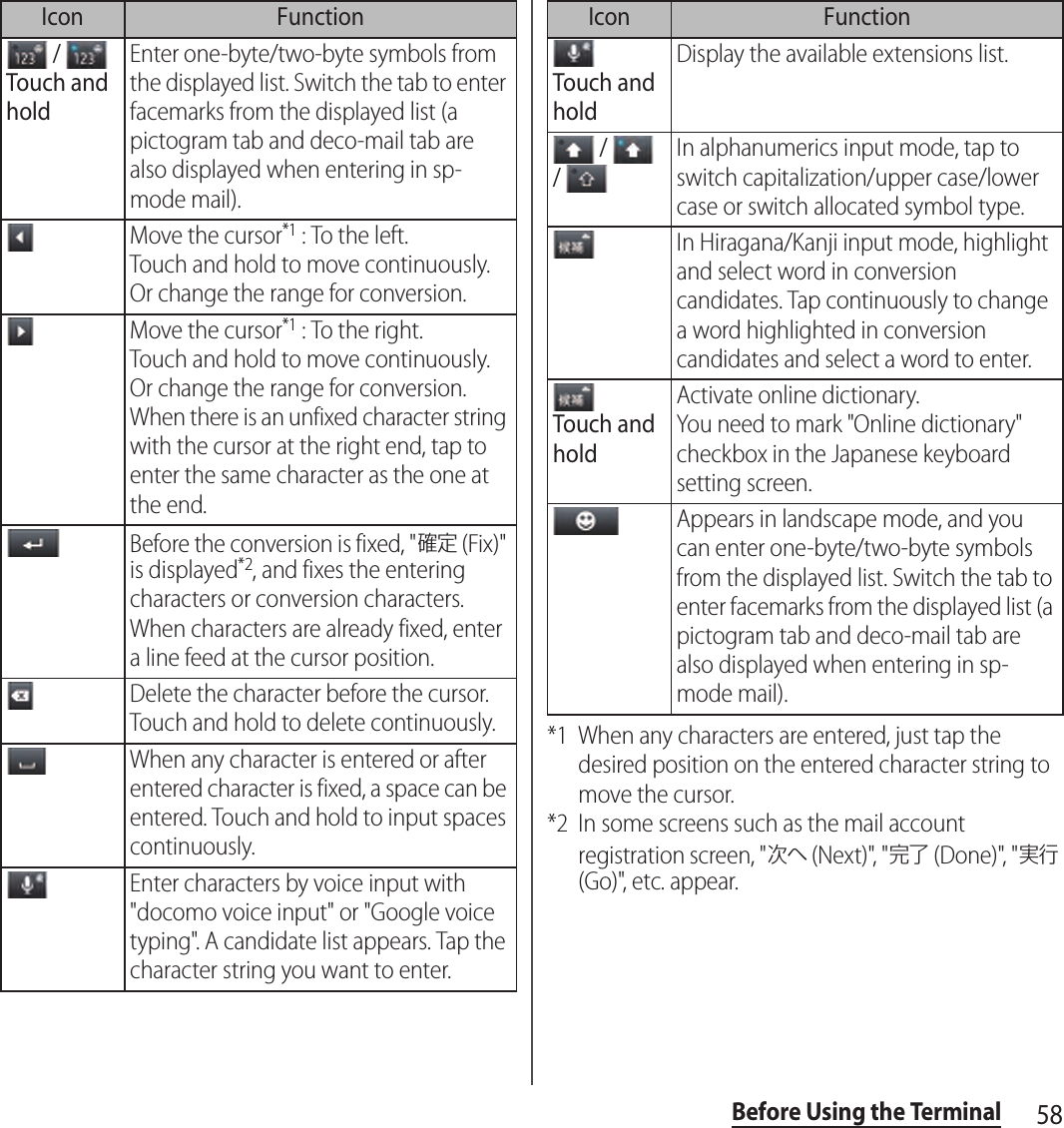
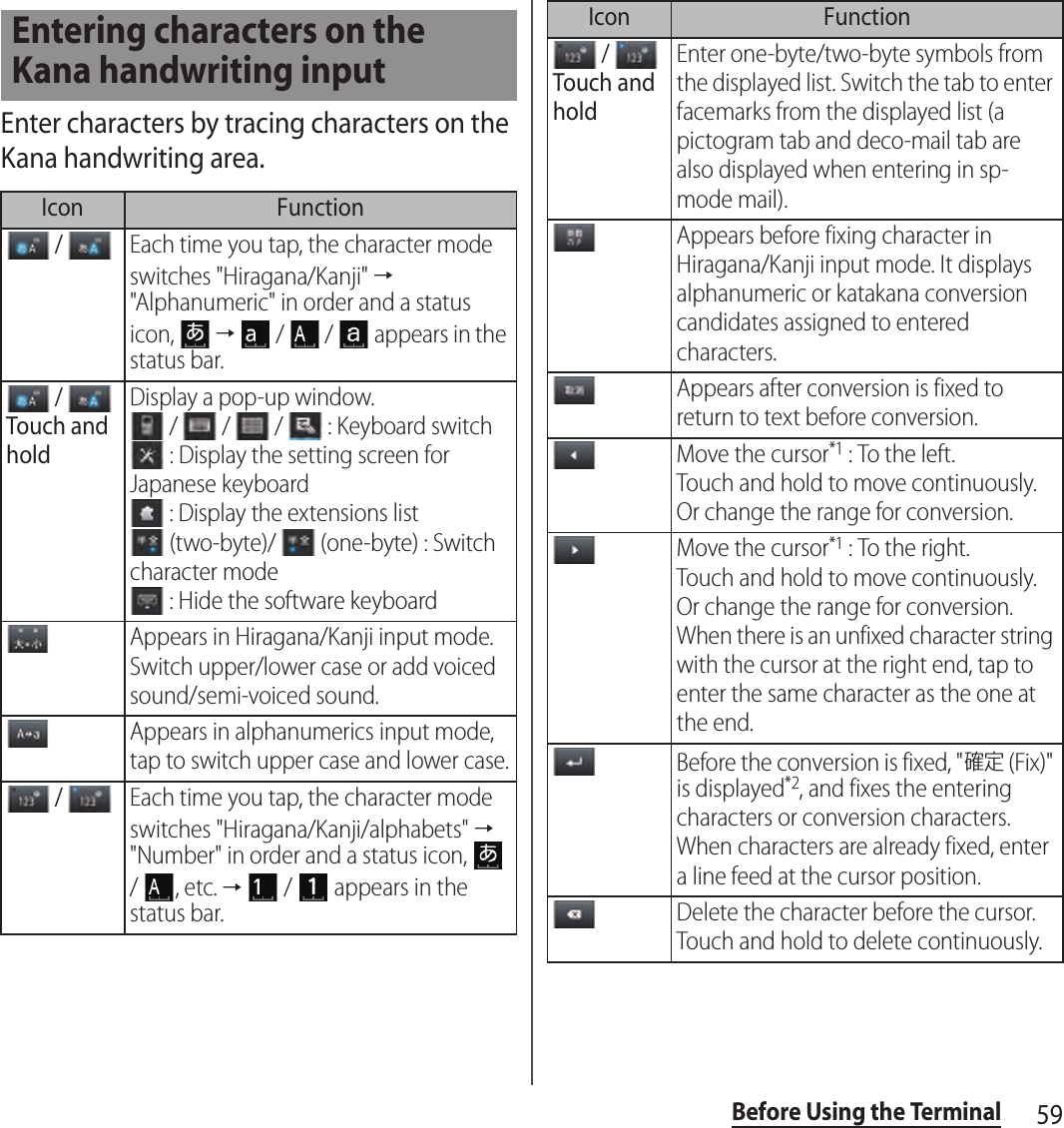
![60Before Using the Terminal*1 When any characters are entered, just tap the desired position on the entered character string to move the cursor.*2 In some screens such as the mail account registration screen, "次へ (Next)", "完了 (Done)", "実行 (Go)", etc. appear.❖Information・When you enter character by Kana handwriting for the first time, read a guidance and tap [OK].・In Kana handwriting input, hiragana, alphabet, number, some symbols can be entered.・You can enter a character continuously without deleting entered character.・For voiced sound and semi voiced sound mark, enter in the right upper part of the Kana handwriting input screen.・For punctuation mark and lower case, enter in the lower part from the center of the Kana handwriting input.・For entering alphabet, enter it with reference to lower horizontal line of the Kana handwriting input screen.In the character entry screen such as mail, phonebook, etc., double-tap text you want to edit so that text edit menu appears at the top of the screen. Drag or to change the character string to select.When any character is entered or after entered character is fixed, a space can be entered. Touch and hold to input spaces continuously.Enter characters by voice input with "docomo voice input" or "Google voice typing". A candidate list appears. Tap the character string you want to enter.Touch and holdKana handwriting input guide in the POBox Touch User Guide (Japanese) activates and you can view the detailed explanations on the Kana handwriting input.In Hiragana/Kanji input mode, highlight and select word in conversion candidates. Tap continuously to change a word highlighted in conversion candidates and select a word to enter.Touch and holdActivate online dictionary.You need to mark "Online dictionary" checkbox in the Japanese keyboard setting screen.Appears when entering number. Enter one-byte/two-byte symbols from the displayed list. Switch the tab to enter facemarks from the displayed list (a pictogram tab and deco-mail tab are also displayed when entering in sp-mode mail).Icon FunctionEditing text (Select all)Select all entered text. (Cut)Cut a selected character string. (Copy)Copy a selected character string. (Paste)Paste a copied/cut character string. (Complete)Close the edit menu.](https://usermanual.wiki/Sony/TM-0000.user-guide/User-Guide-1900871-Page-62.png)
![61Before Using the Terminal❖Information・To paste a copied or cut character string, touch and hold a position where you want to insert, then tap [PASTE]. Alternatively, when texts are entered, tap a position where you want to insert, then tap and [PASTE].・Edit menu icons vary by applications.For each input method, you can make settings related to character entry.1From the Home screen, tap , then tap [Settings]u[Language & input].2Tap on "Google voice typing"/"Moji-Henshu"/"Xperia™ Chinese keyboard"/"Xperia™ Japanese keyboard"/"Xperia™ keyboard".・Settings screen for respective input method appears. Tap an item displayed on the screen to set.❖Information・The items vary depending on the input method.1From the Home screen, tap , then tap [Settings]u[Language & input].2Tap on "Xperia™ Japanese keyboard".・The setting screen for Xperia™ Japanese keyboard appears.❖Information・Alternatively, on a character entry screen, touch and hold and tap to display the setting screen for Xperia™ Japanese keyboard.Common settings of software keyboardMake keyboard settings such as Key sound, Vibrate, etc.1On the setting screen for Xperia™ Japanese keyboard, tap [On-screen keyboard settings].・Set items for "COMMON ON-SCREEN KEYBOARD SETTINGS".Setting character entrySetting Xperia™ Japanese keyboardDisplaying the setting screen for Xperia™ Japanese keyboard](https://usermanual.wiki/Sony/TM-0000.user-guide/User-Guide-1900871-Page-63.png)
![62Before Using the Terminal❖Information・By default, conversion candidates are displayed in 2 lines in portrait/landscape screen.Auto capitalizationSet to capitalize automatically the top letter you enter in one-byte alphabet entry mode.1On the setting screen for Xperia™ Japanese keyboard, mark "Auto capitalization".❖Information・The top letter may not always be capitalized automatically in one-byte alphabet entry mode when "Auto capitalization" is marked.Setting voice inputSet voice input to "docomo voice input" or "Google voice typing".1On the setting screen for Xperia™ Japanese keyboard, tap [Voice typing].2Tap [docomo voice input]/[Google voice typing].❖Information・"docomo voice input" is set by default. Tap on the software keyboard to change to "Google voice typing".Keeping keyboard typeSet to stabilize the last status of keyboard (phonepad/QWERTY/Japanese syllabary keyboard/Kana handwriting input) in the each portrait/landscape screen in kana/alphabet/number input mode.1On the setting screen for Xperia™ Japanese keyboard, tap [On-screen keyboard settings].2Mark [Keep keyboard type] checkbox.❖Information・You can set to stabilize the last status of keyboard in the each portrait/landscape screen without marking "Keep keyboard type".Sound on keypressSet whether to sound at the time of key tapping.Vibration on keypressSet whether to vibrate at the time of key tapping.Pop-up on keypressSet to pop up the key you have tapped at the time of key tapping.No. of lines (portrait)Set number of lines for conversion candidates displayed in portrait mode.No. of lines (landscape)Set number of lines for conversion candidates displayed in landscape mode.](https://usermanual.wiki/Sony/TM-0000.user-guide/User-Guide-1900871-Page-64.png)
![63Before Using the TerminalSetting keyboard skinYou can change software keyboard skin.1On the setting screen for Xperia™ Japanese keyboard, tap [Keyboard skin].2Select from displayed keyboards and tap [Set skin].❖Information・To download and add keyboard skins from a website, tap [Search for skin] in Step 2. Some keyboard skins downloaded from website may not support the terminal.・To delete the downloaded keyboard skin, from the Home screen, tap , and tap [Settings]u[Apps]u"Downloaded" tab, and tap the keyboard skin you want to delete, and then tap [Uninstall]u[OK]u[OK]. Also, tap [Uninstall] in Step 2 so that you can delete the keyboard skin that is not compatible with the terminal.The Word suggestion function shows predicted conversion candidates when you enter Japanese/English characters. Mark the checkbox of Word suggestion checkbox to set "Spell check" and "Auto space". That helps you entering characters with ease.Setting Word suggestion1On the setting screen for Xperia™ Japanese keyboard, mark "Word suggestions".❖Information・Flick or drag downward in the word suggestion field to enlarge suggestion field in which you can see more word suggestions and to hide the keyboard. Tap [前候補 (previous suggestion)]/[次候補 (next suggestion)]/[確定 (fix)] shown at the bottom of the word suggestions screen to select/fix characters to be entered. To show the software keyboard, tap [戻る (Back)] or x.Setting Spell checkSpell check corrects mistyped characters and shows conversion candidates before conversion in one-byte alphabet input mode when entering characters with QWERTY keyboard or Japanese syllabary keyboard.1On the setting screen for Xperia™ Japanese keyboard, mark "Spell check".Word suggestion settings](https://usermanual.wiki/Sony/TM-0000.user-guide/User-Guide-1900871-Page-65.png)
![64Before Using the TerminalSetting Auto spaceWhen selecting English word suggestion, Auto space enters next to the entered character. However, space is not entered automatically in the mail address or URL input fields.1On the setting screen for Xperia™ Japanese keyboard, mark "Auto space".To display the word as the preferred candidate when entering characters, set the user dictionary beforehand.Registering words in user dictionariesThere are 2 types of user dictionaries: "My words Japanese" and "My words English".1On the setting screen for Xperia™ Japanese keyboard, tap [My words Japanese]/[My words English].2Tap and [Add].3Tap the character input box for "Reading" and fill it out.4Enter a word in the input box for "Word" and tap [完了 (Done)].5Tap [Save].❖Information・Up to 50 characters (regardless of one-byte or two-byte characters) can be stored for a "Reading" and "Word", and up to 500 items can be stored in the user dictionary.・When entering characters, tapping [直変 (Direct conversion)] in the word suggestion field may give priority to some registered words.・Added user dictionary can be edited or deleted. To edit, select an added user dictionary and tap , then tap [Edit] for editing and tap [Save]. To delete, select an added user dictionary and tap , then tap [Delete]u[Delete]. To delete all user dictionary, tap , then tap [Delete all]u[Delete].Setting Words by learning1On the setting screen for Xperia™ Japanese keyboard, tap [Learn words].2Mark "Save words while typing".・To reset already learned words, tap [Delete saved words]u[Delete].❖Information・To delete history for learned words individually, touch and hold a word you want to delete and tap [Delete].User dictionary settings](https://usermanual.wiki/Sony/TM-0000.user-guide/User-Guide-1900871-Page-66.png)
![65Before Using the TerminalSetting online dictionaryIn Hiragana/Kanji input mode, touch and hold to activate online dictionary.1On the setting screen for Xperia™ Japanese keyboard, tap [Online dictionary].2Tap [Online dictionary], then read the note and tap [Agree].・"Online dictionary" is marked.Backing up and restoring dictionaryUser dictionary and Words by learning can be backed up onto an internal storage and restored when needed.1On the setting screen for Xperia™ Japanese keyboard, tap [Backup & restore].2Tap [Backup]/[Restore].3Mark a dictionary to back up/restore.・Select "My words Japanese"/"My words English"/"Learn words".4Tap [Go].・When backing up, a screen asking whether to overwrite the user dictionary on the internal storage appears. When restoring, a screen asking whether to overwrite the user dictionary in the terminal appears.5Tap [OK]u[OK].・The data is backed up or restored.❖Information・If restoring data is failed, user dictionary in the terminal restores to the default. Restore by operating again.・User dictionary and Words by learning are not backed up onto microSD card.](https://usermanual.wiki/Sony/TM-0000.user-guide/User-Guide-1900871-Page-67.png)
![66Before Using the TerminalYou can use or add extensions when entering characters.Using Contact Picker 2.3If contacts are registered to the Contacts, you can use "Contact Picker 2.3" to enter contact information when entering characters.1On a character entry screen, touch and hold .2Tap .3Tap [Contact Picker 2.3]u"Contacts" tab.4Tap the contact to pick up.・When you enter a name or reading in the search box at the top of the screen, a list of contacts appears accordingly.5Mark items you want to enter and tap [OK].・If you want to select/deselect all items, tap [Mark all]/[Unmark all].❖Information・"History" tab displays contacts that are picked up when entering characters.Adding an extensionYou can install extensions to use when entering characters.1On the setting screen for Xperia™ Japanese keyboard, tap [Manage extensions].2On the how to start extensions screen, tap [OK].・Extensions settings screen appears.3Tap [Download new extensions].・Extensions list screen appears.4Tap an application and follow the onscreen instructions.❖Information・Marked extensions in the extensions settings screen can be activated in the character entry screen. The preinstalled extension "Contact Picker 2.3" is marked by default.Using extensions](https://usermanual.wiki/Sony/TM-0000.user-guide/User-Guide-1900871-Page-68.png)
![67Before Using the TerminalYou can view the detailed explanations on the high performance Xperia™ Japanese keyboard from the basic to application. The latest information can be obtained from the websites for extensions or keyboard skins.1On the setting screen for Xperia™ Japanese keyboard, tap [POBox Touch User Guide].・POBox Touch User Guide appears.❖Information・Alternatively, touch and hold in the Kana handwriting input screen to activate the Kana handwriting input guide in the POBox Touch User Guide (Japanese) to view the detailed explanations on the handwritten input.Connect USB keyboard or Bluetooth keyboard that supports HID (Human Interface Device) profile with the terminal to enter characters.❖Information・Some Bluetooth keyboards compatible with HID profiles cannot be used or may not operate properly.・Use USB keyboard or Bluetooth keyboard with key order that is compatible with 106 keyboard/109 keyboard.・Tap the character input box to display or on the status bar of the terminal, then enter characters with USB keyboard or Bluetooth keyboard.・Press "半角/全角 (one-byte/two-byte)" key on USB keyboard or Bluetooth keyboard to switch Kana input/Alphabet input on the terminal.・While displaying word suggestions, press "Tab" key/"↓" key on the USB keyboard or the Bluetooth keyboard to select a word in word suggestions.・While not selecting a word in word suggestions, press "Space" key on the USB keyboard or the Bluetooth keyboard to switch to direct conversion.・You can edit texts with connected USB keyboard or the Bluetooth keyboard. For instructions on editing texts on the terminal, see "Editing text" (P.61).- Press "Ctrl" key and "A" key to select all entered text.- Press "Shift" key and "←" key or "Shift" key and "→" key to partly select entered text from cursor.- Press "Ctrl" key and "X" key to cut a selected character string.POBox Touch User GuideUSB keyboard/Bluetooth keyboard](https://usermanual.wiki/Sony/TM-0000.user-guide/User-Guide-1900871-Page-69.png)
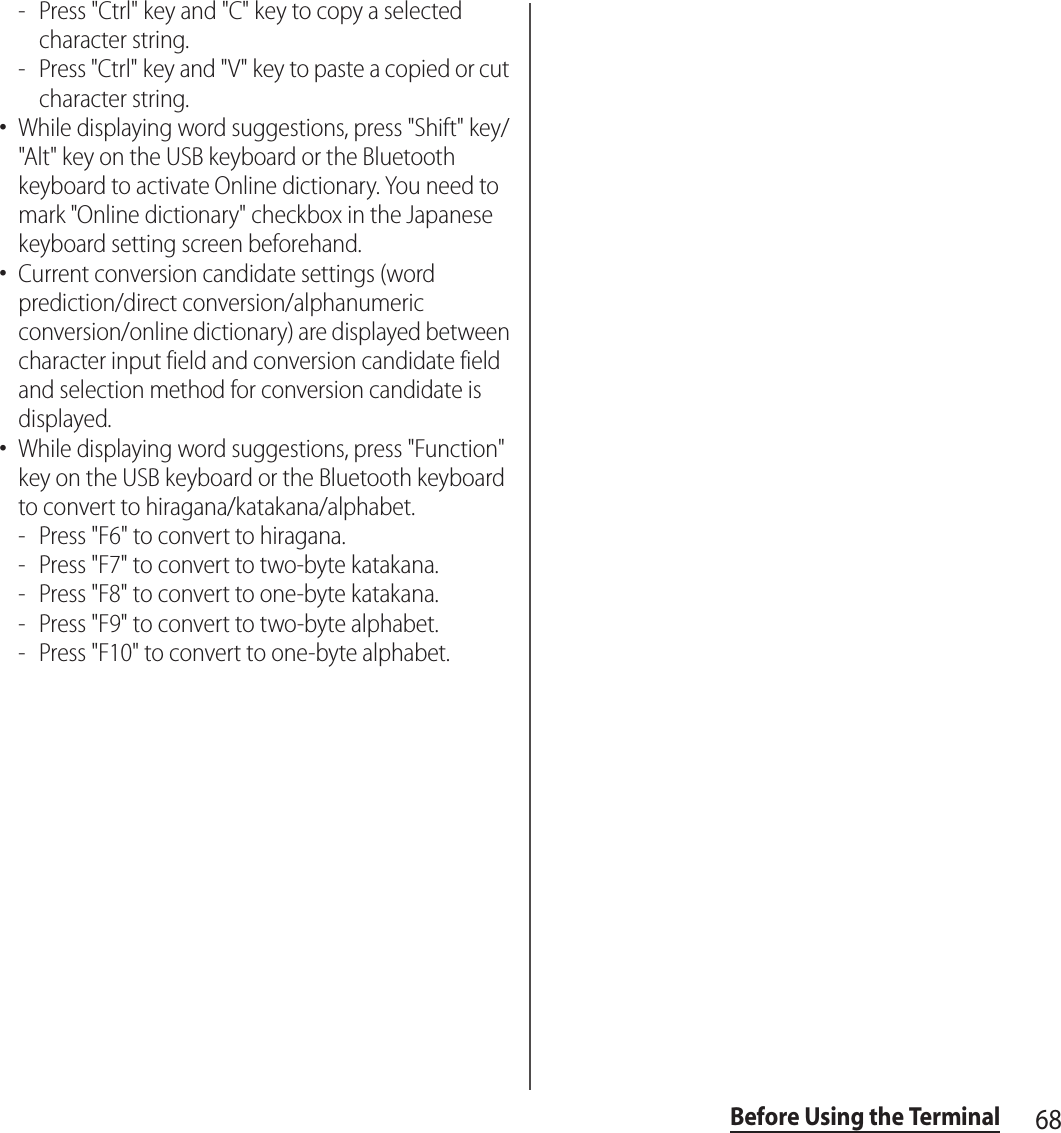
![69docomo Palette UIdocomo Palette UIHome screen is a start screen for using applications. You can personalize the Home screen by adding or moving, for example, application shortcuts and widgets, or changing the wallpaper.Tapping y displays Home screen which consists of up to 12 screens you can use flicking left and right.aCurrent home screen positionbWidget : Google SearchcWidget : i-channeldWidget : Machi-charaeShortcuts (applications)fApplications buttongWallpaper❖Information・You can switch the home application between "docomo" and "Xperia™" in the terminal."docomo" is set to the home application by default. To switch the home application, from the Home screen, tap and [Settings]u[Setup guide], and on the Preferred applications screen, [Change now]u[Home screen], or from the Home screen, tap and [Settings]u[Xperia™]u[Preferred apps settings]u[Home screen]. To switch applications (Home, screen lock, phonebook (contacts), video or music player) to be used in the terminal all at once, from the Home screen, tap [Preferred apps settings]u[OK], or from the Home screen, tap , [Settings]u[Xperia™]u[Preferred apps settings]u[Set all to].・When the home application is switched, widgets or shortcuts on the screen may not be displayed correctly depending on home screen layout etc.・When the instruction guide for the Home screen appears, tap [OK]/[Do not show this again] to display the Home screen.Switching the Home screen1Flick the Home screen to left or right.・The Home screen switches.❖Information・You can check the current position of the Home screen with at the top of the screen.・Alternatively, display a list of home screens and then tap a home screen to switch. For details on the home screen list, see "Displaying a list of home screens" (P.71).Home screenLearning Home screenabcefegd"ひつじのしつじくん®(Butler Sheep)"©NTT DOCOMO](https://usermanual.wiki/Sony/TM-0000.user-guide/User-Guide-1900871-Page-71.png)
![70docomo Palette UIDisplaying a list of home screens1From the Home screen, pinch-in.・A home screen list appears.❖Information・Touch an hold an area of the Home screen where no icons are displayed and tap [Home screens] to display list of home screens.・When the instruction guide for the home screen list appears, tap [OK]/[Do not show this again].・To return to the home screen, pinch-out, or tap y or x.1Touch and hold an area of the Home screen where no icons are displayed.・"Select an action" menu appears to change the Home screen.■ Select an actionAdding a shortcut to the Home screen1On "Select an action" menu screen (P.71), tap [Shortcut].2Select a shortcut you want to add.・The shortcut appears on the Home screen.❖Information・Alternatively, you can add from the Home screen, and touch and hold an icon you want to add, tap [Add].Adding to the Home screenShortcutAdd shortcuts of applications or setting screens (P.71).WidgetAdd widgets (P.72).FolderCreate a new folder (P.73).KisekaeChange the background of the Home screen or Application screen, or download from website to add (P.73).WallpaperChange the wallpaper or download from website to add (P.73).GroupAdd group shortcut of Application screen (P.74).Home screensShow home screens (P.71).Wallpaper loop settingsSet whether to loop wallpaper on the Home screen.](https://usermanual.wiki/Sony/TM-0000.user-guide/User-Guide-1900871-Page-72.png)
![71docomo Palette UIAdding a widget to the Home screen1On "Select an action" menu screen (P.71), tap [Widget].・A list of widgets appears.BookmarksDisplay bookmarks of Browser.BookmarksDisplay bookmarks of Chrome.CalendarDisplay the calendar.ContactDisplay contacts using Contacts application of Xperia™.Contents HeadlineDisplay recommended music, videos, e-books and apps information at the dmarket.docomo location informationActivate docomo location information application.docomo Wi-Fi Easy ConnectionYou can connect/disconnect to Wi-Fi with a one-touch operation in a Wi-Fi area.EmailDisplay Email Inbox etc.FacebookDisplay friends' comments.GmailDisplay Gmail Inbox etc.Google SearchDisplay the Google search box.Google+ postsDisplay posted contents in Google+.IC Tag/Barcode ReaderEnable or disable IC Tag read mode.InfraredSend your profile or receive a file via infrared.iチャネルウィジェット (i-channel widget)Display latest information such as news or weather.Music UnlimitedDisplay Music Unlimited.NFC Quick LaunchEnable/disable Reader/Writer, P2P function.OfficeSuite Recent HistoryDisplay OfficeSuite recent history.Personal areaDisplay personal area.PhonebookDisplay phonebook using phonebook application provided by DOCOMO.Phonebook Select membersDisplay history of calls or message (SMS) of 3 contacts selected from the Phonebook fixed/at random.Play StoreDisplay applications recommended by Google Play.Schedule & MemoDisplay memos or photo memos on the calendar.Screen mirroringEnable/disable Screen mirroring.TrackID™Display TrackID.TrafficEnter a widget name and destination to activate the widget showing travel time to the destination. Tap to check supplied traffic information.YouTubeDisplay the list of frequently played videos and recommended.カテゴリナビ (Category navigation)Display topics or search information by selecting category such as foodie and transfer information.](https://usermanual.wiki/Sony/TM-0000.user-guide/User-Guide-1900871-Page-73.png)
![72docomo Palette UI2Select an item.❖Information・If you install an application with widget from Google Play, the installed widget is added to the widget list.Adding a folder to the Home screen1On "Select an action" menu screen (P.71), tap [Folder].・A folder is added on the Home screen.■RenamingTap a folder you want to renameuTap the name entry field and enter a folder name, then tap [完了 (Done)]uTap on the screen.■Adding an itemFrom the Home screen, touch and hold a shortcut you want to adduDrag it onto any folder.・A shortcut is moved into a folder.❖Information・Alternatively, touch and hold a folder and tap [Edit name], then enter a folder name and then tap [OK].Changing Kisekae1On "Select an action" menu screen (P.71), tap [Kisekae].2Flick left or right and tap a Kisekae you want to change to.❖Information・Alternatively, select Kisekae you want to change to and tap [Set] to change Kisekae.・Alternatively, from the Home screen, tap and then tap [Kisekae] to change.・You can add Kisekae contents by tapping [Search] to download from website. To delete added Kisekae contents, select the image and tap [Delete]u[Delete].Changing wallpaper1On "Select an action" menu screen (P.71), tap [Wallpaper].スマホなるほどツアーズ (Tips of smartphone for docomo with series)View "Tips of smartphone for docomo with series".マチキャラ (Machi-chara)Display missed calls etc. or use しゃべってコンシェル (Shabette concier).診断ツール (Diagnosis tool)Activate diagnosis tool.](https://usermanual.wiki/Sony/TM-0000.user-guide/User-Guide-1900871-Page-74.png)
![73docomo Palette UI2Tap [Album]/[Live Wallpapers]/[Xperia™ wallpapers].・When you tap [Xperia™ wallpapers], select an image to set to the wallpaper, tap [Set wallpaper].・When you tap [Album], select an image to set to the wallpaper, drag and set trimming frame for range in the image you want to use as wallpaper, and then tap [Crop] to set wallpaper.・When you tap [Live Wallpapers], select a content, tap [Set wallpaper]. You can also download and add Live wallpaper content from a web page. For some contents, you can change type or contents displayed on the wallpaper by tapping [Settings].Adding a group to the Home screen1On "Select an action" menu screen (P.71), tap [Group].2Select a group of applications you want to add.❖Information・Alternatively, on the Application screen (P.76), touch and hold a group name and then tap [Add].You can add, delete, sort home screens while the home screen list is displayed.・For details on the home screen list, see "Displaying a list of home screens" (P.71).Adding a home screen1From the Home screen, pinch-in.・A home screen list appears.2Tap .❖Information・There are 5 home screens by default. You can add 7 home screens moreover.Deleting a home screen1From the Home screen, pinch-in.・A home screen list appears.2Tap of thumbnail you want to delete on the Home screen.❖Information・Alternatively, on the home screen list, touch and hold a thumbnail of home screen you want to delete and tap [Delete].Changing the Home screen](https://usermanual.wiki/Sony/TM-0000.user-guide/User-Guide-1900871-Page-75.png)
![74docomo Palette UISorting home screens1From the Home screen, pinch-in.・A home screen list appears.2Touch and hold a home screen you want to sort.3Drag it to the place you want to move.Moving an icon on the Home screen1From the Home screen, touch an icon you want to move.2Drag it anywhere.・To move to another Home screen, keep touching the icon and drag it to left or right.Deleting an icon from the Home screen1From the Home screen, touch and hold an icon you want to delete.2Tap [Delete].❖Information・Alternatively, touch and hold an icon you want to delete from the Home screen and drag it to displayed at the bottom of the screen.Uninstalling a shortcut or widget on the Home screen・Before uninstalling shortcut or widget on the Home screen, back up contents related to the application or widget that you want to save including data saved in the application or widget.・Some applications or widgets may not be uninstalled.1From the Home screen, touch and hold a shortcut or widget you want to uninstall.2Tap [Uninstall].・Uninstall screen appears.3Tap [OK]u[OK].❖Information・You can also uninstall them from the Settings menu. For details, see "Deleting installed application" (P.137).](https://usermanual.wiki/Sony/TM-0000.user-guide/User-Guide-1900871-Page-76.png)
![75docomo Palette UIYou can access the applications installed in the terminal from the Application screen and use each function.1From the Home screen, tap (Applications button).・The Application screen appears.aApplication tab・View Application screen.bRecommends tab・Install applications recommended by DOCOMO.cOptional menu icon・View optional menu such as Settings.dGroup name・To display/hide applications in the group, tap the group name.eApplication icon・ is displayed for newly arrived application.・Some application icons are displayed with a number of missed calls or unread mails.fNumber of applications in the groupgApplications in the group・To display/hide all applications in the group, pinch-out/in the Application screen.❖Information・When the instruction guide for the Application screen appears, tap [OK]/[Do not show this again].・To close the Application screen, tap x or y.・If you download applications from website, icons with are added to the Application screen.・Touch and hold an application icon, then tap [About] to check the application information.・If you selected Japanese as a language in Initial settings (P.40), some group names are displayed in Japanese even after the language setting is changed. These group names can be changed to English (P.83).Application screenLearning Application screendfgeabc](https://usermanual.wiki/Sony/TM-0000.user-guide/User-Guide-1900871-Page-77.png)
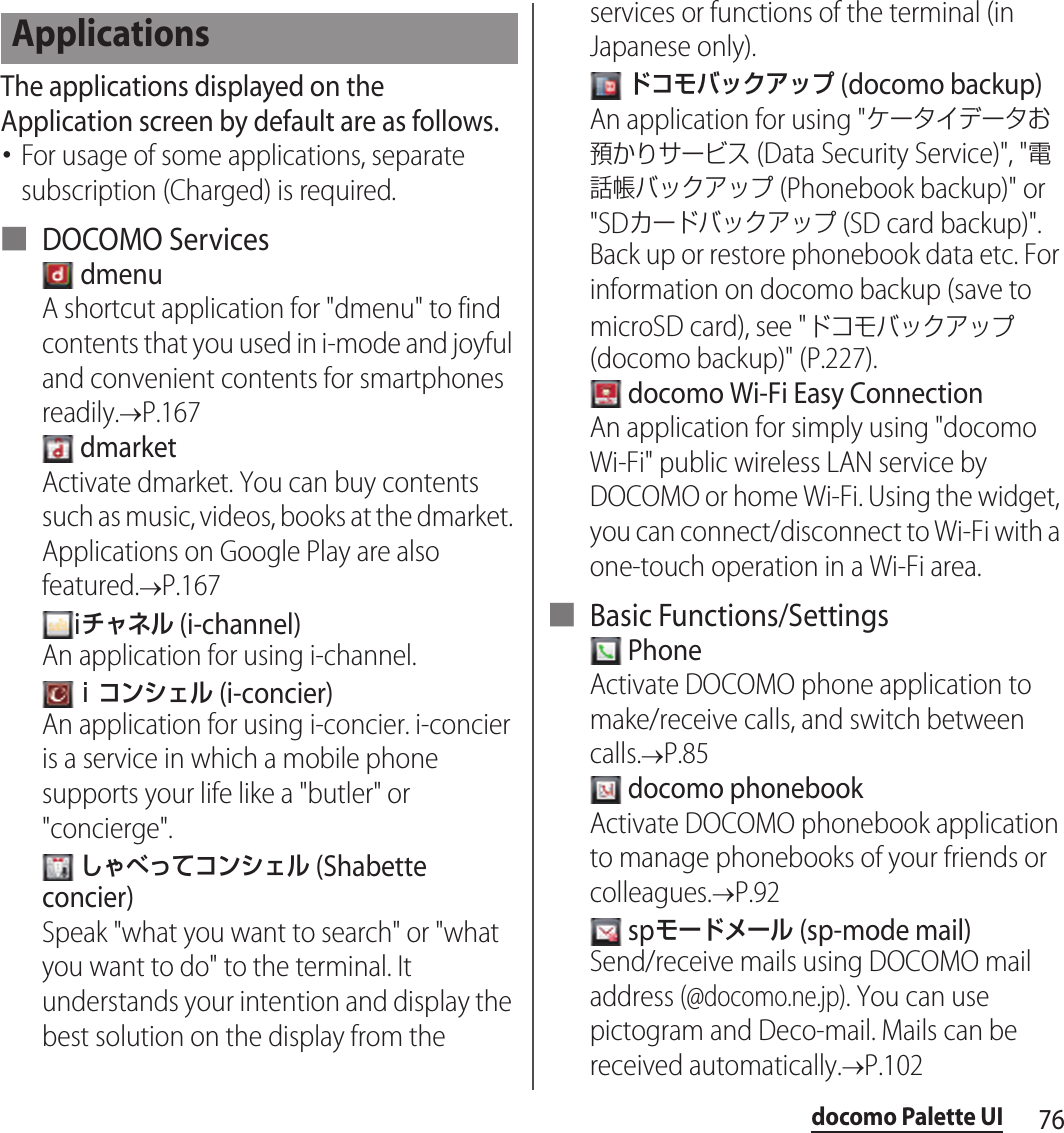
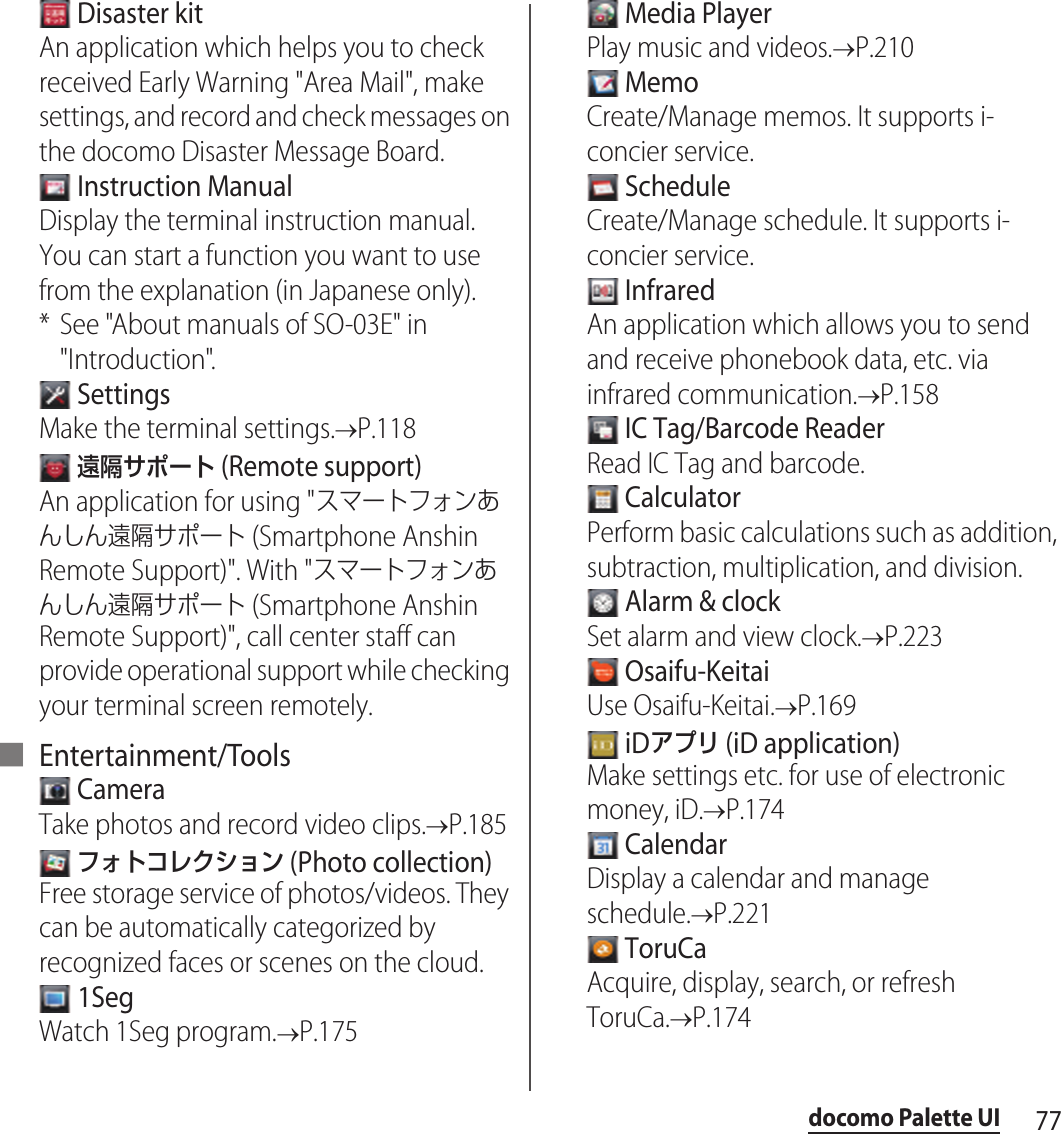
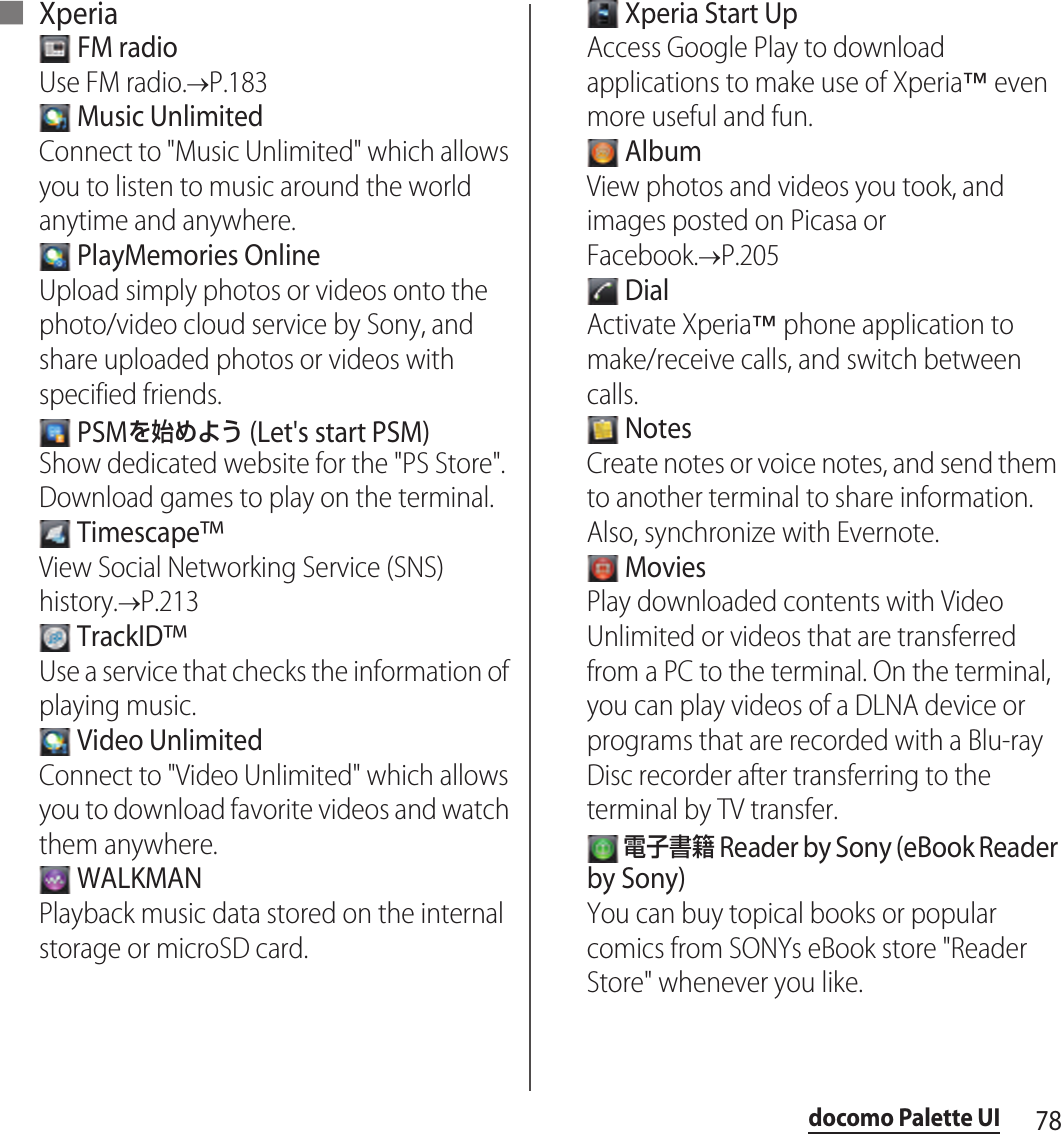
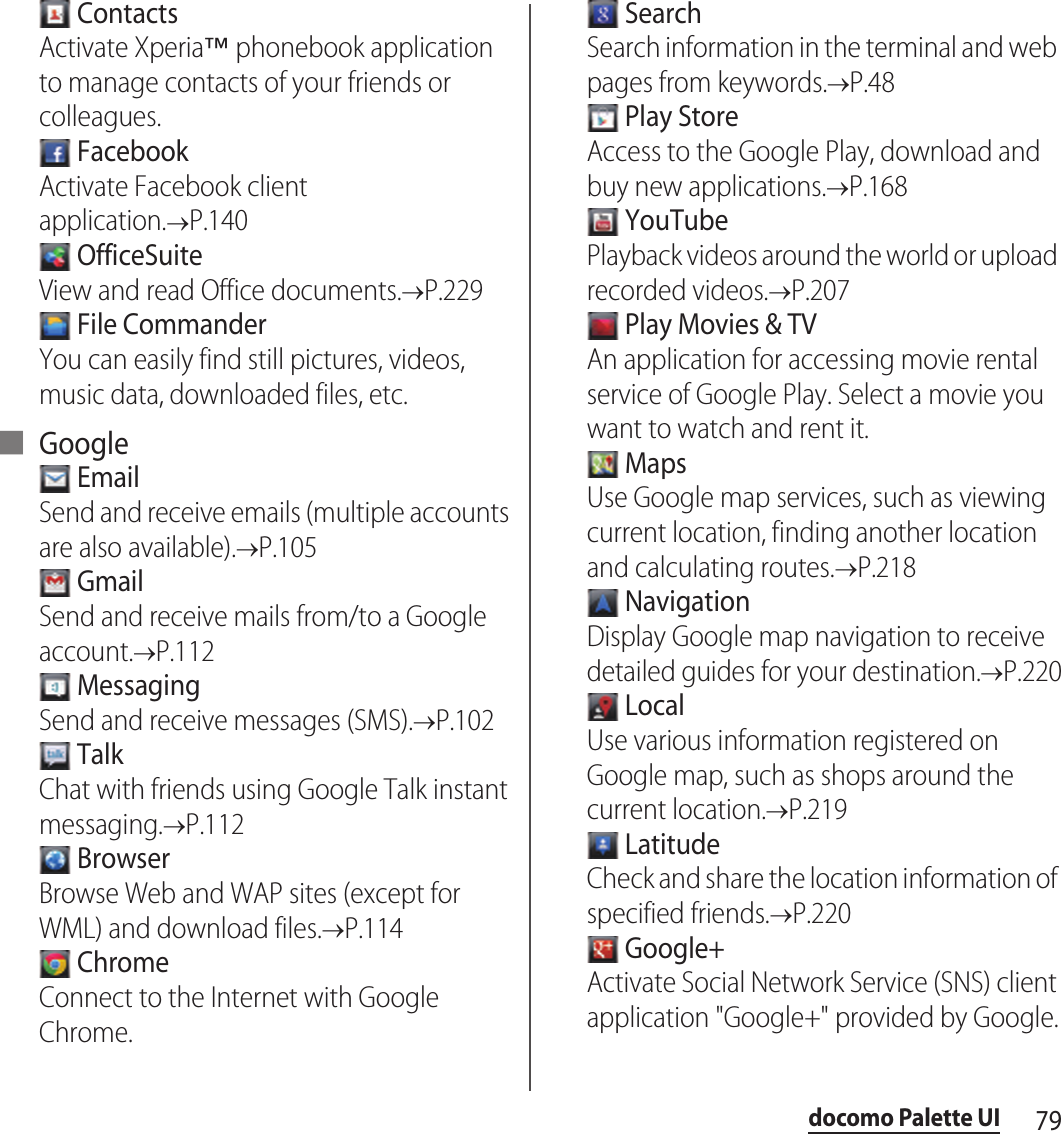
![80docomo Palette UI MessengerChat with friends using Google+ instant messaging.❖Information・The applications displayed on this application screen are pre-installed by default. Some pre-installed applications can be uninstalled. Even if you uninstall, you can download in "Play Store" (P.168) again.・From the Home screen, tap and tap "Recommends" tab u[おすすめアプリを見る (See recommended applications)] to display applications recommended by DOCOMO. For details, see "Installing "Recommends" applications" (P.84).・Some application names may not be displayed fully.・Some applications require downloading and installation. If you cannot download application by tapping, from the Home screen, tap and tap [Settings]u[Security]u[Unknown sources]u[OK], mark the checkbox and then tap the application.・Activating two or more applications may increase battery consumption and the operation time may become short. For this reason, it is recommended to end applications when not used. To end the application, on the application screen you are using, tap x to display the Home screen (P.70).・If you selected Japanese as a language in Initial settings (P.40), some group names are displayed in Japanese even after the language setting is changed. These group names can be changed to English (P.83).From the Application screen, you can add icons, sort icons, uninstall applications. Also you can change group setting.Adding an application icon to the Home screen1From the Application screen, touch and hold an icon you want to add to the Home screen.2Tap [Add].・The application icon is added onto the Home screen.❖Information・Touch and hold an area of the Home screen where no icons are displayed and tap [Shortcut] u[Application] and select an application to add an icon.Sorting application icons1From the Application screen, touch and hold an application icon you want to sort.2Drag it anywhere.・The application icon moves.Changing the Application screen](https://usermanual.wiki/Sony/TM-0000.user-guide/User-Guide-1900871-Page-82.png)
![81docomo Palette UI❖Information・To move an application icon to another application group, touch and hold the icon on the Application screen, tap [Move], then select a desired group, or touch and hold the icon on the Application screen, then drag it to a group to move to.Uninstalling an applicationSome application icons can be deleted from the Application screen.・Before uninstalling application, back up contents related to the application that you want to save including data saved in the application.・Some applications or widgets may not be uninstalled.1From the Application screen, touch and hold an icon of application you want to uninstall.2Tap [Uninstall].・Uninstall screen appears.3Tap [OK]u[OK].❖Information・You can also uninstall them from the Settings menu. For details, see "Deleting installed application" (P.137).Adding a shortcut of group to the Home screen1From the Application screen, touch and hold an icon you want to add to the Home screen.2Tap [Add].・Shortcuts to the group is added to the Home screen.❖Information・Touch and hold an area of the Home screen where no icons are displayed and tap [Group] and select a group to add a shortcut.Changing the color of group name1From the Application screen, touch and hold a group you want to change the color.2Tap [Edit label] and select label color to change.・The color for group name is changed.Deleting group1From the Application screen, touch and hold a group you want to delete.](https://usermanual.wiki/Sony/TM-0000.user-guide/User-Guide-1900871-Page-83.png)
![82docomo Palette UI2Tap [Delete]u[OK].・Application icons belonged to the deleted group move to the "Download Application" group.❖Information・"Recently", "DOCOMO Services", and "Download Application" groups cannot be deleted.Changing group name1From the Application screen, touch and hold a group you want to rename.2Tap [Edit name].3Enter a group name in the entry box and tap [OK].・The group is renamed.❖Information・"Recently", "DOCOMO Services", and "Download Application" groups cannot be renamed.Adding group1From the Application screen, tap and tap [Add group].2Enter a group name in the entry box and tap [OK].・A new group is added.Sorting groups1From the Application screen, touch and hold a group name you want to sort.2Drag it anywhere.・The group is moved.Display recently used applications in thumbnail list and activate. Also, you can use a small app while using another application.1Tap r.・It displays recently used applications in a thumbnail list and small apps that are set.❖Information・Tap an application displayed in a thumbnail to activate, touch and hold it to select "Delete from list"/"App info". Flick left or right an application displayed in a thumbnail to delete from the list.・By default, "Calculator", "Timer", "Notes" and "Recorder" are set in Small apps. You can tap to install small apps from Play Store and set.Small apps](https://usermanual.wiki/Sony/TM-0000.user-guide/User-Guide-1900871-Page-84.png)
![83docomo Palette UISearch application installed into the terminal to activate.1From the Application screen, tap and then tap [Search].・The software keyboard appears.2Enter application name to search.・Search suggestions appear as you enter a character.3Tap a search item.・The application activates.❖Information・When you use for the first time, a confirmation screen appears asking whether to use My location info for the Google search result or service. Read the terms of use and tap [OK].・Alternatively, from the Home screen, tap , then tap [Search] to search application. For details, see "Searching information in the terminal and web pages" (P.48).Icons on the Application screen can be displayed in a list or tiles.1From the Application screen, tap and then tap [List format]/[Tile format].The "Recommends" tab in the Application screen shows applications recommended by DOCOMO (P.76).1From the Application screen, tap "Recommends" tab.2Tap [おすすめアプリを見る (See recommended applications)].3Tap an application.・Download screen appears. Follow the onscreen instructions.❖Information・Downloaded applications are displayed in "Download Application" group in the Application screen.1From the Application screen, tap and then tap [Application info].・The home application information appears.Searching applicationsSwitching application screensInstalling "Recommends" applicationsChecking Home application information](https://usermanual.wiki/Sony/TM-0000.user-guide/User-Guide-1900871-Page-85.png)
![84PhonePhone1From the Home screen, tap , then tap "Dial" tab.2Enter the number of the recipient and tap .・If a wrong number is entered, tap to delete the number.3To end call, tap [End call].❖Information・In Step 2, tap without entering a phone number to enter the phone number registered as the latest call in Recent calls (phone number for missed call is not included).・To activate Xperia™ phone application, from the Home screen, tap , then tap [Dial].Entering pause (,)This function allows you to operate voice mail at home, to reserve tickets, or to check the balance of a bank account, etc.1From the Home screen, tap , then tap "Dial" tab.2Enter the phone number, then tap and tap [Add 2–sec pause].Emergency callWhen the terminal is within range of the service area, you can make an emergency call of 110 (Police), 119 (Fire and ambulance), or 118 (Japan Coast Guard).1From the Home screen, tap , then tap "Dial" tab.2Enter the number of the emergency call and tap .・If a wrong number is entered, tap to delete the number.❖Note・If docomo mini UIM card is not inserted to the terminal, emergency calls (110, 119, 118) cannot be made in Japan.・You can make an emergency call by tapping [Emergency call] on the screen unlocking screen. In Japan, however, on the PIN code entry screen, while PIN code locked or while PUK locked, emergency calls (110, 119, 118) cannot be made.・This terminal supports "Emergency call location information". If you use the terminal to place a call to emergency numbers such as 110, 119, or 118, the information of a location where you are calling from (location information) is automatically notified to the Emergency call acceptance organization such as the Police Station.The Emergency call acceptance organization may not be able to figure out your exact location depending on the location where you place a call or radio wave condition.If you make a call hiding your caller ID, such as by entering a phone number with "184" for each call, the Making/Receiving a callMaking a call](https://usermanual.wiki/Sony/TM-0000.user-guide/User-Guide-1900871-Page-86.png)
![85Phonelocation information and phone number are not notified. However, the Emergency call acceptance organization may decide to obtain the location information and phone number regardless of your settings when they consider it is necessary for lifesaving, etc. Note that the areas/time for which the "Emergency call location information" is ready to be used vary depending on the preparatory state of each Emergency call acceptance organization.・When calling 110, 119 or 118 for emergency from the terminal, tell that you are calling from a mobile phone, and give your phone number and your current location precisely for checking callback from the police/fire department. Also, make a point to call in a stationary position to prevent the call from being dropped. Do not power off the terminal for at least 10 minutes after the emergency call just in case the Police or Fire/Ambulance may have to get in contact with you.・Note that you may not connect to the local Fire Department or Police Station depending on where you are calling from. In this case, try to call from a public phone or an ordinary phone in the neighborhood.Making an international call (WORLD CALL)For details on WORLD CALL, refer to DOCOMO International Services website.1From the Home screen, tap , then tap "Dial" tab.2Touch and hold [0] key until "+" sign appears.・When making an international call, "+" is replaced by an international access code.3Enter Country codeuArea code (City code)uThe number of the recipient and tap .・If the area code begins with "0", omit "0". However, "0" may be required to dial to some countries or areas such as Italy.1While receiving a call, touch and hold (left) and drag it to (right).2To end call, tap [End call].❖Information・During the screen lock, the icon appears and you can answer a call by the same operation.Muting the ringtone for an incoming call1When receiving a call, press m/p.❖Information・You can stop vibration by pressing m/p when silent mode (vibration) is set.・From the Home screen, press m to mute the ringtone for an incoming call.Receiving a call](https://usermanual.wiki/Sony/TM-0000.user-guide/User-Guide-1900871-Page-87.png)
![86PhoneDeclining a call1While receiving a call, touch and hold (right) and drag it to (left).❖Information・During the screen lock, the icon appears and you can reject a call by the same operation.・If you reject an incoming call during use of Voice Mail Service, the call is connected to the Voice Mail service center.Declining an incoming call and sending a message (SMS)When you cannot answer a call, you can reject the call and send a message (SMS). Message to send is registered in advance, and you can edit it if necessary.1Drag upwards when receiving a call.2Tap a message to send.・The message (SMS) is sent to the caller.❖Information・While Voice Mail service is in use, a call is rejected and a message (SMS) is sent then the caller is connected to the Voice Mail service center.・To create a new message to send, when receiving a call, drag up and tap to create a message and send. To edit a message, from the Home screen, tap and , then tap [Call settings]u[Reject call with message] to select and edit an existing message, then tap [OK].You can make or answer a call with Stereo Headset with Microphone (Sample) connecting to the terminal.Using Stereo Headset with Microphone](https://usermanual.wiki/Sony/TM-0000.user-guide/User-Guide-1900871-Page-88.png)
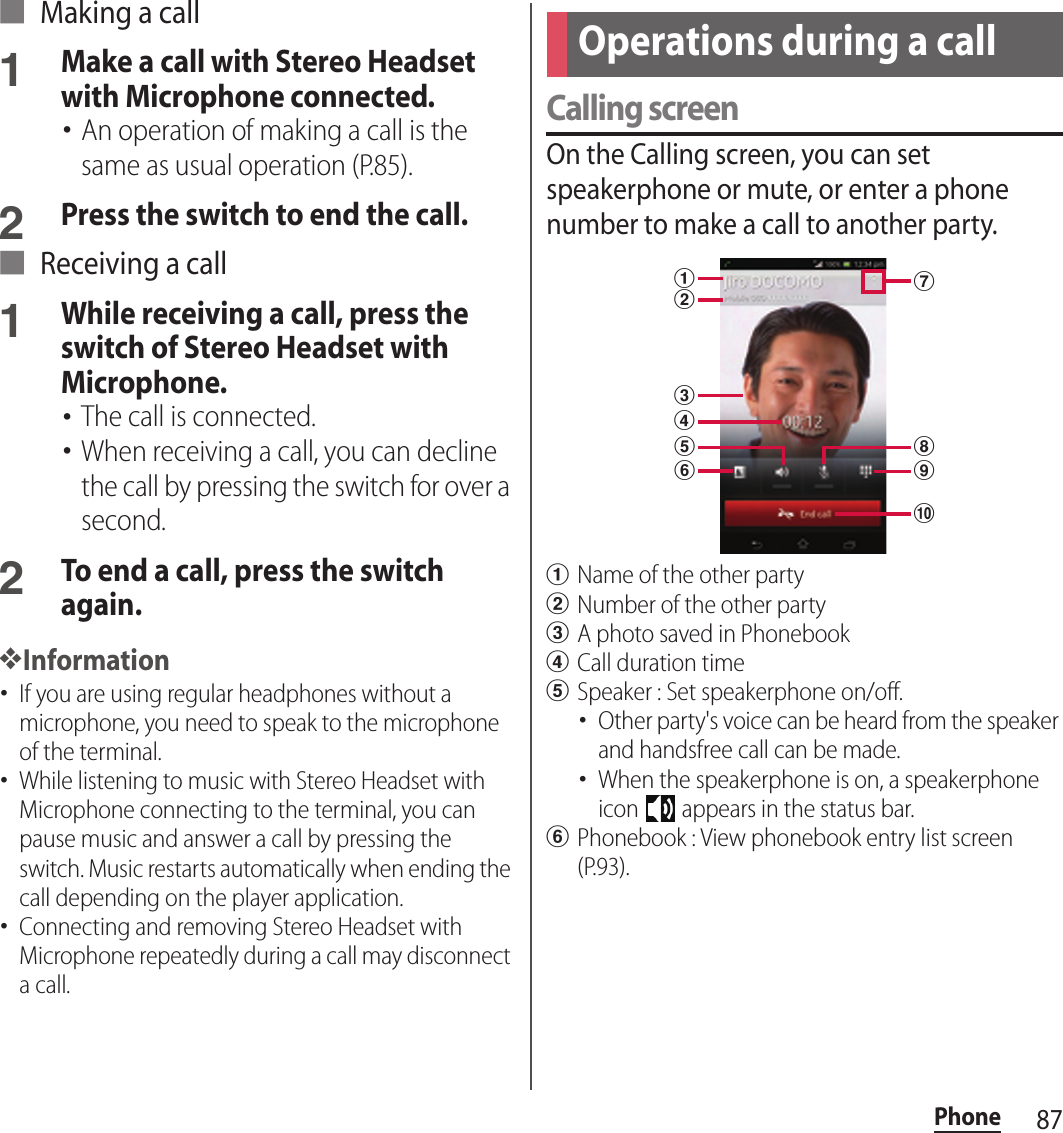
![88PhonegOption menu : Set Hold during a call.・To cancel Hold, tap [Retrieve call] during Hold.・To set a call on hold, "Call waiting" subscription is required (P.91).hMute : Set muting on/off of the microphone during a call.・When the microphone is muted, a mute icon appears in the status bar.iDial key : Enter the phone number you want to add to make a call.・The ongoing call is automatically on hold.・To add a call, "Call waiting" subscription is required (P.91).jEnding a call❖Note・Do not bring the terminal close to your ear with the speakerphone on to avoid from hearing damage.Adjusting the ear speaker volume1During a call, press m to adjust.❖Information・You can adjust the ear speaker volume only during a call.1From the Home screen, tap , then tap "Recent calls" tab.・Recent calls screen appears.Recent calls screenIncoming call and outgoing call are displayed by chronological order in the Recent calls screen.aAll tabbPhone number/namecHistory icons : Missed call : Incoming call : Outgoing calldIncoming tabeOutgoing tabfCall status icons : Caller ID notified : Caller ID hiddenCall historyShowing call historyabcegidhf](https://usermanual.wiki/Sony/TM-0000.user-guide/User-Guide-1900871-Page-90.png)
![89Phone・Notified if calls are made with "186" (Notify)/"184" (Hide) prefixed to the number.・If you enter a phone number and tap , then select [Caller ID notification]u[Notify]/[Not notify] to make a call, / does not appear in the Recent calls screen. : Koe-no-Takuhaibin・For details on Koe-no-Takuhaibin, refer to "Koe-no-Takuhaibin" (P.91) or NTT DOCOMO website. : Incoming/outgoing international callgDatehOutgoingiPhonebook❖Information・On the Recent calls screen, tap and tap [Call settings] to set/edit "Network service" or "Reject call with message" (P.91).Making a call from Recent calls1On the Recent calls screen (P.89), tap .Adding a number from the Recent calls to Phonebook1On the Recent calls screen (P.89), tap a phone number and tap [Add Phonebook].・Alternatively, touch and hold a phone number, tap [Edit number before call]u[Add Phonebook].2Tap desired phonebook entry, or tap [Register new].・When you set a Google account etc., tap [Register new] so that you can select that account as a registration account.3On the profile editing screen, enter information and tap [Save].Deleting a call history1On the Recent calls screen (P.89), tap .2Tap [Delete all]u[OK].❖Information・To delete only an item from Recent calls, in the Recent calls screen, touch and hold a call log you want to delete and tap [Delete from call log]u[OK].・To delete all items from Incoming log or Outgoing log, in the Recent calls screen, tap "Incoming" tab/"Outgoing" tab and tap , then [Delete all]u[OK].](https://usermanual.wiki/Sony/TM-0000.user-guide/User-Guide-1900871-Page-91.png)
![90PhoneWhen you have missed calls, appears in the status bar.1Drag the status bar downwards.2Tap [Missed call].・Recent calls screen appears.❖Information・When you have missed calls, an icon appears indicating missed calls and the number of them in the screen unlock screen.You can set the network services or edit Reject call with message.1From the Home screen, tap , then tap .2Tap [Call settings].Displaying missed callsCall settingsNetwork serviceKoe-no-TakuhaibinKoe-no-Takuhaibin is a service of taking voice messages for you.Voice mail serviceIt is a service of taking caller's message when you cannot answer an incoming call.Call forwarding serviceIt is a service of transferring call when you cannot answer an incoming call.Call WaitingIt is a service of putting the current call on hold and answering an incoming call or making a call to another party.Caller ID notificationNotify the display of the recipient phone of your phone number.Nuisance call blocking serviceRegister phone numbers of nuisance call to reject.Caller ID display request serviceRequest number notification for calls without phone number with guidance.](https://usermanual.wiki/Sony/TM-0000.user-guide/User-Guide-1900871-Page-92.png)
![91PhoneOn the Phonebook, you can enter various information for contacts, for example, phone numbers, mail addresses and various service accounts.1From the Home screen, tap , then tap [docomo phonebook].・The phonebook list screen appears.❖Information・When you use for the first time, "Use of Cloud" screen appears. Tap [Start] to start using Cloud. Cloud service in phonebook require DOCOMO's phonebook application.・Alternatively, from the Home screen, tap and tap [Phonebook] to display phonebook list screen.・Phonebook data can be backed up in a microSD card using "ドコモバックアップ (docomo backup)". For information on backing up, see "ドコモバックアップ (docomo backup)" (P.227).・To activate Xperia™ phone application, from the Home screen, tap , then tap [Contacts].Network ServiceSecond call settingsSet action for additional incoming call during a call.Call notificationNotify incoming calls by SMS while the power is off or you are out of service area.English guidanceSwitch the voice guidance to English or Japanese.Remote operation settingsSet to operate Voice Mail Service or Call forwarding Service using land-line phone, public phone or DOCOMO mobile phone, etc.Roaming settingsP.236Advanced call settingsSub address settingsSet whether "*" in phone number is identified as a sub address separator.Prefix settingsRegister a prefix number added before phone number when making a call.Reject unregistered callSet whether to reject an incoming call with unregistered phone number in the Phonebook automatically.Reject call with messageEdit/Set a message (SMS) to be sent when rejecting an incoming call.Microphone noise suppressionMake the voice clear to understand for the other party during a call.AccountsSet Internet phone (SIP) account.Use Internet callingSet Internet phone (SIP) call method.PhonebookDisplaying phonebook](https://usermanual.wiki/Sony/TM-0000.user-guide/User-Guide-1900871-Page-93.png)
![92PhonePhonebook list screenOn the phonebook list screen, you can view details of your contacts. You can add a picture to a phonebook entry, and display phonebook entries by group.aContacts tabbName registered in the phonebook entrycEntry items・Icons indicate entry items.dPhoto set in the phonebook entryeRegisterfGroup・Select a group to be displayed.gCommunication tab・Call history or history of message (SMS), sp-mode mail and SNS messages are displayed. SNS messages are displayed only when using "My SNS" function after using Cloud is started.hTimeline tab・Timeline of SNS/blog by "Friend NEWS" function and "My SNS" function is displayed. To display, start using Cloud.iOption menujMy profile tab・Check your own phone number.kIndex character area・Tap index character to display phonebook entries allocated to the index character.lIndex・Display the index character to search entries in the order of Japanese syllabary, alphabet, etc.mSearchAdding a new phonebook entry1On the phonebook list screen (P.93), tap [Register].・When you set a Google account etc., you can select that account as a registration account.2Enter a name on the profile editing screen.3Select a desired item to enter.・You can set phone number, mail address, group, etc. Tap in "Others", then tap [Add] to add information.4Tap [Save].lag hcdbfejikmManaging phonebook](https://usermanual.wiki/Sony/TM-0000.user-guide/User-Guide-1900871-Page-94.png)
![93Phone❖Information・When you save "Phonetic name (family/given)", phonebook list is displayed according to Japanese syllabary order or alphabets order of "Phonetic name". If you enter "family/given" in Kanji without entering "Phonetic name" to add phonebook entry, the name appear in "ABC" field on the phonebook list screen.・To check the number of registered data in the Phonebook, from the phonebook list screen, tap , then tap [Others]u[About].・If "docomo" account is selected as saving location when registering phonebook entries, SNS/Blog accounts can be set.Using phonebook shortcutsWhen you tap the photo (image) part on the phonebook list screen (P.93), shortcuts for phone, mail, etc. appear. Tap the shortcut to make a call, or create and send a mail.* You can also use other functions such as displaying a map from the registered addresses.❖Information・When you tap a part other than photo (image) on the phonebook list screen, profile screen of the phonebook appears instead of shortcuts.・Email shortcut appears when email address is saved in the selected phonebook entry and you have set your email account. If you have not set your email account, shortcut for Gmail ( ) appears.・For a phonebook entry with only name, tapping photo (image) does not display the shortcut.Making a call using the phonebook1On the phonebook list screen (P.93), tap a phonebook entry to call.2On the Profile screen, tap a phone number.3Tap [Call].Searching for a phonebook entry1On the phonebook list screen (P.93), tap [Search].2Enter name or reading to search.・All phonebook entries beginning with those letters (First name/Last name) appear.Call to registered phone number.Create and send message (SMS).Select Email application to create and send an email.・If "Use by default for this action." checkbox is marked, application selection screen will not appear for the next time.](https://usermanual.wiki/Sony/TM-0000.user-guide/User-Guide-1900871-Page-95.png)
![94PhoneChanging contacts display order1On the phonebook list screen (P.93), tap , then tap [Others]u[Contacts display order].2Tap [Japanese order]/[Alphabetical order]/[Number order].Changing accounts to displayYou can set registered phonebook entries to be displayed in the phonebook list.1On the phonebook list screen (P.93), tap , then tap [Others]u[Accounts to display].2Tap [Display all accounts]/[docomo].・When you set a Google account etc., you can select that account to display.・Tap [Customize...], select a checkbox for each account, and then customize display of the phonebook list screen.Displaying phonebook entries by group1On the phonebook list screen (P.93), tap [Groups].2Tap a group.・Phonebook entries are displayed by the group set when the entry is registered.・To hide the group, tap [Close].Setting group for phonebook entrySet a group from phonebook list screen.1On the phonebook list screen (P.93), tap [Groups].2Touch and hold a phonebook entry to set a group, and then drag it to any group.❖Information・To cancel group setting, touch and hold a phonebook entry you want to cancel, and then drag it to the set group.・When you set Google account etc., display groups by account. You can set/cancel group in the same account.](https://usermanual.wiki/Sony/TM-0000.user-guide/User-Guide-1900871-Page-96.png)
![95PhoneCreating a new group in Phonebook1On the phonebook list screen (P.93), tap [Groups]u[Add].・When "Add" is not displayed, flick on groups to display.・When you set a Google account etc., you can select that account for adding.2On the group addition screen, enter color, icon, group name, and tap [OK].・The items vary depending on the account type.❖Information・You can edit/delete newly created groups and "Family"/"Friends"/"Company", which are saved by default. To edit a group, touch and hold a group and tap [Edit group], then enter editing content and tap [OK]. To delete a group, touch and hold a group and tap [Delete group]u[OK]. Phonebook entries belonged to the deleted group move to the "No group" tab.・You cannot add a group that has the same name as existing groups.Editing a phonebook entry1On the phonebook list screen (P.93), tap a phonebook entry to edit.2On the profile screen, tap [Edit].3Select a required item and edit.・Tap [Add] to set phone number or mail address, and tap on "Others" and [Add] to add information.4Tap [Save].Registering a phonebook entry to FavoritesYou can mark a phonebook entry as a favorite. The favorite list provides quick access to the phonebook entry you have marked.1On the phonebook list screen (P.93), tap a phonebook entry to combine.2On the profile screen, tap .・The icon turns to (yellow) and the entry is registered to Favorites.❖Information・Phonebook entries saved to the docomo account/Google account can be added to Favorites.・To display phonebook entries added to Favorites, on the phonebook list screen, tap [Groups]u[Favorites], or from the Home screen, tap and then tap "Favorites" tab.](https://usermanual.wiki/Sony/TM-0000.user-guide/User-Guide-1900871-Page-97.png)
![96PhoneSetting photo in a phonebook entry1On the phonebook list screen (P.93), tap a phonebook entry you want to add a picture.2On the profile screen, tap [Edit].3Tap [Setting] for image.4Tap [Take photo]/[Select picture].・When you tap [Take photo], select "Camera"/"Picture effect" to take a photo. For information on how to shoot by "Picture effect", see "Picture effect" (P.201).・When you tap [Select picture], select "Album"/"File commander" to select a picture.5Set image range to be displayed, and then tap [Crop].・Drag or pinch to adjust cropping area to set image range.6Tap [Save].❖Information・You can also set photo to a phonebook entry by the following operation.From the Home screen, tap , then tap [Album]. Select an image you want to set and tap the screen and , then tap [Use as]u[Photo of phonebook]. Select a phonebook entry you want to register, set image range to be displayed, and then tap [Crop].Setting ringtone1On the phonebook list screen (P.93), tap a phonebook entry to set ringtone.2On the profile screen, tap and [Set ringtone].3Select a ringtone and tap [Done].❖Information・To set a ringtone other than the ones stored by default, tap .・Depending on the saving account, ringtone can be set when saving a phonebook entry.Combining phonebook entriesYou can bind multiple phonebook entries together into one.1On the phonebook list screen (P.93), tap a phonebook entry to combine.2On the profile screen, tap and [Join/Separate].・Phonebook entries to be combined are displayed.3Tap the phonebook entry to combine.](https://usermanual.wiki/Sony/TM-0000.user-guide/User-Guide-1900871-Page-98.png)
![97Phone❖Information・To cancel binding, on the profile screen of the phonebook, tap , then tap [Join/Separate]u[Separate].Deleting a phonebook entry1On the phonebook list screen (P.93), tap , then tap [Delete].2Mark the phonebook entry you want to delete.・If you want to delete all phonebook entries, tap "Select all".・Tap [Index] to search phonebook.3Tap [Delete]u[OK].❖Information・To delete only an item of phonebook entry, in the phonebook list screen, tap a phonebook entry you want to delete and tap , then tap [Delete]u[OK].Checking My profile and editing information1On the phonebook list screen (P.93), tap "My profile" tab.2Tap [Edit].3On the My profile screen, enter necessary information.・Tap [Add] to set phone number or mail address, and tap [Set] to add SNS or Blog account. Tap in "Others", then tap [Add] to add information.4Tap [Save].❖Information・You can register multiple phone numbers, mail addresses, SNS/Blog accounts, etc. in My profile.・Name card data created with name card creator application can be saved to My profile and the name card data can be exchanged via network. When you use for the first time, in the phonebook list screen, tap the "My profile" tab and [Create new] and follow the onscreen instructions.Sending phonebook entries via infrared communication1On the phonebook list screen (P.93), tap , then tap [Others]u[Send via infrared].・To send an entry, tap [Send one], select entry to send then tap [OK]u[OK].・To send all phonebook entries, tap [Send all] u Tap [Start], enter docomo apps password, tap [OK], then enter the same authentication password as that of the recipient and tap [OK] u [OK] u [OK].](https://usermanual.wiki/Sony/TM-0000.user-guide/User-Guide-1900871-Page-99.png)
![98Phone❖Information・When sending all phonebook entries via infrared communication, you need to enter authentication password an docomo apps password. Authentication password is a 4-digit number fixed up between you and other party in advance. For the docomo apps password, see "docomo apps password" (P.139).・To activate infrared communication in a selected phonebook entry, tap in the profile screen, [Infrared]u[OK]u[OK]. To send My profile, tap "My profile" tab in the phonebook entry list screen, tap , [Send via infrared]u[OK]u[OK]. If a name card is stored in My profile, tapping [Send via infrared] opens a screen to select "send my profile" or "Exchange name card (via infrared)".・Phonebook entries can be sent using "Infrared" app. For details, refer to "Sending data via infrared communication" (P.159).Sending phonebook via Bluetooth/Email/GmailRegistered phonebook and My profile information can be sent using Bluetooth function (P.161), or email attachment function.■ Sending phonebook1On the phonebook list screen (P.93), tap a phonebook entry you want to send.2On the profile screen, tap and [Share].3Select sending method and follow the onscreen instructions.■ Sending My profile1On the phonebook list screen (P.93), tap "My profile" tab.2Tap and [Share].3Select sending method and follow the onscreen instructions.❖Information・To use Bluetooth function, turn on Bluetooth function (P.161) in advance, or select [Bluetooth]u[Turn on] in Step 3.・To use email, you need to make settings of your email account (P.105).・If you want to send it as a data attached to email/Gmail, send from the compose screen for the mail service in which you have set an account. When you have not set a Gmail account, setup wizard appears. You can create and send email after settings are done.・Messaging (SMS) is not available.・You cannot send some information such as name card data set in phonebook.・For sending all phonebook entries, see "Sharing phonebook entry currently displayed" (P.100).](https://usermanual.wiki/Sony/TM-0000.user-guide/User-Guide-1900871-Page-100.png)
![99PhoneSharing phonebook entry currently displayed1On the phonebook list screen (P.93), tap , then tap [Others]u[Import/Export].2Tap [Share phonebook data].3Select sending method and follow the onscreen instructions.・If "Use by default for this action." checkbox is marked, application selection screen will not appear for the next time.❖Information・If display conditions for phonebook (P.95) are set, only phonebook entries to be displayed are exported.・To use Bluetooth function, turn on Bluetooth function (P.161) in advance, or select [Bluetooth]u[Turn on] in Step 3.・To use email, you need to make settings of your email account (P.105).・If you want to send it as a data attached to email/Gmail, send from the compose screen for the mail service in which you have set an account. When you have not set a Gmail account, setup wizard appears. You can create and send email after settings are done.・Messaging (SMS) is not available.・You cannot send some information such as name card data set in phonebook.You can export/import phonebook entries from/to microSD card or docomo mini UIM card. This is useful, for example, when you want to transfer the contact information to another phone.❖Information・You can also use a synchronization service for synchronizing your phonebook. For details, refer to "Setting Auto-sync" (P.142).Exporting phonebook to microSD cardInsert a microSD card in advance (P.33).1On the phonebook list screen (P.93), tap , then tap [Others]u[Import/Export].2Tap [Export to SD card].3Tap [Export one contact data]/[Export some contact data]/[Export all contact data]u[OK].・When you tap [Export one contact data]/[Export some contact data], mark a contact to export and tap [OK].4Select [No]/[Yes] for attaching name card.Exporting/Importing phonebook entries](https://usermanual.wiki/Sony/TM-0000.user-guide/User-Guide-1900871-Page-101.png)
![100Phone5Tap [OK].Importing phonebook from microSD cardInsert a microSD card in advance (P.33).1On the phonebook list screen (P.93), tap , then tap [Others]u[Import/Export].2Tap [Import from SD card].・When you set a Google account etc., you can select that account as an import account.・If there is only one file, the file is imported immediately.3Tap [Import one phonebook data]/[Import multiple phonebook data]/[Import all phonebook data]u[OK].・If you tap [Import one phonebook data]/[Import multiple phonebook data], mark vCard files to import, then tap [OK].・If a file has multiple phonebook entries, they are imported all at once.❖Information・For some phonebook entries, a part of data may not be imported or exported.Importing phonebook entries from docomo mini UIM card1On the phonebook list screen (P.93), tap , then tap [Others]u[Import/Export].2Tap [Import from SIM card].・When you set a Google account etc., you can select that account as an import account.3Tap a phonebook entry to import.・Alternatively, touch and hold a contact to be imported, tap [Import].・To import all phonebook entries, tap and [Import all phonebook data].❖Information・Names and phone numbers can be imported.・If there is a phonebook entry whose name is matched with the imported entry, the entry is imported as a separated one.・To export phonebook entries to docomo mini UIM card, use "Contacts" application of Xperia™. Note that only name and the first phone number can be saved because of memory space of docomo mini UIM card. For some phonebook entries, a part of data may not be exported.](https://usermanual.wiki/Sony/TM-0000.user-guide/User-Guide-1900871-Page-102.png)
![101Mail/Web browserMail/Web browserSend/receive mails using DOCOMO mail address (@docomo.ne.jp).You can use pictogram and Deco-mail. Mails can be received automatically. For details on sp-mode mail, refer to "ご利用ガイドブック (spモード編) (Mobile Phone User's Guide [sp-mode]) (in Japanese only)".1From the Home screen, tap .2Flick the screen upwards, then tap [ダウンロード (Download)].・After this step, follow the instructions on the screen.❖Information・sp-mode mail data can be backed up in a microSD card using "ドコモバックアップ (DOCOMO backup)". For information on backing up, see "ドコモバックアップ (docomo backup)" (P.227).You can send and receive text messages up to 70 two-byte characters (up to 160 one-byte characters) with a mobile phone number as the destination.1From the Home screen, tap , then tap [Messaging].2Tap (New mail).3Enter the recipient's phone number.・Tap to display the contacts list screen to select from registered contacts. When you enter a name or phone number in the box at the top of the screen, a list of contacts matching the entered numbers or letters appears.4Tap [Write message] and enter a message.・Tap and [Select message template] to enter by selecting message template registered in "Message template settings" (P.104).sp-mode mail Message (SMS)Sending message (SMS)](https://usermanual.wiki/Sony/TM-0000.user-guide/User-Guide-1900871-Page-103.png)
![102Mail/Web browser・When the number of entered characters comes close to a limit, a number of enterable characters appears on the upper left of the text box.5Tap [Send].❖Information・For the character entry, see "Character entry" (P.49).・You can also send/receive text messages to/from customers of overseas network operators. For details, see "Mobile Phone Users Guide [International Services]" or the DOCOMO International Services website.・To send SMS to users of overseas network operators, enter "+", "Country code" and then "the recipient mobile phone number". Enter the phone number without a leading "0", if any. You can also enter "010", "Country code" and "the recipient mobile phone number" to send messages (To reply to the received SMS overseas, enter "010").1From the Home screen, tap , then tap [Messaging].2Tap a sender whose messages (SMS) you want to read.・A message (SMS) appears.❖Information・When you receive a message (SMS), appears on the status bar. To read the message (SMS), drag the status bar downward, tap an item of notified message (SMS).・Tap / in the message (SMS) to turn to (yellow). From the Home screen, tap , then tap [Messaging], tap and [Starred messages] to quickly access to the mail you have marked.1From the Home screen, tap , then tap [Messaging].2Select a phone number to save.3Tap and then [Add to Contacts].4Tap desired phonebook entry, or tap [Register new].・When you set Google account etc., tap [Register new] to select the account as a saving location.5Enter required items and tap [Save].Receiving and reading message (SMS)Saving phone number of message (SMS) to Contacts](https://usermanual.wiki/Sony/TM-0000.user-guide/User-Guide-1900871-Page-104.png)
![103Mail/Web browser1From the Home screen, tap , then tap [Messaging].2Tap and then [Settings].* You need to set to Silent mode (vibration) or mark "Vibrate on ring" (P.131) checkbox beforehand.1From the Home screen, tap , then tap [Messaging].2Tap a party whose messages (SMS) you want to delete.3Touch and hold a message (SMS) you want to delete.4Tap [Delete message]u[Delete].❖Information・To delete several messages (SMS) of the party, in Step 3, tap , tap [Delete messages], and mark messages (SMS) you want to delete, then tap and tap [Delete]. To delete all messages (SMS) of the party, tap at the top of the screen, tap [Mark all], then tap and tap [Delete].1From the Home screen, tap , then tap [Messaging].2Touch and hold a party you want to delete.・The party to be deleted is marked. Tap at the top of the screen and tap [Mark all] to select all parties.3Tap and [Delete].Setting message (SMS)Delivery reportSet whether to mark a message (SMS) you sent each time a recipient receives the message (SMS).NotificationsSet whether to show message (SMS) arrival notification in the status bar.Notification toneSet ringtone when receiving a message (SMS).Notification vibration*Set whether to vibrate when receiving a message (SMS).Notification lightSet whether to notify message (SMS) reception by notification LED.SIM messagesManage messages (SMS) saved to docomo mini UIM card.Message template settingsRegister phrase that can be inserted when writing a text.Push settingsSet a message (SMS) sent from the provider.SMS center numberCheck SMS center number.Deleting a message (SMS)Deleting messages (SMS) by party](https://usermanual.wiki/Sony/TM-0000.user-guide/User-Guide-1900871-Page-105.png)
![104Mail/Web browser❖Information・In Step 2, tap and tap [Delete conversations] to select a party to delete or delete all messages (SMS).You can create an email account provided by mopera U mail, a POP3 or IMAP compatible email account provided by general ISP (provider), or an Exchange ActiveSync account to send or receive email.Email setup wizard appears. Set according the onscreen instructions. Multiple email accounts can be set.For mopera U mail setting procedure, see "Using mopera U Mail" (P.111).1From the Home screen, tap , then tap [Email].2Enter your email address and password.3Tap [Next].・To make the email account settings manually, tap [Manual setup] and follow the onscreen instructions.4Set Inbox check frequency, mark required items and tap [Next].・If a screen for selecting type of account appears, tap an email account type and follow the onscreen instructions to set.5Enter account name and name displayed on emails you send, and tap [Next].・Inbox for set email account appears.・If you set an Exchange ActiveSync account, a name displayed for email cannot be set. Set up from "Your name" (P.109) on email account settings after email initial settings is complete.❖Information・If you need to make the settings manually, contact your email service provider or system administrator for the correct email account settings.・If you set an Exchange ActiveSync account as email account, and if server manager sets Remote wipe, the data saved in the terminal may be deleted. Data stored in microSD card is not deleted.・Emails are not displayed in Timescape.EmailMaking initial setting for Email](https://usermanual.wiki/Sony/TM-0000.user-guide/User-Guide-1900871-Page-106.png)
![105Mail/Web browser1From the Home screen, tap , then tap [Email].2Tap (Compose).3Enter the email address of recipient.・Tap to display the contacts list screen to select from registered contacts. When you enter a name or email address in the search box at the top of the screen, a list of contacts matching the entered numbers or letters appears.・To add Cc or Bcc recipients, tap and tap [Show Cc/Bcc].・To enter multiple email addresses directly, separate with a comma (,) and then enter the next email address.4Enter a subject and message.5Tap (Send).❖Information・To attach a file, while creating an email, tap and attach a file in the following step.・Image/video/music file up to 5MB can be attached in Email.・When you want to save a mail as draft while creating a mail, enter any of recipient, subject or message or attach a file. If you do not enter or attach anything, a mail is not saved as draft (when only automatic signature is attached, a mail is not saved as draft either).・While creating a mail, tap and tap [Save draft] to save a mail as draft. Also, if you view another screen while creating an email, the email is automatically saved as draft.・In sent/received emails, a communication data is also included other than text and image displayed on the screen and charges will apply to the data.・Email is handled as an email from a PC. You cannot send or receive email if "Reject emails from PCs" is set on a recipient terminal.Creating and sending emailAdd pictureSelect a file from the saved image file list to attach it.Take photoStart the camera to take a photo and attach it.Add videoSelect a file from the saved video file list to attach it.Record videoStart the camera to shoot a video and attach it.Add sound WALKMAN : Select a file from the saved music file list to attach it.Sound Recorder : Record a voice message and attach it.](https://usermanual.wiki/Sony/TM-0000.user-guide/User-Guide-1900871-Page-107.png)
![106Mail/Web browser1From the Home screen, tap , then tap [Email].・If you have already set an email account, tap [Inbox] to select an email account to receive.2On the Inbox, tap and tap [Refresh].3Tap an email you want to read.・Email message appears.❖Information・The sender name of a received email is the name set on sender's terminal.・If you set "Email notifications" in Account settings (P.109) and set "Inbox check frequency" to an item other than "Manual", appears in the status bar when you receive a new email. Drag the status bar downwards to read the received email.・If you set "Inbox check frequency" in Account settings (P.109) to an item other than "Manual", and if you are using the pay-as-you-go data communication, you may be charged every time you check your email.・If you tap the address of a received email, you can register it in Phonebook. If it has been already registered, you can display the details of the entry.・Tap on the email list screen or email message screen to turn (yellow) and add the marked email to "Starred" folder. "Starred" folder is displayed when you tap [Inbox] u [Show all folders]. From "Starred" folder, you can quickly access to the mail you have marked.If is not displayed on the email message screen, tap to display.・When phone memory becomes low, a message indicating low memory space appears and receiving emails is not available. Delete saved emails etc. to make available memory space.Changing Inbox viewTurn Preview pane on and turn the terminal sideways to show preview of email message. To switch to the landscape view, turn Auto-rotate screen on beforehand (P.46).1From the Home screen, tap , then tap [Email].2Tap and [Settings]u[General]u[Preview pane].3Tap [Landscape].❖Information・If you have two or more accounts, change made in any of the accounts applies to all accounts.Receiving and reading email](https://usermanual.wiki/Sony/TM-0000.user-guide/User-Guide-1900871-Page-108.png)
![107Mail/Web browser1From the Home screen, tap , then tap [Email].2Tap email with attached files and tap .・The attached file list is displayed.3Tap [Save] of file you want to save.・When attached file is not loaded, tap [Load].・Tap [View] to view the attached file.❖Information・The attached file is saved on the internal storage.1From the Home screen, tap , then tap [Email].2Tap email to reply or forward and tap .3Tap any of [Reply]/[Reply all]/[Forward].・When you tap [Forward], enter an email address to forward.4Enter a message.5Tap (Send).❖Information・Alternatively, in Inbox, touch and hold an email you want to reply or forward and tap [Reply]/[Reply all]/[Forward] to replay or forward.・When you reply or forward an email, the original message contents for replying or forwarding is quoted. To delete the quoted message text, unmark "Include original text".・When you forward an email, the attachment file of the original message is quoted. To cancel quoting attached file, tap .1From the Home screen, tap , then tap [Email].2Tap an email delete.3Tap and [Delete].❖Information・Touch and hold an email you want to delete and tap [Delete]u[Delete] to delete.・To delete several emails, in Inbox, tap and [Delete], mark emails you want to delete, and tap [Delete]u[Delete]. To delete all emails, tap [Mark all]u[Delete]u[Delete].Saving attachment file of emailReplying/forwarding emailDeleting email](https://usermanual.wiki/Sony/TM-0000.user-guide/User-Guide-1900871-Page-109.png)
![108Mail/Web browser1From the Home screen, tap , then tap [Email].2Tap and [Settings].3Tap an Email account you want to change the settings for.*1 Appears when Gmail account (@gmail.com) is set.*2 You need to set to Silent mode (vibrate) or mark "Vibrate on ring" (P.131) checkbox beforehand.❖Information・The items vary depending on the account type.・You can also set "Out of office", "Days to sync", "Sync contacts", and "Sync calendar" for an Exchange ActiveSync account. "Outgoing settings" cannot be set.・If you set "Inbox check frequency" to an item other than "Manual", and if you are using the pay-as-you-go data communication, you may be charged every time you check email.・If you tap [General] in Step 3, you can change whole "Email" application settings.Changing Email account settingsAccount nameChange account name.Your nameChange your name (sender name).SignatureChange your signature.Quick replyRegister phrase that can be inserted when creating an email.Default accountSet to the default account to send email, if you set two or more email accounts.Inbox check frequencySet whether to check new messages automatically and intervals of automatic check.Auto download attachments*1Set whether to download attached file automatically when connecting via Wi-Fi.Email notificationsSet whether to show email arrival notification in the status bar.Select ringtoneSet ringtone when receiving an email.Vibrate*2Set whether to vibrate when receiving an email.Notification lightSet whether to notify email reception by notification LED.Incoming settingsSet mail server for receiving.Outgoing settingsSet mail server for sending.Delete accountDelete Email account.](https://usermanual.wiki/Sony/TM-0000.user-guide/User-Guide-1900871-Page-110.png)
![109Mail/Web browser1From the Home screen, tap , then tap [Email].2Tap and [Settings]u[ADD ACCOUNT].3Enter your email address and password.・If required, mark [Send email from this account by default.].4Tap [Next].・To make the email account settings manually, tap [Manual setup] and follow the onscreen instructions.5Set Inbox check frequency, mark required items and tap [Next].・If a screen for selecting type of account appears, tap an email account type and follow the onscreen instructions to set.6Enter account name and name displayed on emails you send, and tap [Next].・Inbox for set email account appears.・If you set an Exchange ActiveSync account, a name displayed for email cannot be set. Set up from "Your name" (P.109) on email account settings after email initial settings is complete.❖Information・If you need to make the settings manually, contact your email service provider or system administrator for the correct email account settings.・If you set an Exchange ActiveSync account as email account, and if server manager sets Remote wipe, the data saved in the terminal may be deleted. Data stored in microSD card is not deleted.・Tap [Inbox] to display a list of set accounts. Tap [Combined view] to display combined Inbox for all accounts.・Emails are not displayed in Timescape.1From the Home screen, tap , then tap [Email].2Tap and [Settings].3Tap an account to delete.4Tap [Delete account]u[OK].Setting another Email accountDeleting Email account](https://usermanual.wiki/Sony/TM-0000.user-guide/User-Guide-1900871-Page-111.png)
![110Mail/Web browsermopera U users can use mopera U Mail.For mopera U setting procedure, see "Setting mopera U" (P.129).In mopera U Mail, POP mail and IMAP mail are available. The mail box supports 50MB. Also, the Web mail system is available.■ POP mail1From the Home screen, tap , then tap [Email].・If you already set an Email account, tap and [Settings]u[ADD ACCOUNT].2Enter mopera U mail address and mopera U password, then tap [Manual setup]/[Next].・If you tap [Next], it changes automatically to POP3 account. Go to Step 4.3Tap [POP3] from the type of the mail account.4Check that you have entered "User name" and "Password" for mopera U correctly, and "mail.mopera.net" for the POP3 server.・If you tap [Next] in Step 2, "mail.mopera.net" is entered in the POP3 server field.5Select the security type.・When you do not set security, select "None".6Confirm the entry, then tap [Next].7Enter "mail.mopera.net" for the SMTP server and confirm the entry of "User name" and "Password" for mopera U.・If you tap [Next] in Step 2, you need to mark "Require sign–in" to check entered "User name", "Password" for mopera U.・If you tap [Next] in Step 2, "mail.mopera.net" is entered in the SMTP server field. Set "587" in the Port field.8Tap [Next].9On the account setting screen, set Inbox check frequency, etc. and tap [Next].10On the account setting screen, enter a display name for sending mail and tap [Next].・The mailer is displayed and the set mail account is available.❖Information・When "Require sign-in." is unmarked on the SMTP server setting screen, sending mails is not available. Mark "Require sign-in.".Using mopera U Mail](https://usermanual.wiki/Sony/TM-0000.user-guide/User-Guide-1900871-Page-112.png)
![111Mail/Web browserIf you have a Google account, you can send/receive emails by using Gmail on your terminal. If you have no Google account, see "Setting Google account" (P.139).❖Information・Gmail messages are not displayed in Timescape.1From the Home screen, tap , then tap [Gmail].2On the Inbox tray, tap .・Synchronizing "Gmail" application in the terminal with your Gmail account starts, and the Inbox is refreshed.You can use Google Talk instant messaging to chat with friends. To use Google Talk, you need to make settings of your Google account. For details, refer to "Setting Google account" (P.139).Signing in is unnecessary if you have already set a Google account.1From the Home screen, tap , then tap [Talk].2Tap [Existing] and enter user name and password.3Tap [Sign in].・After this step, follow the onscreen instructions.❖Information・For details on Google Talk, from the Google Talk screen, tap and then tap [Help] to refer to.GmailRefreshing GmailGoogle TalkSigning in Google Talk](https://usermanual.wiki/Sony/TM-0000.user-guide/User-Guide-1900871-Page-113.png)
![112Mail/Web browserIt is a service with which you can receive earthquake early warning, etc. delivered by the Meteorological Agency.・Area Mail is a free service for which subscription is not required.・Area Mail cannot be received in the following case.- During a voice call- Out of service area- While power is off- During International roaming- During Airplane mode- While updating software - When a SIM other than by DOCOMO is inserted - While sending/receiving a message (SMS)・Area Mail may not be received when tethering is set or during packet communications.・Area Mail that could not be received cannot be received later.A notification content screen appears and you are notified by buzzer sound/dedicated ringtone and vibration.1Receive Area Mails automatically.2A dedicated ring tone sounds and notification LED flashes when an Area Mail is received.・Ringtone and ringtone volume cannot be changed.・The notification LED blinks only when backlight is off.3A message body of Area Mail appears automatically.View received Area Mail later1From the Home screen, tap , then tap [Disaster Kit].・When you activate for the first time, "ご利用にあたって (Terms of use)" appears. Tap [Agree] to start using.2Tap [Early Warning "Area Mail"].3Select an Area Mail from the Area Mail list.・You can view message of Area Mail.Early Warning "Area Mail"Receiving Early Warning "Area Mail"](https://usermanual.wiki/Sony/TM-0000.user-guide/User-Guide-1900871-Page-114.png)
![113Mail/Web browser1From the Home screen, tap , then tap [Disaster Kit].2Tap [Early Warning "Area Mail"].3Tap and then [Settings].❖Information・Area Mail cannot be set when docomo mini UIM card is not inserted.You can view web pages using web browser like on a PC.Web browser can be used via packet communication or Wi-Fi network.1From the Home screen, tap .・A browser screen appears.Moving to a web page1Tap the address entry field on the top of the web page in the Browser screen.・If web page address entry field is not displayed, flick down the screen to display.2Enter a web page address or keyword to be searched for.・As you enter an address or characters, retrieved web pages list appears.3Tap the displayed candidates list or [確定(OK)] on the keyboard uTap [実行(Go)].・You can move the web page.Setting Early Warning "Area Mail"Receive settingSet whether to receive Area Mails.Beep toneSet sounding time for Area Mail reception and whether to sound a dedicated ringtone even in silent mode.Check screen image and beep toneCheck the ringtone and screen for reception of earthquake early warning, tsunami warning or disaster/evacuation information.Other settingsSet receiving/deleting Area Mail other than earthquake early warning, tsunami warning and disaster/evacuation information.Web browserOpening BrowserDisplaying web pages](https://usermanual.wiki/Sony/TM-0000.user-guide/User-Guide-1900871-Page-115.png)
![114Mail/Web browser❖Information・You can tap in Step 2 to enter search words by voice and search a web page.Going back to the previous page1Tap x.Adding a new tabOpen multiple tabs and view web pages.1On the Browser screen, tap and .・A new tab opens in the default home page.Switching tabs1On the Browser screen, tap and then tap a tab you want to display.Closing a tab1On the Browser screen, tap and then tap of a tab to close.・Alternatively, flick a tab left or right to close it.Zooming in/out a web pageTo zoom in/out a webpage, perform any of the following operations.・Double-tap at the point you want to zoom in/out.・Pinch-out at the point you want to zoom in or pinch-in at the point you want to zoom out.❖Information・Web pages created to fit to the screen cannot be zoomed in/out.Searching text in a web page1On the Browser screen, tap and tap [Find on page].・The search bar appears in the upper part of the screen.2Enter a search word.・When you enter characters, matching characters are emphasized.3Tap to close the search bar.Copying text in a web page1On the Browser screen, touch and hold text you want to copy.・For link set text, touch and hold it and then tap [Select text].Back to the previous matched itemGo to next matched item](https://usermanual.wiki/Sony/TM-0000.user-guide/User-Guide-1900871-Page-116.png)
![115Mail/Web browser2Drag or to select a range of text to copy.・Selected text is highlighted in blue.3Tap (Copy).・A message "Text copied to clipboard." appears.4Touch and hold the entry field on the pasting location, and tap [PASTE].❖Information・On some web pages, selecting characters may not be available.1On the Browser screen, tap and [Settings] to select an item for the Browser.Setting a home pageSet home page for opening new tab.1On the Browser screen, tap , then tap [Settings]u[General].2Tap [Set homepage] to select item for home page setting.1Open the web page you want to operate the links.2Tap a link.・Selected link is highlighted in blue.・If you touch and hold a link, the menus, "Open", "Open in new tab", "Save link", "Copy link URL" and "Select text" appear. When you touch and hold an image or a link that contains image, "Save image", "View image" and "Set as wallpaper" also appear.・Browser recognizes some phone numbers that allow you to call the phone number. Tap the phone number to call.・When you download a file by "Save link" from websites which require Basic authentication or SSL session, the downloading may be failed.Adjusting Browser settingsOperating links](https://usermanual.wiki/Sony/TM-0000.user-guide/User-Guide-1900871-Page-117.png)
![116Mail/Web browserYou can check history and store many bookmarks on the terminal.Bookmark a web page1On the Browser screen, display the web page you want to bookmark.2Tap and [Save to bookmarks].3Set label etc. and tap [OK].・You can set the following options.Opening a bookmark1On the Browser screen, tap and [Bookmarks].2Tap the bookmark you want to open.・Touch and hold a bookmark to edit or delete it.Checking history1On the Browser screen, tap and tap [Bookmarks]uTap "History" tab.2Tap the time you browsed the web page, such as [Today], [Yesterday], etc.・To check your most visited web pages, tap [Most visited].・To open a web page, tap an item.❖Information・On the Browser screen, touch and hold x to check the history.Clearing history1On the Browser screen, tap and tap [Bookmarks]uTap "History" tab.2Tap a time when you viewed, touch and hold a history you want to delete, then tap [Remove from history].❖Information・To delete history, tap on the browser screen and [Settings]u[Privacy & security]u[Clear history]u[OK].・To clear temporary Internet files such as cache, on the Browser screen, tap and tap [Settings]u[Privacy & security] and set each item.Managing bookmarks and historyLabelSet a name displayed to the bookmark.AddressSet URL saved to the bookmark.AccountWhen you set Google account etc., you can select the account as a bookmark saving location.Add toAdd a shortcut of the bookmark on the Home screen or create a folder.](https://usermanual.wiki/Sony/TM-0000.user-guide/User-Guide-1900871-Page-118.png)
![117SettingsSettings1From the Home screen, tap , then tap [Settings].■ Setting menu❖Information・Alternatively, from the Home screen, tap and then tap [Settings], or drag the status bar downwards and tap to display the Settings screen.You can make settings related to networks such as Wi-Fi, Bluetooth function.Using the Wi-Fi function, you can connect to an access point for your home, company network or public wireless LAN services to use mail and Internet.・Even when Wi-Fi is on, packet communication is available. However, while you connect Wi-Fi network, Wi-Fi comes first.・When a Wi-Fi network is disconnected, connection is automatically switched to a LTE/WCDMA/GSM network mode. Note that packet communication fee may apply if network connection stays switched.・Turn the Wi-Fi function to off when you do not use Wi-Fi to cut battery power consumption.Viewing the setting menuWIRELESS & NETWORKSP.118DEVICEP.130PERSONALP.139SYSTEMP.151Wireless & networksWi-FiP.118BluetoothP.122, P.161Data usageP.122More... Airplane modeP.124VPNP.124Tethering & portable hotspotP.125Media server settingsP.165NFC/Osaifu-Keitai settingsP.169Wi-Fi DirectP.127Wi-Fi Direct settingsP.127Location-based Wi-FiP.127Mobile networksP.128, P.234Wi-Fi](https://usermanual.wiki/Sony/TM-0000.user-guide/User-Guide-1900871-Page-119.png)
![118SettingsBefore using Wi-FiTo use Wi-Fi, turn on Wi-Fi and search available Wi-Fi network, then connect it.・To access the Internet using Wi-Fi, connect to Wi-Fi network in advance.❖Information・Make sure to receive enough signal strength for using Wi-Fi. The signal strength of the Wi-Fi network varies by the location of the terminal. Moving closer to the Wi-Fi router might enhance the signal strength.■ Reception interference caused by Bluetooth devicesBluetooth devices and wireless LAN (IEEE802.11b/g/n) devices use the same frequency band (2.4GHz). If you use Bluetooth devices near a wireless LAN device, reception interference may occur or the communications speed may lower. Also, you may hear noise or have a connection problem. Communication may be interrupted or sound may be lost while streaming data, etc. In these cases, do the following:・Keep the terminal and Bluetooth device to be connected wirelessly 10 or more meters away from a wireless LAN device.・Within 10 meters, turn off the Bluetooth device to be connected.Turning on Wi-Fi1From the Settings screen (P.118), tap of Wi-Fi or drag it to the right.❖Information・It may take a few seconds before the Wi-Fi connection is on.・Alternatively, drag the status bar downwards and tap to turn on Wi-Fi.Connecting to a Wi-Fi network1From the Settings screen (P.118), tap [Wi-Fi].・Available Wi-Fi networks or secured Wi-Fi networks are displayed.2Select a Wi-Fi network to connect.・If you are trying to connect to a protected Wi-Fi network, you are required to enter the security key.](https://usermanual.wiki/Sony/TM-0000.user-guide/User-Guide-1900871-Page-120.png)
![119Settings❖Information・The next time you connect to a Wi-Fi network, the security key is saved in the terminal.・If you enter a wrong password (security key) when selecting an access point to connect, any of the following appears.- Saved, Secured with WEP- Avoided poor Internet connection*- Authentication problem- Limited connectivity* It may take 5 minutes or more to display the message after [Connect] is tapped.Check a password (security key).When any of above messages appears even if you enter a correct password (security key), the correct IP address may not have been acquired. Check the signal status and reconnect.・To connect Wi-Fi network with WPS compatible device, on the Settings screen (P.118), tap [Wi-Fi]u[Auto setup (WPS)] and follow the onscreen instructions.・To use docomo service via Wi-Fi, setting "Wi-Fi option password" is required. To set, from the Home screen, tap u[Settings]u[docomo service]u[Wi-Fi settings for docomo apps]u[Wi-Fi option password].■ Wi-Fi network status icons on status barThe following icons appear according to the Wi-Fi network connection status.* Without connected to Wi-Fi network, you need to set Wi-Fi Network notification to on beforehand (P.121).Disconnecting a Wi-Fi network1From the Settings screen (P.118), tap [Wi-Fi].2Tap the Wi-Fi network that you are currently connected to.3Tap [Forget].Wi-Fi network statusWhen you are connected to a Wi-Fi network or when there are Wi-Fi networks available in your vicinity, you can see the status of these Wi-Fi networks. You can also set the terminal to notify you when an unsecured Wi-Fi network is detected.Appears when connected to Wi-Fi network.Appears when communicating via Wi-Fi network.Appears when connected to Wi-Fi network using Auto IP function.Appears when any open network within the service area is detected.*](https://usermanual.wiki/Sony/TM-0000.user-guide/User-Guide-1900871-Page-121.png)
![120SettingsSetting the Wi-Fi network notification to ON1Confirm Wi-Fi is ON and from the Settings screen (P.118), tap [Wi-Fi].2Tap and [Advanced].3Mark "Network notification".Scanning for Wi-Fi networks manually1From the Settings screen (P.118), tap [Wi-Fi].2Tap [Scan].・Scanning Wi-Fi networks starts.3Tap a Wi-Fi network in the list to connect to it.Adding a Wi-Fi network manuallyYou need to turn on the Wi-Fi setting beforehand (P.119).1From the Settings screen (P.118), tap [Wi-Fi].2Tap and [Add network].3Enter a network SSID of the Wi-Fi network you want to add.4Tap "Security" setting item and tap a security type of the Wi-Fi network you want to add.・4 options, "None", "WEP", "WPA/WPA2 PSK", or "802.1x EAP", appear.5If required, enter security information for the Wi-Fi network you want to add.6Tap [Save].Viewing detailed information on a connected Wi-Fi network1From the Settings screen (P.118), tap [Wi-Fi].2Tap the Wi-Fi network that you are currently connected to.・The detailed network information is displayed.❖Information・In Step 2, tap , then tap [Advanced] to enable/disable Auto IP support or check "MAC address" and "IP address".](https://usermanual.wiki/Sony/TM-0000.user-guide/User-Guide-1900871-Page-122.png)
![121SettingsWi-Fi sleep policyBy changing Wi-Fi sleep policy, you can choose to disable the Wi-Fi function in the terminal when the screen backlight turns off. You can also set the terminal to always turn on the Wi-Fi function or to always turn it on when the terminal is charged.❖Information・When a Wi-Fi network is disconnected, connection is automatically switched to a LTE/WCDMA/GSM network mode.Adding a Wi-Fi sleep policy1From the Settings screen (P.118), tap [Wi-Fi].2Tap .3Tap [Advanced].4Tap [Keep Wi-Fi on during sleep].5Tap any of [Always]/[Only when plugged in]/[Never (increases data usage)].Connect Bluetooth device wirelessly using Bluetooth function. For details on Bluetooth communication, see "Using Bluetooth function" (P.161).Enable/Disable data communication or set data usage limit.❖Information・You can check communication volume for each application. For some applications, the settings can be displayed.Enabling data communication1From the Settings screen (P.118), tap [Data usage].2Tap of Mobile data or drag it to the right.3Read the note and tap [Yes].❖Information・Alternatively, drag the status bar downwards and tap to turn on data communication.BluetoothData usage](https://usermanual.wiki/Sony/TM-0000.user-guide/User-Guide-1900871-Page-123.png)
![122SettingsSetting data usage limit1From the Settings screen (P.118), tap [Data usage].2Tap [Set mobile data limit] and read the notes, and then tap [OK].・"Set mobile data limit" is marked.❖Information・Note that data communication will be disabled when data usage volume reaches to the limit.・Change the setting value for data usage limit and the value for alert by dragging the right end of each bar in the graph.Setting Data usage cycle1From the Settings screen (P.118), tap [Data usage].2Tap "Data usage cycle" setting item and tap the set period/[Change cycle...].・When you tap [Change cycle...], select reset date and tap [Set].Permitting data roaming1From the Settings screen (P.118), tap [Data usage].2Tap and [Data roaming], then read the notes and then tap [OK].・"Data roaming" is marked.Restricting background dataYou need to mark "Set mobile data limit" beforehand (P.123).1From the Settings screen (P.118), tap [Data usage].2Tap and [Restrict background data], then read the notes and then tap [OK].・"Restrict background data" is marked.Displaying Wi-Fi usage status1From the Settings screen (P.118), tap [Data usage].2Tap and mark "Show Wi-Fi usage".・"Wi-Fi" tab is displayed and tap it to check Wi-Fi usage condition.](https://usermanual.wiki/Sony/TM-0000.user-guide/User-Guide-1900871-Page-124.png)
![123SettingsIn this mode, the functions of using radio wave transmissions such as calling, accessing to the Internet (including sending/receiving mails), etc. are disabled. It is useful when you want to operate the terminal with no interruption of incoming calls or mails.Turning on Airplane mode1From the Settings screen (P.118), tap [More...].2Mark [Airplane mode].・When you unmark "Airplane mode", the Airplane mode turns off.❖Information・Alternatively, press and hold p for over a second and then tap [Airplane mode] in the pop-up screen, or drag the status bar downward and tap / to switch on/off.・Even if Airplane mode is on, Wi-Fi, Bluetooth function and Reader/Writer, P2P function can be turned on. Be careful not to use Wi-Fi, Bluetooth, Reader/Writer, P2P functions in a place where the use is prohibited such as in a airplane or hospital.Virtual Private Network (VPN) is a technology to connect to the information in a protected local network from another network. Generally, VPNs are provided to companies, schools and other facilities. A user can access to the information in the local network from outside of the premises.To set up a VPN access from the terminal, you need to retrieve the information related to security from your network administrator. For details, see the following website.http://www.sonymobile.co.jp/support/ (In Japanese only) ❖Information・If you set sp-mode as an ISP, you cannot use PPTP.Adding a VPNSet the unlock method for the screen lock in advance. For details, see "Setting screen unlock method" (P.147).1From the Settings screen (P.118), tap [More...]u[VPN].2Tap [Add VPN network].Airplane mode Connecting to a VPN (Virtual Private Network)](https://usermanual.wiki/Sony/TM-0000.user-guide/User-Guide-1900871-Page-125.png)
![124Settings3When an editing screen is displayed, follow the instruction of the network administrator to enter/set required items of VPN settings.4Tap [Save].❖Information・Added VPNs can be edited/deleted.To edit VPNs, touch and hold a VPN you want to change, then tap [Edit network]. Change the VPN settings as required and tap [Save]. To delete, touch and hold a VPN you want to delete, then tap [Delete network].Connecting to a VPN1From the Settings screen (P.118), tap [More...]u[VPN].2Tap a VPN to connect to.3Enter required authentication infromation and tap [Connect].・When you are connected to a VPN, appears in the status bar. When you are disconnected, the notification indicating to return to the VPN setting screen appears, so that you can reconnect to.Disconnecting a VPN1Drag the status bar downwards.2Tap a notification that indicates VPN connected.3Tap [Disconnect].Tethering stands for using mobile devices such as smartphone as modem to allow USB compatible devices or wireless LAN devices to access the Internet.❖Information・Packet communication charge when using tethering varies depending on the charging plan you use. Subscription of packet flat-rate service is highly recommended.・For details on usage charge, see the following website.http://www.nttdocomo.co.jp/english/ ・When the docomo mini UIM card is not inserted, data communication is disabled, or out of service area, USB tethering or Wi-Fi tethering is not available.・For details on tethering, from the Settings screen (P.118), tap [More...]u[Tethering & portable hotspot]u[Help] to refer.Using tethering function](https://usermanual.wiki/Sony/TM-0000.user-guide/User-Guide-1900871-Page-126.png)
![125SettingsSetting USB tetheringConnecting the terminal to a USB compatible PC with Micro USB Cable 01 (optional), and using the terminal as a modem, you can connect the PC to the Internet.1From the Settings screen (P.118), tap [More...]u[Tethering & portable hotspot].2Connect the terminal to a PC using a microUSB cable (P.38).・When you connect microUSB cable for the first time, the driver software for the terminal is installed to a PC. Wait for a while until installation is completed. After completion, if a confirmation screen for installation of PC Companion software appears, tap [Skip].3Tap [USB tethering].4Confirm "Details", then tap [OK].・"USB tethering" is marked.❖Information・System requirements (OS) for USB tethering are as follows.- Microsoft Windows 7- Microsoft Windows Vista- Microsoft Windows XP*- Linux* For Microsoft Windows XP, installation of PC Companion is required.Setting Wi-Fi tethering1From the Settings screen (P.118), tap [More...]u[Tethering & portable hotspot].2Tap [Portable Wi-Fi hotspot].3Confirm "Details", then tap [OK].・"Portable Wi-Fi hotspot" is marked.❖Information・If USB tethering starts while connecting to Wi-Fi network, Wi-Fi network is disconnected and automatically connected when Wi-Fi tethering ends. Alternatively, when the terminal and DLNA device are connected via Wi-Fi network, starting/ending Wi-Fi tethering affects Wi-Fi connection.・USB tethering and Wi-Fi tethering can be used at the same time.・Alternatively, drag the status bar downwards and tap to turn on Wi-Fi tethering.Setting up a portable Wi-Fi hotspotYou can use the terminal as a Wi-Fi access point to connect up to 10 wireless LAN devices to the Internet simultaneously.1From the Settings screen (P.118), tap [More...]u[Tethering & portable hotspot].2Tap [Configure Wi-Fi hotspot].](https://usermanual.wiki/Sony/TM-0000.user-guide/User-Guide-1900871-Page-127.png)
![126Settings3Enter a network SSID of the Wi-Fi access point to set.・"Xperia AX_XXXX" is set by default.4Tap "Security" setting item and tap a security type of the Wi-Fi network to set.・"None" and "WPA2 PSK" appear.5Enter security information of the Wi-Fi access point to set as required.6Tap [Save].❖Information・By default, the password is set at random. You can change the password as desired.You can connect among the devices compatible with Wi-Fi Direct via Wi-Fi even without configuring access point.1From the Settings screen (P.118), tap [More...]u[Wi-Fi Direct].・When the Wi-Fi setting is on, the note appears. Read the note and tap [OK].・"Wi-Fi Direct" is marked.1From the Settings screen (P.118), tap [More...]u[Wi-Fi Direct settings].2Tap [Search].・A list of detected Wi-Fi Direct devices appears.3Select a Wi-Fi Direct device to connect and tap [Connect].❖Information・To use the Wi-Fi Direct function, you need an application compatible with Wi-Fi Direct function. The function becomes available when you install a compatible application.Connect to Wi-Fi within only neighboring place you registered to reduce the battery power consumption.1From the Settings screen (P.118), tap [More...]u[Location-based Wi-Fi].2Tap of Location-based Wi-Fi or drag it to the right.・When Wi-Fi network is not registered, tap [Set up Wi-Fi] to connect to Wi-Fi (P.119).Enabling Wi-Fi Direct functionUsing Wi-Fi Direct deviceUsing Location-based Wi-Fi](https://usermanual.wiki/Sony/TM-0000.user-guide/User-Guide-1900871-Page-128.png)
![127SettingsAn access point for connecting to the Internet (sp-mode, mopera U) is already registered. You can add or change it if necessary.By default, sp-mode (P.129) is set for the usual access point.Checking the access point in use1From the Settings screen (P.118), tap [More...]u[Mobile networks]u[Access Point Names].・Available access points (APN) appear.・It is recommended that you use the displayed access point without editing.❖Information・If you have several available connections, a marked radio button to the right indicates the active network connection.Setting an access point additionally1From the Settings screen (P.118), tap [More...]u[Mobile networks]u[Access Point Names].2Tap .3Tap [New APN].4Tap [Name], enter a name and tap [OK].5Tap [APN] and enter the access point name and tap [OK].6Tap and enter all other information required by your network operator.7Tap and [Save].❖Information・Do not change the MCC/MNC. If you change MCC/MNC to other than the default value (440/10), the set new APN does not appear on the APNs screen. When the set new APN does not appear on the APNs screen, tap to make APN settings with "Reset to default" or "New APN" again.・Note that, when using the prediction conversion by one-byte alphabet entry mode (English mode) with mark in "Auto space" (P.65) on Japanese keyboard settings screen, spaces may be entered automatically when the prediction option is confirmed. In this case, delete spaces.Using block access point change functionSet to prevent changing access point automatically.1From the Settings screen (P.118), tap [More...]u[Mobile networks].2Mark "Block access point change".Setting an access point](https://usermanual.wiki/Sony/TM-0000.user-guide/User-Guide-1900871-Page-129.png)
![128Settings❖Information・This function is enabled by default. If disabled, access point is changed automatically and unexpected charges may apply.・Some applications you installed may not be operated correctly when this function is enabled.By initializing an access point, the default state is restored.1From the Settings screen (P.118), tap [More...]u[Mobile networks]u[Access Point Names].2Tap and tap [Reset to default].sp-mode is ISP for NTT DOCOMO smartphone. In addition to accessing Internet, you can use the mail service using the same address as imode mail (@docomo.ne.jp), etc. sp-mode is a service requiring subscription. For details on sp-mode, refer to NTT DOCOMO website.mopera U is ISP of NTT DOCOMO's Internet connection. If you have subscribed to mopera U, you can use Internet after making the simple settings. mopera U is a service requiring subscription.Setting mopera U1From the Settings screen (P.118), tap [More...]u[Mobile networks]u[Access Point Names].2Mark [mopera U]/[mopera U設定 (mopera U settings)] radio button.・Return to the Home screen and open the Browser. You can enjoy the nice Internet access.❖Information・"mopera U設定 (mopera U settings)" is an access point for setting mopera U. When you use the access point for setting mopera U, packet communication charges for setting do not apply. Note that you can set only the initial setting screen or the change setting screen. For details on mopera U settings, refer to mopera U website.Initializing an access pointsp-modemopera U](https://usermanual.wiki/Sony/TM-0000.user-guide/User-Guide-1900871-Page-130.png)
![129SettingsYou can use the network services and search for available networks. For Call settings, see "Call settings" (P.91).Set ringtones, operation sound, vibrator, etc.Adjusting each sound volume1From the Settings screen (P.118), tap [Sound]u[Volumes].・Adjust the volume of following items.- Music, video, games, & other media- Ringtone & notifications- Alarms2Drag the slider to the right or left.・Drag the slider to the left for volume down, or to the right for volume up.3Tap [OK].❖Information・Even if alarm volume is set in Volumes, "Alarm volume" set in "Alarm & clock" (P.224) is given priority.Adjusting the ringtone volume with the volume key1From the Home screen, press up or down of m.・The volume adjustment bar appears, you can adjust the volume up or down.❖Information・You can also press m or p to mute the ringtone for an incoming call.DeviceCall settingsSoundClear Phase™Set sound quality optimized for the built-in speaker.xLOUD™Set audio playback level enhancement technology ("xLOUD") to enjoy powerful sounds with the built-in speaker when playing WALKMAN, YouTube, Album, etc.VolumesP.130Silent modeP.131Phone ringtoneP.131Default notificationP.131Vibrate on ringP.131Dial pad touch tonesP.131Touch soundsP.131Screen lock soundSet whether to emit sound for unlocking the screen lock.Vibrate on touchSet whether to vibrate the terminal for some operations such as specified software key operation.](https://usermanual.wiki/Sony/TM-0000.user-guide/User-Guide-1900871-Page-131.png)
![130SettingsSetting Silent mode1From the Settings screen (P.118), tap [Sound]u[Silent mode].2Tap any of [Off]/[Vibrate]/[Mute].❖Information・Alternatively, press and hold p for over a second and then tap / / in the pop-up screen, or drag the status bar downward and tap / / to switch Mute (Ringtone 0), Vibrate or Off (disabling Silent mode).・Setting the phone to Silent mode does not mute sounds for shutter, playback of video or music, alarm, dialpad operation sound during a call or when [End call] is tapped, etc. Note that adjusting volume for "Ringtone & notifications" in Volumes (P.130) or pressing the upper part of m cancels Silent mode.Setting a ringtone1From the Settings screen (P.118), tap [Sound]u[Phone ringtone].2Select a ringtone and tap [Done].❖Information・You can set voice file in ".wav"/".m4a" or in other format which is transferred from Media Go (P.158) or downloaded from the Internet as a ringtone.・To set a ringtone other than the ones stored by default, tap .Setting a notification ringtone1From the Settings screen (P.118), tap [Sound]u[Default notification].2Select a ringtone and tap [Done].❖Information・To set a notification other than the ones stored by default, tap .Setting vibration when receiving a call1From the Settings screen (P.118), tap [Sound] and mark "Vibrate on ring".・Ringtone sounds and the terminal vibrates when there is an incoming call.Setting touch tones to ON1From the Settings screen (P.118), tap [Sound].2Mark "Dial pad touch tones" and "Touch sounds".・If you unmark them, any operation tones do not sound when you tap.](https://usermanual.wiki/Sony/TM-0000.user-guide/User-Guide-1900871-Page-132.png)
![131Settings❖Information・"Dial pad touch tones" is a sound for operations on the dial pad. "Touch sounds" is a sound for selecting menu.・To set the key sound of software keyboard, set from "Setting character entry" (P.62).Set brightness, orientation of the screen, etc.* Setting Mobile BRAVIA Engine 2 improves image quality when using Xperia™ application.Adjusting the screen brightness1From the Settings screen (P.118), tap [Display]u[Brightness].2Drag the slider to the right or left.・Drag the slider to the left for dimmer screen, or to the right for brighter screen.3Tap [OK].❖Information・Mark "Adapt to lighting conditions" to adjust brightness automatically according to the ambient brightness with reference to the manually set brightness.・Drag the status bar downwards and tap to set the screen brightness to the maximum value.Adjusting the idle time before the screen turns off1From the Settings screen (P.118), tap [Display]u[Sleep].2Select a time option before the screen back light turns off.❖Information・To turn the screen back light off immediately, press p.DisplayMobile BRAVIA Engine 2To view photos or movies colorfully and beautifully, set image quality improving procedure (Mobile BRAVIA Engine 2). It adjusts contrast, color shade, etc.※BrightnessP.132WallpaperP.73Auto-rotate screenP.46SleepP.132Font sizeSet font size.ThemeSet a background for the Home screen, Settings screen, etc.Lock screenP.133](https://usermanual.wiki/Sony/TM-0000.user-guide/User-Guide-1900871-Page-133.png)
![132SettingsSetting information displayed on the unlock screenYon can set notifications displayed on the unlock screen (P.40).❖Information・To display notifications, on Preferred apps settings (P.70), set "Set all to" or "Lock screen" to "Xperia™", and set "Slide/Touch" for screen unlock method (P.147) in advance.1From the Settings screen (P.118), tap [Display]u[Lock screen].■Displaying notificationMark "Missed calls"/"New sp-mode mails"/"New messages"/"New emails"/"Calendar events".・By default, "Missed calls", "New sp-mode mails" and "New messages" are marked.・When you log in to Facebook and set "Xperia™ with Facebook" (P.141), "Facebook notifications" appears. Mark it to display new Facebook message notifications on the unlock screen (notifications such as "Friend Requests" or "Event Invitation" are not displayed).■Hiding detailed information on notificationMark "Privacy".・Notification and a number of messages, calls, etc. are displayed while information on the other party or message contents are not displayed.■Changing shortcuts of applicationsTap [Application shortcuts]u[Add new shortcut]/[Contacts]/[Messaging]/[Search] and select the application you want to change.・By default, "Contacts", "Messaging" and "Search" are set.■Changing wallpaperTap [Wallpaper]u[Album]/[Xperia™ wallpapers].・For details on setting procedure, see Step 2 (P.74) in "Changing wallpaper".](https://usermanual.wiki/Sony/TM-0000.user-guide/User-Guide-1900871-Page-134.png)
![133SettingsCheck memory volume of the phone memory, internal storage, microSD card, and USB storage. And you can delete data in the internal storage, microSD card and USB storage and format.USB storage is an external memory such as a microSD card connected to the terminal using commercially available reader/writer cable.* Display changes depending on condition of USB storage or microSD card recognition.❖Information・Note that when available memory of internal storage becomes 32KB or less, microSD card cannot be mounted.Formatting the internal storage of the terminal1From the Settings screen (P.118), tap [Storage].2Tap [Clear internal storage]u[Clear internal storage].・Enter your screen unlock method as required.3Tap [Erase everything].❖Information・Formatting the terminal deletes all the data in it.・While formatting, the terminal displays a message indicating that deleting is in process. You cannot receive a call.StoragePHONE MEMORYTotal spaceCheck the phone memory for apps, available space, etc.INTERNAL STORAGETotal spaceCheck memory space for Apps, Pictures/videos, Audio (music, ringtones, etc.), Downloads, Misc. and available space in the internal storage.Clear internal storageP.134SD CARDTotal spaceCheck available memory space etc. of microSD card.Unmount SD card*Cancel connection of microSD card to remove it safely.Mount SD card*Have microSD card recognized.Erase SD cardP.135EXTERNAL USB STORAGETotal spaceCheck available memory space of USB storage.Unmount USB storage*Cancel connection of USB storage to remove it safely.Mount USB storage*Have USB storage recognized.Clear USB storageP.135](https://usermanual.wiki/Sony/TM-0000.user-guide/User-Guide-1900871-Page-135.png)
![134SettingsFormatting microSD card1From the Settings screen (P.118), tap [Storage].2Tap [Erase SD card]u[Erase SD card].・Enter your screen unlock method as required.3Tap [Erase everything].❖Information・Formatting microSD card deletes all the data in it.Formatting USB storageInsert external memory such as a microSD card into commercially available reader/writer cable and connect the cable to the terminal in advance.1From the Settings screen (P.118), tap [Storage].2Tap [Clear USB storage]u[Erase].・Enter your screen unlock method as required.3Tap [Erase everything].❖Information・Formatting USB storage (external memory such as microSD card) deletes all the data in it.Increasing the available memory of the terminalIf the terminal has a small memory, you can perform the following operations to increase available memory.・In the browser, you can clear all temporary Internet files and browser history information. For details, see "Clearing history" (P.117).・Uninstall programs that you no longer use. For details, see "Deleting installed application" (P.137).You can check battery consumption and set Power Saver.Power managementBatteryDisplay battery consumption, remaining battery level, etc.Power SaverSet Power Saver to reduce battery power consumption.](https://usermanual.wiki/Sony/TM-0000.user-guide/User-Guide-1900871-Page-136.png)
![135SettingsManage and delete installed applications, display memory usage condition, etc. or change the settings.Viewing permitted operation of the applications in the terminalYou can check functions which are permitted to access to each application in the progress of performing, such as network communication function or location information function of the terminal.1From the Settings screen (P.118), tap [Apps].2Tap an application to view.3Flick the screen up to view permitted operations.・If all permitted operations do not appear, tap [Show all].Shutting down an applicationIf a pop-up window appears to indicate the application does not reply, you can force quit the application.1From the Settings screen (P.118), tap [Apps].2Tap an application to force-quite.3Tap [Force stop].4Read the notes and then tap [OK].❖Information・When you do not want to force stop the application, tap [Cancel] and wait for a reply of the application.Deleting all data of the application・Before deleting all installed application data, back up contents related to the application that you want to save including data saved in the application.1From the Settings screen (P.118), tap [Apps].2Tap an application to delete the data.3Tap [Clear data].4Read the notes and then tap [OK].Apps](https://usermanual.wiki/Sony/TM-0000.user-guide/User-Guide-1900871-Page-137.png)
![136SettingsDeleting installed application・Before deleting installed application, back up contents related to the application that you want to save including data saved in the application.・Some applications cannot be deleted.1From the Settings screen (P.118), tap [Apps].2Tap an application to be deleted.3Tap [Uninstall].4Tap [OK].5When uninstallation is completed, tap [OK].❖Information・Some applications pre-installed in the terminal cannot be uninstalled. For applications which cannot be uninstalled, disabling is possible (P.137).・Applications downloaded from Play Store are recommended to be deleted from the Google Play screen (P.169).・Applications can be deleted from the Application screen. For details, see "Uninstalling an application" (P.82).Disabling applicationYou can disable some applications which cannot be uninstalled or services. Disabled applications are not displayed on the Application screen and you cannot execute them, but they are not uninstalled.1From the Settings screen (P.118), tap [Apps].2Tap "All" tab.3Tap an application to be disabled.4Tap [Disable].5Read the notes and then tap [OK].・To enable again, tap [Enable].❖Information・When you disabled an application, some other applications linked to the disabled application may not be operated correctly. Enable the disabled application again to operate them correctly.Deleting cache of the application1From the Settings screen (P.118), tap [Apps].2Tap an application to delete cache.3Tap [Clear cache].](https://usermanual.wiki/Sony/TM-0000.user-guide/User-Guide-1900871-Page-138.png)
![137SettingsDeleting settings for activating the applicationYou can delete settings for activating the application and restore to the default.1From the Settings screen (P.118), tap [Apps].2Tap an application to delete its settings.3Tap [Clear defaults].Set preferred application in the terminal. You can also set synchronization function for Facebook in the terminal, make settings for USB connection or Wi-Fi connection to a PC or other devices.*1 Data with copyright protection cannot displayed.*2 Connection is available only with a device that supports HDCP.Xperia™About PlayStation CertifiedCheck trademarks of PlayStation.ConnectivityP.154Preferred apps settingsP.70Screen mirroring*1Connect to a TV that supports Screen mirroring*2 to display the screen of the terminal.Smart ConnectSet to activate applications automatically when you connect the Stereo Headset with Microphone (Sample), a commercially available earphone or the AC adapter for charging. Also, set how applications operate when activating or deactivating.Xperia™ with FacebookP.141](https://usermanual.wiki/Sony/TM-0000.user-guide/User-Guide-1900871-Page-139.png)
![138SettingsYou can set passwords for applications provided by docomo or to use the services supporting AUTO-GPS.You can manage (add or delete) online service accounts or synchronize contacts, messages, etc. saved in online services with the terminal.Setting Google accountYou can create a Google account on your terminal and use Google services such as Gmail, Google Talk, Google Calendar, Google Play, etc.You can set multiple Google accounts on the terminal.1From the Settings screen (P.118), tap [Accounts & sync]u[Add account]u[Google].2Follow the registration wizard, set a Google account.・If you have no Google account, create an account.・If you have already the Google account, sign in.PERSONALdocomo serviceApplication managerSet to check update for applications regularly.Wi-Fi settings for docomo appsSet to use docomo service when connecting Wi-Fi.docomo apps passwordSet a password for applications provided by docomo. docomo apps password is set "0000" by default.AUTO-GPSSet to use the services supporting AUTO-GPS.docomo location informationSet location information function for imadoco search, imadocokantan search and Keitai-Osagashi Service.docomo Wi-Fi Easy ConnectionSet the terminal for using docomo Wi-Fi or home Wi-Fi.データ量確認アプリ (Check data volume application)Set totaling cycle or starting/stopping measuring for データ量確認アプリ (Check data volume application).Open source licensesView open source licenses.Accounts & sync](https://usermanual.wiki/Sony/TM-0000.user-guide/User-Guide-1900871-Page-140.png)
![139Settings❖Information・You can use the terminal without creating your Google account, however the services such as Google Talk, Gmail, Google Play, etc. are not available.・To log in, you need a Google account and a password.・When you sign in, "Backup and restore" screen may appear. To backup applications, bookmark settings, etc. using Google account, mark "Keep this phone backed up with my Google Account" and then tap [Next].・Tap Google account displayed on the "Accounts & sync" screen and synchronize each data from the following items manually.* If a lot of photos are included to Picasa web album used in Google account or web album uploaded by Google+, it may consume a lot of battery power or increase data communication volume during the synchronization.・If you set a Google account and use Google+ in it, "Sync Google+" appears. Tap it to synchronize and display instant upload photos in the Album in the terminal.・Make sure to check if the data connection is available before sign in to the Google account. For checking the data connection status, see "Status icon" (P.41).Setting Facebook accountWhen you register or sign in Facebook, you can display profile information published by online "Friends" to Phonebook. And you can display Facebook updates of "Friends" in Timescape.❖Information・If you do not have a Facebook account, you can also create a new account in the following website.http://www.facebook.com ・If you download and install client applications for Twitter or mixi, you can set up accounts and synchronize contacts information in the same manner as for Facebook.Sync BrowserSynchronize browser settings saved in Google account such as bookmarks with web function of the terminal.Sync CalendarSynchronize calendar information such as schedule, etc., stored in Google account with Calendar in the terminal.Sync ContactsSynchronize contacts stored in Gmail with the phonebook stored in the terminal.Sync GmailSynchronize contacts stored in Gmail with the Email history stored in the terminal.Sync Google Photos*Synchronize web album Google Photos with album in the terminal.Sync Google Play Movies & TVSynchronize with Google Play movies.](https://usermanual.wiki/Sony/TM-0000.user-guide/User-Guide-1900871-Page-141.png)
![140Settings1From the Settings screen (P.118), tap [Accounts & sync]u[Add account]u[Facebook].・If you already have a Facebook account and set account from Phonebook or Timescape of the terminal, you need not add a new account.2Enter your sign in information.・If you have no Facebook account, register an account.・If you have Facebook account, sign in.■ Setting Xperia™ with FacebookSet Facebook account to display in the status bar. Drag the status bar downwards and set "Xperia™ with Facebook" to synchronize functions of applications in the terminal.1Drag the status bar downwards and tap [Xperia™ with Facebook].2Tap [Facebook integration] and read the notes and then tap [Accept]u[Done].・"Xperia™ with Facebook" is marked.❖Information・Alternatively, from the Settings screen (P.118), tap [Accounts & sync]u[Add account]u[Xperia™ with Facebook].・Tap "Xperia™ with Facebook" account displayed on the "Accounts & sync" screen to set the following.Application control settingsSet apps connected to Facebook with the terminal. If you mark functions, applications in the terminal synchronize with Facebook.Sync CalendarSynchronize events such as Friends' birthdays, etc., stored in Facebook with Calendar in the terminal.Sync ContactsSynchronize profile of Friends stored in Facebook with the phonebook stored in the terminal.Sync Friends' musicSynchronize music that Friends specified "Like" in Facebook with WALKMAN in the terminal.](https://usermanual.wiki/Sony/TM-0000.user-guide/User-Guide-1900871-Page-142.png)
![141SettingsSetting other accountYou can set docomo account, Evernote, Email, Corporate (Exchange ActiveSync) other than Google account (P.139) or Facebook account (P.140).1From the Settings screen (P.118), tap [Accounts & sync]u[Add account].2Tap an account type and follow the onscreen instructions.❖Information・Use docomo account when you use "ドコモバックアップ (docomo backup)" application (P.227) provided by NTT DOCOMO. docomo account is set by default.Removing account1From the Settings screen (P.118), tap [Accounts & sync] and select a service account you want to delete.2Tap , then tap [Remove account]u[Remove account].❖Information・The first Google account is registered as backup account. When a backup account is removed, caution appears on the status bar.・docomo account cannot be deleted.Setting Auto-syncSynchronize information of online service with the terminal. You can display and edit information on the terminal or a PC.You need to set your online service account (Google account, Facebook account, etc.) in the terminal to synchronize in advance.1From the Settings screen (P.118), tap [Accounts & sync].2Tap or drag it to the right.3Read the notes and then tap [OK].4Tap an online service whose account is set.](https://usermanual.wiki/Sony/TM-0000.user-guide/User-Guide-1900871-Page-143.png)
![142Settings5Tap to mark an item for automatic synchronization.・If the items to be synchronized are marked and are displayed beside checkboxes, synchronization starts. When is not displayed, tap and tap [Sync now] to start synchronization.❖Note・Tap or drag it to the right to permit to synchronize with your Gmail, calendar, contacts, and profile information published by "Friends", etc. in Google account automatically. These communications may cause you to pay packet communications charges.・If (auto-sync is disabled) is set, you can synchronize manually. On the settings screen (P.118), tap [Accounts & sync], tap the online service where your account is set to display the synchronizing items, then tap items you want to synchronize.Canceling synchronization1Tap during a synchronization.2Tap [Cancel sync].Set whether to permit the location information service.Set options related to security.Location servicesGoogle's location serviceP.217GPS satellitesP.217Location & Google searchSet whether to permit Google to use location information using result etc. of Google search.SecurityScreen lockP.146Improve face matching*1Improve face lock accuracy.Make pattern visible*1Set whether to show pattern when entering pattern.Automatically lock*1Set interval time before locking automatically when turning off the screen.Power button instantly locks*1Set whether to enable screen lock by pressing p.Vibrate on touch*1Set whether to vibrate when unlocking operation.Owner infoSet text to be displayed on the unlock screen.Encrypt phone*2Set to require entering a security code or password to decode each time you turn on the power.](https://usermanual.wiki/Sony/TM-0000.user-guide/User-Guide-1900871-Page-144.png)
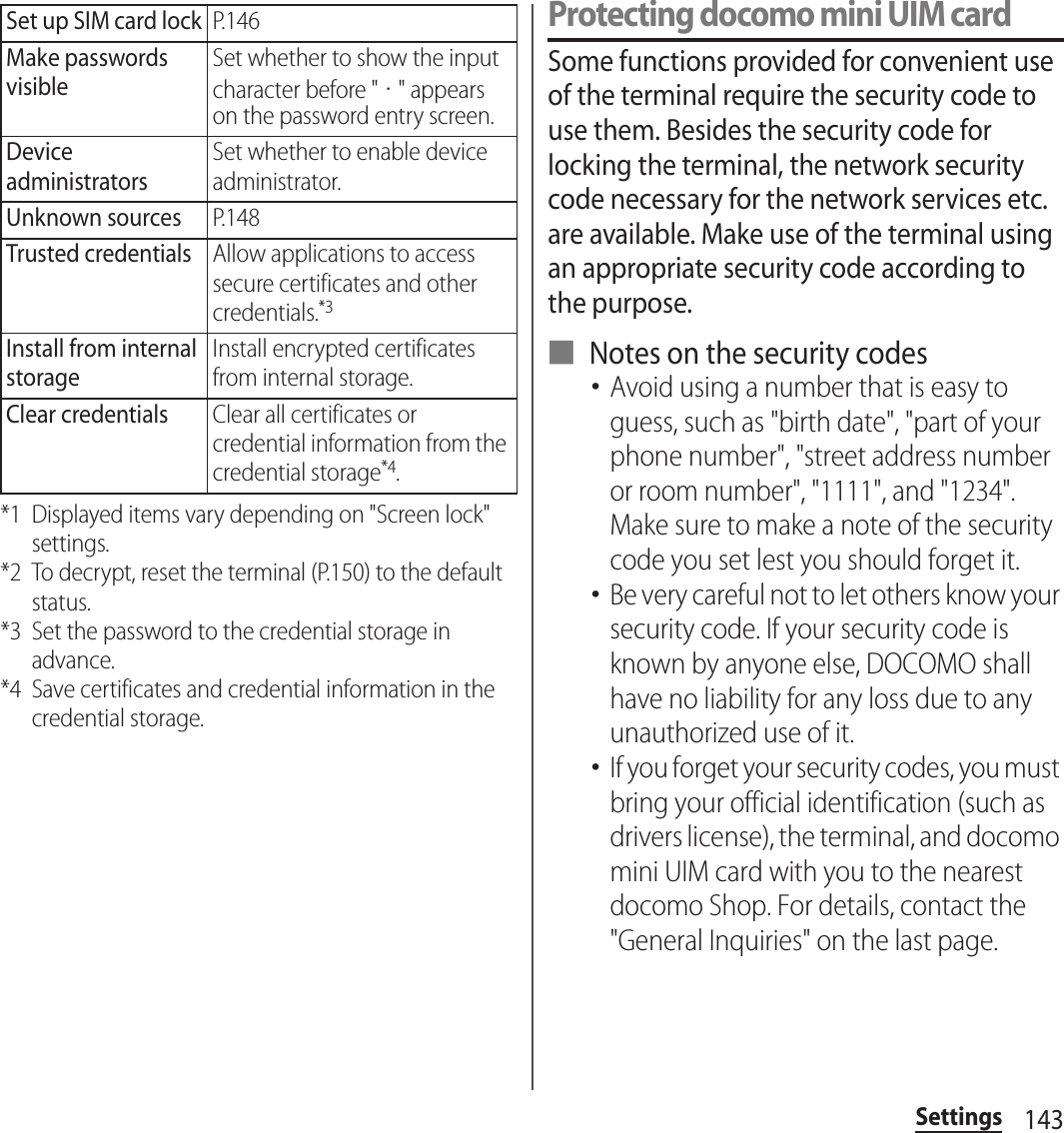
![144Settings・The PUK code is written on the subscription form (copy for customer) handed at the subscription in the docomo Shop. If you subscribed other than docomo Shop, you must bring your official identification (such as drivers license), the docomo mini UIM card with you to the nearest docomo Shop or contact the "General Inquiries" on the last page.Network security codeThe network security code is a 4-digit number necessary for identification or using the docomo Network Services at reception of your request in docomo Shop or at docomo Information Center. It can be set any number at the subscription and also changed later by yourself.You can change your network security code to new one using a PC if you have "docomo ID"/"Password" for "My docomo", the General support site for PC.Alternatively, from the Home screen, tap [dmenu] and [お客様サポートへ (To Customer Support)]u[各種お申込・お手続き (Subscription/Procedure)] to change the security code yourself.* For information on "My docomo" and "お客様サポート (Customer Support)", see the previous page of the last page.PIN codeYou can set security code which named PIN code to docomo mini UIM card. It is set "0000" at the subscription. They can be changed by yourself.PIN code is a 4- to 8-digit security number (code) that must be entered for user confirmation to prevent unauthorized use by a third party every time you insert the docomo mini UIM card into the terminal or when the terminal is powered on. Entering the PIN code enables making/receiving calls and terminal operation.・If you use a newly purchased terminal with docomo mini UIM card you have been using, use the PIN code set on the former terminal. If you did not change the setting, the code is "0000".・If you enter a wrong PIN code 3 times consecutively, the PIN code is locked and cannot be used anymore. In this case, unlock with "Personal Unblocking Key (PUK code)" (P.146).](https://usermanual.wiki/Sony/TM-0000.user-guide/User-Guide-1900871-Page-146.png)
![145SettingsPersonal Unblocking Key (PUK code)The PUK code is an 8-digit number for canceling the locked PIN code. The PUK code cannot be changed by yourself.・If you failed to enter PUK code 10 times consecutively, the docomo mini UIM card is locked. Please contact a docomo Shop.Enabling SIM card lockBy setting PIN (security code) and entering PIN code when powered on, you can protect the docomo mini UIM card from improper use.1From the Settings screen (P.118), tap [Security]u[Set up SIM card lock]u[Lock SIM card].2Enter PIN code and tap [OK].・"Lock SIM card" is marked.❖Information・You can unlock SIM card lock by the same operation.Entering the PIN code when powered on1On the PIN code entry screen, enter the PIN code.2Tap [OK].Changing the PIN code・You can change only when you activate the SIM card lock.1From the Settings screen (P.118), tap [Security]u[Set up SIM card lock]u[Change SIM PIN].2Enter the current PIN code and tap [OK].3Enter a new PIN code and tap [OK].4Enter a new PIN code again and tap [OK].Unlocking PIN lock1Tap [PUK code] field and enter PUK code.2Tap the [New PIN Code] field and enter a new PIN code and tap [OK].3Enter a new PIN code again and tap [OK].Screen lockYou can secure your data by requiring a screen unlock pattern every time the terminal is turned on or every time it is activated from sleep mode.There are 5 types of screen lock settings: "Slide/Touch", "Face Unlock", "Pattern", "PIN" and "Password" (P.147).](https://usermanual.wiki/Sony/TM-0000.user-guide/User-Guide-1900871-Page-147.png)
![146SettingsSetting screen unlock method1From the Settings screen (P.118), tap [Security]u[Screen lock].2Tap [Slide/Touch]/[Face Unlock]/[Pattern]/[PIN]/[Password].・When you tap [Face Unlock], follow the onscreen instructions to set face authentication. For unlocking when the Face Unlock cannot be unlocked, "Pattern" or "PIN" is required to select to set.・When you tap [Pattern], follow the onscreen instructions to enter unlock pattern.Set security question and answer in case you forget the pattern.・When you tap [PIN], follow the onscreen instructions to enter 4 - 16 digit numbers. This "PIN" code is different from a PIN code to be set to docomo mini UIM card (P.145).・When you tap [Password], follow the onscreen instructions to enter 4 - 16 digit characters including alphabets.Changing screen unlock method1From the Settings screen (P.118), tap [Security]u[Screen lock].2Enter the current unlock pattern/PIN/password.3Select a new unlock method.・For setting procedure, see Step 2 (P.147) of "Setting screen unlock method".Locking the screenOnce screen unlock method (P.147) is set, the screen is locked when the sleep mode is set or p is pressed.Unlocking the screen lock1Press p to turn the backlight on.2Enter unlock screen method.・Enter the set unlock method (Slide or Tap/Face unlock/unlock pattern/PIN/password).](https://usermanual.wiki/Sony/TM-0000.user-guide/User-Guide-1900871-Page-148.png)
![147SettingsIf you forget how to unlock■ If you set "Pattern""Incorrect pattern" appears when you enter incorrect unlock pattern 5 times consecutively.・Tap [Next], and answer the security question that you set for the unlock pattern setting, then tap [Unlock] to unlock the screen lock.・If you set Google account, on the "Incorrect pattern" screen, tap [Next] to display "Answer question" and "Enter Google account details".- Mark "Answer question" and tap [Next], and answer the security question, then tap [Unlock] to unlock the screen lock.- Mark "Enter Google account details", tap [Next], and enter Google account and password, then tap [Sign in] to unlock the screen lock.・When setting new unlock pattern after unlocking screen lock, "Screen unlocked" appears. Tap [Yes] to reset unlock pattern.❖Information・Tap [Try again] to retry entering pattern in 30 seconds.・When you tap [Try again]u[Forgot pattern?], the screen after tapping [Next] is displayed.・If you set multiple Google accounts, enter one of those accounts and password to unlock the screen.■ If you set "PIN"/"Password"Please contact a docomo Shop.Canceling screen lockYou can cancel screen lock pattern after you set.1From the Settings screen (P.118), tap [Security]u[Screen lock].2Enter the current unlock pattern/PIN/password.3Tap [None].Permitting downloading unknown source's applicationBefore you can download unknown source's applications, set the terminal to enable downloading.Applications you download may be of unknown origin. To protect your terminal and personal data, only download applications from trusted sources such as the Google Play etc.1From the Settings screen (P.118), tap [Security].2Tap [Unknown sources].3Read the notes and then tap [OK].・"Unknown sources" is marked.](https://usermanual.wiki/Sony/TM-0000.user-guide/User-Guide-1900871-Page-149.png)
![148SettingsYou can select language and input method.Changing phone language1From the Settings screen (P.118), tap [Language & input]u[Language].2Select a language and tap [Done].・When you select Japanese, "完了 (Done)" is displayed, but its display varies by the language you selected.❖Information・If you choose the wrong language and cannot read the menu texts, see the help of the following website.http://www.sonymobile.co.jp/so-03e/faq.html (In Japanese only) Setting Voice SearchText-to-speech settings* Japanese is not supported.Language & inputLanguageP.149Spelling correctionSet spelling correction.Personal dictionaryRegister words.DefaultSet input method.Google voice typingP.62Moji-HenshuXperia™ Chinese keyboardXperia™ Japanese keyboardXperia™ keyboardVoice SearchP.149Text-to-speech outputP.149Pointer speedSet pointer speed of mouse etc.LanguageSelect language used for Google voice search.SafeSearchSet filter explicit.Block offensive wordsSet whether to display recognized offensive voice results.Google Text-to-speech Engine*Set language for text-to speech and audio synthesis engine to read out text.Pico TTS*Make settings for installed voice synthesis engine.Speech rateSet speed at reading out text.Listen to an examplePlayback sample of audio synthesis.](https://usermanual.wiki/Sony/TM-0000.user-guide/User-Guide-1900871-Page-150.png)
![149SettingsSet backup of application etc. or restore the terminal to default by using Google account.Resetting the terminalResetting the terminal deletes all data, including downloaded applications and accounts, and resets the terminal back to the initial (default) state. Make sure to back up important data you have on the terminal before you reset the terminal.For the initial settings, see "Initial settings" (P.40).1From the Settings screen (P.118), tap [Backup & reset]u[Factory data reset]u[Reset phone].・Mark "Erase internal storage" to delete all contents (music, photos, videos, etc.) on the internal storage.・Enter your screen unlock method as required.2Tap [Erase everything].・The terminal restarts automatically.❖Information・While restarting or resetting the terminal, just wait. If you remove the battery pack while restarting or resetting the terminal, it may cause malfunction.Display Setup guide and make the terminal settings.・For details, see "Initial settings" (P.40).Backup & resetBack up my dataSet to backup applications, settings, data, etc. to Google server.Backup accountSet an account for backup to Google server.Automatic restoreSet to restore backup settings or data when re-installing application.Data transfer modeSet to the mode to transfer the data in the terminal using the docomo shop terminal.Factory data resetP.150Setup guide](https://usermanual.wiki/Sony/TM-0000.user-guide/User-Guide-1900871-Page-151.png)
![150SettingsYou can change the date and time in the terminal.To set date/time or time zone manually, unmark "Automatic date & time" or "Automatic time zone" to disable network-provided time/time zone in advance.❖Information・Correction of the time differences may not be performed correctly depending on the overseas telecommunication carrier. In that case, set time zone manually (P.151).Setting the date1From the Settings screen (P.118), tap [Date & time]u[Set date].2Drag number to adjust date.3Tap [Set].Setting the time1From the Settings screen (P.118), tap [Date & time]u[Set time].2Drag number to adjust hour and minute.・When you unmark "Use 24-hour format", drag "am"/"pm" to switch AM/PM.3Tap [Set].Setting the time zone1From the Settings screen (P.118), tap [Date & time]u[Select time zone].2Select time zone you want to set.SYSTEMDate & timeAutomatic date & timeAdjust date and time automatically by using network-provided information.Automatic time zoneAdjust time zone automatically by using network-provided information.Set dateP.151Set timeP.151Select time zoneP.151Use 24-hour formatP.152Select date formatP.152](https://usermanual.wiki/Sony/TM-0000.user-guide/User-Guide-1900871-Page-152.png)
![151SettingsSetting the time format1From the Settings screen (P.118), tap [Date & time] and mark/unmark "Use 24-hour format".・Mark the checkbox to shift to 24-hour format, and unmark to shift to 12-hour format.Setting the date format1From the Settings screen (P.118), tap [Date & time]u[Select date format].2Select date format you want to set.You can set user support service which sounds or vibrates according to users operation and call end operation.AccessibilityTalkBackSet user support service (TalkBack).Large textEnlarge text size.Power button ends callSet to end a call by pressing p.Auto-rotate screenP.46Speak passwordsOutput password by voice sound.Touch & hold delaySet response time for operation of touching and holding the screen.Install web scriptsSet whether to install script from Google.](https://usermanual.wiki/Sony/TM-0000.user-guide/User-Guide-1900871-Page-153.png)
![152SettingsPut the terminal into debug mode when connecting USB or set the screen backlight to ON while charging.Keeping the screen backlight ON while charging1From the Settings screen (P.118), tap [Developer options].2Mark "Stay awake".You can check your own phone number, signal level, legal information, etc.Developer optionsAbout phoneSoftware updateP.250StatusCheck your own phone number, signal level, battery level, etc.Legal informationCheck open source license or Google terms of use, etc.Model numberCheck version and number.Android versionBaseband versionKernel versionBuild number](https://usermanual.wiki/Sony/TM-0000.user-guide/User-Guide-1900871-Page-154.png)
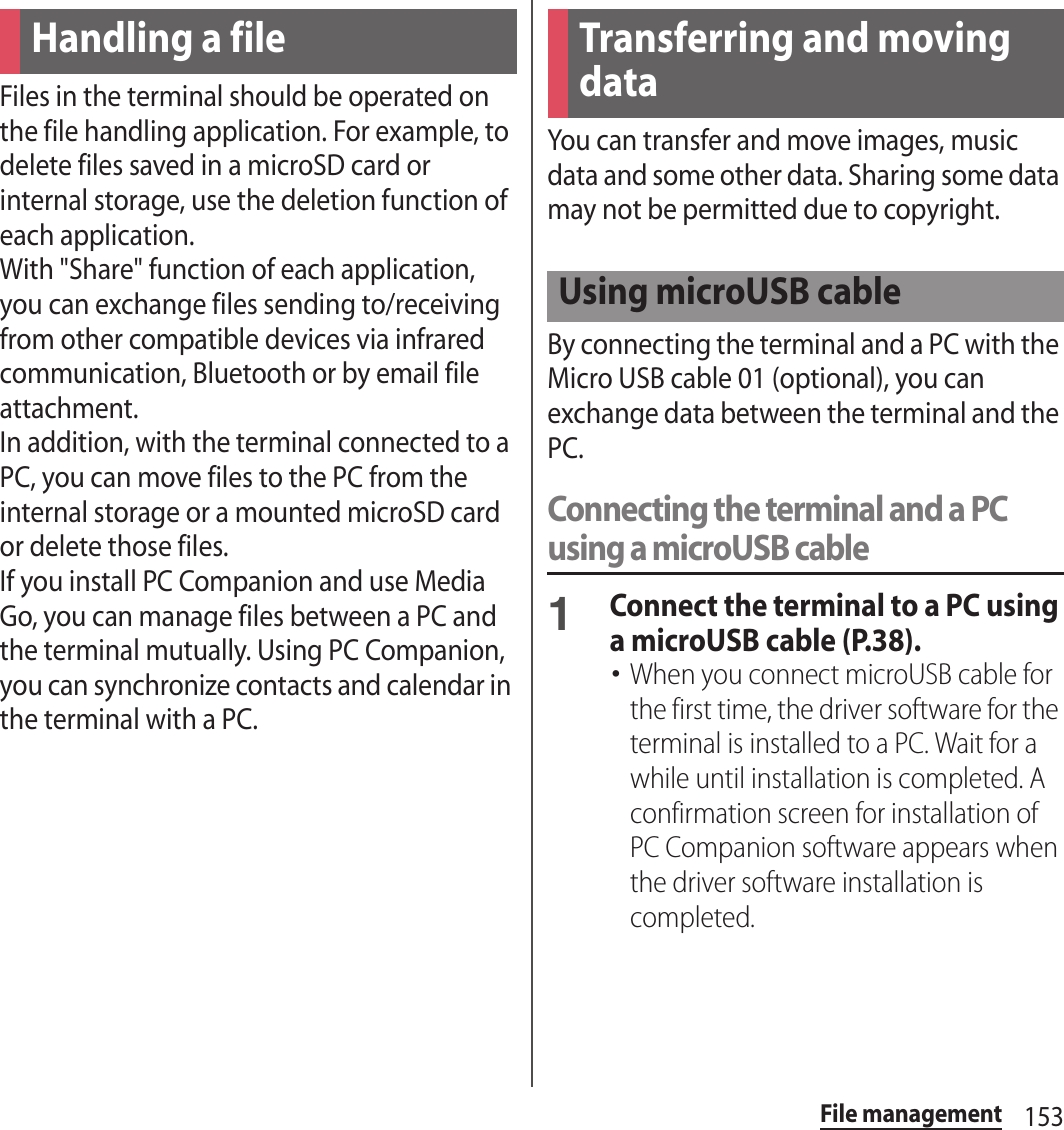
![154File management・The terminal is connected by "Media transfer mode (MTP)" which is set by default. Follow onscreen instructions on a PC to access Internal Storage and microSD Card of the terminal.2Tap [Skip].❖Information・Screen that appears when connecting to a PC may vary depending on the operating system (OS) of a PC.・From the Home screen, tap and tap [Settings]u[Xperia™]u [Connectivity] to check connection mode and change the settings as follows.・Connecting with "Mass storage mode (MSC)" also accesses microSD card as a removal disk. microSD card cannot be accessed from the terminal and functions using microSD card may become unavailable in Camera, Album, etc. while connecting to a PC.・If you install PC Companion by tapping [Install] in Step 2, you can use the following applications on a PC for managing media files, creating backup files, etc. when connecting the terminal and the PC. For details, check on the PC Companion screen after installation.・When the terminal is connected to a PC, charging starts automatically. For details, see "Charging with a PC" (P.38).Install PC CompanionDisplay PC Companion installation wizard when connected to a PC.USB connection modeSwitch USB connection mode to "Media transfer mode (MTP)"/"Mass storage mode (MSC)" when connecting to a PC.TRUSTED DEVICESConnect the terminal and a host device in a pair via Wi-Fi network (P.157).Support ZoneUpdate software of the terminal by connecting to a PC (P.252).Contacts SetupCopy the contacts data of the mobile phone previously used to the terminal.Media GoP.158ContactsSynchronize contacts between the terminal and Outlook/Lotus Notes/Google.CalendarSynchronize calendar between the terminal and Outlook/Lotus Notes/Google.Back up and restoreBack up the terminal data or move the data to another terminal.File ManagerCheck file type, update time, location, etc. on the terminal.](https://usermanual.wiki/Sony/TM-0000.user-guide/User-Guide-1900871-Page-156.png)
![155File managementDisconnecting the microUSB cable safely・Do not disconnect the microUSB cable during data transferring. Data may be damaged.・If you connect the terminal in the Media transfer mode (MTP), make sure that data transfer is not in progress and just disconnect the microUSB cable.■ Mass storage mode (MSC)1Drag the status bar downwards.2Tap [SD card connected].・"SD card disconnected" appears in the status bar.3Disconnect the microUSB cable.Dragging and dropping data on the terminal and a PC■ Media transfer mode (MTP)1Connect the terminal to a PC using a microUSB cable.・"Int. storage & SD card connected" appears in the status bar.2Drag and drop selected data between the terminal and a PC.■ Mass storage mode (MSC)1Connect the terminal to a PC using a microUSB cable.・"SD card connected" appears in the status bar.2Drag and drop selected data between the terminal and a PC.❖Information・You can transfer files using a microUSB cable on most devices and the following operating systems (OSs) that supports the USB mass-storage memory interface.- Microsoft Windows 7- Microsoft Windows Vista- Microsoft Windows XP](https://usermanual.wiki/Sony/TM-0000.user-guide/User-Guide-1900871-Page-157.png)
![156File managementIf the terminal and a PC* are connected in a pair on a Wi-Fi network, automatic connection/disconnection of internal storage of the terminal with a PC is enabled when the terminal user comes in and out of the Wi-Fi area. You can easily access to files in the internal storage of the terminal from a connected PC.* Use Microsoft Windows 7 to make a pair setting. Pair setting cannot be made under Microsoft Windows XP, Microsoft Windows Vista or other OS.1Connect a PC you want to set in a pair to a Wi-Fi network.2Connect the terminal to a Wi-Fi network (P.119).3Connect the terminal to a PC using a microUSB cable.・When a confirmation screen for installation of PC Companion software appears on the terminal, tap [Skip].4Make sure that the terminal is displayed as a portable device on "Computer" the screen of the PC.5Right click the portable device icon, then click "ネットワーク構成 (network composition)".6Click "次へ (Next)".7On the pop-up screen of the terminal, tap [Pair].8On the network composition of the portable device screen of the PC, click " 完了 (Done)".9Disconnect the microUSB cable.10From the Home screen, tap and tap [Settings]u[Xperia™]u[Connectivity]u"Host name" (PC name) in the "TRUSTED DEVICES" field.11Tap [Connect].・The terminal and the PC are connected in "Media transfer mode (MTP)" on a Wi-Fi network, and you can exchange data files.Connecting the terminal to a PC on a Wi-Fi network](https://usermanual.wiki/Sony/TM-0000.user-guide/User-Guide-1900871-Page-158.png)
![157File management❖Information・From the Home screen, tap and tap [Settings]u[Xperia™]u[Connectivity] to display "Host name" (PC name) in the "TRUSTED DEVICES" field. To cancel connection setting, tap the host name and [Forget]. Until "Forget" is tapped, the connection setting retains even if you connect/disconnect repeatedly by coming in and out of a Wi-Fi area.・If the privacy separator function for Wi-Fi network (access point) is enabled, pair setting cannot be made.The Media Go computer application helps you transfer and manage media content in the terminal and PC.With Media Go, you can load music from a CD to a PC and transfer to the terminal.・You can install Media Go from PC Companion. Activate PC Companion installed in a PC and install Media Go with "Sony PC Companion" screen. For information on how to install PC Companion, see "When PC Companion is not installed on your PC" (P.252).❖Information・You can also download Media Go from the following website.http://mediago.sony.com/enu/features ・To learn more about how to use the Media Go application, see the help section of the Media Go application.You can send/receive data of contacts, photos or videos taken by the camera to/from terminals etc. supporting infrared communication function.・The communication range for infrared communication is 20 cm or less. Keep the devices pointing at the infrared data port each other, and do not move them until data exchange completes.・If the infrared data port is soiled, clean the data port with a dry soft cloth to prevent from scratching. Performing infrared communication with the data port soiled or scratched may cause communication failure.・Infrared communication may not be performed in areas exposed to direct sunlight, directly under fluorescent lights or near infrared devices.・Depending on the terminal of the other party, it may be difficult to exchange data.Using Media GoUsing infrared communication](https://usermanual.wiki/Sony/TM-0000.user-guide/User-Guide-1900871-Page-159.png)
![158File management❖Information・Do not cover the infrared data port with the fingers, etc. while performing infrared communication.・Infrared communication for the terminal conforms to IrMC version 1.1. However, some data cannot be sent or received even if the receiver's phone conforms IrMC version 1.1.・Authentication password and docomo apps password may be required while sending or receiving infrared data. Authentication password is a 4-digit number fixed up between you and other party in advance. The same number string must be entered by the sender and receiver. For the docomo apps password, see "docomo apps password" (P.139).・If the terminal receives a call during infrared communication, data exchange is interrupted and the incoming call screen appears.・If the set alarm time comes during infrared communication, data exchange is interrupted and the alarm starts to sound.・ is displayed in the status bar during infrared communication.・You can send and receive Phonebook entries, My profile, name card, sp-mode mail, Schedule & memo, still images (.jpeg, .png, .gif, .bmp), videos (.mp4, .3gp) and ToruCa. It may take a time to exchange data depending on the data amount or device of other party.・Some data, such as data with copyright protection, etc., cannot be played back on other devices.・Received data cannot be played back or saved depending on the sender's device, data type or data amount.・Received images and videos are saved in the internal storage and other data is saved in Phone memory.Use the "Infrared" application to send all data of "Phonebook", "sp-mode mail" or "Schedule&Memo". You can also send data one by one or send a still image or a video using the sharing menu of applications such as "docomo phonebook", "Album".■ Sending with "Infrared" communication application1From the Home screen, tap , then tap [Infrared].2Tap [Send all].Sending data via infrared communication](https://usermanual.wiki/Sony/TM-0000.user-guide/User-Guide-1900871-Page-160.png)
![159File management3Tap [Phonebook]/[sp-mode mail]/[Schedule&Memo].・When you tap [sp-mode mail], select from "Inbox"/"Sent"/"Unsent".4Tap [Start].5Enter docomo apps password and tap [OK].6Enter the same authentication password as that of the recipient and tap [OK]u[OK]u[OK].■ Sending with sharing menu of function1Select "Infrared" from the sharing menu of each application.❖Information・My profile (excluding name card) can be sent using infrared communication widget. From the Home screen, tap of (infrared communication widget) and follow the onscreen instructions.・For instructions on sending from the "docomo phonebook" application, see "Sending phonebook entries via infrared communication" (P.98).・For sending from "Album", see "Sharing image files" (P.206).・You cannot send two or more items of My profile, name card, still image, video or ToruCa at a time.■ Receiving 1 item1From the Home screen, tap , then tap [Infrared].2Tap [Receive]u[OK].3When receiving is complete, tap [OK]u[OK].■ Receiving all items1From the Home screen, tap , then tap [Infrared].2Tap [Receive all].3Enter docomo apps password and tap [OK].4Enter the same authentication password as that of the sender and tap [OK]u[OK]u[OK]u[OK].❖Information・1 item of data can be received using infrared communication widget. From the Home screen, tap of (infrared communication widget) and follow the onscreen instructions.・When Phonebook, sp-mode mail and Schedule&Memo are received, data on the terminal is deleted before saved.・You cannot receive two or more videos at a time.Receiving data via infrared communication](https://usermanual.wiki/Sony/TM-0000.user-guide/User-Guide-1900871-Page-161.png)
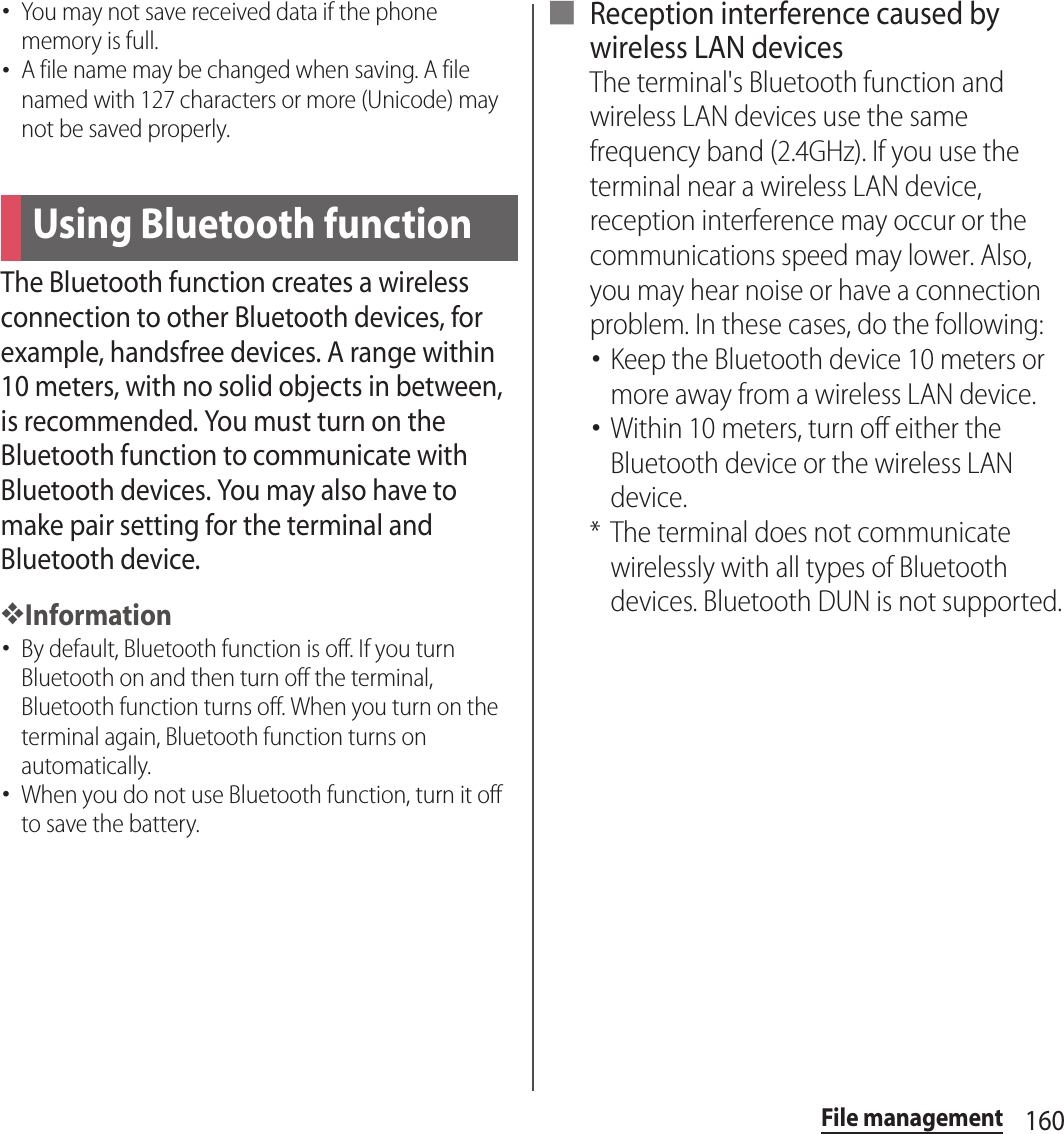
![161File management1From the Home screen, tap , then tap [Settings].2Tap in Bluetooth or drag it right.・ appears on the status bar and Bluetooth function turns on.3Tap [Bluetooth].4Tap [Xperia AX].・The terminal becomes detectable by other Bluetooth devices for 2 minutes.You can name the terminal. The name appears on Bluetooth devices when you use the Bluetooth function.1Make sure that the Bluetooth function is on.2From the Home screen, tap and tap [Settings]u[Bluetooth].3Tap and tap [Rename phone].4Enter a name and tap [Rename].By making pair setting for the terminal and another Bluetooth device, you can use the device such as Bluetooth handsfree headset etc. connecting to the terminal to make and receive calls.Once you have made pair setting for the terminal and a Bluetooth device, the setting is saved. When making pair setting for the terminal and a Bluetooth device, you may need to enter a passkey (PIN). The terminal automatically tries the generic passkey "0000". If this passkey does not work, see the documentation of your Bluetooth device. You do not need to re-enter the passkey the next time you connect to a paired Bluetooth device already set.You cannot pair the terminal with two Bluetooth headsets. However, you can pair the terminal with two or more Bluetooth devices of different profiles. The terminal supports the Bluetooth profiles of HFP, HSP, OPP, SPP, HID, A2DP, AVRCP, PBAP, PAN, HDP, PXP and DID.1Make sure that the Bluetooth function is on.Making the terminal detectable with the Bluetooth function onEntering the terminal nameMaking pair setting for the terminal and Bluetooth device](https://usermanual.wiki/Sony/TM-0000.user-guide/User-Guide-1900871-Page-163.png)
![162File management2From the Home screen, tap and tap [Settings]u[Bluetooth].3Tap [Search for devices].・A list of detected Bluetooth devices appears.4Tap a Bluetooth device name to pair with the terminal.5Check a passkey on the "Bluetooth pairing request" screen, then tap [Pair].・You can use the Bluetooth device that has been paired.・Some Bluetooth devices make connections continuously after making pair setting.・Authentication passcode may be required on the "Bluetooth pairing request" screen.❖Information・Make sure that the Bluetooth function and Bluetooth detection function of the target device are on.・When you make pair setting with the Bluetooth device supporting Secure Simple Pairing (SSP) function, a passkey appears on the screen. Check the passkey and make the pair setting.1Make sure that the Bluetooth function is on.2From the Home screen, tap and tap [Settings]u[Bluetooth].3Tap [Search for devices].・A list of detected Bluetooth devices appears.・Pair Bluetooth devices as required.4Tap the name of Bluetooth device you want to connect.・While connecting to a device, appears in the status bar and the connection status appears under the device name.❖Information・Tap on the name of connected Bluetooth device to check the status of that Bluetooth device or change the settings.Connecting the terminal with Bluetooth device](https://usermanual.wiki/Sony/TM-0000.user-guide/User-Guide-1900871-Page-164.png)
![163File management1From the Home screen, tap and tap [Settings]u[Bluetooth].2Tap the connected Bluetooth device name.3Tap [OK].・To reconnect, tap the device name.1From the Home screen, tap and tap [Settings]u[Bluetooth].2Tap in a Bluetooth device name to unpair and tap [Unpair].・Connection disconnects and the pair setting is canceled.Turn the Bluetooth function on before pairing with the other party's Bluetooth device.Receiving data via Bluetooth function1Send data from a Bluetooth device.・ appears on the status bar.2Drag the status bar downwards and tap [Bluetooth share: Incoming file]u[Accept].Sending data via Bluetooth function1Select "Bluetooth" from the sharing menu of each application.2Tap the other party's Bluetooth device.・When sending is complete, a message indicating that the data is sent appears.❖Information・For instructions on sending from the "docomo phonebook" application, see "Sending phonebook via Bluetooth/Email/Gmail" (P.99).・For instructions on sending from "Album", see "Sharing image files" (P.206).Deactivating the connection of a Bluetooth deviceCanceling the pair setting of a Bluetooth deviceSending/receiving data using Bluetooth function](https://usermanual.wiki/Sony/TM-0000.user-guide/User-Guide-1900871-Page-165.png)
![164File managementUsing Wi-Fi function, you can share media files with other client (DLNA : Digital Living Network Alliance) devices.Set Wi-Fi connection (P.119) with another client device.1From the Home screen, tap , then tap [Settings]u[More...].2Tap [Media server settings].・Media server settings screen appears. You can set the following items.❖Information・On the Media server settings screen, tap and [Wi-Fi settings] to set Wi-Fi connection.Set Wi-Fi connection with a DLNA device to allow access from the terminal in advance.1On the Media server settings screen, tap of "Share content" or drag it right.・"Media server turned on" appears in the status bar.2Tap y.・A home screen appears.3From the Home screen, tap , then tap [Album]/[Movies].4Tap [Online]/[Devices].5Select a device name to connect, and select a folder.6Tap a media file to play it.Sharing files with DLNA devicesSetting Media serverSO-03EChange server nameRename the terminal (server) displayed on a client device.Share contentSet to connect from a client device to the terminal via Wi-Fi.PENDING DEVICESManage client devices waiting access permissions.REGISTERED DEVICESManage client device registered to the terminal.Playing media files in the DLNA device with the terminal](https://usermanual.wiki/Sony/TM-0000.user-guide/User-Guide-1900871-Page-166.png)
![165File managementConnect the terminal to a DLNA device via Wi-Fi in advance.1On the Media server settings screen, tap of "Share content" or drag it right.・"Media server turned on" appears in the status bar.2Tap y.・A home screen appears.3From the Home screen, tap , then tap [Album]/[Movies].4Tap a tile you want to play.5Tap and [Throw].・"Throw" screen appears.6Tap a device displayed on the "Throw" screen.・The file is played by a DLNA device.Playing a media file in the terminal with a DLNA device](https://usermanual.wiki/Sony/TM-0000.user-guide/User-Guide-1900871-Page-167.png)
![166ApplicationsApplicationsIn dmenu, you can easily access sites recommended by DOCOMO or convenient applications.1From the Home screen, tap [dmenu].・Browser activates to display "dmenu".❖Information・To use dmenu, Internet connection by packet communication (LTE/3G/GPRS) or Wi-Fi is required.・For connecting dmenu and downloading applications introduced in dmenu, packet communication charge is applied separately. Some applications automatically perform packet communications.・Applications introduced by dmenu may include charged ones.You can obtain useful and interesting contents which meet your needs at dmarket.1From the Home screen, tap [dmarket].・When you activate for the first time, "dマーケットソフトウェア使用許諾契約書 (License Agreement)" appears. Mark "Agree" checkbox and tap [Start use].❖Information・For details on dmarket, refer to NTT DOCOMO website.dmenuOpening dmenudmarketOpening dmarket](https://usermanual.wiki/Sony/TM-0000.user-guide/User-Guide-1900871-Page-168.png)
![167ApplicationsWith Google Play, you can directly access useful applications or fun games which you can download and install on the terminal. And you can send feedback and comments about an application, or report objectionable application or incompatible application with the terminal as an inappropriate content.・To use Google Play, you need to set Google account (P.139).・Some applications and games are free of charge, and the others are paid. On the applications list of Google Play, distinction between free and paid is clearly specified. For details on purchasing, returning and refunding of paid applications, see "Help" (P.169).1From the Home screen, tap [Play Store].・When you activate for the first time, Agreement screen for the terms of service appears. Tap [Accept] to start using.2Search application and tap application you want to install.・Check the displayed contents carefully and follow the onscreen instructions.・Be careful especially about applications which access many functions or large amount of data. If you perform download operation, you are responsible for the consequences of using this application on the terminal.❖Information・Be sure to check the security of application, then install it at your own risk. The terminal may be infected with a virus and the data may be damaged.・NTT DOCOMO is not liable for malfunctions, if any, caused by the application you installed. In such case, the repair is charged even during the warranty period.・NTT DOCOMO is not liable for any disadvantage brought to you or any third party due to an application you installed.・Some applications automatically perform packet communications. Packet communication is kept active unless you disconnect it or the time-out is occurred. To disconnect packet communications manually, drag the status bar downward, tap .・Some applications may be updated automatically.Play StoreInstalling applications](https://usermanual.wiki/Sony/TM-0000.user-guide/User-Guide-1900871-Page-169.png)
![168Applications1From the Home screen, tap [Play Store].2Tap and [My Apps].3Tap the applications you want to delete, then tap [Uninstall]u[OK].・When you uninstall charged applications, a screen for refund may appear. For details, refer to "Help" (P.169).When you need help or have any questions about Google Play, display the Google Play screen, then tap and tap [Help] to open Google Play help page.This function allows you to use "おサイフケータイ対応サービス (Osaifu-Keitai compatible service)" by which you can pay money or use coupon, etc. or "かざしてリンク対応サービス (Kazashite-Link compatible service)" by which you can access information by holding the terminal over a home electric appliances or smart poster.Electronic money or point values can be saved in the IC card or the docomo mini UIM card.You can check credit, payment or points of electronic money by using the network. In addition, you can lock your Osaifu-Keitai to provide against loss or theft, and you can use Osaifu-Keitai with safe.For details on Osaifu-Keitai, refer to "ご利用ガイドブック (spモード編) (Mobile Phone User's Guide [sp-mode]) (in Japanese only)".Deleting applicationHelpOsaifu-Keitai](https://usermanual.wiki/Sony/TM-0000.user-guide/User-Guide-1900871-Page-170.png)
![169ApplicationsiC transfer serviceThe iC transfer service is a service which helps you transfer all data in the IC card for Osaifu-Keitai to your new Osaifu-Keitai when you change Osaifu-Keitai for changing of the model or repair. Data in the docomo mini UIM card remains the same after using the iC transfer service.Visit a sales outlet such as docomo Shop to use the iC transfer service.For details on iC transfer service, refer to "ご利用ガイドブック (spモード編) (Mobile Phone User's Guide [sp-mode]) (in Japanese only)".Precautions on using the Osaifu-Keitai compatible terminal・The data in the IC card*1 or the docomo mini UIM card*2 may be lost or modified because of the malfunction of the terminal (When we take your terminal for repair etc., as we cannot take it with data remained, you are required to erase the data by yourself). For support such as reissuance, restoration, temporary preservation or transfer of data, contact Osaifu-Keitai compatible service providers. For important data, be sure to use a service with backup service.・If the data in the IC card or the docomo mini UIM card is lost, modified or damaged by any means related to Osaifu-Keitai compatible service such as malfunction or model change, DOCOMO assumes no responsibility for the loss of data.・If the terminal is stolen or misplaced, immediately contact Osaifu-Keitai compatible service provider for an advice.・If you use a docomo mini UIM card (red), you cannot use some Osaifu-Keitai compatible services such as international use. Bring it to a docomo Shop to replace in February, 2013 (scheduled) or later.For using, software update related to Osaifu-Keitai (product update of the terminal) is required. For details on software update, see "Updating software" (P.250).You can use "Osaifu-Keitai compatible services" and "Kazashite-Link compatible service", which can be saved in the IC card.*1 Data saved in the IC card built in the Osaifu-Keitai compatible terminal (including electronic money or point values)*2 Data saved in the docomo mini UIM card (including electronic money or point values, and excluding phonebook data and SMS data)](https://usermanual.wiki/Sony/TM-0000.user-guide/User-Guide-1900871-Page-171.png)
![170Applications1From the Home screen, tap then tap [Osaifu-Keitai].2Select a service you want to use from a service list.・Download an application compatible with service site or service.・You can exchange data with an IC card reader only by holding mark over the card reader.❖Information・If you do not make the initial setting for Osaifu-Keitai in the initial setting for DOCOMO services (P.40), the initial setting screen appears in Step 1. Follow the onscreen instructions.・You can scan and write data to or from an IC card reader without activating Osaifu-Keitai compatible application.・The function is available even if the terminal is off, but it is not available when the battery pack is not attached. Even if the battery pack is attached, the function may not be available when you leave the terminal off for a long time or the battery level is low, etc.・You can use Osaifu-Keitai compatible service even when the PIN code cannot be unlocked or PIN locked.・Note that when you do not subscribe sp-mode, some functions of Osaifu-Keitai compatible service may not be available.1From the Home screen, tap , then tap [Settings]u[More...].2[NFC/Osaifu-Keitai settings]u[Reader/Writer, P2P]u[OK].・"Reader/Writer, P2P" and "Android Beam" are marked.・Reader/Writer, P2P function is enabled, and appears in the status bar.3Hold the mark over a device with the NFC module or a smart poster.One-touch function is an original function developed by Sony based on NFC technology. You can send/receive data to/from a device with NFC such as a mobile phone. If you use the one-touch function with a Sony product with NFC, simple operations allow you to send or receive images, music, photos or videos taken with the terminal.Using "おサイフケータイ対応サービス (Osaifu-Keitai compatible service)"Using "かざしてリンク対応サービス (Kazashite-Link compatible service)"Sending/Receiving data by one-touch function](https://usermanual.wiki/Sony/TM-0000.user-guide/User-Guide-1900871-Page-172.png)
![171Applications・Set Reader/Writer, P2P function ON in advance (P.172).・Place 2 mobile phones in parallel position and point marks to each other. Do not move them until sending/receiving is complete.・Available operations to send/receive or available data to send/receive depends on the compatible applications. Follow the onscreen instructions.・Even if marks are pointed to each other, sending/receiving may be failed. If failed, perform operations of sending/receiving again.・When pointing marks to each other slowly, sending/receiving may be failed.・The terminal does not communicate with all NFC devices.Set Reader/Writer, P2P function to ON1From the Home screen, tap , then tap [Settings]u[More...].2[NFC/Osaifu-Keitai settings]u[Reader/Writer, P2P]u[OK].・"Reader/Writer, P2P" and "Android Beam" are marked.・Reader/Writer, P2P function is enabled, and appears in the status bar.❖Information・Alternatively, from the Home screen, use "NFC Quick Launch" to enable/disable Reader/Writer, P2P function.Sending data1Make sure that the Reader/Writer, P2P function is on.2Display data to send on the screen.3Face the marks each other with the receiving terminal.・The displayed screen becomes small, and "Touch to beam" appears.4Tap the screen that has become small.](https://usermanual.wiki/Sony/TM-0000.user-guide/User-Guide-1900871-Page-173.png)
![172ApplicationsReceiving data1Make sure that the Reader/Writer, P2P function is on.2Face the marks each other with the sending terminal.・When data is received, an application that supports the data opens. Follow the onscreen instructions.・When holding mark over the other device, make sure not to hit the terminal strongly.・Hold the mark over parallel to the center of the other device.・When holding mark over the other device, move it closer slowly.・If mark is not recognized even when holding over the device, try lifting the terminal slightly, or moving the terminal back, forth and around.・If there are metal objects between mark and the other device, scanning may be failed. And note that a sticker put on nearby the mark may affect communication performance.Use "NFC/Osaifu-Keitai lock" settings to restrict the use of Osaifu-Keitai function and related services.・NFC/Osaifu-Keitai lock is different from screen lock for the terminal, SIM card lock.1From the Home screen, tap , then tap [Settings]u[More...].2Tap [NFC/Osaifu-Keitai settings]u[NFC/Osaifu-Keitai lock].3Enter a password, then tap [Next].・Osaifu-Keitai function is locked, and or is displayed in the status bar.・When using "NFC/Osaifu-Keitai lock" for the first time, set password, secret question and answer. Follow the onscreen instructions.Notes on holding the mark over the other device such as a reader or device with the NFC moduleLocking Osaifu-Keitai function](https://usermanual.wiki/Sony/TM-0000.user-guide/User-Guide-1900871-Page-174.png)
![173Applications❖Information・Note that you cannot cancel "NFC/Osaifu-Keitai lock", if the battery runs out while "NFC/Osaifu-Keitai lock" is set. Be careful about remaining battery level. If you cancel "NFC/Osaifu-Keitai lock", charge the terminal before canceling.・You need to unlock to use Osaifu-Keitai menu while "NFC/Osaifu-Keitai lock" is set.・"NFC/Osaifu-Keitai lock" password is not be deleted even if you reset the terminal.・If you forget the password for "NFC/Osaifu-Keitai lock", tap in the "NFC/Osaifu-Keitai settings" screen and tap [Forget password?], then answer the secret question that you set when setting the password. Note that you cannot cancel "NFC/Osaifu-Keitai lock" if you forget both the password and secret question.・When unlocking "NFC/Osaifu-Keitai lock", insert the same docomo mini UIM card as the one inserted when "NFC/Osaifu-Keitai lock" was set, then unlock."iD" is a convenient electronic money by credit clearance scheme. You can enjoy shopping simply and conveniently only by holding Osaifu-Keitai with credit information set or the iD-compatible card over the IC card reader in stores. Because up to 2 types of credit information can be registered in Osaifu-Keitai, you can use them according to the benefits, etc. It also supports cashing, depending on the card issuer.・To use iD with Osaifu-Keitai, subscribing to a card issuer that supports iD, settings for iD application are required.・The charges required for iD service (including the annual charge) vary by card issuer.・For using the application, a packet communication charge is applied.・A packet communication fee for oversea use differs from the one in Japan.・For details on iD, refer to iD website.http://id-credit.com/ (In Japanese only)ToruCa is an electronic card that can be obtained to mobile phones. It can be obtained from the IC card reader or site as store information, coupon ticket, etc. Obtained ToruCa is saved to the "ToruCa" application. Use the "ToruCa" application to display, search or update.For details on ToruCa, refer to "ご利用ガイドブック (spモード編) (Mobile Phone User's Guide [sp-mode]) (in Japanese only)".❖Information・For obtaining, displaying or updating ToruCa, a packet communication charge may be applied.・Some ToruCa provided to i-mode terminal may not be obtained/displayed/updated.iDアプリ (iD application)ToruCa](https://usermanual.wiki/Sony/TM-0000.user-guide/User-Guide-1900871-Page-175.png)
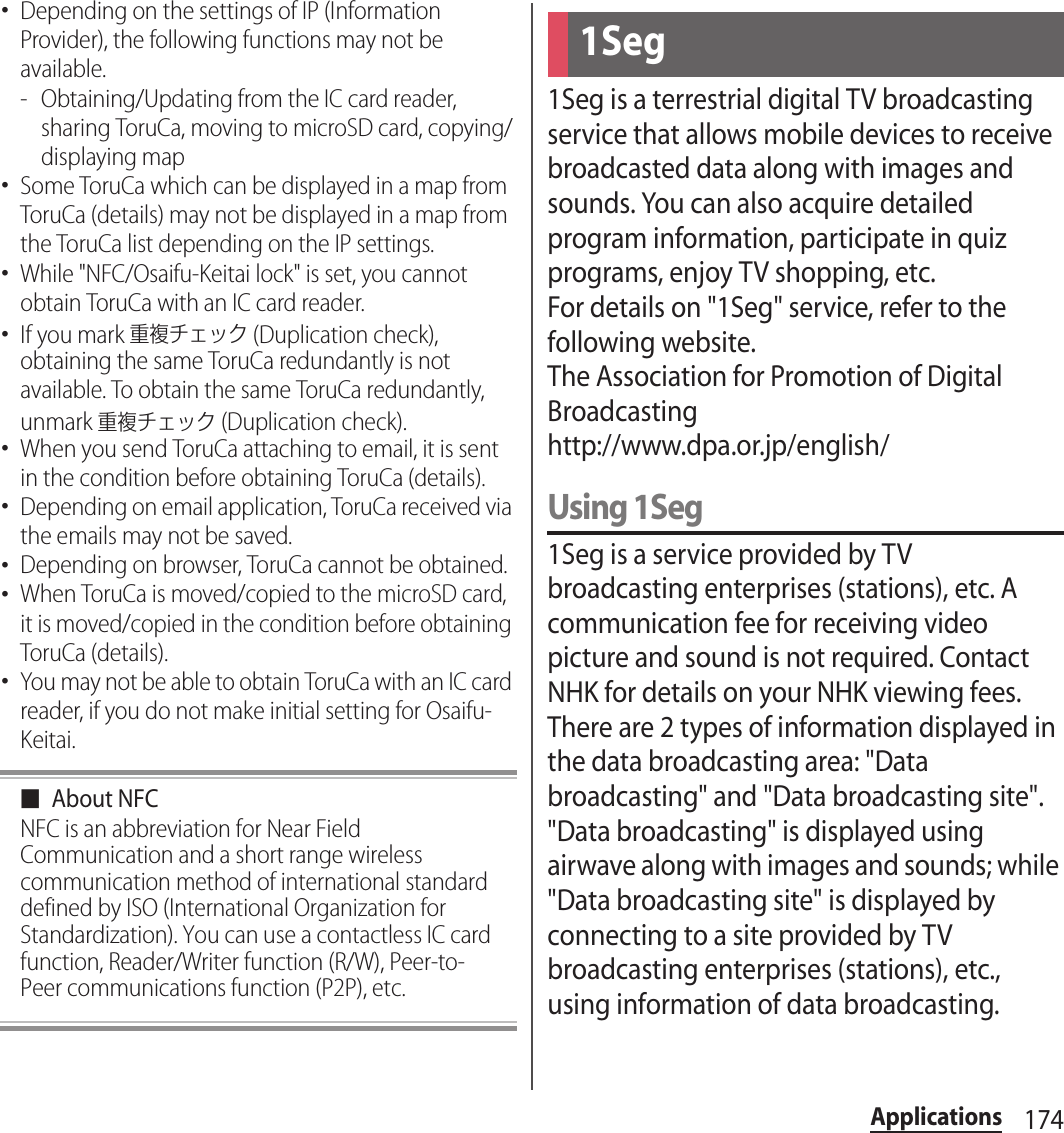
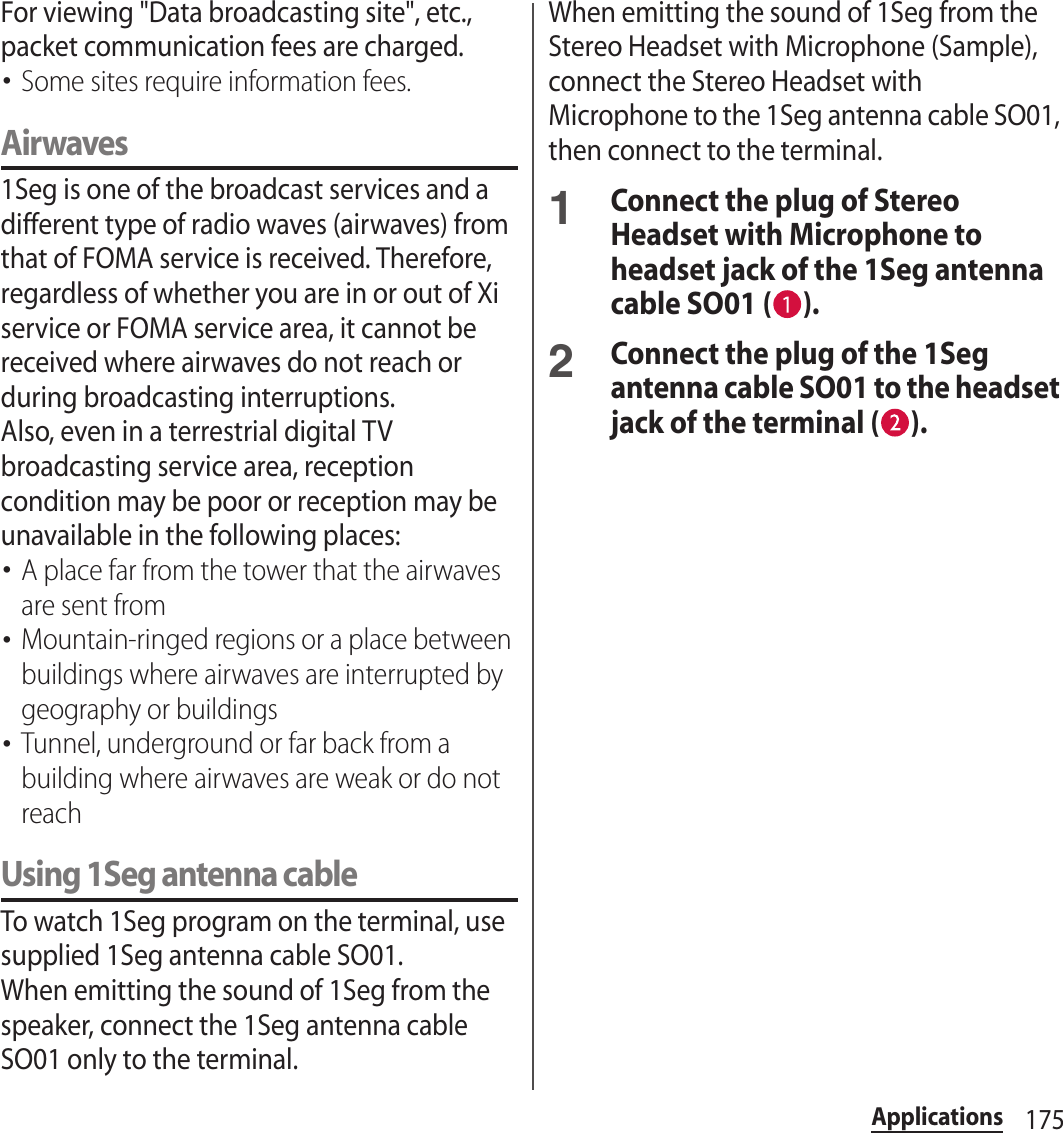
![176Applications❖Information・While emitting the sound of 1Seg with the 1Seg antenna cable SO01 connected alone, connecting the Stereo Headset with Microphone does not switch the sound output to the Stereo Headset with Microphone. To emit sound with the Stereo Headset with Microphone, remove the 1Seg antenna cable SO01 once and connect the Stereo Headset with Microphone to the 1Seg antenna cable SO01, then connect to the terminal.・While emitting the sound of 1Seg with the Stereo Headset with Microphone and the 1Seg antenna cable SO01 connected, removing the Stereo Headset with Microphone from the 1Seg antenna cable SO01 does not switch the sound output to the speaker. To hear sound via speaker, remove the 1Seg antenna cable SO01 then connect the 1Seg antenna cable SO01 alone to the terminal.Make channel setting when you use 1Seg for the first time. After channel setting is done, 1Seg programs can be watched.1From the Home screen, tap and tap [1Seg].2Tap [Watch].・If [More] is tapped, Operation guide appears.3Tap [Setting]u[Channel setting].4Tap [Current area].・Available channels are searched.5Tap entry box, enter a title name and tap [OK].・To return the 1Seg menu, tap x.❖Information・Alternatively, tap [Select area] in Step 4 then select area to make channel setting.Initial settings for 1Seg](https://usermanual.wiki/Sony/TM-0000.user-guide/User-Guide-1900871-Page-178.png)
![177Applications1From the Home screen, tap and tap [1Seg].2Tap [Watch].・1Seg watching screen appears. Tap the image to temporarily view program information such as program name.■ 1Seg screenaProgram informationbImagecData broadcasting : Display data broadcasting content.dBroadcasting stationeRemote controller : Display numeric keys to switch channels and keys for searching stations.fProgram guide : Display program guide.gView optional menuhSubtitleiRemote controller for data broadcasting : Display operation keys for data broadcasting such as Move focus, Select focus, Back, Show numeric keys, etc.j1Seg status bar : Display icons for off timer, channel, reception level, subtitle, muting, volume, etc.❖Information・While watching 1Seg, press m to adjust volume.・You can watch 1Seg turning the terminal sideways. If the screen orientation does not change automatically when you turn the terminal sideways, drag the status bar downward and tap .・For data broadcasting, screen display supports portrait only.・Flick the 1Seg watching screen left and right to select the previous or next channel you are currently watching.・You cannot exit 1Seg even if you tap y to return to the Home screen. If 1Seg remains activated, the battery may be consumed quickly. To exit 1Seg, tap x while watching 1Seg.・It may take a time to acquire image data or broadcasted data when you activate 1Seg or change channels due to characteristic of digital broadcasting.・According to the airwave condition, image or sound may be interrupted or stopped.Watching 1Seg program1Seg watching screen (with data broadcasting)ijhdabcfeg1Seg watching screen (full screen)jabhedfg](https://usermanual.wiki/Sony/TM-0000.user-guide/User-Guide-1900871-Page-179.png)
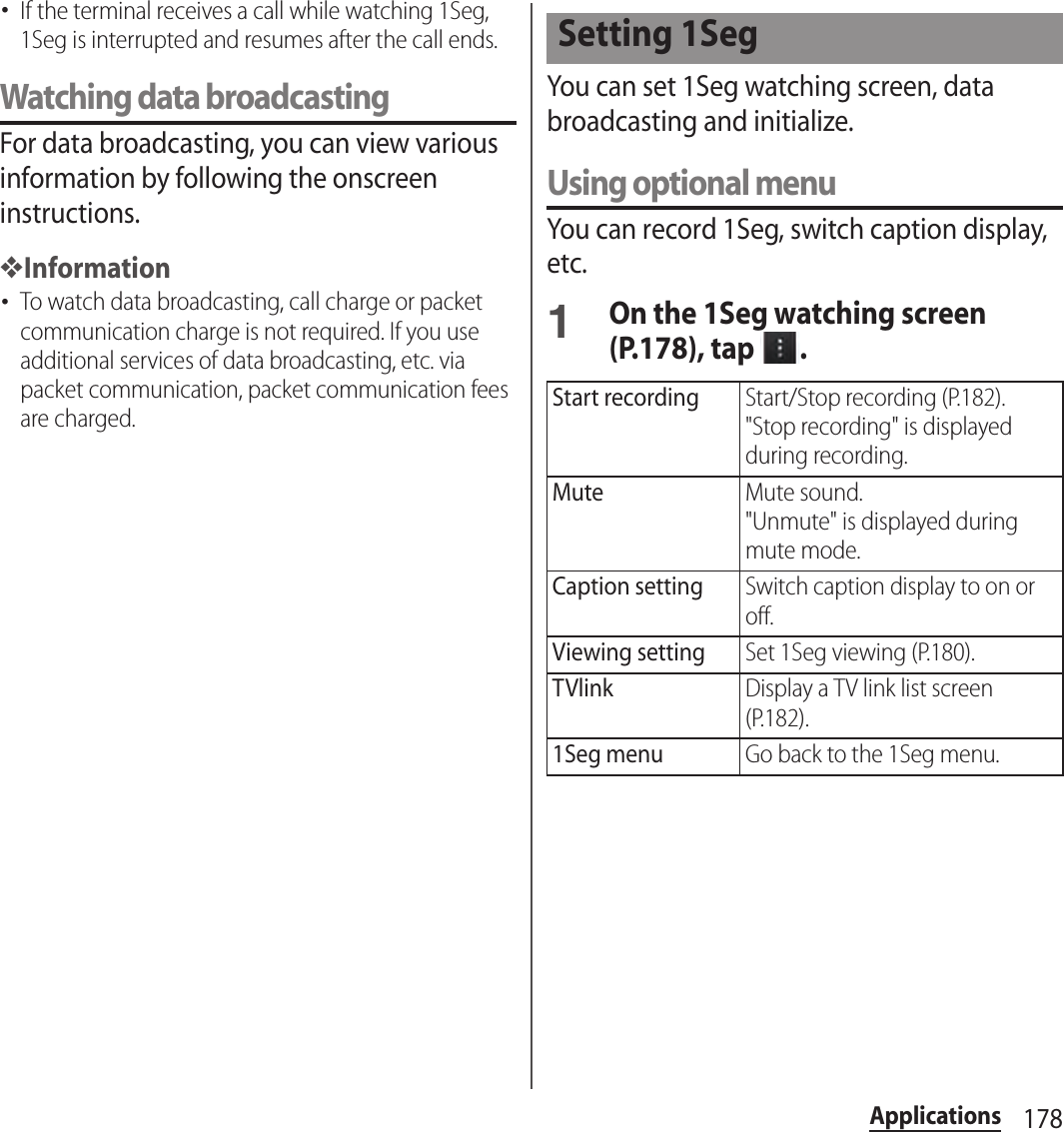
![179ApplicationsSetting 1Seg viewing1On the 1Seg watching screen (P.178), tap then tap [Viewing setting].Storing/Changing broadcasting service areasAvailable channels vary depending on the area (broadcasting service area) you are using in.■ Storing broadcasting service areas1From the Home screen, tap and tap [1Seg].2Tap [Setting]u[Channel setting].3Tap [Current area].・Available channels are searched.4Tap entry box, enter a title name and tap [OK].❖Information・Alternatively, tap [Select area] in Step 3 then select area to make channel setting.■ Changing broadcasting service areas1From the Home screen, tap and tap [1Seg].2Tap [Setting]u[Channel list] to select a registered channel list.・Broadcasting service area is changed.❖Information・On the channel list screen, touch and hold registered area etc. to display a menu so that you can display channel information, set channels, edit titles, etc.Channel infoDisplay information for available channels.Program infoDisplay information for received programs.Channel listRegistered areas (broadcasting service area) are listed as a channel list.Add to channel listAdd a channel from 1Seg watching screen.ReservationReserve viewing or recording or display reservation results.Switch displaySwitch display between Video+DataBC and Data broadcasting.Off timerMake a timer setting to end 1Seg watching.Main/sub soundSet main/sub sound.Sound switchSet to switch sound.Volume settingAdjust the volume level.Sound effect settingSwitch sound effect of data broadcasting between on and off.Back to data BCDisplay data broadcasting.Tune serviceYou can select a sub-channel when several programs (services) are broadcasted for separated sub-channels in a channel.](https://usermanual.wiki/Sony/TM-0000.user-guide/User-Guide-1900871-Page-181.png)
![180ApplicationsChanging numbers for TV remoteChange TV remote number assigned to each broadcasting station. Each broadcasting station can be called up via the corresponding TV remote number.1From the Home screen, tap and tap [1Seg].2Tap [Setting]u[Channel list] and tap a channel list to change.3Touch and hold channel information.4Tap [Remote control No.] and tap a broadcasting station to change.5Tap a remote control number to set the selected broadcasting station for.・If you select a remote control number set for another broadcasting station, the previously set broadcasting station is switched to the broadcasting station that is set in Step 4.6Tap x and [YES].Initializing settingsYou can initialize the channel setting and 1Seg setting.1From the Home screen, tap and tap [1Seg].2Tap [Setting]u[Reset] to select an item to initialize.3Tap [YES].For some data broadcasting programs, link information to related websites (TVlink) is displayed. Save TVlinks to connect to related websites later.Saving TVlinks1On the 1Seg watching screen (with data broadcasting) (P.178), select TVlink to store.・After this step, follow the onscreen instructions.Using TVlinks](https://usermanual.wiki/Sony/TM-0000.user-guide/User-Guide-1900871-Page-182.png)
![181ApplicationsDisplay TVlinks1On the 1Seg watching screen (P.178), tap .2Tap [TVlink].・A TV link list screen appears.3Select a TVlink.・When selecting a link content or HTML content, tap [Yes].❖Information・Some TVlinks have period of validity. Out of date TVlinks are no longer available.Viewing/Deleting details of TVlink1On the 1Seg watching screen (P.178), tap .2Tap [TVlink] and tap .❖Information・On the TVlink list screen, touch and hold a TVlink to display menus for displaying detailed information, etc.Reserve recording/viewing TV program.1From the Home screen, tap and tap [1Seg].2Tap [Reservation]u"Recording" tab/"Watching" tab.3Tap and [New].4Tap [Channel name] to select a channel.5Set Program name, Start date/time, etc. and tap [Done].・When setting Recording reservation, set End time.Record images, sound, captions or data broadcasting while displaying.1On the 1Seg watching screen (P.178), tap then tap [Start recording].2On the 1Seg watching screen (P.178), tap then tap [Stop recording]u[YES].Check the number of registrationCheck the number of stored TVlinks.Delete allDelete all stored TVlinks.Delete selectedDelete several stored TVlinks.Mark a TVlink to delete and tap , tap [Delete data?]u[YES].Reservation of recording/viewing TV programRecording 1Seg](https://usermanual.wiki/Sony/TM-0000.user-guide/User-Guide-1900871-Page-183.png)
![182Applications❖Information・Maximum recorded data file size is 4GB, and maximum continuous recordable time is approximately 24 hours.Items can be saved up to 99.・When you use the microSD card from another application during recording, recording may be failed.Play a recorded program.1From the Home screen, tap and tap [1Seg].2Tap [Recording data] and a program to play.1From the Home screen, tap and tap [1Seg].2Tap [Program guide].・After this step, follow the onscreen instructions.You can listen to the FM radio with the terminal. Tuning can be made automatically or manually, and you can register your favorite channels to Favorites. To use FM radio, use a handsfree device such as Stereo Headset with Microphone (Sample), etc. or a headphone. They work as antenna.1Connect Stereo Headset with Microphone to the terminal.・For connection of Stereo Headset with Microphone, see "Using Stereo Headset with Microphone" (P.204).2From the Home screen, tap , then tap [FM radio].・FM radio screen appears and selecting channel starts automatically. The search ends when radio waves are received.3Tap / to select channel.・You can select channel by flicking the screen left and right.4Tap , then tap [+ Add XX.X to favorites].Using program guideFM radioSearching and registering channels](https://usermanual.wiki/Sony/TM-0000.user-guide/User-Guide-1900871-Page-184.png)
![183Applications5Tap entry box, enter a name and tap [Save].・The frequency bands of selected channels are registered to Favorites.6To stop the FM radio, tap .❖Information・Alternatively, on the FM radio screen, tap and [Search for channels] to search.・You can return to the Home screen to perform another operation while listening to FM radio in the background. To return to the FM radio screen, from the Home screen, tap then tap [FM radio], or drag the status bar downward and tap [FM radio].・When the docomo mini UIM card is not inserted, the frequency band range is 87.5MHz - 108.0MHz. You cannot listen to the FM radio programs in Japan.・While FM radio is on, "Recorder" of small apps (P.83) is not available.■ FM radio screenaMonaural/stereo effect bPlay in speaker/Play in handsfreecChannel point displayed in a good radio wave conditiondOn/Off of FM radioeView optional menufBroadcasting station now listeninggChannel assigned to favoritehSearch channels automaticallyiMove left to select next favoritejFavorites saving/editing/tuningkMove right to select next favorite1On the FM radio screen, tap .2Tap [Play in speaker]/[Play in headphones].・The sound output is switched to the speaker/handsfree device.cefkjighabdSwitching the speaker and handsfree device](https://usermanual.wiki/Sony/TM-0000.user-guide/User-Guide-1900871-Page-185.png)
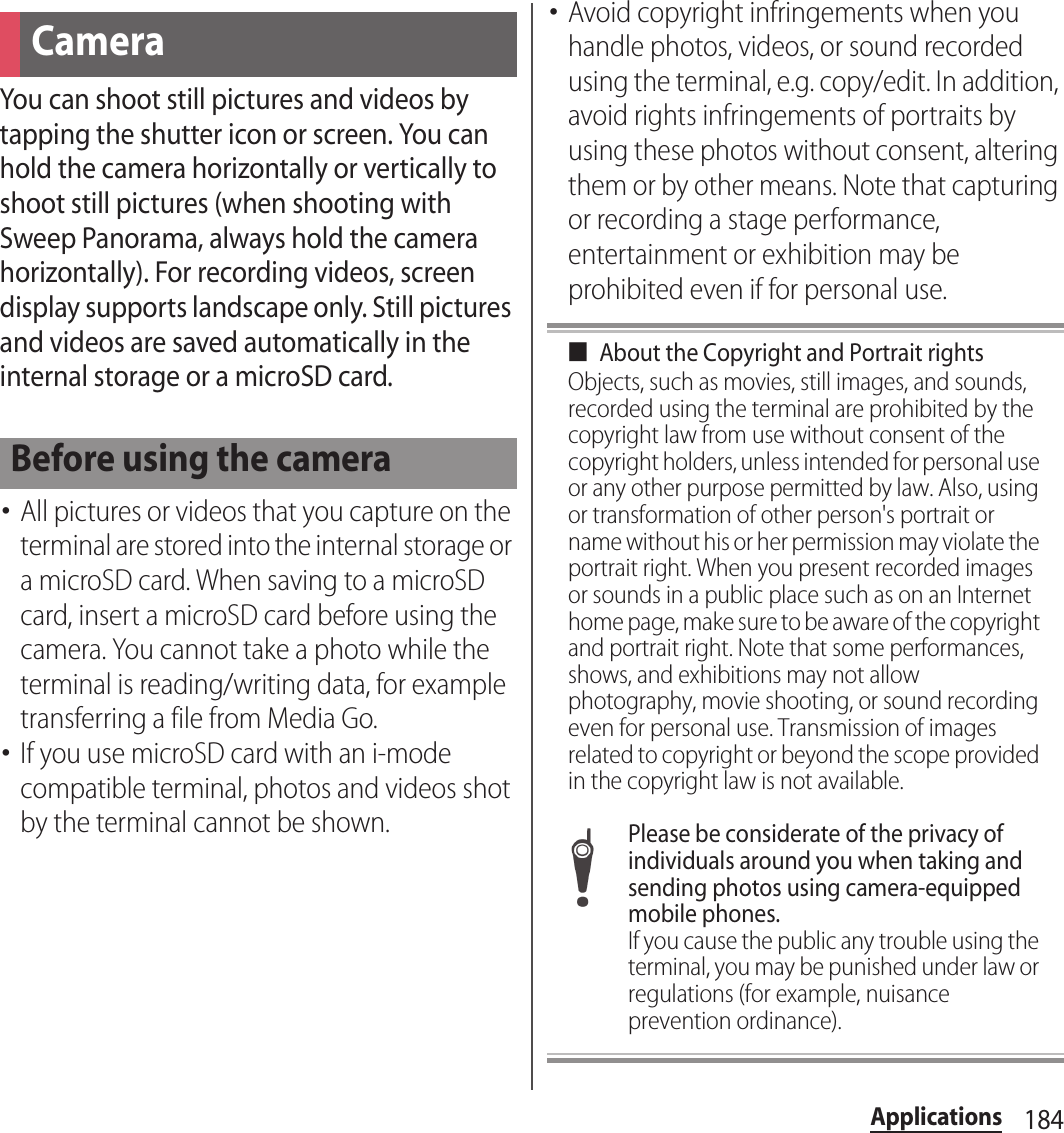
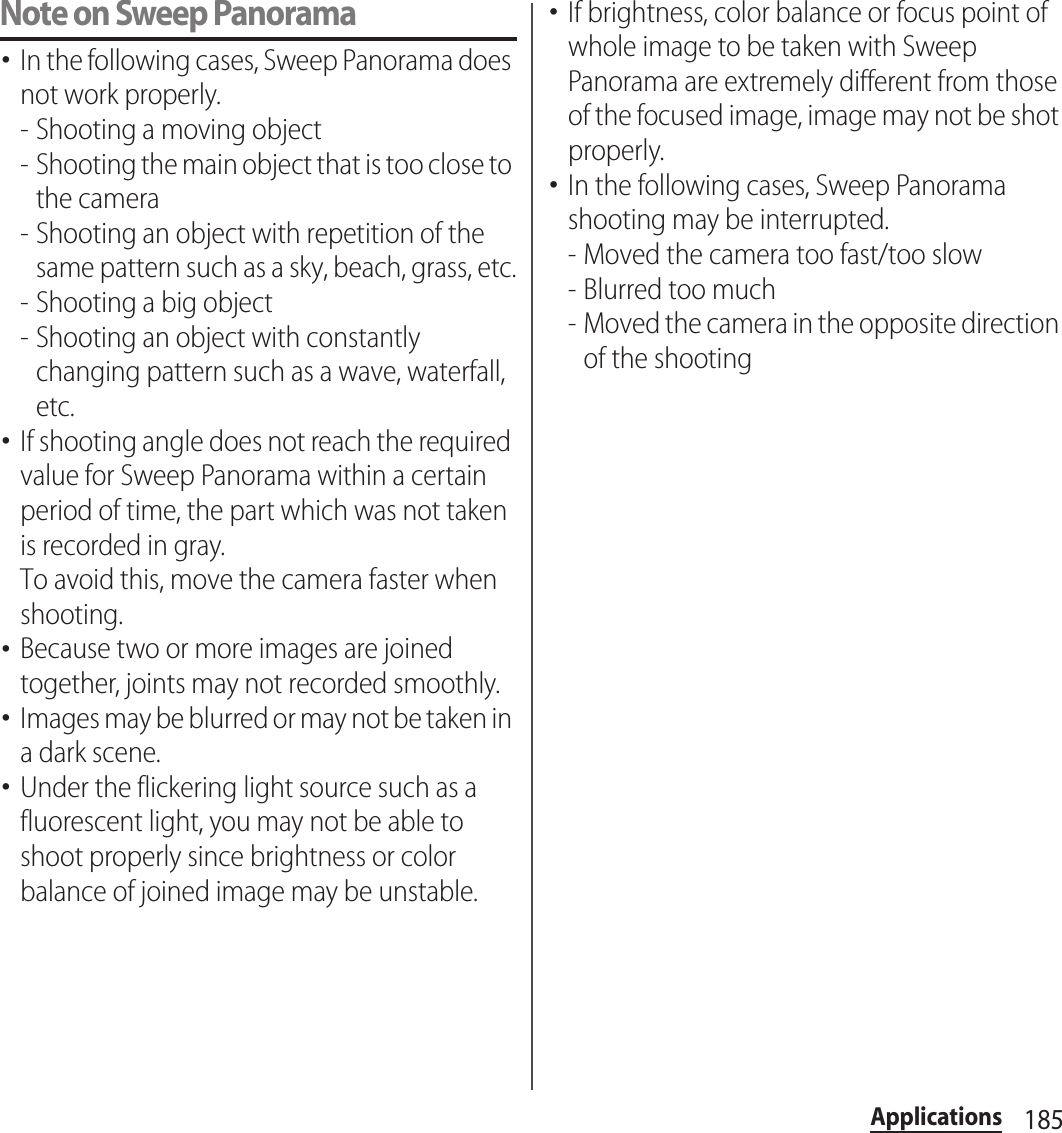
![186Applications■ Still picture shooting screen■ Video recording screenaCapturing mode icon (P.188)bDisplay area of icons showing selected settingscIcons showing set itemsdDisplay area of status icons showing selected settingseSwitch icon for photo/videofNavigation bargShutter (still picture) Start/Stop recording (video)hRecent shooting history・Touch thumbnail of shooting history on the shooting screen and flick it to the left of the screen (up when in portrait view) to display the last 5 items.・Tap a thumbnail to open viewing/playback screen for still pictures and videos.・Touch and hold a thumbnail to display the following icons. : View playback screen of photos and videos : Share : Delete❖Information・On the shooting screen, pinch-in/out or press m to zoom in/out. When capturing mode (P.188) is set to "Front camera", "Sweep Panorama" or "Front video", zoom is not available.・To end the camera, tap Navigation bar, then tap x.1From the Home screen, tap and [Camera].・The still picture shooting screen (P.187) appears. For recording videos, tap on the photo/video switch icon (P.187) to display the video recording screen (P.187).2On the shooting screen, tap the capturing mode icon (P.188), then select capturing mode.Shooting screen and key operationabcefg hdabcdefg hChanging shooting mode](https://usermanual.wiki/Sony/TM-0000.user-guide/User-Guide-1900871-Page-188.png)
![187ApplicationsCapturing mode icon■ Capturing mode Superior autoThe camera determines most suitable scene effect. A corresponding scene icon appears when the scene is recognized."Soft snap", "Landscape", "Backlight", "Backlight portrait", "Night scene", "Night portrait", "Document", "Macro" or "Low light" is recognized. NormalA standard shooting mode. Front cameraShoot pictures using the front camera (P.199). Picture effectApply various picture effects to pictures (P.201). Scene selectionSet programmed scenes (P.189). Sweep PanoramaShoot panoramic image with wide angle (P.202). Video cameraRecord videos (P.195). Front videoRecord videos using the front camera (P.199).Tap the shutter icon ( ) or shooting screen to shoot still pictures. Shot still pictures are automatically saved in the internal storage/microSD card.1From the Home screen, tap and [Camera].・The still picture shooting screen (P.187) appears.■Tapping the shutter icon ( )Tap the shutter icon ( ) on the shooting screen.・To shoot still pictures using auto-focus function, touch and hold the shutter icon ( ) and release your finger when the focus frame turns green and sound beeps. A picture is taken as soon as you release the finger. If the focus frame turns red, auto-focus does not operate correctly.■Tapping the shooting screenSet "Touch capture", then tap the shooting screen.・To set "Touch capture", on the shooting screen, tap , then tap [Capturing method]u[Touch capture].Shooting still pictures](https://usermanual.wiki/Sony/TM-0000.user-guide/User-Guide-1900871-Page-189.png)
![188Applications・To shoot still pictures using auto-focus function, touch and hold the screen and release your finger when the focus frame turns green and sound beeps. A picture is taken as soon as you release the finger. If the focus frame turns red, auto-focus does not operate correctly.❖Information・When you connect Stereo Headset with Microphone (Sample), commercially available earphone set or other Bluetooth device, shutter sound may be softer. 1From the Home screen, tap and [Camera].・The still picture shooting screen (P.187) appears.2On the shooting screen, tap , then tap item to set.・Several setting icons are displayed on the shooting screen in advance. The displayed setting icons change depending on the setting conditions.・When capturing mode (P.188) is set to "Picture effect" or "Sweep Panorama", tap the setting item icon displayed on the shooting screen to change the setting.・For setting items and icons, see "Still camera setting" (P.189).3Tap an option in the selected setting.・If you change setting options, icons displayed on the shooting screen change to the set items.❖Information・To replace setting item icons displayed on the shooting screen, tap on the shooting screen and touch and hold a setting item and drag it to a dotted frame.・To delete a setting item icon displayed on the shooting screen, touch and hold an icon and drag it to displayed in the center of the screen.・When capturing mode (P.188) is set to "Picture effect" or "Sweep Panorama", a setting item icon cannot be replaced or deleted.・ or capturing mode icons (P.188) displayed on the shooting screen cannot be moved or deleted.Still camera setting■ ScenesUse Scenes to quickly set up the camera for various scene conditions.Use when the capturing mode (P.188) is set to "Scene selection". Soft snapSettings are optimized to give brighter and warmer skin tones. LandscapeShoot landscape depicting trees with vivid color and focusing on distant objects.Changing the shooting settings](https://usermanual.wiki/Sony/TM-0000.user-guide/User-Guide-1900871-Page-190.png)
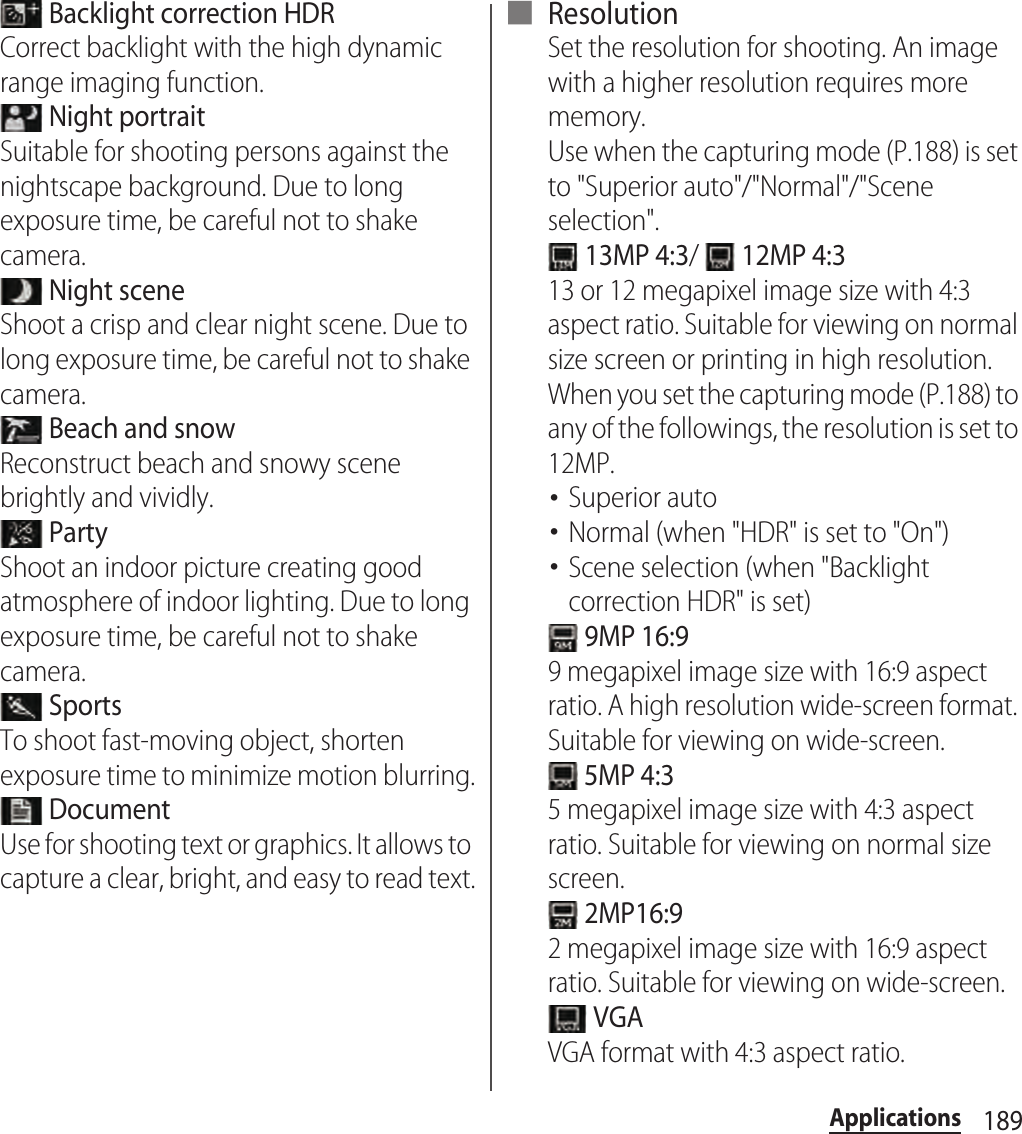
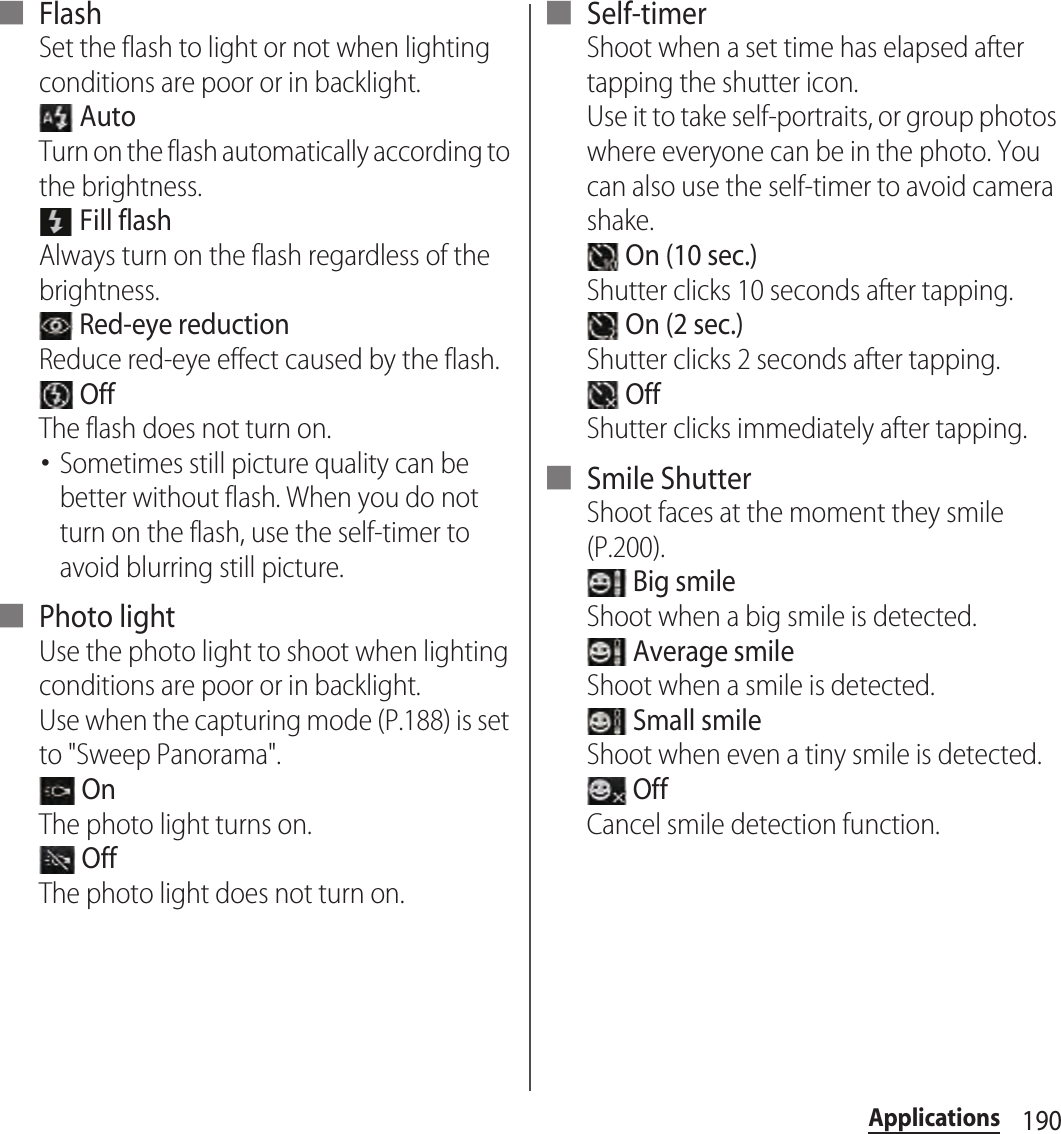
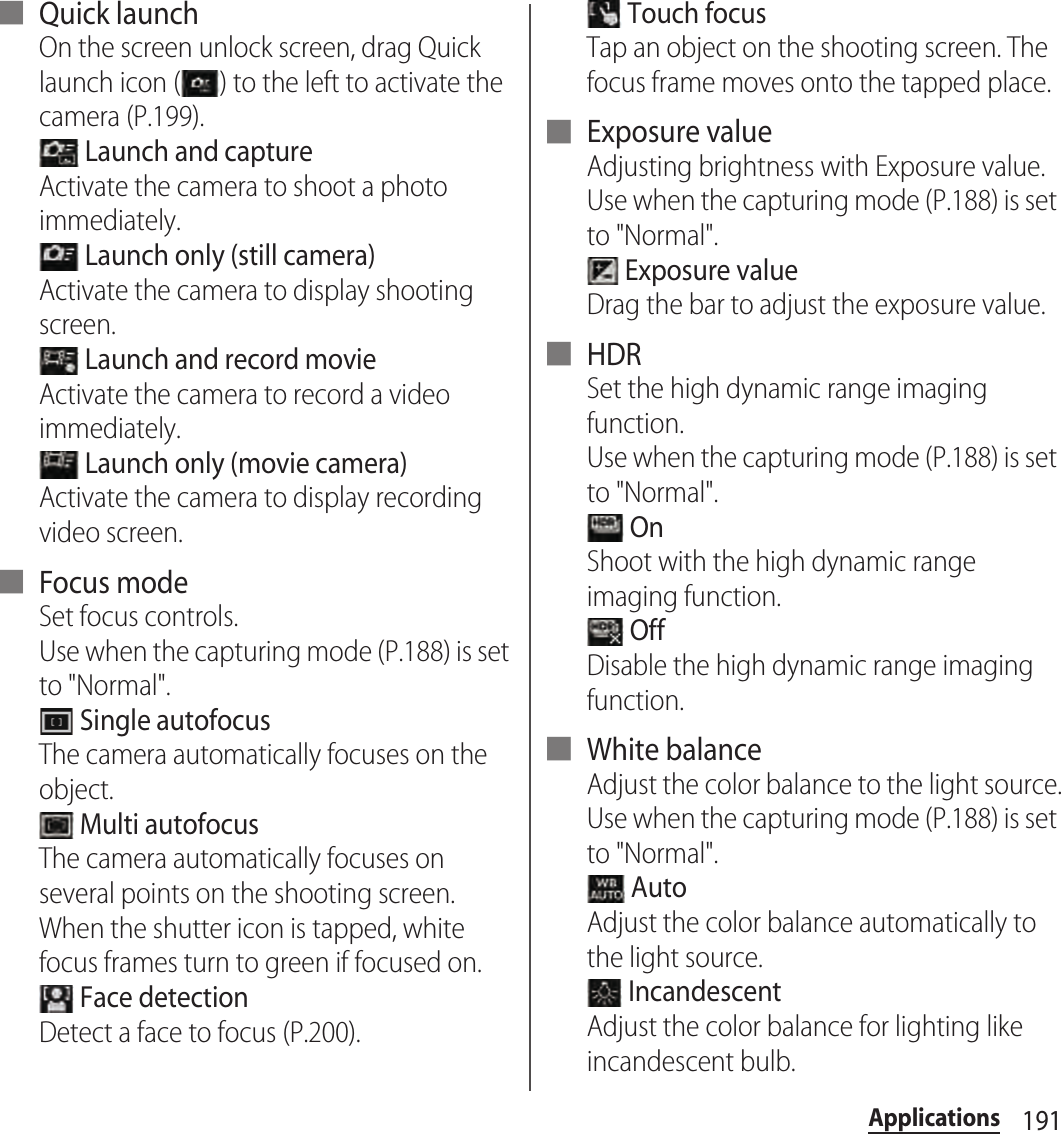
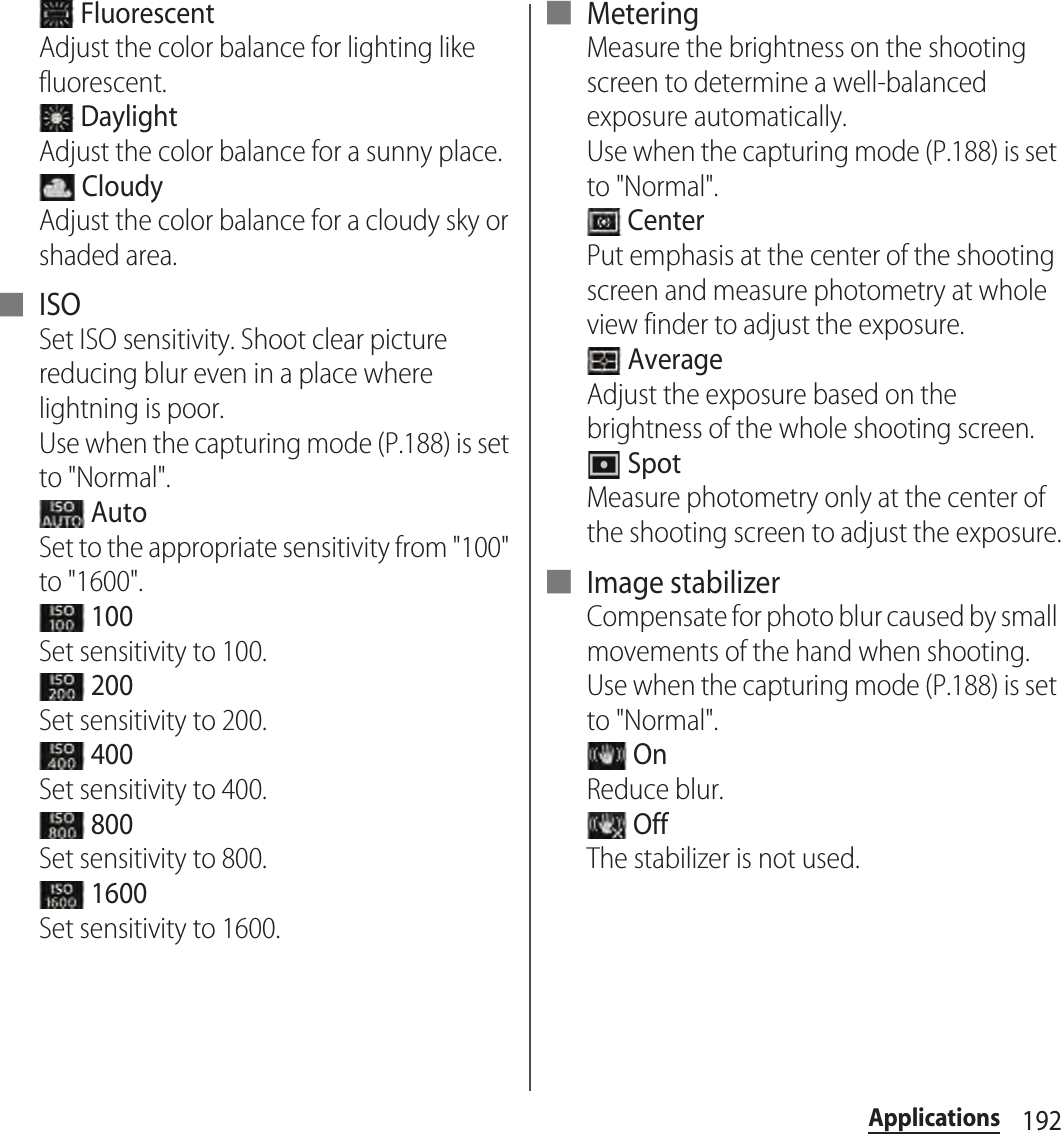
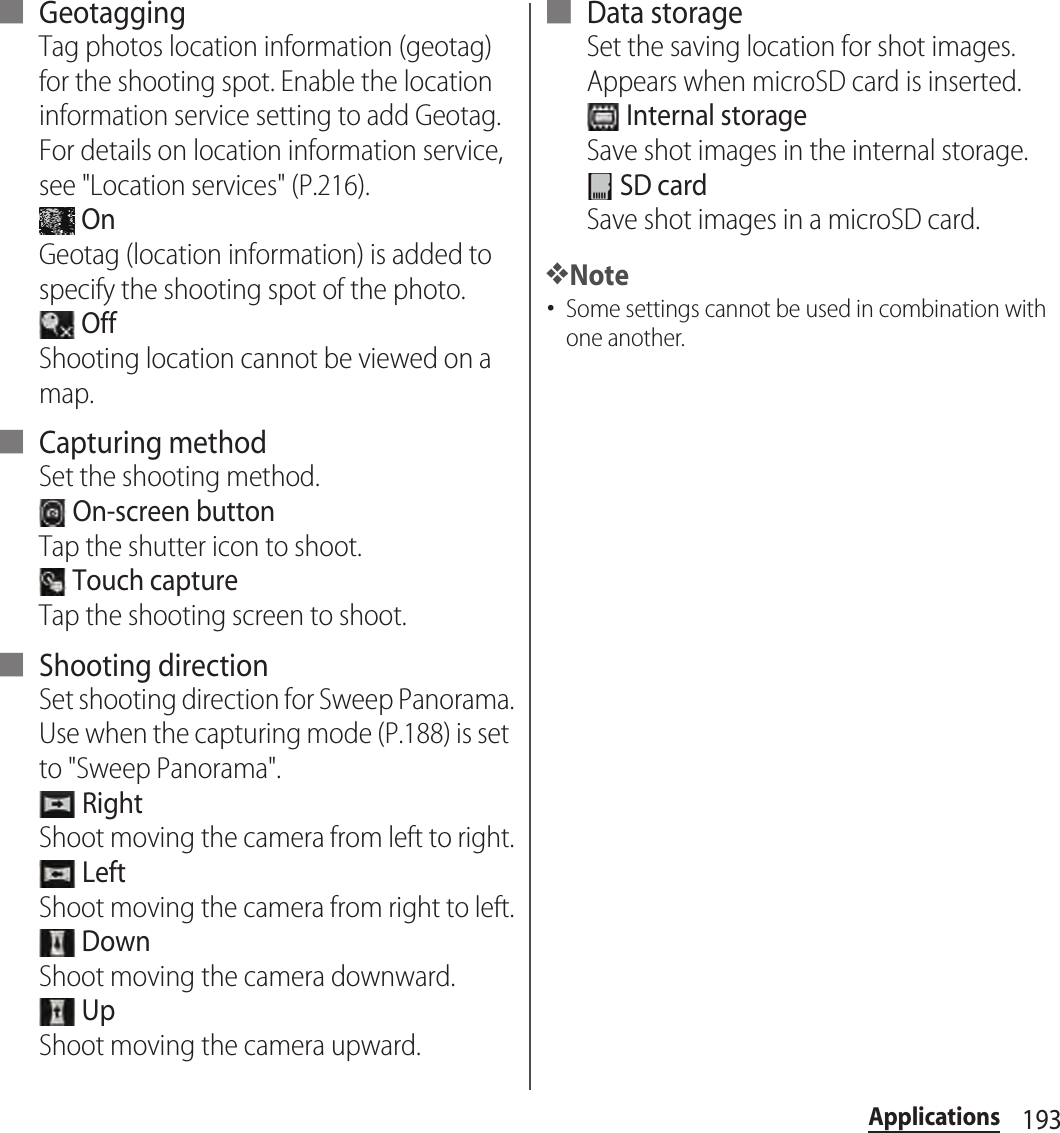
![194ApplicationsTap the start recording icon ( )/stop recording icon ( ) or the recording screen for recording a video. For video recording screen, only landscape screen is supported. Recorded videos are automatically saved in the internal storage/microSD card.1From the Home screen, tap and [Camera].2Tap of photo/video switch icon (P.187).・The video recording screen (P.187) appears.■Tapping the start recording ( )/stop recording ( ) iconOn the recording screen, tap the start recording icon ( ) to start recording, and tap the stop recording icon ( ) to stop recording.■Tapping the recording screenSet "Touch capture", then tap the start recording icon to start recording, and tap the stop recording icon to stop recording.・To set "Touch capture", on the recording screen, tap , then tap [Capturing method]u[Touch capture].❖Information・Do not cover the microphone with fingers etc. when recording videos.・When you connect Stereo Headset with Microphone (Sample), commercially available earphone set or other Bluetooth device, shutter sound may be softer. 1From the Home screen, tap and [Camera].2Tap of photo/video switch icon (P.187).・The video recording screen (P.187) appears.3On the shooting screen, tap , then tap item to set.・Several setting icons are displayed on the shooting screen in advance. The displayed setting icons change depending on the setting conditions.・For setting items and icons, see "Video camera setting" (P.196).4Tap an option in the selected setting.・If you change setting options, icons displayed on the shooting screen change to the set items.Recording videosChanging the recording settings](https://usermanual.wiki/Sony/TM-0000.user-guide/User-Guide-1900871-Page-196.png)
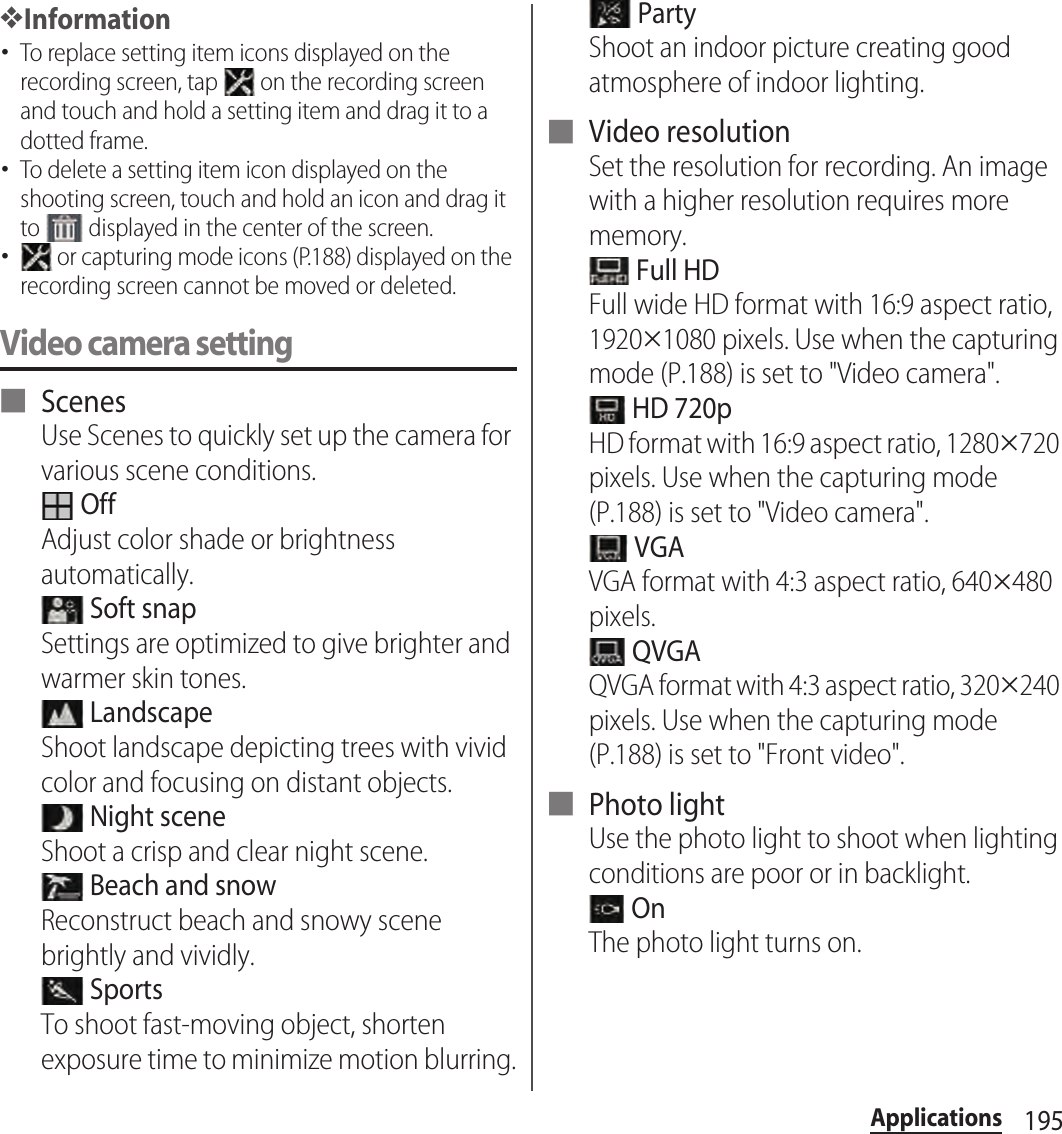
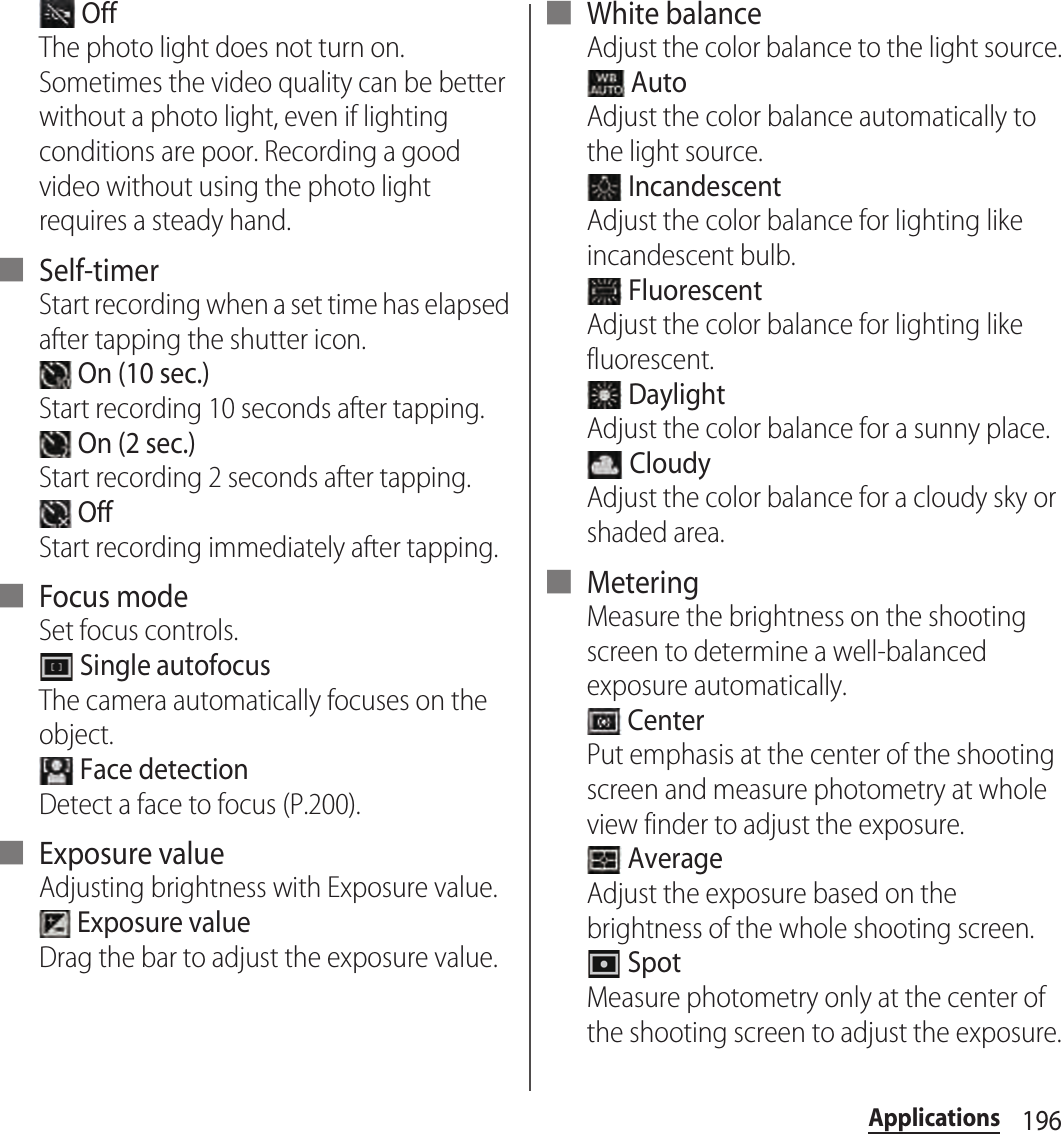
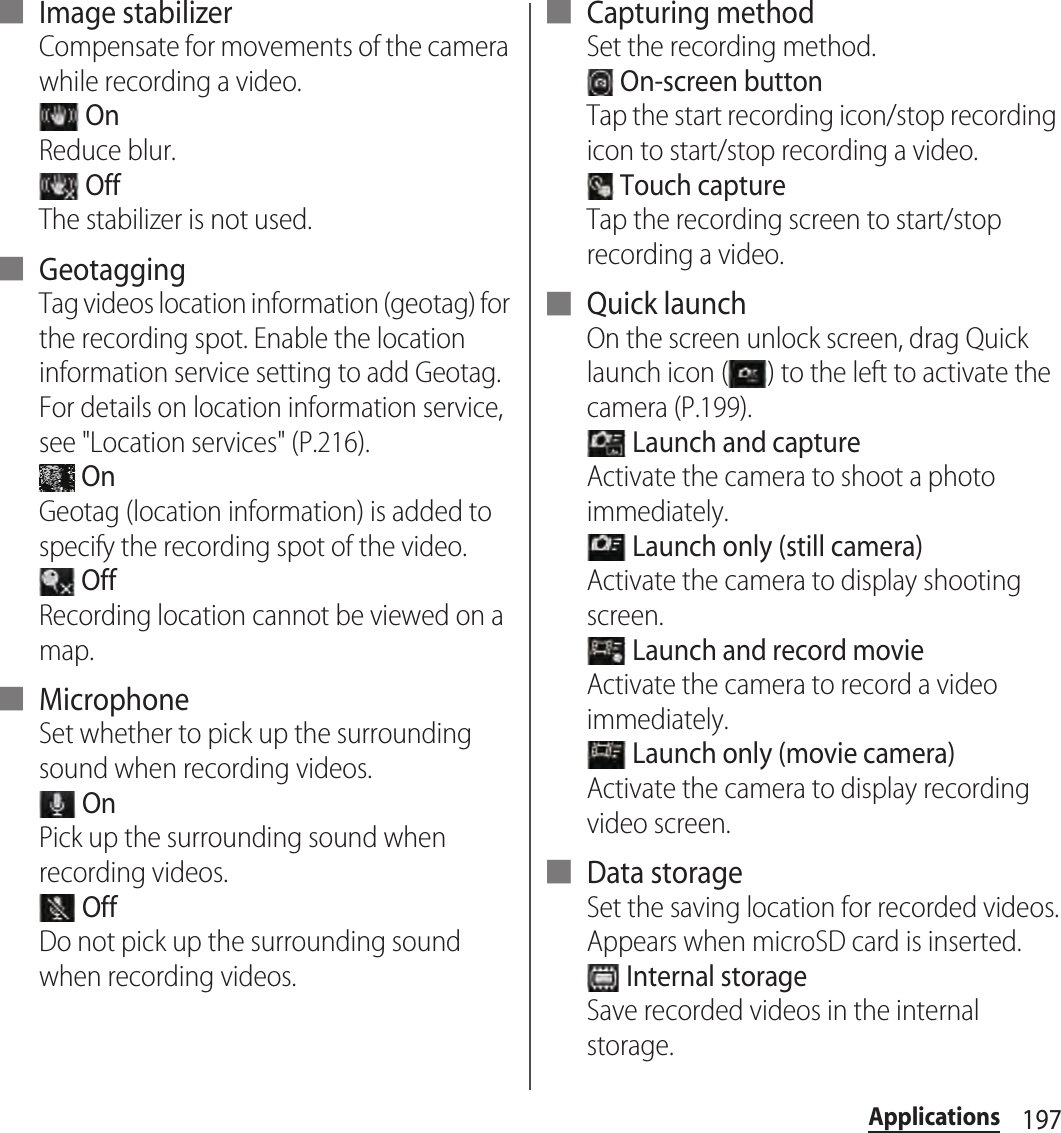
![198Applications SD cardSave recorded videos in a microSD card.❖Note・Some settings cannot be used in combination with one another.Front camera allows you to shoot your own picture or video while watching the shooting screen.1From the Home screen, tap and [Camera].・The still picture shooting screen (P.187) appears. For recording videos, tap on the photo/video switch icon (P.187) to display the video recording screen (P.187).2On the shooting screen, tap the capturing mode icon (P.188), then tap [Front camera]/[Front video].3Shoot photo/video.・For information on how to shoot, see "Shooting still pictures" (P.188) or "Recording videos" (P.195).❖Information・When using Front camera, "Self-timer", "Smile shutter", "Geotagging", "Capturing method", "Data storage" can be set. Other "Still camera setting" (P.189) are not supported by Front camera.- Resolution for Front camera is "VGA". The resolution cannot be changed.- The settings take over the camera settings set at the time when switching.・For using Front video camera, "Video resolution", "Self-timer", "Geotagging", "Microphone", "Capturing method", "Data storage" can be set. Other "Video camera setting" (P.196) are not supported by Front video camera.- The settings take over the video settings set at the time when switching ("Video resolution" is changed to "VGA").Quick launch allows you to activate camera to shoot without unlocking the screen lock.❖Information・To use Quick launch, on Preferred apps settings (P.70), set "Set all to" or "Lock screen" to "Xperia™", and set "Slide/Touch" for screen unlocking method (P.147) in advance.1On the screen unlock screen, drag Quick launch icon ( ) to the left.・"Launch and capture" is set by default. Activate the camera to shoot a photo immediately.・Shot pictures are automatically saved in the internal storage/microSD card.Front cameraQuick launch](https://usermanual.wiki/Sony/TM-0000.user-guide/User-Guide-1900871-Page-200.png)
![199Applications❖Information・To change Quick launch operations, set from the shooting screen. For details, see "Quick launch" (P.192).・By default, on the screen unlocking screen, tap to activate camera.You can use face detection to bring an off-center face into focus. The camera automatically detects up to 5 faces at a time. A yellow frame indicates a face to focus on, and white frames indicate the rest. An appropriate face is determined by distance from the camera and off-center balance, and is focused automatically. You can also tap one of the frames to select which face should be in focus.Setting face detection1From the Home screen, tap and [Camera].・The still picture shooting screen (P.187) appears. For recording videos, tap on the photo/video switch icon (P.187) to display the video recording screen (P.187).・Capturing mode (P.188) is set to "Normal" or "Video camera".2On the shooting screen, tap and [Focus mode]u[Face detection].Shoot using face detection1With Face detection set, point the camera at the object.・Each detected face is framed (up to 5 faces).2Tap the frame you want to focus on or let the camera select which face to focus on without tapping.・A yellow frame shows the face in focus.3Shoot photo/video.・For information on how to shoot, see "Shooting still pictures" (P.188) or "Recording videos" (P.195).Smile shutter allows you to capture a face just as it smiles. The camera detects up to 5 faces and selects 1 face for smile shutter and auto focus. A yellow frame shows which face is selected. When the selected face smiles, the frame turns to green and the camera automatically takes a photo.Face detectionSmile Shutter](https://usermanual.wiki/Sony/TM-0000.user-guide/User-Guide-1900871-Page-201.png)
![200ApplicationsSetting smile shutter1From the Home screen, tap and [Camera].・The still picture shooting screen (P.187) appears.2On the shooting screen, tap , then tap [Smile Shutter].3Select smile level for the smile shutter.・Set "Off" to cancel smile shutter.Taking a photo using smile shutter1Set smile shutter, and point the camera at the object.・Each detected face is framed (up to 5 faces).・The camera selects which face to focus on. A yellow frame shows the face in focus.2The camera automatically takes the photo when the object in focus smiles.・Shot pictures are automatically saved in the internal storage/microSD card.・If no smile is detected, operate the steps in "Shooting still pictures" (P.188) to shoot a picture.Picture effect allows you to shoot pictures with various picture effects.Setting picture effects1From the Home screen, tap and [Camera].・The still picture shooting screen (P.187) appears.2On the shooting screen, tap the capturing mode icon (P.188), then tap [Picture effect].3Select a picture effect.・Select from "Nostalgic", "Miniature", "Vivid", "Filter", "Fisheye", "Sketch", "Partial color", "Harris shutter" or "Kaleidoscope".❖Information・On the screen for selecting a picture effect, press m to capture a screenshot.・Resolution for the picture effect is "2MP 16:9". The resolution cannot be changed.Picture effect](https://usermanual.wiki/Sony/TM-0000.user-guide/User-Guide-1900871-Page-202.png)
![201ApplicationsTaking a picture using picture effect1Set picture effect, and point the camera at the object.・Tap or pinch to change the picture effect setting.2Tap the shutter icon ( ).・Shot pictures are automatically saved in the internal storage/microSD card.❖Information・When you take a picture using picture effect, "Touch capture" (P.194) is not available.Use Sweep Panorama to shoot panoramic image with wide angle.Aligning the white frame on the screen with the black frame, move the camera slowly toward the set shooting direction to shoot.Setting Sweep Panorama1From the Home screen, tap and [Camera].・The still picture shooting screen (P.187) appears.2On the shooting screen, tap the capturing mode icon (P.188), then tap [Sweep Panorama].・Tap / to set "Shooting direction" (P.194) or "Photo light" (P.191).Shooting Sweep Panorama1Set Sweep Panorama, point the camera at the object.2Shoot a still picture.・For information on how to shoot pictures, see "Shooting still pictures" (P.188).・A white frame and big black frame appear on the shooting screen.3Aligning the white frame with the black frame, slowly move the camera from left to right.・If you change shooting direction, slowly move the camera in the set direction.・Shot pictures are saved automatically in the internal storage/microSD card.Sweep Panorama](https://usermanual.wiki/Sony/TM-0000.user-guide/User-Guide-1900871-Page-203.png)
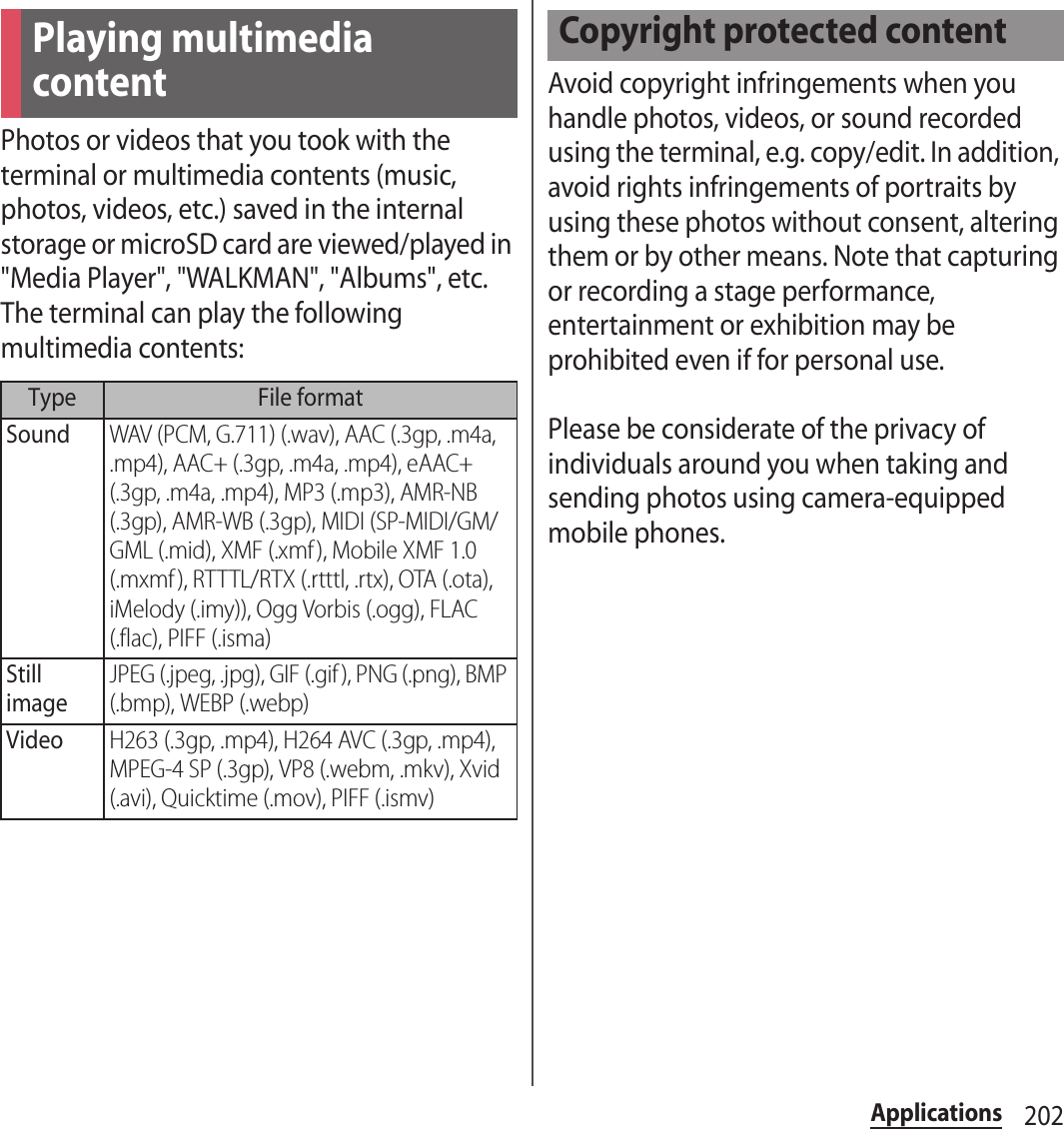
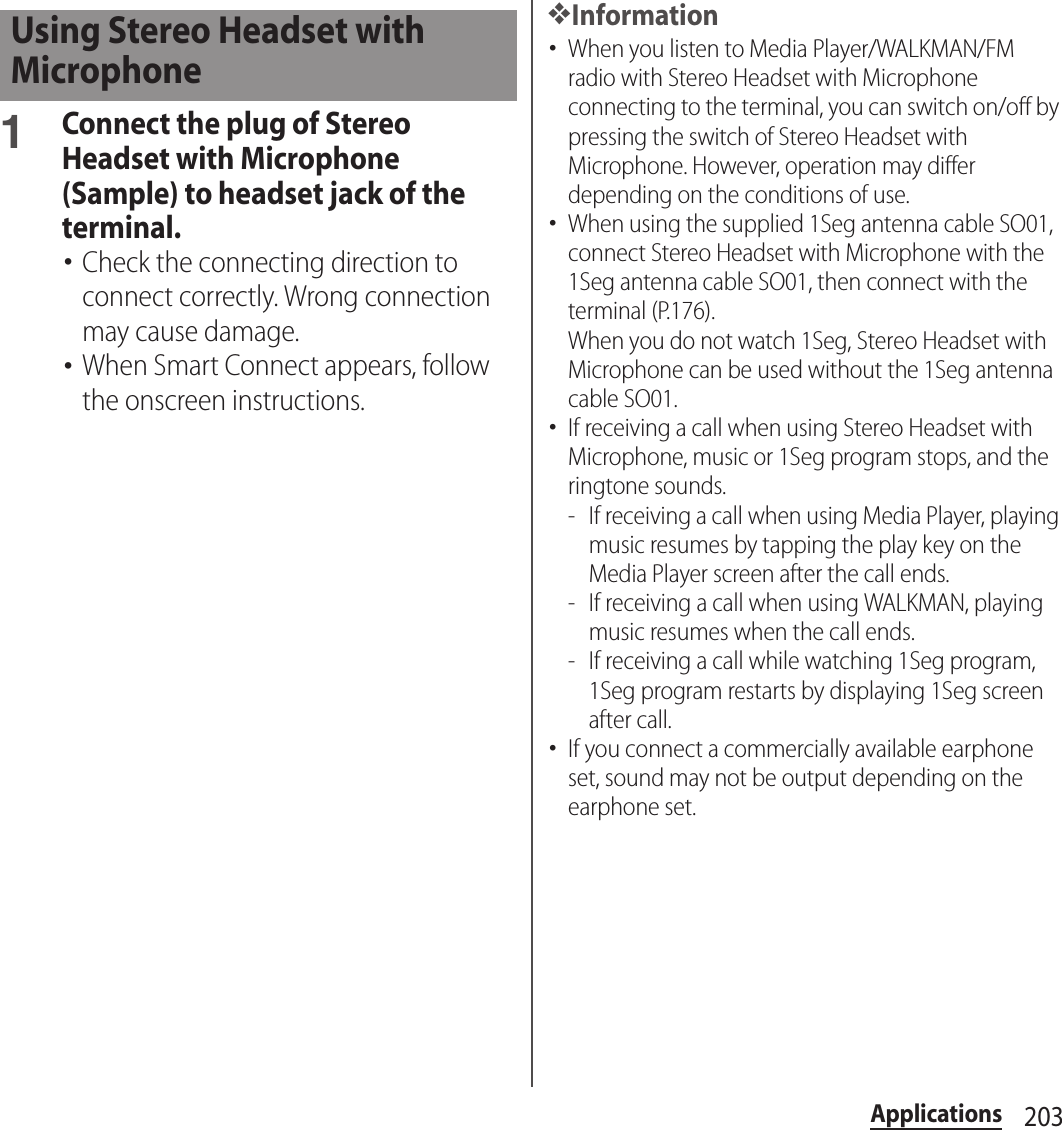
![204ApplicationsImages, photos and videos you took can be viewed and played. Also, use Media Go to transfer content to the terminal and to take content from an external device. For details, refer to "Using microUSB cable" (P.154).1From the Home screen, tap , then tap [Album].・Album screen appears.・ icon is displayed on the video files.❖Information・Depending on the number of saved images, it may take some times to load images.■ Album screenaPictures tab・Pictures are displayed in a list of chronological order.bMaps tab・Geotagged images appear on a map.cShow album listdView optional menueOnline tab・Display images in albums in synchronized online services or images on a device registered in the Media server.1Tap a photo on the Album screen.・The photo is played.・Tap the screen to display information such as shooting date, option menu icons, etc.AlbumViewing photo/videoViewing photosabec d](https://usermanual.wiki/Sony/TM-0000.user-guide/User-Guide-1900871-Page-206.png)
![205Applications■ Still picture viewing screenaLocation information・For a geotagged image, a country name and a region name appear, and tap the icon to view the image on the map.bBack to the image listcView share menu (P.206)dDelete image (P.207)eView optional menufShooting date and time❖Information・Pinch-out/in on the photo viewing screen to zoom in/out image.・The items vary depending on the selected file.1Tap a video on the Album screen.・Video playback screen appears.2Tap .・Video is played.Sharing image filesYou can share image files by attaching to Gmail or Email, uploading to Picasa or Google+, or sending to other devices via Bluetooth or infrared communication.1Tap an image file to share in the Album screen.2Tap the screen and .・Menu for sharing image file appears.・Tap [See all...] to display all share menus.3Select sharing method for image file.・After this step, follow the onscreen instructions.・The items vary depending on the selected file.・Some items cannot be operated in some image files.❖Information・On the Album screen, tap and [Select items], then select image files to operate. You can operate several files as a group.・When you select "Infrared" in Step 3, the Send via infrared message appears. Tap [OK] to start sending. For details on infrared communication, see "Using infrared communication" (P.158).Playing videofab c d eOperating image files](https://usermanual.wiki/Sony/TM-0000.user-guide/User-Guide-1900871-Page-207.png)
![206Applications・For shared files, file size and the file type are not particularly limited, but may be limited by the application to transfer. DRM content cannot be shared.Deleting image files1On the photo viewing screen/video playing screen, tap and tap [OK].・Image file is deleted.❖Information・To delete several files, on the album screen, tap and [Select items], then select image files to delete, and then tap and tap [OK].Using optional menuView slideshow, edit image, set image to phonebook entry or as wallpaper, check shooting date and time, etc.1On the photo viewing screen/video playing screen, tap the screen and tap .2From the displayed menu, select item you want to use.・The items vary depending on the selected file.・Some items cannot be operated in some image files.❖Information・In Step 2, tap "Throw" to display the connection device selection screen (if you do not connect Wi-Fi network, tap [Settings] to display the setting screen for Wireless & networks). Select a device detected on the connection device selection screen, and tap the device name to play on to share a file between a DLNA device and the terminal.YouTube is a free online video streaming service. You can play, search for and upload videos.・A packet communication charge is applied when downloading or uploading video content using mobile networks.1From the Home screen, tap , then tap [YouTube].・If you do not set Google account, the Google account setting screen appears. Follow the onscreen instructions.・A list of videos appears. You can select from categories.YouTubePlaying YouTube video](https://usermanual.wiki/Sony/TM-0000.user-guide/User-Guide-1900871-Page-208.png)
![207Applications2Tap a video to play it.・Tap the screen to display play/pause icon or progress bar. Drag the marker left or right on the progress to change playing point.・Turn the terminal sideways to switch to the landscape view.・Tap x to stop playing and return to the video list screen.・To quit YouTube, tap y.❖Information・For movies with caption function which can display subtitles, "CC" appears on the playback screen in the landscape mode. Tap [CC] to set the caption function.・When "HD" or "HQ" appears while playing in the landscape view, tap [HD]/[HQ] to play in high quality. A video plays in high quality when Wi-Fi is connected. To always play video in high quality even when mobile network is connected, tap , then tap [Settings]u[General] then mark "High quality on mobile" checkbox.・Tap to search videos. To delete search history, tap and [Settings]u[Search]u[Clear search history]u[OK].This terminal supports MHL connection. To connect to an MHL compatible TV, insert a commercially available MHL cable into the microUSB jack of the terminal and the MHL jack of the TV.To connect to an HDMI compatible TV, use a commercially available HDMI connector (MHL adapter) and an HDMI cable etc. to connect to the terminal.Connect to a TV to display photos and videos on the TV screen.1Connect the terminal with the Home screen or Application screen displayed to a TV using an MHL cable.■When the Home screen is displayed・Activate TV launcher automatically.Connecting the terminal to TV to watch photos and videosConnecting to TV to activate an application by TV launcher](https://usermanual.wiki/Sony/TM-0000.user-guide/User-Guide-1900871-Page-209.png)
![208Applications■When the Applications screen is displayed・, appears on the status bar. Also, drag the status bar downwards and tap [TV launcher] to activate TV launcher.2Switch the TV to MHL input mode.・The screen of the terminal is shown on the TV screen.3Flick an icon left or right to select application you want to use.❖Information・While MHL is connected, drag the status bar downwards and tap [MHL connected] to make output settings or check using a TV remote control etc.・On the TV launcher screen, select an album art in WALKMAN at the upper left to display WALKMAN screen.・On the TV launcher screen, Tap [Home] to display the Home screen of the terminal.・On the TV launcher screen, tap [Add] or and tap [Add], then select the desired shortcut to add to the TV launcher screen.・On the TV launcher screen, tap and [Rearrange] to rearrange shortcuts on the TV launcher screen.・On the TV launcher screen, tap and [Delete] to delete shortcuts on the TV launcher screen.・Removing the MHL cable from the terminal severs connection, however, TV may remain to MHL input mode or HDMI input mode. Follow the instructions on the TV to switch to digital terrestrial television mode, etc.・When you do not use MHL connection, remove the MHL cable or HDMI adapter and cancel MHL connection. If the HDMI cable remains connected, the battery may be consumed quickly.・The terminal does not support resolution 720#576p at 50Hz for MHL output to TV.・You can operate the TV Launcher screen, the Home screen or applications using a TV remote controller if connecting the following devices.- MHL compatible TV supporting Remote Control Protocol (RCP)- HDMI compatible TV supporting Consumer Electronic Control (CEC)To connect to an HDMI compatible TV, a commercially available HDMI connector (MHL adapter) compatible with RCP is required.Some applications may not support remote control operations.](https://usermanual.wiki/Sony/TM-0000.user-guide/User-Guide-1900871-Page-210.png)
![209ApplicationsPlay back videos and music stored on a microSD card using Media Player.・For information on how to copy music and video data from a PC, see "Using microUSB cable" (P.154).・For information on file formats of playable data, see "Playing multimedia content" (P.203).1From the Home screen, tap , then tap [Media Player].・Media Player screen appears.■ Media Player screenaTab・Change displayed information.・Flick left or right.bView optional menu❖Information・To change the order of tab icons, tap and tap [Settings]u[Arrange icons], drag up and down on the item to change then tap [Apply].1From the Home screen, tap , then tap [Media Player].・Tap [Movie] tab at the bottom of the screen to display video list.2Tap a song/video.・The playback screen appears to start playing back music/video.Media PlayerActivating Media PlayerabPlaying music/video](https://usermanual.wiki/Sony/TM-0000.user-guide/User-Guide-1900871-Page-211.png)
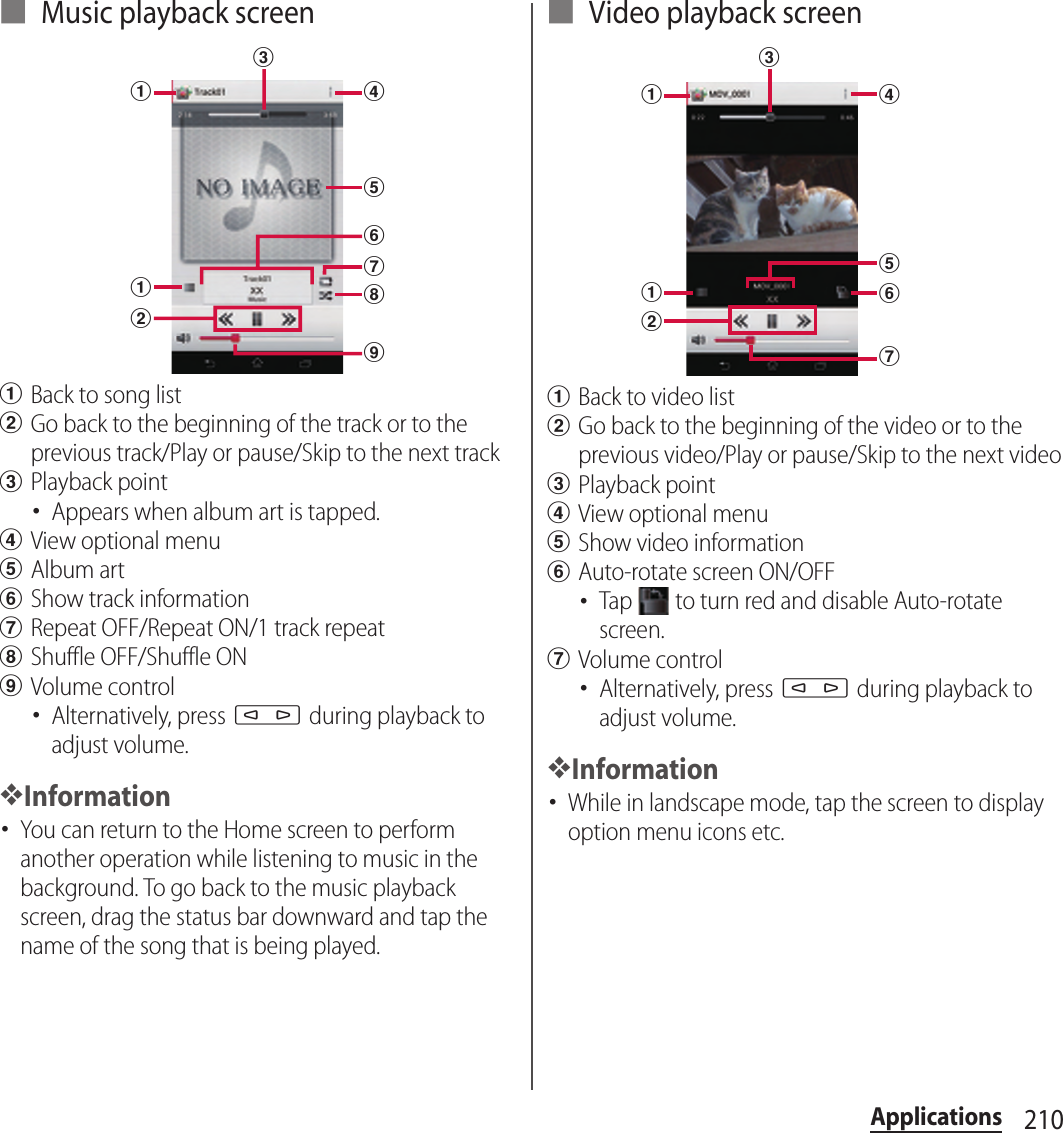
![211ApplicationsYou can play back songs in the order you decided using playlist.Creating a playlist1From the Home screen, tap , then tap [Media Player].2Flick left and right on tabs at the bottom of the screen and tap [Play list].・Play list screen appears.3Tap [Create new] and enter the access point name and tap [OK].4Tap [Add songs to playlist] and select songs you want to add.・You can also select songs from "Artists" and "Albums".・ on the selected song turns red and the song is added to Play list by each tap.5Tap [Apply]u[Save]u[OK].Editing songs in playlist1On the play list screen, select a playlist to edit and tap [Edit].■Changing order of the songsDrag up and down in song to change order and tap [Save]u[OK].■Deleting songs from playlistSelect a song to delete and tap [Save]u[OK].Deleting playlist1On the play list screen, tap [Edit].2Tap a playlist you want to delete.3Tap [Save]u[OK].❖Information・"Recently added songs", "Recently played songs", and "Most played songs" playlists cannot be deleted.Play list](https://usermanual.wiki/Sony/TM-0000.user-guide/User-Guide-1900871-Page-213.png)
![212ApplicationsTimescape™ (hereinafter referred to as Timescape) displays various information such as Facebook, Foursquare, Twitter or mixi updates, etc. in chronological order. You can see a tile preview of events in chronological order before choosing to view the full content. With (infinite button), you can view all communication information related to the registered contacts (P.215).❖Information・To make best use of Timescape, you can set up your social networking service (SNS) account. You can check the update of set Facebook/Foursquare/Twitter/mixi etc. by Timescape.・If you do not have a Social Networking Service account, you can create a new account in the following websites.- Facebookhttp://www.facebook.com/- Foursquarehttps://foursquare.com/- Twitter http://www.twitter.com/- mixihttp://mixi.jp/ (In Japanese only)・Note that, you cannot view emails of Gmail or other Email application accounts in Timescape.The first time you use Timescape, a setup wizard will guide you the necessary steps to set up account.1From the Home screen, tap , then tap [Timescape™].2Tap a tile.3If you want, enter your Facebook/Foursquare/Twitter/mixi account information.4Tap [Done].❖Information・In the setup wizard, tap [Extension search] on the account registration screen to connect to Google Play and search new services for Timescape.・After completion of setup wizard, you can change the settings. On the Timescape screen, tap and tap [Settings]u[Set up services].・If the automatic update of Facebook/Foursquare/Twitter/mixi is set, you can check information update sooner; however, the battery runs out quickly. To save the battery, set to manual update.Timescape™Initial settings for Timescape](https://usermanual.wiki/Sony/TM-0000.user-guide/User-Guide-1900871-Page-214.png)
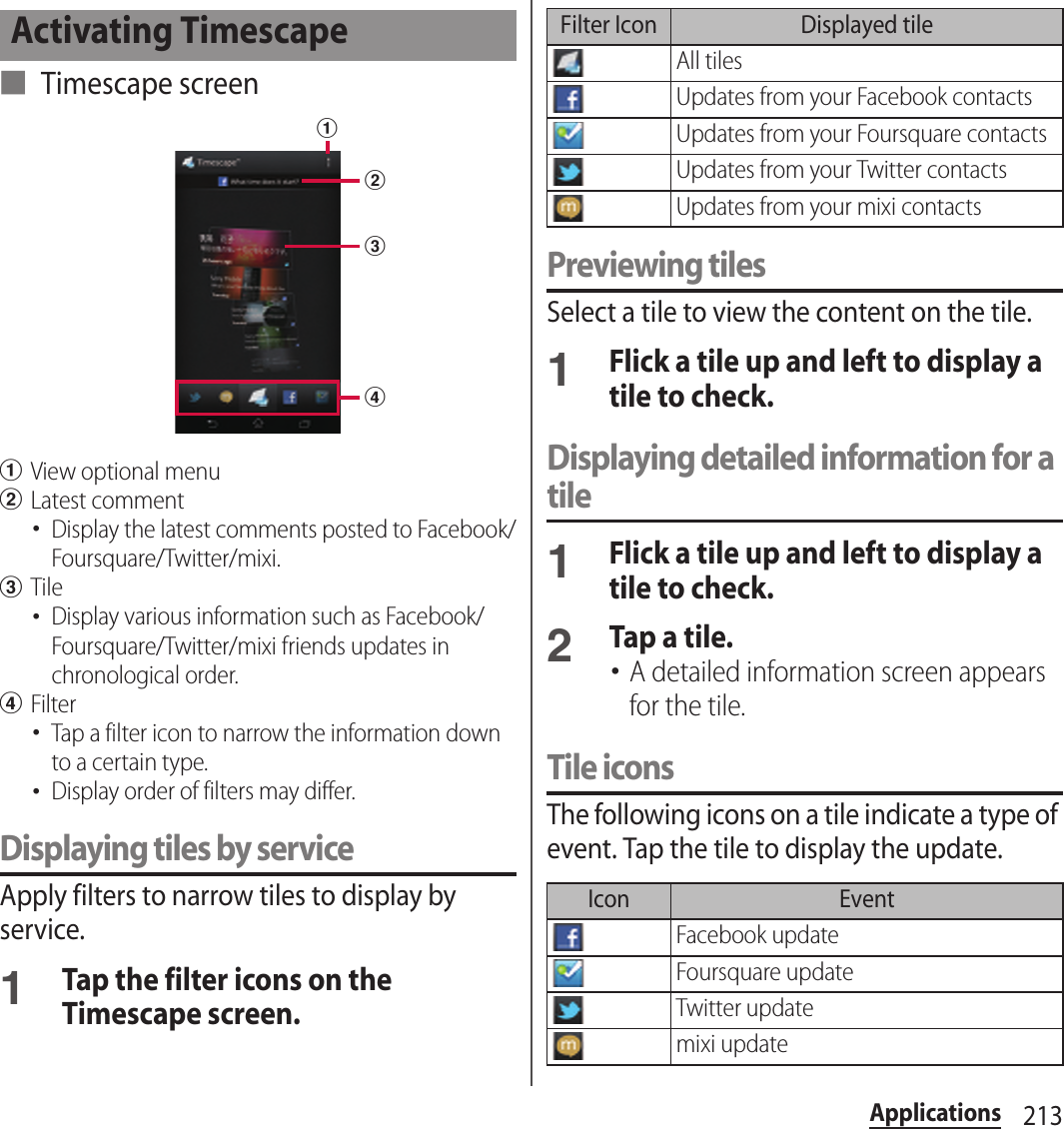
![214ApplicationsRefreshing the Timescape screenWhen you refresh the Timescape screen, the terminal connects to the Internet to update information from your Facebook, Foursquare, Twitter and mixi whose accounts are set in Timescape.1On the Timescape screen, tap and tap [Refresh].Posting to Facebook, Foursquare, Twitter, mixi from Timescape1On the Timescape screen, tap and tap [Update status].2Mark the service you want to post and tap [Continue].3Enter the text and tap [Post].When you tap a tile, (infinite button) may appear in the upper right corner. By tapping , you can view the communication log by registered information in the contacts or tile filter event.Viewing the registered information of contacts in Timescape1On the Timescape screen, tap a tile.2Tap .・Communication logs and information related to the selected tile by event appear. Flick left and right the filter at the bottom of the screen to switch displayed information.1On the Timescape screen, tap and tap [Settings].The infinite button in TimescapeSetting up TimescapeUpdate modeSet your Facebook/Foursquare/Twitter/mixi account information to be updated manually/automatically when Timescape is activated.Timescape™ contentChange a content type displayed in Timescape.Set up servicesSet Facebook/Foursquare/Twitter/mixi account or search new service of Timescape.](https://usermanual.wiki/Sony/TM-0000.user-guide/User-Guide-1900871-Page-216.png)
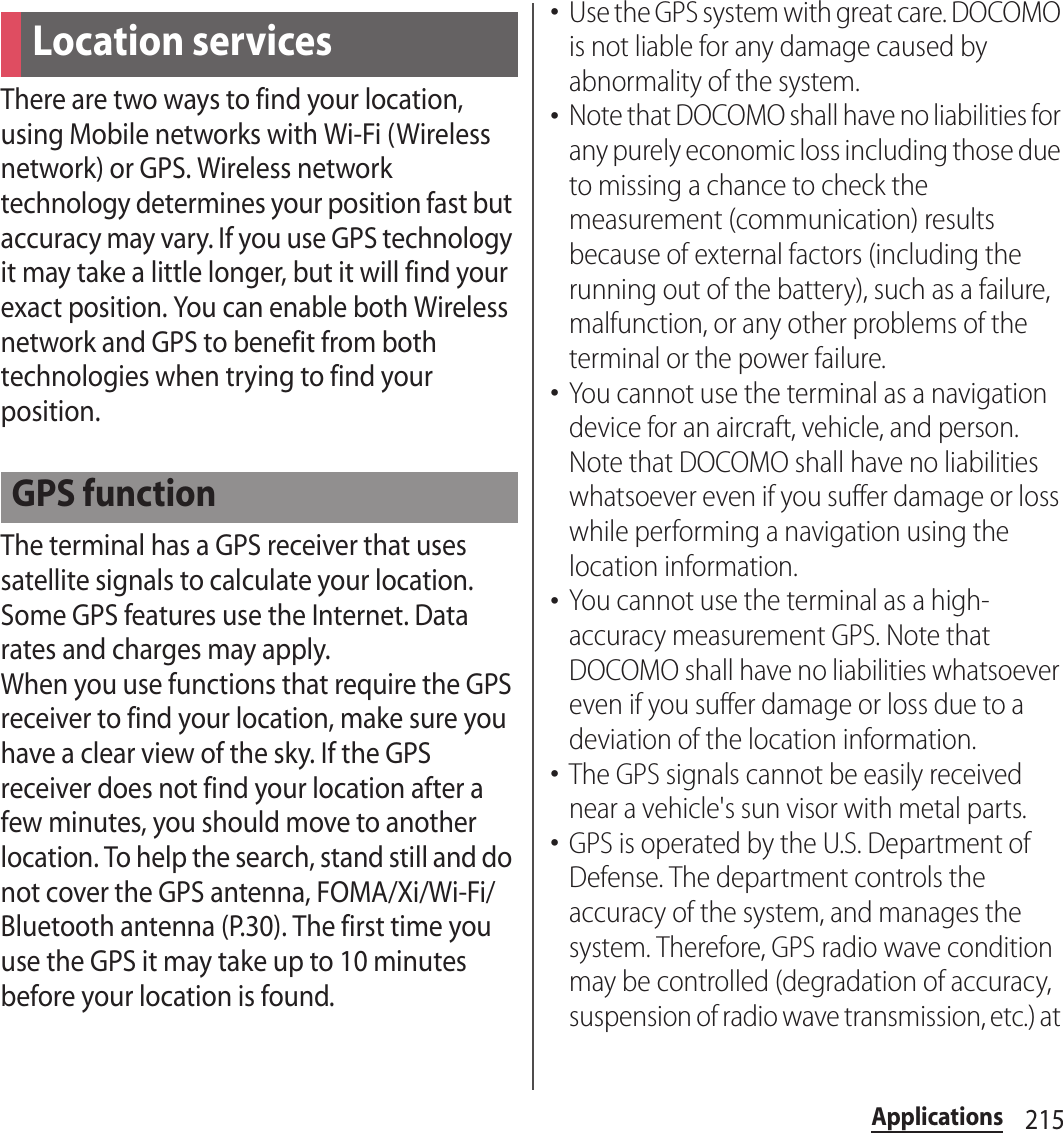
![216Applicationsthe discretion of the U.S. Department of Defense.・Some wireless communications products (mobile phone, data detectors and some others) block satellite signals and also causes instability of signal reception.・Some map displays based on location information (latitude/longitude information) may be not accurate due to some countries' or regions' regulations.■ Where radio waves are difficult to receiveNote that radio waves may not be received or it may be difficult to receive radio waves in the following conditions, since GPS uses radio waves from a satellite.・Inside or immediately under a building・Inside a bag or box・Inside or under a thick covering of trees・In a car, inside a train compartment・When there are obstructions (people or objects) near the terminal・Inside a basement or tunnel, and below the ground or water・In buildings-clustered or residential area・Near a high-voltage cable・Bad weather such as heavy rain or snow❖Note・If some of the GPS functions are not available, or if none of them are, check that your contract includes the use of the Internet, and see "Wireless & networks" (P.118).・NTT DOCOMO is not liable for navigation services or for the accuracy of location services.Enabling GPS function1From the Home screen, tap , then tap [Settings].2Tap [Location services].3Tap [GPS satellites].4Read the note and tap [Agree].・"GPS satellites" checkbox is marked.❖Information・Alternatively, drag the status bar downwards, tap , then read the notes and tap [Agree] to enable the GPS function.Enabling current location searchEnable to search a current location using mobile network and Wi-Fi.1From the Home screen, tap , then tap [Settings].2Tap [Location services].3Tap [Google's location service].4Read the note and tap [Agree].](https://usermanual.wiki/Sony/TM-0000.user-guide/User-Guide-1900871-Page-218.png)
![217Applications5Read the note on location information and tap [Agree].・"Google's location service" checkbox is marked.❖Information・Wireless network users' location information is stored without specifying who they are. Some location information is stored even when the application is not running.The Google Maps application lets you view your current location, find other locations and calculate routes. When you start the Google Maps application, your approximate location is shown using information from nearby mobile towers. Your location is updated with a more precise position when the GPS receiver finds your location.❖Information・Make sure to enable the location information service setting before trying to get your position.・To use Google Maps, enable data connection (LTE/3G/GPRS) or connect to Wi-Fi.・Google Maps does not cover the whole world.・Only using LTE/3G/Wi-Fi connection may not detect some locations.・Google may provide updated service or function.1From the Home screen, tap and [Maps].・If a message appears, tap [OK].・A map screen appears.Finding the current location on the map1On the map screen, tap .・The blinking blue circle shows the current location.・If you tap , the terminal's geomagnetic compass links the direction displayed on the map.Viewing Street ViewStreet View does not cover some areas. For uncovered area, Street View icon appears in light gray.1Touch and hold a spot on the map that you are going to look at in Street View.2Tap the displayed call-out.3[Street view]u[OK].・On the Street View display, tap and tap [Compass mode]. The compass in Street View shows the same direction as the terminal's geomagnetic compass.Using Google Maps](https://usermanual.wiki/Sony/TM-0000.user-guide/User-Guide-1900871-Page-219.png)
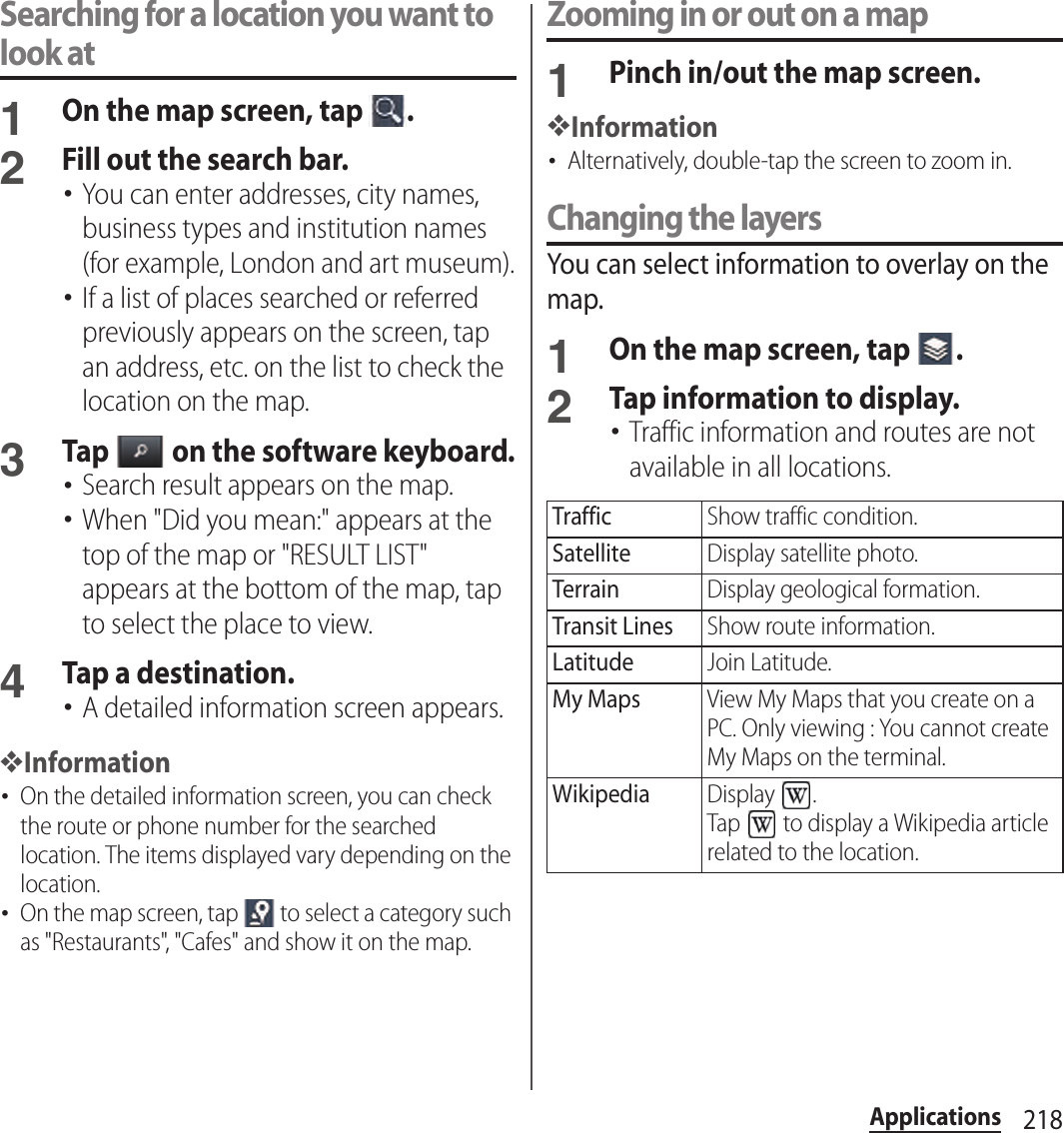
![219ApplicationsGetting directionGoogle Maps helps you receive detailed guides for your destination.1On the map screen, tap .2Enter a start point in the upper entry field, and an end point in the lower entry field.・Alternatively, tap at the right of the input field to select a Start point and End point from "My current location"/"Contacts"/"Point on map"/"My Places".3Select a transportation from (Driving)/ (Transit)/ (Walking).・When you select transit, you can select preferred transit or conditions.4Tap [GET DIRECTIONS].■Going by car/on footDirection is shown on a map.■Going by public transportTrip list appears. Tap a trip to view details.❖Information・The "Navigation" application is displayed if you tap . With "Navigation" application, you can use easy route search with My Location as Start point.Clearing the MapsClear displayed layers, route search results and some others.1On the map screen, tap and tap [Clear Map].・If there is nothing to clear, you cannot tap.Google Latitude enables you to share location information with your friends on the map.You need to set up a Google account (P.139) and join Latitude and invite a friend who gives his or her location information, or to receive an invitation from him or her.Checking where a friend is by Google Latitude](https://usermanual.wiki/Sony/TM-0000.user-guide/User-Guide-1900871-Page-221.png)
![220ApplicationsJoining LatitudeYou need to turn on the Wi-Fi setting beforehand. For details, see "Enabling current location search" (P.217) or "Enabling GPS function" (P.217).1From the Home screen, tap , then tap [Latitude].2Tap [MAP VIEW].❖Information・To set or disable Latitude, tap on the map screen, then tap [Settings]u[Location settings] to display a screen for the operation.・For details of Latitude, tap on the map screen, then tap [Help]u[How to]u[Additional Maps features]u[Latitude] to view the help.The terminal has a built-in calendar for the schedule. If you have a Google account, you can synchronize the terminal's calendar and web calendar. For details, see "Accounts & sync" (P.139).・When you register Google account, tap the Google account displayed in "Accounts & sync" and tap [Sync Calendar] of a sync item. You can create schedule etc.1From the Home screen, tap , then tap [Calendar].・A calendar screen appears.2Tap [Month]/[Week]/[Day].・Tap to move the cursor to date and time set on the terminal.・Flick the calendar left or right to display the next or previous month/week/day according to the view mode.・Pinch out/in on the weekly or daily schedule screen to zoom in/out calendar.CalendarDisplaying calendar](https://usermanual.wiki/Sony/TM-0000.user-guide/User-Guide-1900871-Page-222.png)
![221Applications1Tap on the calendar screen.2Enter a name, date and time, location, description for event.・If you have two or more calendar accounts, select one.3Select the notification intervals of the schedule.・Tap beside "Add reminder" to add a new notification.4Tap [Done].❖Information・Tap in "More" and flick up the screen to set "Repetition", "Attendees", "Time zone", "Show me as:", "Privacy".Viewing schedule in Calendar1On the calendar screen, tap date or time when event is scheduled.2Tap an event to view description.❖Information・On the calendar screen, tap and [My calendars] to synchronize with the docomo account. You can view the events created in "Schedule" application in the Calendar.・If you log in to Facebook, tap [Sync Calendar] in the "Xperia™ with Facebook" (P.141) to display events in Facebook in the Calendar.Searching events in Calendar1On the calendar screen, tap , then tap [Search].2Enter a keyword in the search box and tap on the software keyboard.・Search results appear. Tap an event to view details.Creating a schedule in Calendar](https://usermanual.wiki/Sony/TM-0000.user-guide/User-Guide-1900871-Page-223.png)
![222Applications1If a reminder icon ( ) appears in the status bar, drag the bar downward.・The reminder icon appears at set Notification time.2Tap a schedule.3Tap [Snooze all]/[Dismiss all].・If you have any schedules on hold, they appear on the same screen.・If you tap [Snooze all], all the alarms sound again 5 minutes later (snooze is a function that sounds the alarm some time later even though you stop it).Set Calendar view, reminder notifications, notification ringtone, vibration, reminder time.1On the calendar screen, tap , then tap [Settings].2Select an item to change.With "Alarm & clock" application, you can set an alarm and use world clock, stopwatch and timer.1From the Home screen, tap , then [Alarm & clock].・Alarm screen appears.■ Alarm screenaClock display・Tap to view date and time (P.151) setting screen.bAdd alarm (P.224)cAlarms setdDisplay clock in full screeneView alarm screenfView world clock (P.225)gView stop watch (P.226)hView timer (P.226)iDelete set alarm (P.224)Releasing the reminder of a schedule or setting the snoozeChanging calendar settingsAlarm & clockadbceif g h](https://usermanual.wiki/Sony/TM-0000.user-guide/User-Guide-1900871-Page-224.png)
![223Applications1On the alarm screen, tap [Add alarm].2Set time etc. and tap [Done].・Tap [Advanced alarm settings] to view all setting items.❖Information・To switch on/off alarm, on the alarm screen, tap or touch and hold an alarm that is set, then tap [Turn alarm on]/[Turn alarm off ].・When an alarm is turned on, the line under lights blue.Deleting the alarm1On the alarm screen, tap and mark alarm to delete.2Tap [Delete]u[Yes].・The number of marked alarms appears on the right of "Delete".❖Information・Alternatively, on the alarm screen, touch and hold an alarm setting you want to delete, then tap [Delete alarm]u[Yes] to delete the alarm.Setting alarmTimeFlick up and down on numbers to set time.RepeatSet a day of the week for the alarm.Alarm soundSet alarm sound.Snooze durationSet time interval to sound the ringtone again after stopping the ringtone.Alarm textEnter texts that appear while alarm is sounding.Style settingsMark the checkbox and tap to set alarm style for displaying the set image while sounding alarm.VibrateSet whether to vibrate at the alarm time.Alarm volumeDrag the slider left or right to adjust the volume level.Alarm in silent modeSet whether to sound alarm even in silent mode.Side keys behaviorSet behavior when pressing m while alarm is sounding.Auto silent timeSet time interval until alarm automatically stops.](https://usermanual.wiki/Sony/TM-0000.user-guide/User-Guide-1900871-Page-225.png)
![224ApplicationsStopping an alarm while the alarm is sounding1While alarm is sounding, drag to the right.❖Information・If you tap [Snooze], the alarm sounds again when the time set in "Snooze duration" (P.224) has passed.Display the date and time in cities around the world.1On the alarm screen, tap "World clock" tab.・World clock screen appears.2Tap [Add city].3Select a city.❖Information・Tap to display date and time set on the terminal in full screen.・Add a city and tap , then flick the list of added cities left and right to check date and time corresponding to the terminal's settings.・Time display in cities during day-light saving time may differ from time difference to standard time (GMT) displayed on the screen when adding a city in Step 2.Changing World clockYou can switch, sort or delete Celsius/Fahrenheit displayed on World clock.1On the world clock screen, tap .■Setting home cityTap [Set home city] and select a city.■Switching Celsius/FahrenheitTap [Celsius]/[Fahrenheit].■SortingTap [Rearrange] and drag up and down beside added cities, then tap [Done].■DeletingTap [Delete] and mark cities you want to delete, then tap [Delete]u[Yes].・The number of the marked cities appears on the right of "Delete".・Alternatively, on the world clock screen, touch and hold a city you want to delete, then tap [Delete city]u[Yes] to delete.Using World clock](https://usermanual.wiki/Sony/TM-0000.user-guide/User-Guide-1900871-Page-226.png)
![225Applications1On the alarm screen, tap "Stopwatch" tab.2Tap [Start].・Measurement starts and appears in the status bar.・Tap [Lap] to measure elapsed time.3Tap [Stop].・Tap [Start] to resume measuring.・Tap [Reset] to delete measured time and lap time.❖Information・Tap to display date and time set on the terminal in full screen.1On the alarm screen, tap "Timer" tab.2Tap [Set time].3Flick up and down on numbers to adjust the time and then tap [Set].4Tap [Start].・Timer starts, and appears in the status bar.5Tap [Stop].・Stop sounding alarm after a set time has elapsed.・Tap [Stop] within a set time duration to pause timer. Tap [Start] to resume timer.❖Information・Tap to display date and time set on the terminal in full screen.・Tap to set time from Timer history.・Tap and select an alarm sound, then tap [Done] to change the alarm sound.・While using a desired application, tap r and to use the timer of small apps (P.83).Using Stopwatch Using Timer](https://usermanual.wiki/Sony/TM-0000.user-guide/User-Guide-1900871-Page-227.png)
![226ApplicationsMove or back up data such as phonebook entries, sp-mode mails, bookmarks, etc. using external memory such as microSD card.・Do not remove the battery pack or microUSB card during backup or restoring. Doing so may damage the terminal data.・If the battery is low, backup or restore may not be done. In that case, charge the terminal and retry to back up or restore.・docomo apps password is required to back up or restore. For details on docomo apps password, see "docomo apps password" (P.139).❖Information・For details on docomo backup, tap , then tap [Help] to view the help.If microSD card is not installed, data such as images and movies are saved to the internal storage. You can back up only data such as images and movies stored in the internal storage. Data stored in microSD card cannot be backed up.1From the Home screen, tap , then tap [ドコモバックアップ (docomo backup)].2Tap [microSDカードへ保存 (save to microSD card)].・When you use for the first time, agree to "License agreement".3Tap [Backup].4Mark the data to back up.・Tap [Select all] to mark all data.5Tap [Start backup]u[OK].6Enter docomo apps password and tap [OK].・Data is backed up in a microSD card.ドコモバックアップ (docomo backup)Backing up](https://usermanual.wiki/Sony/TM-0000.user-guide/User-Guide-1900871-Page-228.png)
![227Applications1From the Home screen, tap , then tap [ドコモバックアップ (docomo backup)].2Tap [microSDカードへ保存 (save to microSD card)].・When you use for the first time, agree to "License agreement".3Tap [Restore].4Tap [Select] on data type to restore and mark data to restore, and tap [Select].・Tap [Select latest data] to select the latest data for each data type.5Tap [Add]/[Overwrite] to select restore method and tap [Start restore]u[OK].6Enter docomo apps password and tap [OK].・Backed up data is restored.You can copy contacts data registered in Google account and in the terminal to docomo account.1From the Home screen, tap , then tap [ドコモバックアップ (docomo backup)].2Tap [microSDカードへ保存 (save to microSD card)].・When you use for the first time, agree to "License agreement".3Tap [Phonebook account copy], tap [Select] on Google account contacts you want to copy.4Tap [Overwrite]/[Add].・Phonebook data is copied to docomo account.❖Information・If phonebook item names (e.g. Phone number, etc.) of the other terminal are different from ones of your terminal, the item names may be changed or deleted. Also, some text may be deleted in copied destination, because savable characters in a phonebook entry vary by terminal.・When backing up phonebook entries to microSD card, data without Name cannot be copied.・If microSD card is low on memory, backup may not be done. In that case, delete unnecessary files to make available space.RestoringCopying phonebook entries registered in Google account to docomo account](https://usermanual.wiki/Sony/TM-0000.user-guide/User-Guide-1900871-Page-229.png)
![228ApplicationsWith OfficeSuite, you can view files of Word, Excel, etc. from the terminal or a microSD card.❖Information・Some files may not be viewed properly due to corrupted layouts.1From the Home screen, tap , then tap [OfficeSuite].・OfficeSuite starts.❖Information・When you activate for the first time, a screen for register name etc. appears. Follow the onscreen instructions.OfficeSuiteStarting OfficeSuite](https://usermanual.wiki/Sony/TM-0000.user-guide/User-Guide-1900871-Page-230.png)
![229International roamingInternational roamingWith the international roaming (WORLD WING), you can use the terminal without changing phone number or mail address in the service area of the overseas network operator affiliated with DOCOMO. You do not need to change the settings of call and SMS.■ Supporting networksThe terminal is Class 4. The terminal works in a 3G roaming area and GSM/GPRS service area. Services are also available in countries and areas supporting 3G 850MHz/GSM 850MHz. Check available areas. Use 3G network or GSM/GPRS network overseas because Xi is not available overseas.■ Before using the terminal overseas, refer to the followings.・"Mobile Phone User's Guide [International Services]"・DOCOMO International Services website❖Information・For Country codes, International call access codes, Universal number international prefix, supported countries/areas and network operators, refer to "Mobile Phone User's Guide [International Services]" or DOCOMO International Services Website.* To use data communication during roaming, mark "Data roaming" checkbox in Mobile network settings (P.234).❖Information・Some services are not available depending on the overseas network operator or network.Overview of International roaming (WORLD WING)Available ServicesMain communication services 3G 3G 850 GSM (GPRS)Phone○○○Message (SMS)○○○Email*○○○Browser*○○○](https://usermanual.wiki/Sony/TM-0000.user-guide/User-Guide-1900871-Page-231.png)
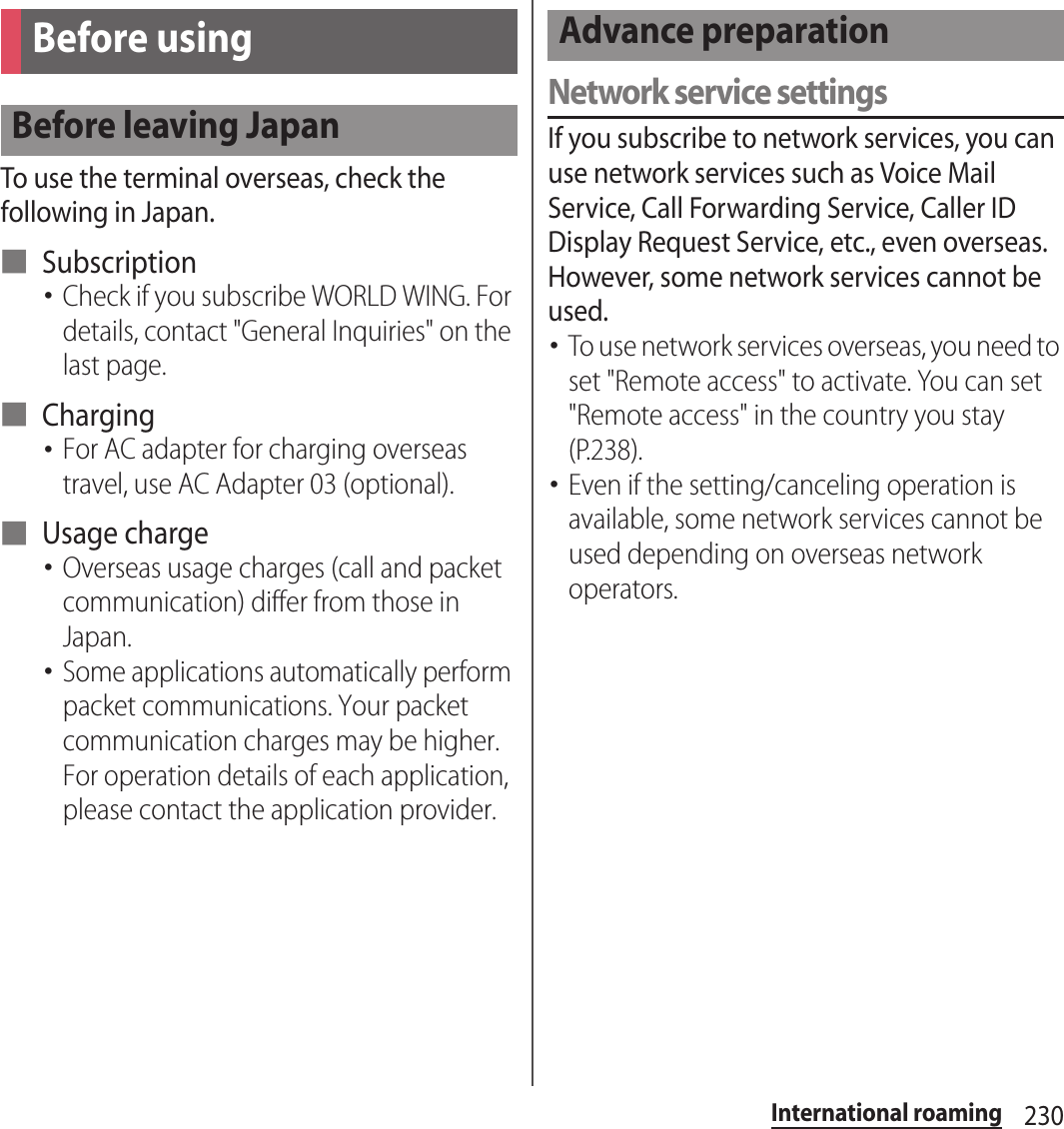
![231International roamingWhen you arrive overseas and turn on the terminal, an available network is automatically set.ConnectivityWhen you have set search mode of "Search mode" to "Automatic" in "Service providers" settings, optimized network is automatically selected (P.233).When you connect to the network operator conducted in flat-rate service, you can use the service with flat-rate packet communication charges overseas up to the specified upper limit per day. To use this service, subscription of packet flat-rate service in Japan is required. For details, refer to "Mobile Phone User's Guide [International Services]" or DOCOMO International Services Website.DisplayDuring international roaming, appears on the status bar.・You can confirm the name of the connected network operator on the Notification panel.❖Note・While appears on the status bar, packet communication is available. Note that packet communication fee may become high.Date & time settingsWhen "Automatic date & time", "Automatic time zone" in "Date & time" are marked, the date, time and time differences of the terminal clock are corrected by receiving the information related to time and time differences from the network of overseas network operator you connect to. ・Correction of the time/time differences may not be performed correctly depending on the network of overseas network operator. In that case, set time zone manually.・Timing of correction varies by the overseas network operator.・Date & time (P.151)About inquiries・For loss or theft of the terminal or UIM/docomo mini UIM card, immediately contact DOCOMO from the spot to take the necessary steps for suspending the use. For inquiries, see the last page. Note that you are still liable for the call and communication charge incurred after the loss or theft occurred.・For using from land-line phone, entering "International call access code" or "Universal number international prefix" for the country is needed.After arriving overseas](https://usermanual.wiki/Sony/TM-0000.user-guide/User-Guide-1900871-Page-233.png)
![232International roamingAfter returning to JapanWhen you return to Japan, the terminal is connected to DOCOMO network automatically. If connection is failed, perform the following operations.・Set "Network Mode" to "LTE (preferred)/WCDMA/GSM" (P.234).・Set "Search mode" to "Automatic" in "Service providers" settings (P.233).When you start the international roaming or move out of your operator's network, you need to reconnect the terminal to another available network.❖Information・Some applications automatically perform packet communications. To disconnect packet communication manually, from the Home screen, tap and tap [Settings]u[More...]u[Mobile networks] and unmark "Data enabled".Confirming and switching the network search modeBy default, network search mode is set to "Automatic". When you connect manually to an overseas network operator conducted in flat-rate service, confirm the search mode with the following operations and switch to "Manual".1From the Home screen, tap , then tap [Settings].2Tap [More...]u[Mobile networks]u[Service providers].・If a note appears, tap [OK].3Tap [Search mode]u[Manual].4From "AVAILABLE NETWORKS", mark a network to use.・To display available networks, tap [Search networks].❖Information・If you set a network manually, the terminal is not reconnected to another network automatically even if you move out of the network area.・To return to "Automatic", tap [Automatic] in Step 3.Making setting for international use](https://usermanual.wiki/Sony/TM-0000.user-guide/User-Guide-1900871-Page-234.png)
![233International roamingChanging network mode settingsYou can change network mode settings according to the network mode (communication method) adopted by the overseas network operator.1From the Home screen, tap , then tap [Settings].2Tap [More...]u[Mobile networks]u[Network Mode].3Select a network mode you use.・You can select from "LTE/WCDMA" "GSM only" and "LTE (preferred)/WCDMA/GSM". If you select "LTE (preferred)/WCDMA/GSM" to switch available network automatically.Activating data roaming1From the Home screen, tap , then tap [Settings].2Tap [More...]u[Mobile networks].3Tap [Data roaming].4Read the note and tap [Yes].・"Data roaming" checkbox is marked.When you arrive overseas and turn on the terminal, an available network is automatically set.・Check that the battery and signal levels are high enough.・Depending on the network operator, even if the Caller ID notification is active, the caller ID may not be notified or appear properly.In this case, calls cannot be made from the call log.You can make a call from overseas using the international roaming service.・You can easily make international calls from the country you stay to Japan or to other countries by entering prefix "+" and then the country code and phone number.1From the Home screen, tap , then tap "Dial" tab.Making/Receiving calls in the country you stayMaking a call to outside country you stay (including Japan)](https://usermanual.wiki/Sony/TM-0000.user-guide/User-Guide-1900871-Page-235.png)
![234International roaming2Dial + (touch and hold [0])uCountry codeuArea code (City code)uEnter a phone number.・If the area code begins with "0", omit "0". However, "0" may be required to dial to some country or area such as Italy.・To call an overseas "WORLD WING" user, enter "81" (Japan) for the country code.3Tap .❖Information・During international roaming, if you make an international call to Japan using DOCOMO's phone application, the "International dialing assist" screen appears. You can make a call without entering country code from that screen.For details on International dialing assist, see "Setting international dial assistance" (P.237).You can make a call by entering the phone number of the other party's land-line phone or mobile phone in the same way you do in Japan.1From the Home screen, tap , then tap "Dial" tab.2Enter the other party's phone number.・To make a call to land-line phone, enter the area code (city code) + other party's phone number.3Tap .When the other party uses international roaming service, make a call as an international call to Japan even when you stay in the same country as the other party.You can receive a call using the international roaming service.Making a call within the country you stayMaking a call to WORLD WING user overseasReceiving a call in the country you stay](https://usermanual.wiki/Sony/TM-0000.user-guide/User-Guide-1900871-Page-236.png)
![235International roaming1While receiving a call, touch and hold (left) and drag it to (right).2When the conversation is finished, tap [End call].❖Information・When you received a call during the international roaming, regardless of which country the call is from, it is forwarded internationally from Japan. A caller is charged for a call fee to Japan, and the receiver is charged for a reception fee.■ Having the other party call you・Having someone make a call from Japan to the country you stayTo have the other party make a call from a land-line phone or mobile phone in Japan to the terminal in the country you stay, the other party only needs to dial the phone number as in Japan.・Having someone make a call from other than Japan to the country you stayYou have to receive a call through Japan no matter where you are; therefore, the other party needs to enter the international call access code and "81" (Country code of Japan).International access code - 81 - 90 (or 80) - XXXX - XXXXMake settings for using international roaming or international calls.Set restricting incoming calls overseas or using roaming guidance.・For some overseas network operators, settings may not be made.Restricting incoming calls for roaming1From the Home screen, tap , then tap .2Tap [Call settings]u[Roaming settings].3Tap [Restricting incoming calls].・Select items you want to use.International roaming settingsSettings for making/receiving calls overseasActivate restrictingTap any of "Restricting all incomings"/"Restricting incoming of video call/64K data", enter the network security code, and tap [OK].Deactivate restrictingEnter the network security code and tap [OK].Check settingsCheck the current service settings.](https://usermanual.wiki/Sony/TM-0000.user-guide/User-Guide-1900871-Page-237.png)
![236International roamingSetting incoming notification on roaming1From the Home screen, tap , then tap .2Tap [Call settings]u[Roaming settings].3Tap [Incoming notification on roaming].・Select items you want to use.Setting roaming guidance1From the Home screen, tap , then tap .2Tap [Call settings]u[Roaming settings].3Tap [Roaming guidance].・Select items you want to use.Setting international dial assistance1From the Home screen, tap , then tap .2Tap [Call settings]u[Roaming settings].3Tap [International dial assist].・Select items you want to use.Settings Network service (overseas)Set network service such as voice mail from overseas.・If you make the settings overseas, you are charged a call fee to Japan from the country you stay.・For some overseas network operators, settings may not be made.Activate incoming call notificationTap [OK] to activate roaming incoming call notification.Deactiv. incoming call notificationTap [OK] to deactivate roaming incoming call notification.Check settingsCheck the current service settings.Activate roaming guidanceTap [OK] to activate roaming guidance.Deactivate roaming guidanceTap [OK] to deactivate roaming guidance.Check settingsCheck the current service settings.Auto conversionInternational prefix or country code is automatically added.Country codeTap [OK] to select a country code which will be used for auto conversion.International prefixTap [OK] to select an international prefix which will be used for auto conversion.](https://usermanual.wiki/Sony/TM-0000.user-guide/User-Guide-1900871-Page-238.png)
![237International roaming1From the Home screen, tap , then tap .2Tap [Call settings]u[Roaming settings].3Tap [Network service].・Select items you want to use. You need to set "Remote access" to activate.* Follow the voice prompts to operate.Voicemail(charged)Activate Voicemail (roaming)Tap [OK].*Deactivate Voicemail (roaming)Tap [OK].*Play Voicemail message (roaming)Tap [OK]. After this step, follow the voice prompts to play the message.Voicemail settings (roaming)Tap [OK].*Voicemail ring time (roaming)Tap [OK].*Incoming call notific.(charged)Tap [OK].*Caller ID request (charged)Tap [OK].*Roaming guidance (charged)Tap [OK].*Remote operation (charged)Tap [OK].*Call forwarding (charged)Activate call forwardingTap [OK].*Deactivate call forwardingTap [OK].*Check settingsTap [OK].*](https://usermanual.wiki/Sony/TM-0000.user-guide/User-Guide-1900871-Page-239.png)
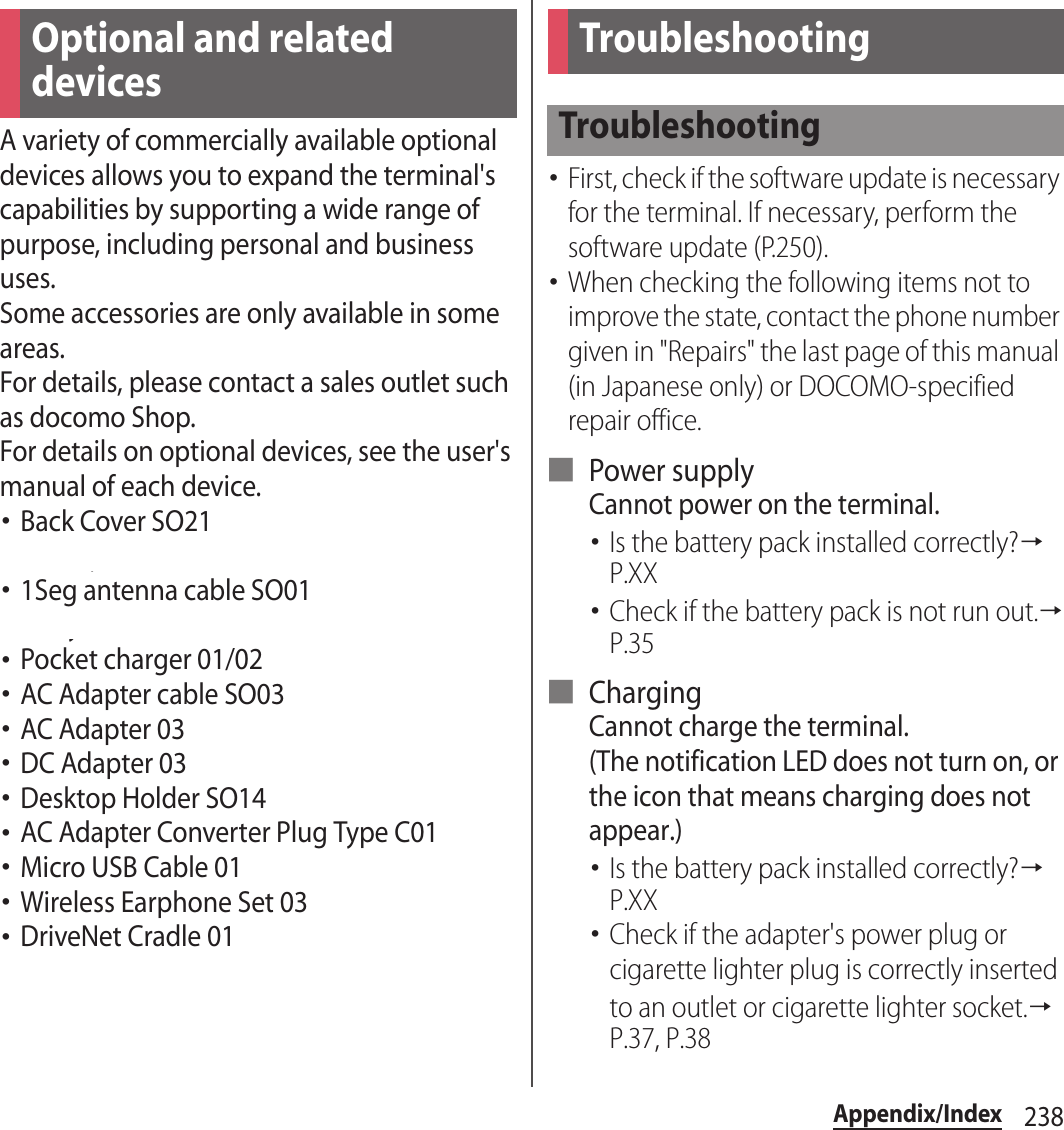
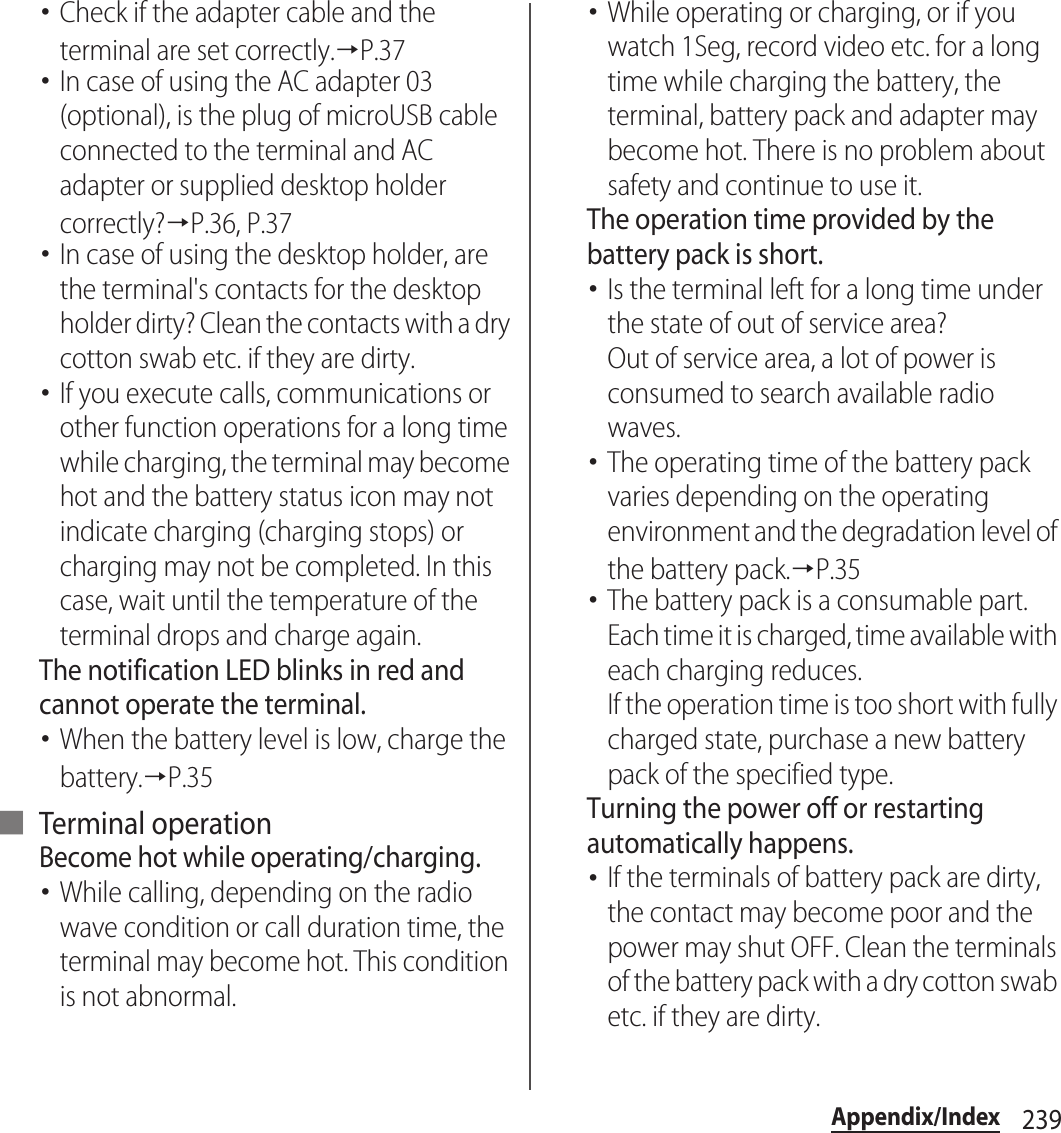
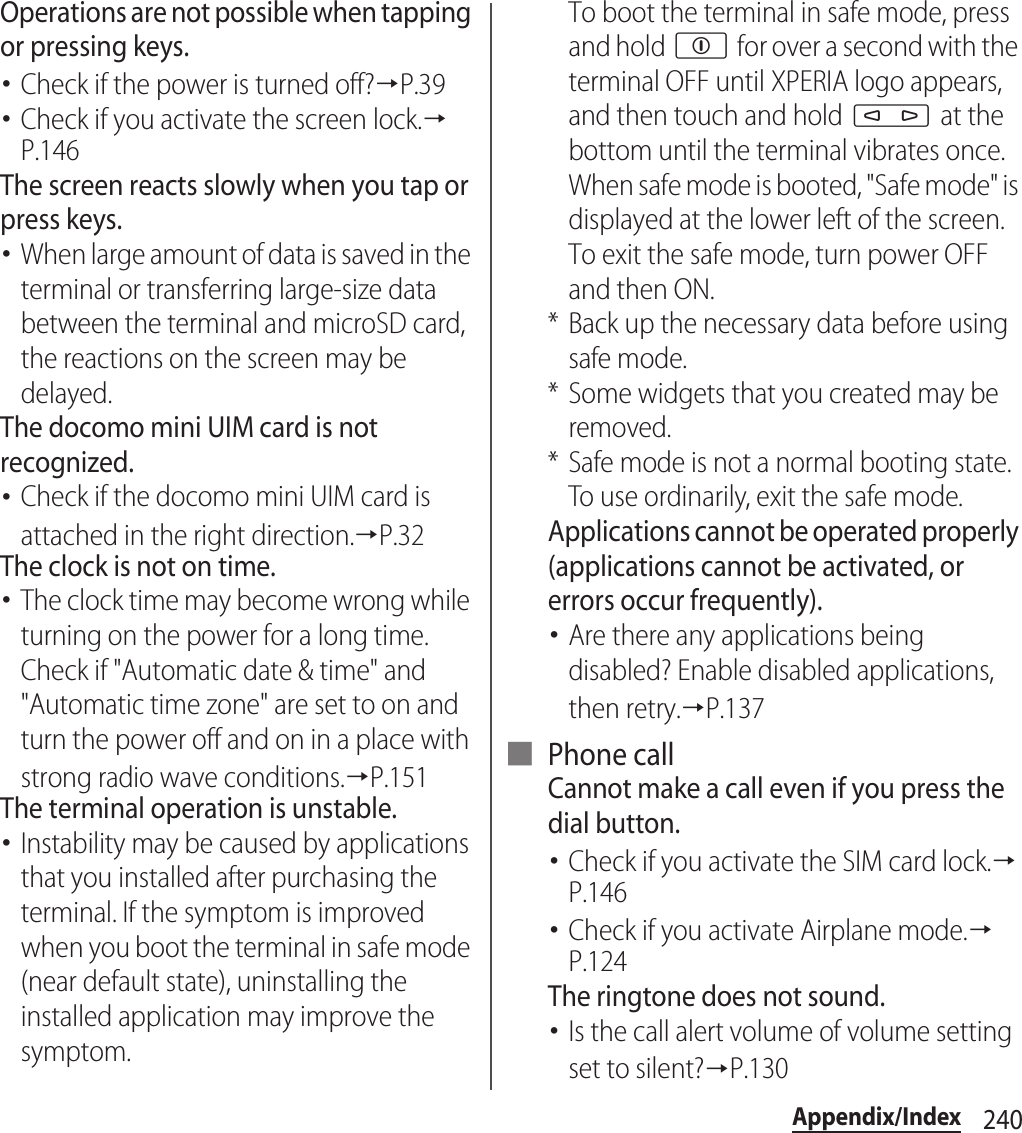
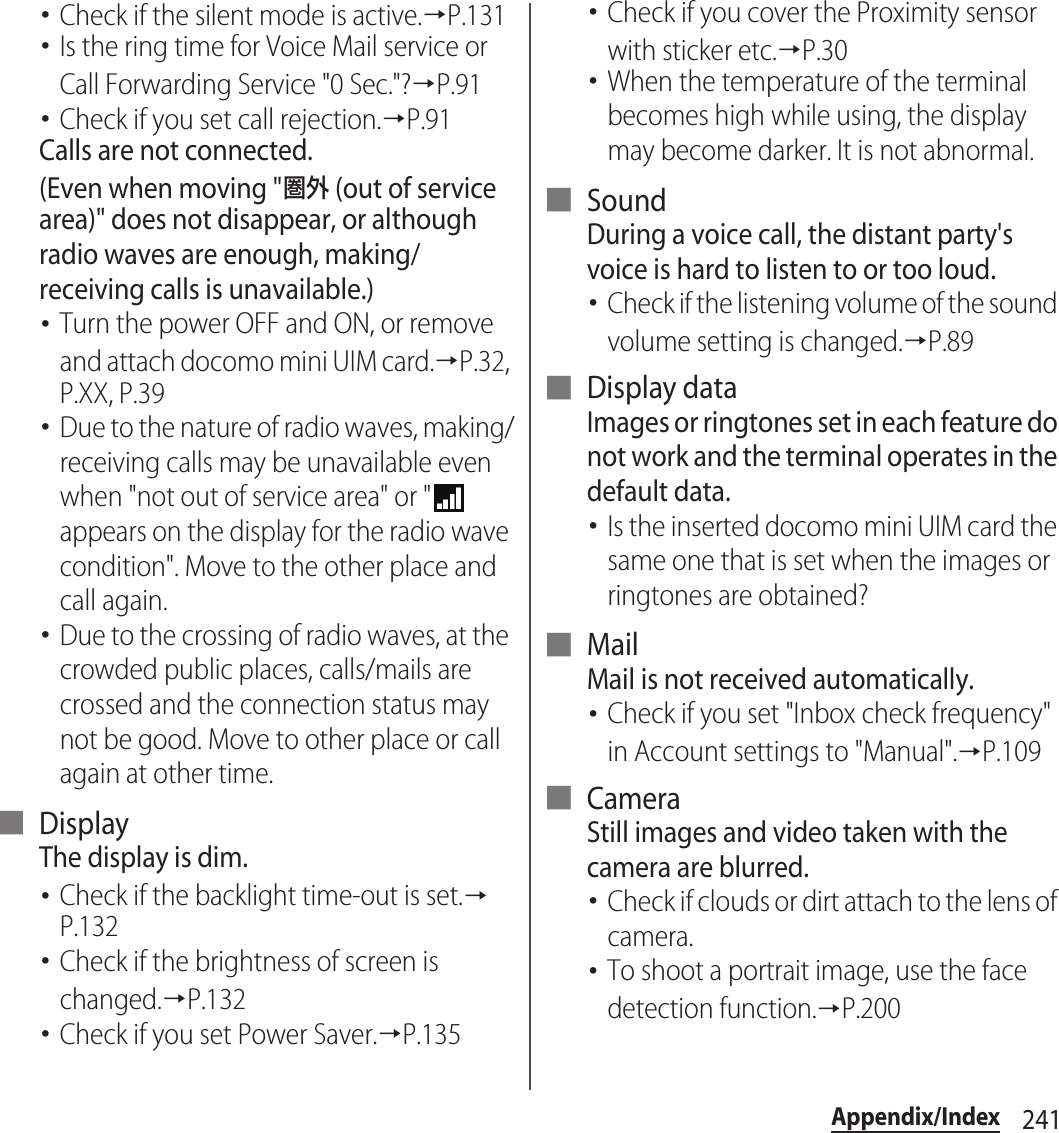
![242Appendix/Index・Shoot using shake reducing function.→P.193, P.198・To shoot a close object, use "Superior auto" for the capturing mode.→P.188■ 1SegWatching 1Seg is unavailable.・Are you out of terrestrial digital TV broadcasting service area or in a place where airwave is weak?・Is channel set?→P.177Cannot hear sound.・Is Stereo Headset with Microphone removed from 1Seg antenna cable SO01 when watching 1Seg using the Stereo Headset with Microphone (Sample)?→P.177■ Osaifu-KeitaiOsaifu-Keitai function is unavailable.・When removing the battery pack or activating Omakase Lock, Osaifu-Keitai functions are unavailable regardless of the NFC/Osaifu-Keitai lock settings.・Check if NFC/Osaifu-Keitai is locked.→P.173・Check if you place mark of the terminal over an IC card reader?→P.173■ International roamingCannot use the terminal overseas.■When antenna mark is displayed・Do you subscribe WORLD WING?Check if you subscribe WORLD WING.■Out of service area indicator appears・Check if you are out of the international roaming service area or in an area with poor signal strength. Check if the service area and network operator are available, referring to "Mobile Phone User's Guide [International Services]" or DOCOMO International Services website.・Change the network settings or overseas network operator settings.Set "Search mode" to "Automatic" in "Service providers".Set "Network Mode" to "LTE (preferred)/WCDMA/GSM".→P.232, P.233, P.234・Turning off the terminal and then turning on again may work for the restoration.→P.39Cannot perform data communication overseas.・Mark "Data roaming".→P.234](https://usermanual.wiki/Sony/TM-0000.user-guide/User-Guide-1900871-Page-244.png)
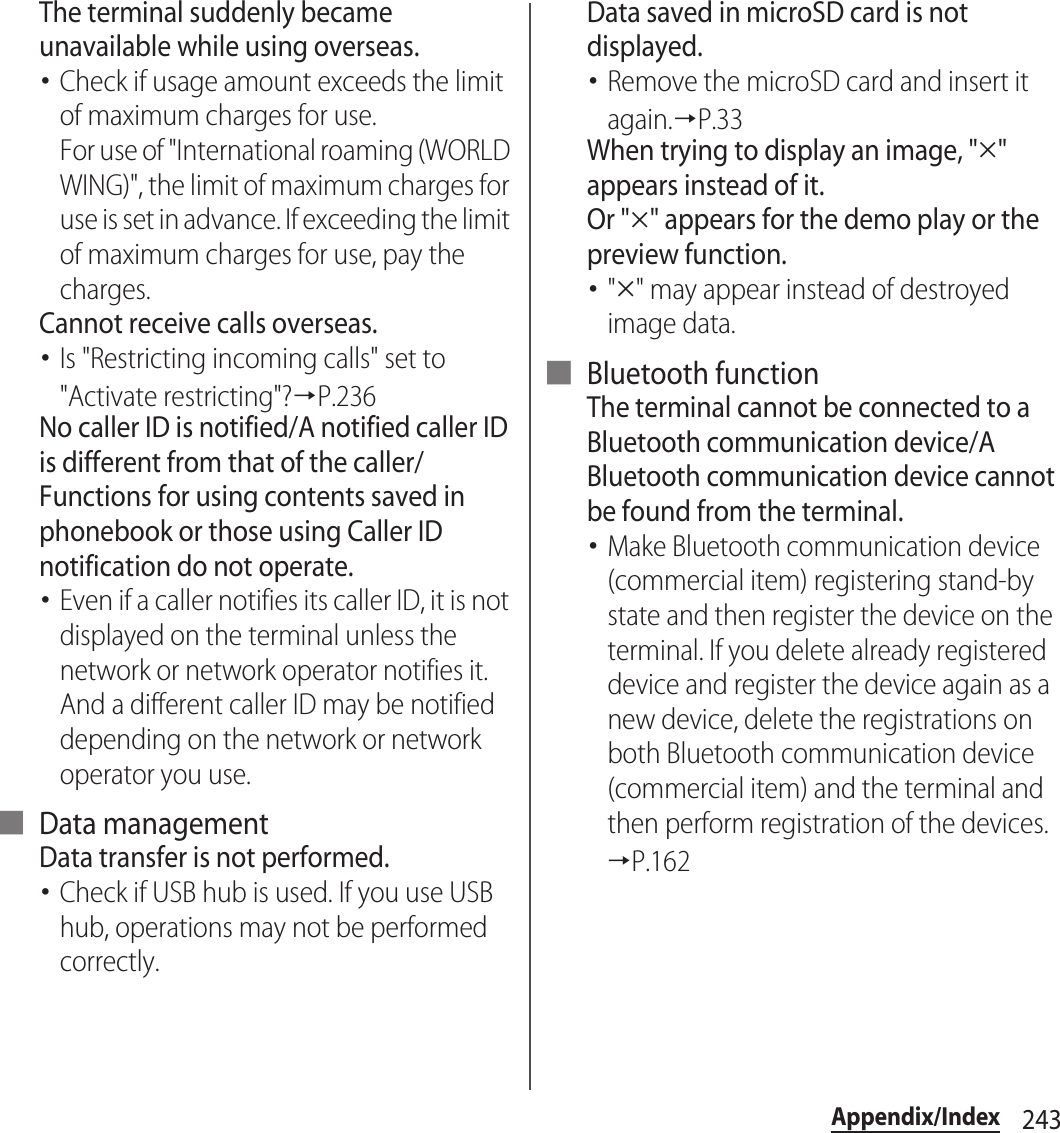
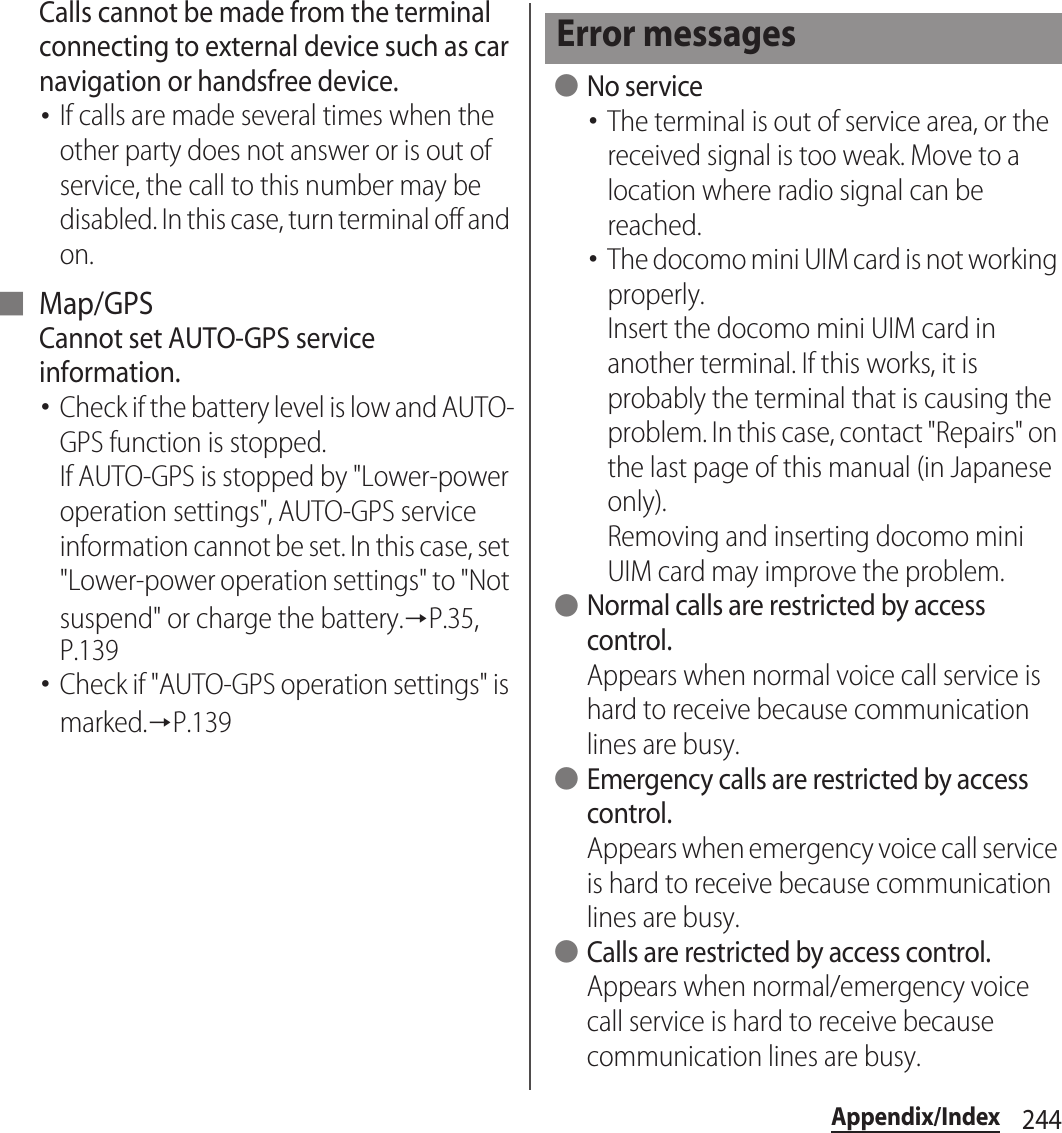
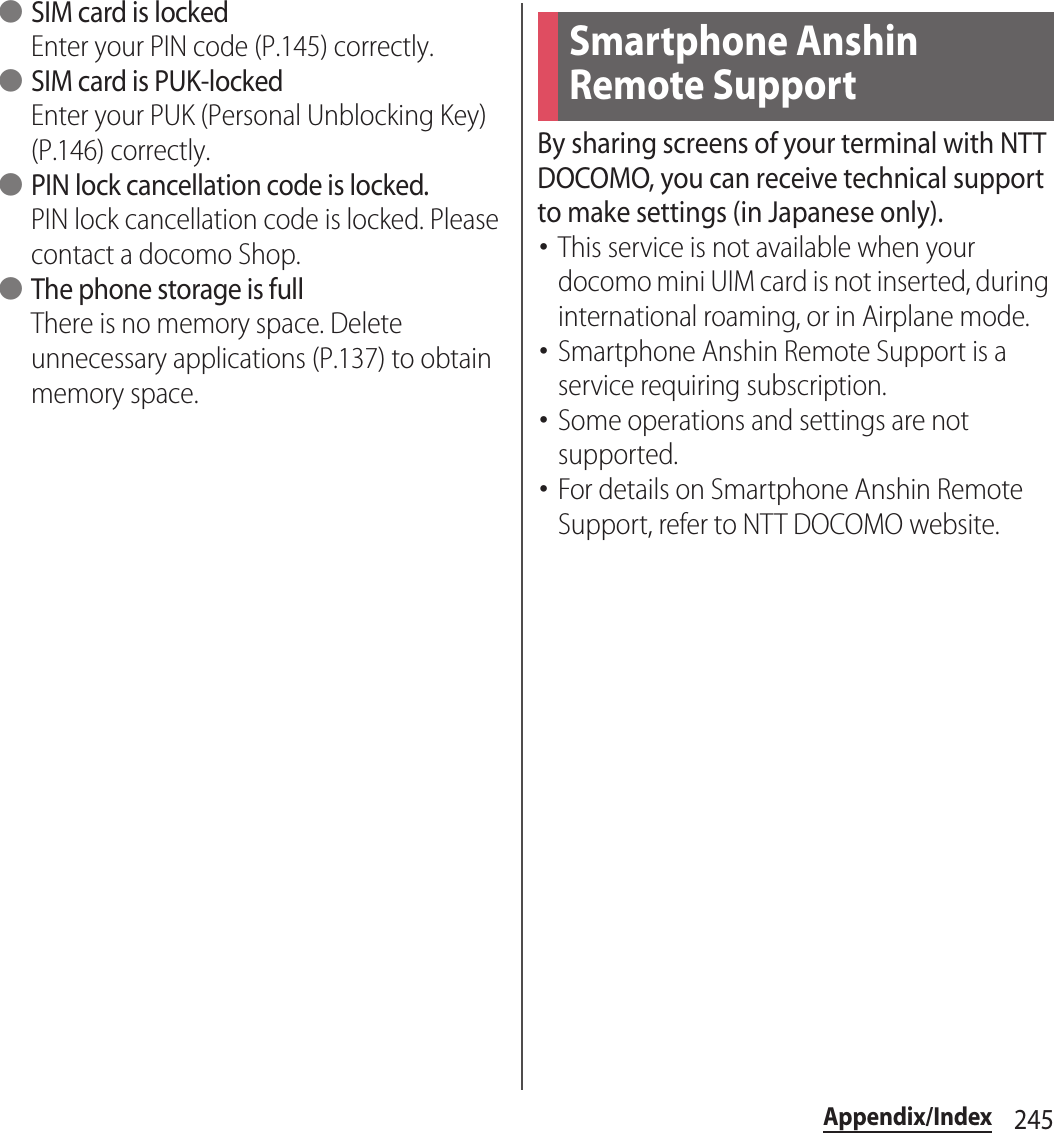
![246Appendix/Index1Call スマートフォン遠隔サポートセンター (Remote support center for smartphone) ( 0120-783-360, Business hours: 9:00 a.m. to 8:00 p.m., open all year round).2From the Home screen, tap , then tap [遠隔サポート (Remote support)].・When you use for the first time, agree to "ソフトウェア使用許諾書 (License Agreement)".3Enter connection number notified by DOCOMO.4Remote support starts when you are connected.・Make sure that the warranty is received with the terminal upon purchase. Check to be sure that "販売店名・お買い上げ日 (the name of the retailer, date of purchase)", and other items have been filled out on the warranty before storing it in a safe place. If any necessary information is not provided, immediately contact the retailer and request to complete the warranty. The terminal comes with a year's free warranty starting from the date of purchase.・Specifications of this product and its accessories are subject to change for improvement without prior notice.・Data saved in the Contacts etc. may be changed/lost due to the trouble/repairs or handling of the terminal. DOCOMO recommends making a copy of the Phonebook data etc., in case.* You can save Phonebook data in a microSD card inserted to the terminal.* Data such as phonebook entries can be backed up to Data center using Data Security Service (subscription is required).Warranty and After Sales ServicesWarranty](https://usermanual.wiki/Sony/TM-0000.user-guide/User-Guide-1900871-Page-248.png)
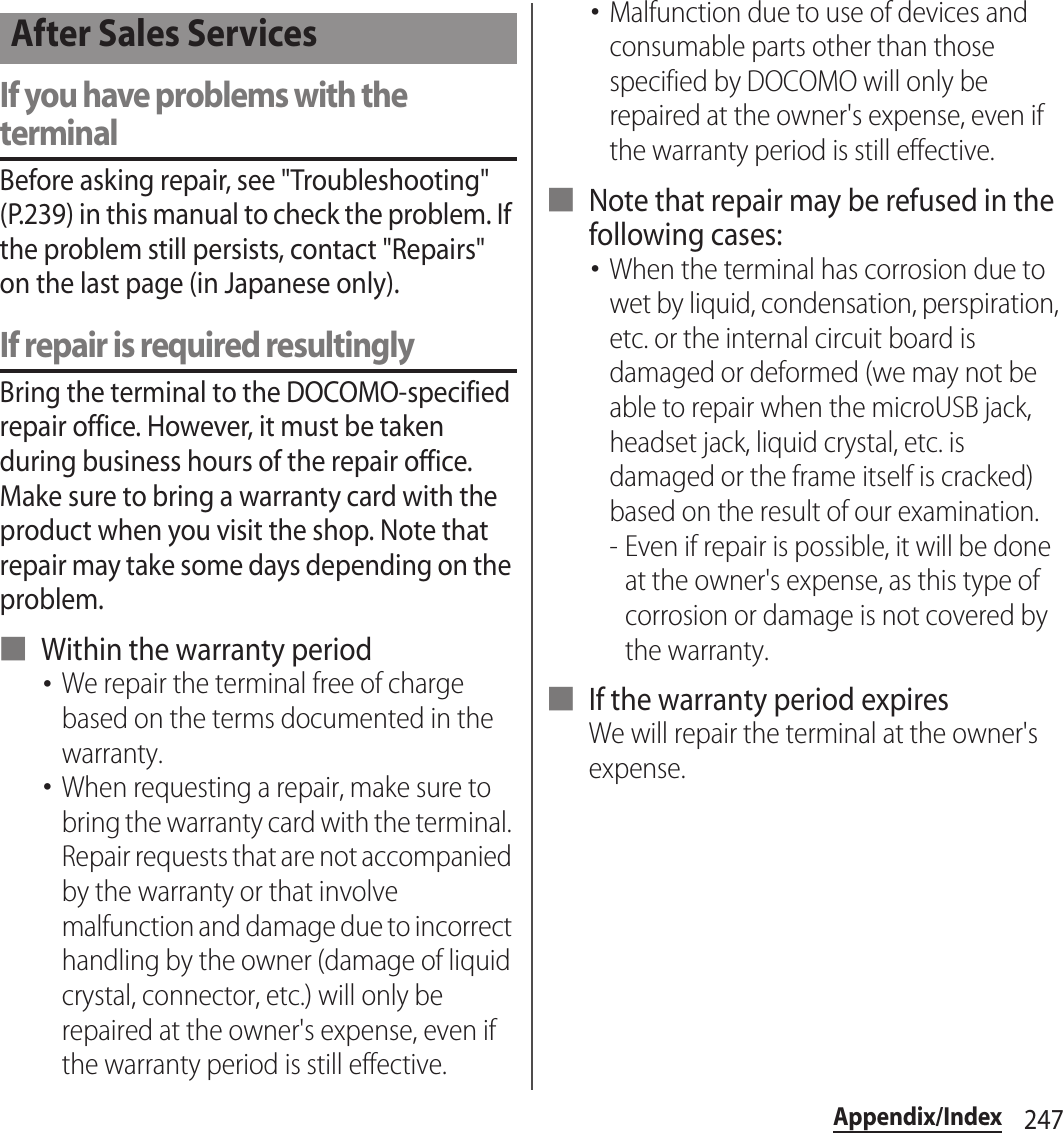
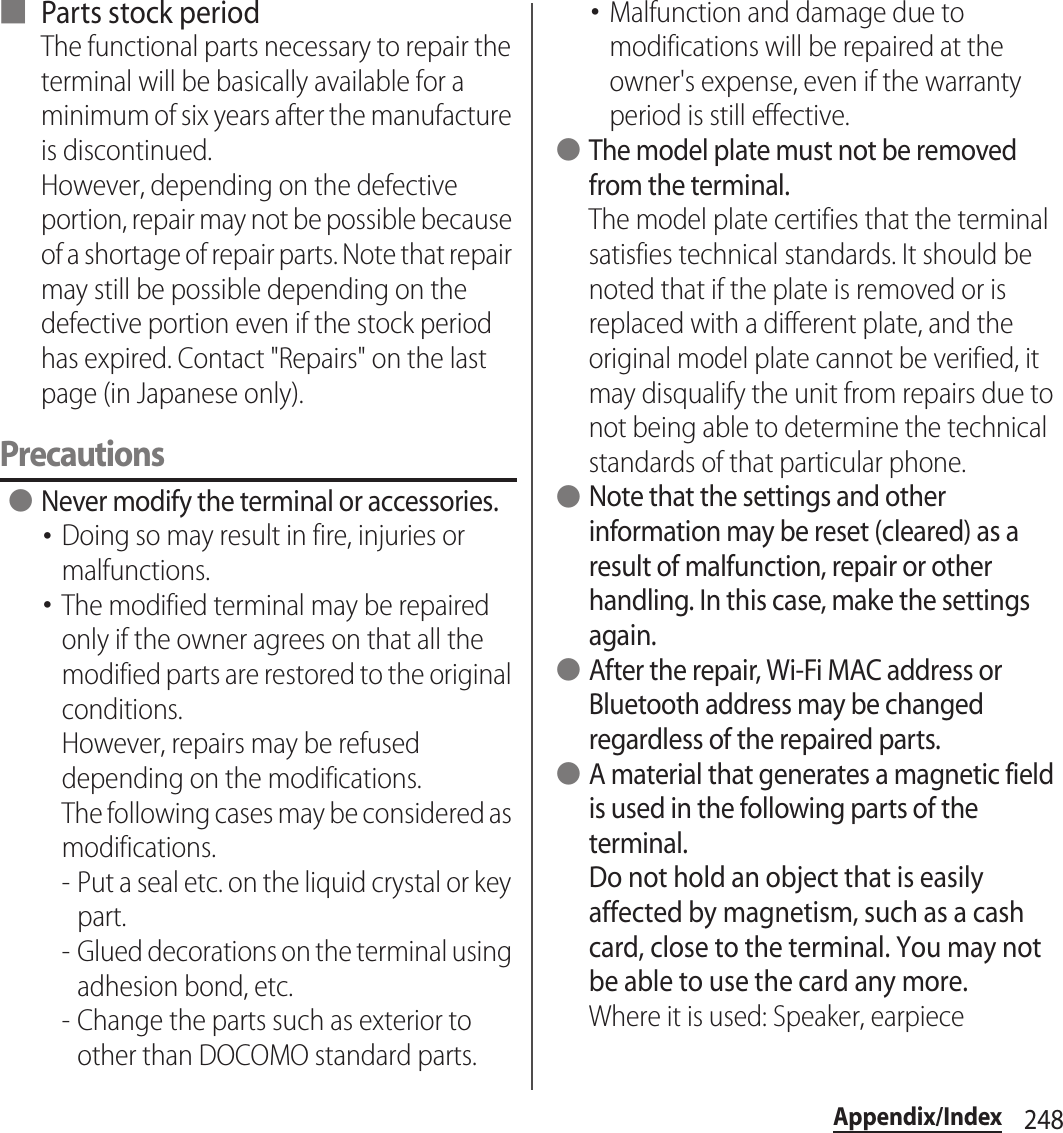
![249Appendix/Index ●The terminal is waterproof. If inside of the terminal gets wet or moist, however, turn the power off, remove the battery pack immediately, and bring the terminal to a repair office as soon as possible. However, repair may not be possible depending on the condition of the terminal.Precautions on memory dial (Phonebook function) and downloaded dataNote that data you created or data you retrieved or downloaded from sources other than your terminal may be changed or lost when you change the model or have repairs done to the terminal. DOCOMO shall have no liability for any change or loss of any kind. Under some circumstances, DOCOMO may replace your terminal with its equivalent instead of repairing it.You can update the terminal to the most recent software for optimal performance and to get the latest enhancements.❖Note・When the terminal is connected to the Internet using the mobile network connection, data communication fee is applied.・Make sure you back up and save all data contained in the terminal before you start updating the terminal.・For the first time activating the terminal after software update, the operation may be slower from several minutes to several ten minutes due to data update. The required time varies by the data in the terminal. Do not turn the power off until usual operation speed comebacks.❖Information・For details on the software update, see the following website.http://www.sonymobile.co.jp/support/ (In Japanese only)Setting notification of Software updateYou can set to be notified of updating software.1From the Home screen, tap and tap [Settings]u[About phone]u[Software update].2Tap and [Settings].Updating software](https://usermanual.wiki/Sony/TM-0000.user-guide/User-Guide-1900871-Page-251.png)
![250Appendix/Index3Mark "Notifications".・To change the notification tone, tap [Notification tone], then tap notification tone you want to change, and then tap [Done].❖Information・If you mark "Notification vibration" in Step 3, software update is notified by vibration.Downloading software to updateSoftware can be downloaded wirelessly directly from your terminal via the Internet by using mobile network connection or by using a Wi-Fi network connection.1From the Home screen, tap and tap [Settings]u[About phone]u[Software update].2Tap "System" tab and then .・The terminal searches for software updates.❖Information・You can also search the software update in the following operation.From the Home screen, tap and , then tap [Settings]u[About phone]u[Software update]u"System" tab and then tap .・"New apps"/"Updates" tabs in the Update Center screen are not available because the services are not provided in Japan.❖Note・For software update via mobile network, a high packet communication charge will be applied because of a large amount data communication. For this reason, subscription of packet flat-rate service is highly recommended.・While you are using roaming service overseas, you cannot search for or download update software through the mobile network.Downloading the latest software update automaticallySearch the latest software update automatically on regular basis. If software update is searched, software is downloaded automatically and appears on the status bar.1From the Home screen, tap and tap [Settings]u[About phone]u[Software update].2Tap and [Settings].3Tap [Allow automatic downloads], read the notes and tap [Agree].・"Allow automatic downloads" is marked.Downloading software updates wirelessly](https://usermanual.wiki/Sony/TM-0000.user-guide/User-Guide-1900871-Page-252.png)
![251Appendix/Index❖Note・Note that if you tap from the Home screen, then tap [Settings]u[About phone]u[Software Update] and tap then [Settings]u[Preferred data traffic]u[Via mobile network/Wi-Fi], a Wi-Fi connection automatically switches to mobile network communications when the Wi-Fi connection is unstable and packet communication fee may apply.・Note that packet communication fee may apply for searching automatically.You can update software by using PC Companion that can be installed into a PC from the terminal.❖Information・To install PC Companion on a PC, an Internet connection is required.When PC Companion is not installed on your PC1Connect the terminal to a PC using a microUSB cable.2When "PC Companion software" screen appears on the terminal, tap [Install].・Installer of PC Companion starts on the PC.3Follow the onscreen instructions on the PC to install.・After installation, PC Companion starts on the PC. If further software update is searched, it is automatically notified. Follow the onscreen instructions on the PC.When PC Companion is installed on your PC1Check if PC Companion is activated on the PC. If not, activate PC Companion from the Start menu.2Connect the terminal to a PC using a microUSB cable.3Follow the onscreen instructions on the PC.・If available software update is found, it is automatically notified.Connecting to a PC and updating](https://usermanual.wiki/Sony/TM-0000.user-guide/User-Guide-1900871-Page-253.png)
